
SUSTAINABLE SPAIN TRAVEL PLANNER Alternative winter breaks Cruise the Great Lakes Isles of Scilly North Rhine-Westphalia Indigenous Lithuania Cape Town escapes Greenland’s quirky capital Ugandan crafts Rediscovering historic Taking The Road Less Travelled Since 1993 � DIRIYAH

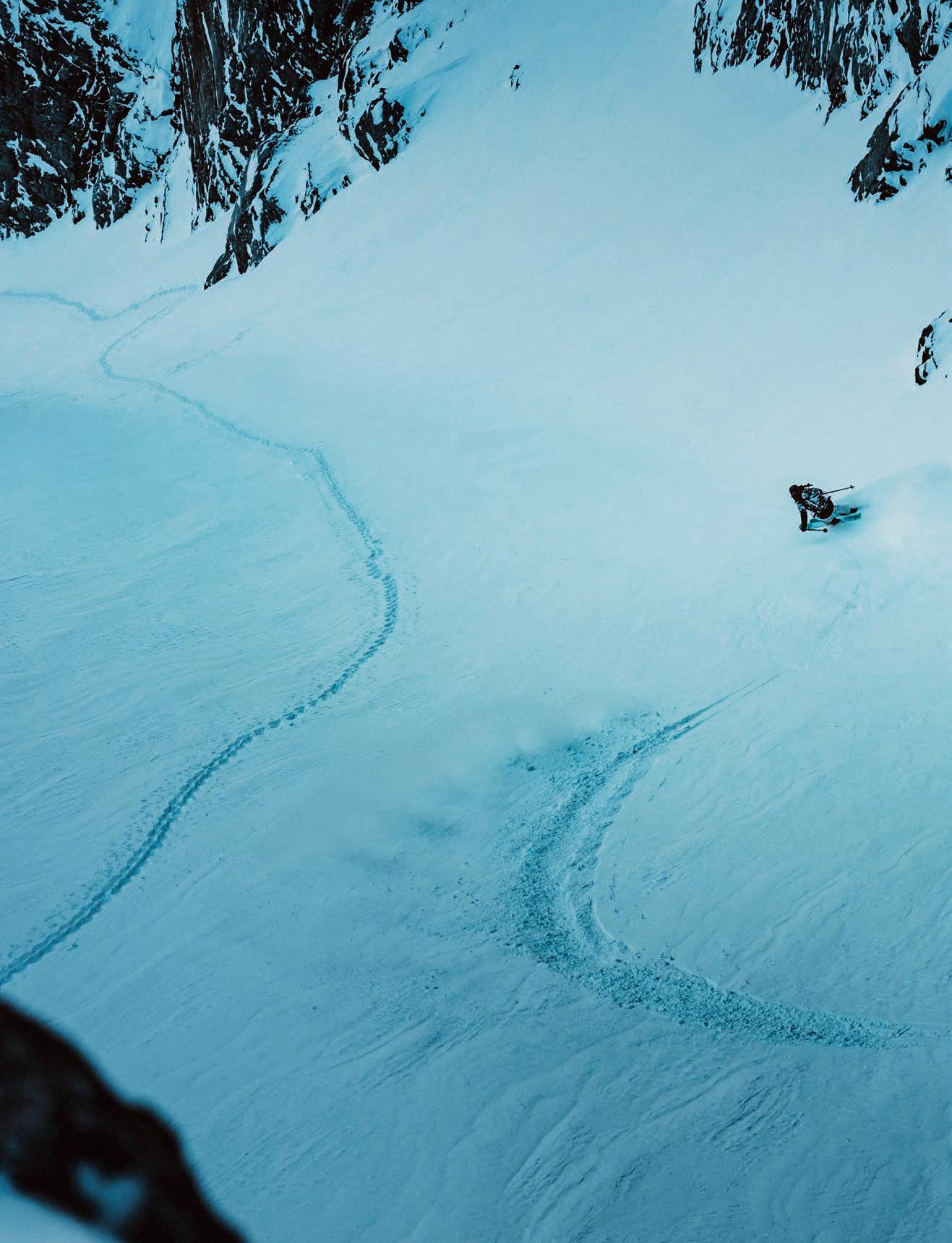




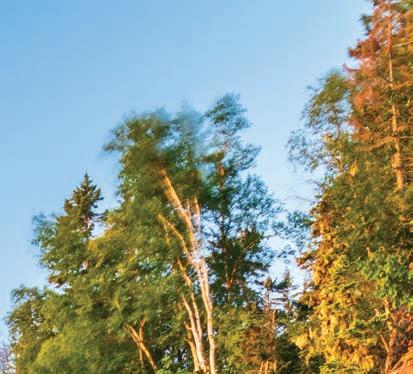
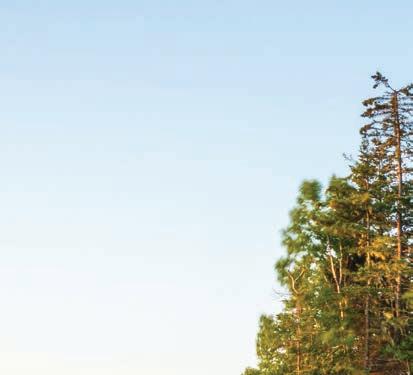


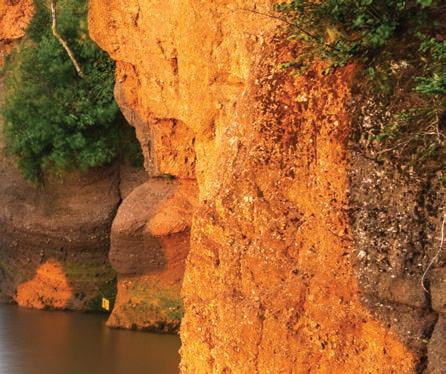


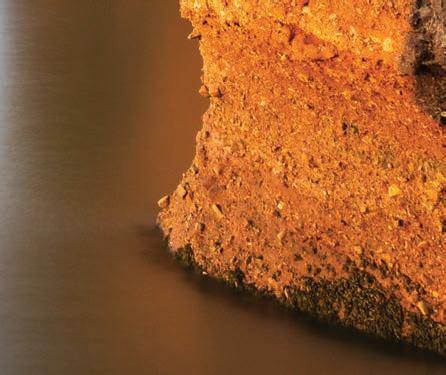













If I could go back in time, I would choose an era when I could travel alongside some of history’s great explorers: Marco Polo, Amerigo Vespucci, Vasco da Gama, Gertrude Bell… the list goes on. How thrilling it must have felt to go somewhere undiscovered, meet communities for the first time, experience unique traditions and encounter eye-opening innovations along the way!
But while there may be few unmapped regions now, there are still destinations that I feel deliver a glimpse of the pioneering days of the explorers. In this issue, our co-founder Lyn Hughes explores the wonders of Saudi Arabia’s historic capital, Diriyah (p94), becoming among the first travellers to experience a cradle of Arabian history as it prepares to reopen to the world. We also venture out to the seldom-visited Torres Strait Islands (p76) in Queensland’s tropical north, where both Aboriginal and Torres Strait Islander communities still chart their own path. Or consider Nuuk, Greenland’s remote and tiny capital (p182), which is only a speck on the biggest Arctic island of them all, but one that may get a lot busier once Greenland’s airports are upgraded over the next couple of years.
Of course, we can still put on our explorer hat in places that feel familiar and are more readily accessible. How about a different take on touring Spain (p114), as we discover the many sustainability initiatives that have been developed in what is one of the world’s most visited countries? Or perhaps try a cultural visit to Germany’s industrial heartland of North RhineWestphalia (p186)? For those of us looking to beat the winter blues, we’ve also prepared our take on seasonal experiences from around the world (p134) – hopefully with a few surprises.
As we look forward to celebrating our 30th anniversary next year, our team at Wanderlust is as enthusiastic as ever in our desire to inspire many more generations of explorers to come. Join us as we share the many secrets of our glorious planet!
Happy travel discoveries,
and
schemed the project on a flight to Ecuador,
2020, Wanderlust has expanded rapidly to
commitment to responsible, conscious and





digital presence, wanderlustmagazine.com delivers

‘The Wanderlust Club’ maintains a community of serious travellers
won awards from respected industry bodies across the planet.
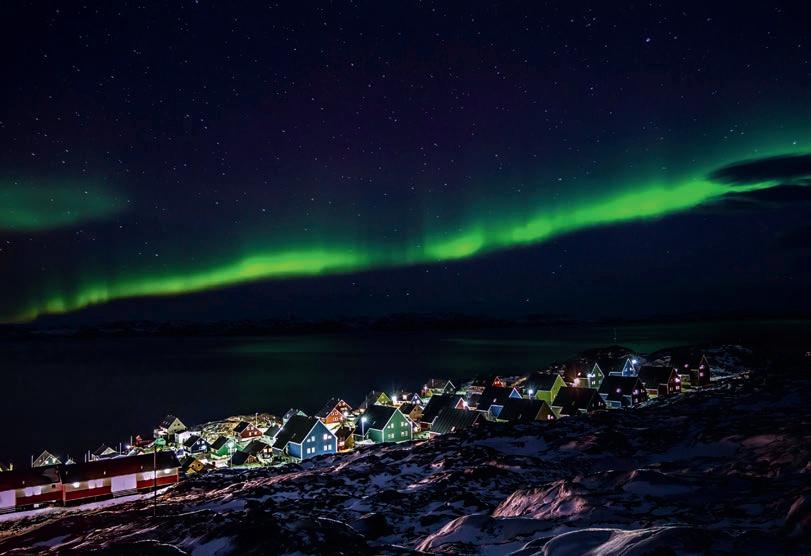
5 WELCOME
Cover image: Salwa Palace in Diriyah, Saudi Arabia, by Diriyah Gate Development Authority; cover wrap & this page: Alamy WANDERLUST: ‘The wish to travel far away and to many different places’ – Cambridge Dictionary
Greenland capital Nuuk is one of the most remote locations on Earth, and an incredible city from which to view the northern lights
George Kipouros Editor in Chief @georgiostravels Twitter Latest travel news @wanderlustmag Instagram See behind the scenes @wanderlustmag Facebook Join the chat at www.facebook.com/ wanderlusttravel magazine @wanderlustmag Newsletter Sign up to our newsletter for news, offers and inspiration at wanderlustmagazine.com Subscribe For the latest offer, turn to page 92 Missed the last issue? shop.wanderlust.co.uk Wanderlust: Off the Page Catch up with our very own podcast Wanderlust is the UK’s leading independent travel magazine, taking the road less travelled since 1993. Paul Morrison
Lyn Hughes
aspiring to produce a publication that combined the right mix of wildlife, activities and cultural insight. Under new management since
include further themes like history, archaeology and urban destinations as an editorial focus while further strengthening its
sustainable travel. It is now available in the USA, Canada and in over 70 countries around the world. With a strong and rapidly growing
thousands of articles and attracts over 12 million visitors a year, alongside 180,000+ social media followers.
engaged 24/7. Wanderlust’s blend of exclusive features, practical reviews, unique insights, tips and ideas has
Contributors
TEBOGO PIN-PIN
Cape Town, p52
Travel influencer Tebogo goes in search of Cape Town’s finest ‘stays with a view’: “The Mother City is home to some of South Africa’s most historic hotels. It’s not just about the setting, the best addresses have a timeless glamour and tell the story of the Cape’s colourful past and present, with grande dames by the coast and modern stays on the renovated waterfront.”
JULIET RIX
Diriyah, p94 Juliet, a long-time broadcaster, writer and author, visits Saudi Arabia and discovers a country much changed: “I didn’t expect to find myself on a ‘magic carpet’ in an old industrial unit in the desert, but Saudi’s efforts to diversify its economy and attract tourists is leading not only to social changes, but a new interest in history, archaeology and (in this case) contemporary art.”
MARK JONES
The Great Lakes, p152 Travel writer Mark takes on the USA and Canada’s Great Lakes on a new expedition cruise: “With cruises, I’d always thought that you go to lots of places without getting to know them – that it’s all appetisers and no main course. On the Great Lakes I worked out that the water is the destination. You have to still your mind and concentrate on what’s around you, not where you’re going.”
Get In Touch
LONDON OFFICE
Capital House, 25 Chapel St, Marylebone, London NW1 5DH

Subscriptions +44 (0)1371 853641, subs@wanderlust.co.uk
Advertising +44 (0)20 3771 7190, sales@wanderlust.co.uk
EDITORIAL CONTENT
Editor-in-Chief George Kipouros @georgiostravels

Founding Editor Lyn Hughes @wanderlust.lyn


Sub Editor Gareth Clark
Special Features Editor Rosie Fitzgerald @rosiefitzgerald

Contributing Editors Sarah Baxter, Mark Carwardine, Paul Goldstein, William Gray & Mark Stratton




DESIGN
Art Director Graham Berridge Assisted by Scott Jessop (maps)
DIGITAL
Digital Creative Director Anil Karwal Digital Editor Jessica Reid
LIZZIE POOK
Torres Strait Islands, p76 Lizzie is an award-winning travel writer and the author of Moonlight and the Pearler’s Daughter. This issue, she visits Australia’s remotest islands: “I was amazed how historically significant the Torres Strait is. Its islands played a key part in the Second World War, fuelled a lucrative pearl-shell trade and have endless stories of wrecks and lost adventurers.”
MARK BAKER
Poznań & Toruń, p168
Central Europe is author and travel writer Mark’s beat. This issue, he finds plenty to savour in Poland’s medieval cities: “You may well see bulldozers rumbling across Poznań’s 16th-century square, as its renovation continues into 2023, but the city remains as vibrant as ever, and the project promises to make it one of Poland’s finest public spaces.”
BELLA FALK
Guatemala, p36 Documentary maker, travel writer and photographer Bella finds comfort in Guatamala’s Maya/Spanish-influenced food: “In the highlands, the elevation can put a bite in the air, so a lot of traditional Guatemalan food was much heartier than I’d imagined, with plenty of rich soups and spicy stews that were great for reinvigorating me after a day’s hiking.”
COMMERCIAL PARTNERSHIPS
Partnerships Director Adam Lloyds (adam.lloyds@wanderlust.co.uk)
Head of Brand Partnerships David Read (david.read@wanderlust.co.uk)

Senior Creative Partnerships Manager Simon Bryson @_bryos
PUBLISHING
Chief Executive George Kipouros
Elliot Wellsteed-Crook
SUSTAINABILITY
Wanderlust is
forestry
to ISO14001, an





environmental standard that ensures commitment to low carbon emissions and environmentally sensitive waste management. The paper can be widely recycled.

NJ and
www.wanderlustmagazine.com/about-us

Marketforce (UK)


Marketing
In memory
Wildman Mullett
Manager Maria Manta
ABOUT US
Chief Operating Officer
& Social Media Manager Christina
Wanderlust Club
of Co-founder & Publisher Paul Morrison RECENT AWARDS © Wanderlust Travel Media Ltd, 2022, ISSN 1351-4733 Published by Wanderlust Travel Media, Capital House, 25 Chapel St, Marylebone, London NW1 5DH. All rights are reserved. Reproduction in any manner, in whole or in part, is strictly forbidden without the prior written consent of the publishers. All prices are correct at time of press. No responsibility for incorrect information can be accepted. Views expressed in articles are those of the authors, and not necessarily the publishers. Wanderlust is a registered trademark. US distribution Wanderlust, ISSN 1351-4733, is published bi-monthly and is distributed in the USA by Pitney Bowes International Mailing Services Inc as mailing agent. Periodicals postage paid at Kearny,
additional mailing offices. Contributions & work experience For details, please go to
Printing Walstead Roche, Victoria Business Park Roche, St Austell, Cornwall PL26 8LX Newstrade distribution
Ltd: 0203 787 9001 Circulation marketing Intermedia Brand Marketing Ltd: 01293 312001 Pleaserecyclethismagazine
OfficialpartneroftheFCO’s KnowBeforeYouGoCampaign
printed on paper from sustainable
and produced using suppliers who conform
industrial,
6 December 2022/January 2023



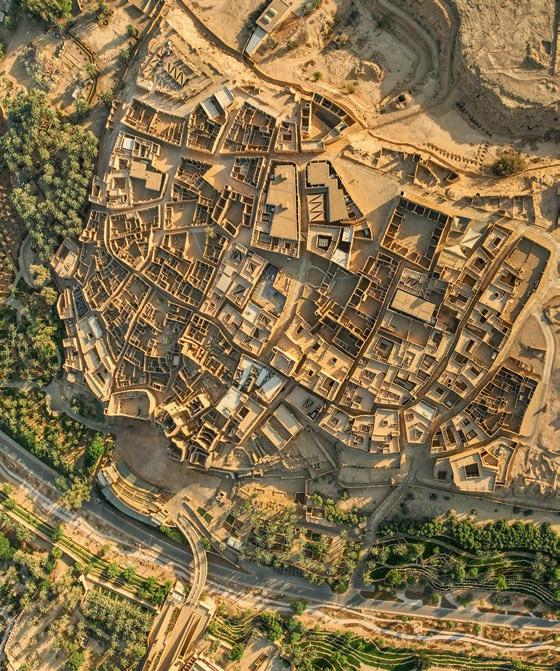




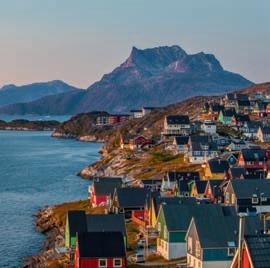

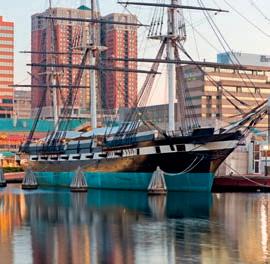





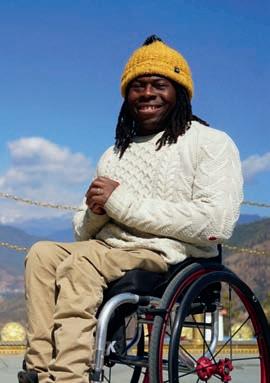
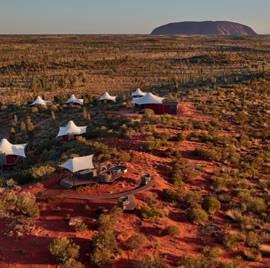



CHECK IN 10 Viewfinder Voluptuous art in Cartagena, Canada’s hungry polar bears and Wanderlust’s Photo of the Year 16 Just Back From… Our digital editor gets cultural in the rocky British exclave of Gibraltar; plus our letter of the month 21 Your Photos This issue’s top shots from you JOURNAL 27 Grapevine The latest travel news, views, stays and events to keep you in the loop 32 Armchair Travel Stanfords picks our top reads; plus, more on our Off the Page podcast and the best travel TV 34 Arts & Crafts: Uganda Why Uganda’s traditional crafts always have a sustainable twist Contents 36 World Food: Guatemala Maya meets Spanish in Guatemala’s spicy cuisine 42 Sustainable Travel Why disabled travel is as much about inclusivity as accessibility 44 Interview: Ade Apeditan The paralympian-turned-TV star on speaking up for himself 52 WanderSleeps: Cape Town Cape stays that put its beaches and mountains on widescreen 58 Dream Sleep: Australia Discover a safari-style camp in the Red Centre that leaves no trace 62 Christmas Gifts The perfect festive travel gifts for yourself or someone special 66 Dispatches: Thailand For decades, Thailand’s captive elephants have suffered at the whims of tourism; now it may hold the key to a better future 52 32 182 170 94 66 34 58 36 44 8 December 2022/January 2023 THIS ISSUE MAPPED
FEATURES

76 Torres Strait Islands









The islands off Australia’s northernmost tip are as remote as it gets. But those who make it up there will find hidden histories, Indigenous cultures and a sea of stories

94 Diriyah

A series of grand projects is changing the face of Saudi Arabia as it shifts towards tourism. None holds greater cultural significance than the renovation and reopening of its original capital, Diriyah. We take a sneak peak before the first visitors arrive
114 Sustainable Spain






















There are countless ways to tour Spain and lessen your footprint. These itineraries offer up a slower take on some timeless locations

134 Alternative Winter Breaks

From frozen hotels to fire festivals; icy encounters to Christmas

markets; spas to volcano skiing –have yourself a winter to remember 152 Great Lakes, USA
It might seem overkill to take an ice-strengthened cruise ship to explore the lakes spanning the US-Canada border, but it opens up this region in a way most never see

DISCOVER

168 Double Bill
The cities of Poznań and Toruń gift a glimpse of life in medieval Poland 170 Hidden USA
The Capital Region is more than politics. Beyond DC lies bucolic countryside and rejuvenated cities
174 Indigenous


The Karaim arrived in Trakai, Lithuania, as medieval warriors; six centuries later, they are still inseparable from the city
176 World Heritage
The history of Colombia’s Villa de Leyva dates back to long before the first humans set foot there 178 British Break
Life revolves around the tides in the Isles of Scilly, which makes it an ideal spot for slowing down 182 Off Grid
Greenland’s capital, Nuuk, is quirky, remote and preparing for a new airport that may change it forever 186 European Short Break
How Germany’s North RhineWestphalia turned industrial decline into art and culture
Top Guide
Guide Craig Wickham talks about life on Kangaroo Island
Map illustration: Scott Jessop
194
134 76114186 152 SUBSCRIBE TODAY! And get exclusiveaccess to competitionsoffers,and events. See p92for details Poland Nuuk Villa de Leyva Uganda Zambia Cape Town North Rhine-Westphalia Diriyah Gaeta Maldives Nepal Taiwan Lithuania Torres Strait Islands Red Centre Hokkaido South Korea New Zealand Scotland Idaho Spain Isles of Scilly Utah Mexico Cartagena Iceland Churchill Patagonia Great Lakes Capital Region 168 176 34 134 52 186 94 134 134 42 134 174 76 54 134 134 134 134 10 134 114 178 134 10 182 10 134 152 170 27 www.wanderlustmagazine.com 9

Cartagena, Colombia
Photographers: Hemis/Alamy
Cartagena is a city of bold images and complicated histories, as new book Cartagena Grace by Lauren Santo Domingo and Johanna Ortiz shows. The city’s UNESCO-listed Old Town may owe its look to the coffers of King Philip II of Spain, but it bristles with colours born entirely of its Caribbean coastline. Then there are the palenqueras: ladies in bright dresses of African design, who walk the streets posing for snaps, but whose origins lie in San Basilio de Palenque, a 17th-century village of runaway slaves that became the first ‘free’ town in the Americas. This shot brings these two sides of the city together with another icon: the voluptuous La Gorda Gertrudis by Fernando Botero, an artist who knows that true beauty comes from the shape of imperfect things. It is Cartagena in a nutshell: seductive yet with a depth that rewards the traveller who looks closer.
© Hemis/Alamy. Cartagena Grace by Lauren Santo Domingo and Johanna Ortiz (£70; Assouline) is out now; eu.assouline.com


VIEWFINDER

The western shoreline of Canada’s Hudson Bay sees a huge build-up of polar bears in autumn, as they cluster around the water in anticipation of the ice thickening enough for them to fish. This area is one of the best polar-bear viewing spots in the world, but it now sees 40 fewer days of ice in a year than it did four decades ago, according to research by Polar Bear International. For visitors it’s an unmissable sight, but it’s also worth remembering the cost. These animals lose nearly a kilo of body weight every day that they’re on land and their hunt for food often brings them into conflict with townsfolk. This is why books like Remembering Bears, part of a series where some of the world’s best wildlife photographers donate their work to raise funds for conservation, is so important. As this shot shows: for all their fearsome strength, these are creatures that are living a very fragile existence.
©Dave Sandford/Remembering Bears. Remembering Bears by Wildlife Photographers United (Remembering Wildlife; £45) is out now; https://rememberingwildlife.com
 Churchill, Canada
Photographer: Dave Sandford
Churchill, Canada
Photographer: Dave Sandford
VIEWFINDER

Early spring, Iceland

Photographer: Pawel Kamionka
One of the great joys of working at this magazine is seeing the annual entries for our Wanderlust Photo of the Year competition pour in. The judges gather, their forthright opinions are shared (in good spirits) and the winners are chosen. This incredible frozen landscape was sent in by Pawel Kamionka last year, and as you can see, it sets a high bar for this edition – “It evokes the raw beauty of Iceland out of season,” agreed our judges. Second only to leafing through thousands of travel shots is the sight of seeing you, dear reader, browse some of our favourites at Destinations: The Holiday Travel Show, where we run our annual gallery of the best entries from that year and invite you to vote on your top pick. We look forward to seeing you again in 2023, and we promise to make it as difficult to choose as always.
©Pawel Kamionka. Tickets are now available for Destinations: The Holiday Travel Show in Manchester (Central; 12–15 Jan) and London (Olympia 2–5 Feb) at DestinationsShow.com. See p150 for further details.
VIEWFINDER
A rock and a hard place (clockwise from this) Gibraltar’s Rock peaks at 426m and is riddled with tunnels – part of a network that spans 55km; St Michael’s Cave was used as a hospital in the Second World War; the city’s Catholic cathedral sits on the site of a 15th-century mosque; driving Monument Valley in Utah
Gibraltar
Wanderlust digital editor Jessica Reid finds history and culture in the UK’s rocky outpost on the edge of the Mediterranean

Thehighlight: At just 6.8 square kilometres in size, ‘Gib’ – as the locals call it – has more to see than most people give it credit for.With its position at the southern tip of Europe,the UK overseas territory is a melting pot of British, Spanish and North African influences. Just stroll down Main Street and you will find a Mediterranean atmosphere, the odd British phone box and splashes of Moorish architecture. This mix of cultures is evident in its food scene,too. Must see: Upper Rock Nature Reserve is an area of protected green land home to Gibraltar’s most noteworthy attractions. From the glass-panelled Skywalk, located 340 metres above sea level, you can gaze across to Africa’s silhouette as well as the coastline of Spain.Explore St Michael’s Cave and its new immersive light-and-sound installation, which brings to life the story of its formation. Elsewhere, the Great Siege (1779–83) and SecondWorldWar tunnels offer insight into life during conflict and the feats of engineering that went into their creation. Toptip:The surrounding waters are home to populations of common,striped and bottlenose dolphins.


If joining a dolphin boat tour (dolphin.gi), grab a seat at the bow to watch these playful creatures swim alongside, flashing their white bellies as they go. Cautionarytale: Gib’s only UNESCO-listed site, Gorham’s Cave Complex, pokes into the eastern side of the Rock and has evidence of Neanderthal life. As studies continue, only a handful of people can visit each year on guided tours arranged in advance with Gibraltar National Museum. I wish I had known: The expression ‘cheeky monkey’ has never been truer. Around 300 wild Barbary macaques live up on the Rock, and they will attempt to steal your bag or unzip your rucksack to hunt for food if you’re not wary. Enjoy them from a distance while keeping your possessions close. Anything else: It’s not just about the Rock.Take an e-bike tour (ebike-gibraltar.com) around it and visit gems closer to the shore. Camp Bay and Europa Point are worth a pit stop, while the eastern coast offers a quiet escape,with its shell-littered sand beaches and colourful clusters of houses and fishing boats in the Italianesque Catalan Bay.
LETTER OF THE MONTH
I have just returned from a two-week circuit of the parks and canyons of Utah and Arizona in the USA. I thought that it would be useful to share some of what I encountered. For instance, the campgrounds and roads limit campers (RVs) to less than 22 feet (6.7m), which is plenty long enough for a family but worth knowing. Many park campgrounds also fill up at least six months in advance, but can be booked online from the UK. They are also much cheaper than commercial sites and far more pleasant. At Archers Canyon (Utah) you have to book entry time slots to get in at all, and it’s essential that you do this before getting to America. The same applies to some trails in the parks, though you may get lucky with the daily lottery for trail permits. All in all, it was the trip of a lifetime, with litterfree and pot-hole-free roads and like-minded people in the parks and campgrounds.
 John Sharvill
John Sharvill
Drop us a line with your stories and travel tips at fromtheroad@wanderlust.co.uk and help others find their way. Also, follow us on Facebook (wanderlusttravelmagazine), Twitter (@wanderlustmag) and Instagram (@wanderlustmag).
JUST BACK FROM…
Wanderlust reserves the right to edit all submissions; images: Jessica Reid; Shutterstock 16 December 2022/January 2023























































PROMOTIONAL FEATURE
























“I saw this young gorilla while trekking in Bwindi Impenetrable Forest, Uganda. The little ones were all so playful!” Adele Muscat

”Our trek to Kyrgyzstan’s Ala Kul lake saw us hike up to 3,500m, where we camped under the Milky Way.” @michaelcharlessheridan

“We decided to practise canoeing on Atlin Lake in northern British Columbia before taking on the Yukon River.” Roger Bentley

“Visiting the mud volcanoes of the Gobustan State Reserve, not far from Baku in Azerbaijan.” Christine Conway

in

beneath the giant redwood

“This shot was taken while gazing out across the Clifton Suspension Bridge that spans the Avon Gorge, on the outskirts of Bristol. This feat of Victorian engineering, designed by Isambard Kingdom Brunel, has stood for more than 150 years.” @ourworldforyou

“A majestic and elegant wherry brings some peace and calm among the noisy hire boats in Wroxham, UK.” @whatstaceyshot

www.wanderlustmagazine.com 21 YOUR PHOTOS
“Peering through the ‘Window in the Rock’ on the beautiful isle of Sark in the Channel Islands.” HazelWright
#wanderlustmag You’ve been sending us images of your latest trips and favourite adventures – tag us at #wanderlustmag on Instagram or email them to us at fromtheroad@wanderlust.co.uk “Standing
trees
Mill Valley, near San Francisco – they can reach as high as 80 metres.” Ruth Keir
GET MORE FROM YOUR TRAVELS WITH REVOLUT, THE ULTIMATE TRAVEL COMPANION


Escaping
to far-flung places, where it feels like you really have fallen off the map, is one of travel’s greatest joys. Exotic adventures like these allow us to slow down and really melt into our surroundings, being stacked with experiences that will be seared into our brains long after we’ve returned. However, planning a trip to somewhere like this is never the simplest, which is why we’ve teamed up with Revolut, the perfect partner that helps you to travel smarter and be more financially savvy. This leaves you the time to savour those precious travel moments – here are just some of the ways Revolut can help you on your travels...
EXPERIENCE MORE FOR LESS
At Wanderlust, we can never emphasise enough the importance a local guide has in unlocking the heart and soul of a destination. They add colour to their own culture, giving a raw insight to somewhere you’d only be able to scratch the surface of normally. Native American guides in the USA’s Old West can take you to secret, sacred canyons that few others know about, while a local naturalist in Papua New Guinea will have laser-like eyesight
for spotting its elusive national bird, the Raggiana bird-of-paradise, in the country’s jungles when it would otherwise elude you. It seems the team at Revolut agree, as a Revolut Premium membership offers 10% cashback on any guided excursions and tours you book. So, in both senses of the word, it pays to tap into the rich expertise of the place you’re visiting – you’ll be rewarded handsomely.
A GREAT NIGHT’S SLEEP
It’s not just expert guides that can really add value to your travels; where you rest your head is just as important. Don’t treat accommodation as ‘just’ somewhere to sleep, as hotels can really give you a superb sense of place. Take Pacuare Lodge in the thick rainforest of Costa Rica, a unique stay that you can only reach by white-water rafting to it along the Pacuare River. In Chiang Rai in Thailand, the Anantara Golden Triangle’s distinctive bubble suites mean you can spot elephants outside your room, while the Sky Lodge’s hanging capsules in Peru’s Sacred Valley feel like death-defying bedrooms in one of the world’s most dramatic corners. Just like the guided tours and excursions, Revolut also offers 10% cashback on any accommodation you book before you
travel, making for an even sweeter deal when you’re drifting off to the natural sounds of the landscape around you.
SLOW DOWN AND SEE MORE Travel should rarely be whistle-stop. The more time you afford it, the more a culture opens up to you. Laos’ compact size means the temptation is to leapfrog through its highlights, but the country deserves to be enjoyed languidly. Spend time walking the temples of Luang Prabang, cruise the Mekong River and head to Phongsali to trek past rice paddies and meet the locals. California is somewhere else that lends itself to slow travel on a road trip along the Pacific Coast Highway. There are many pit-stops you can make along this legendary road to drench yourself in Americana, from Mendocino’s boutique wineries to the craggy coastal drama of Point Lobos State Natural Reserve. Revolut is a travel companion that encourages you to linger for longer, giving you the power of fee-free withdrawals of up to £400 each month, no matter where you are in the world or for how long, and free foreign exchange purchases.
FUEL YOUR FUTURE TRAVEL INSPIRATION
For adventurous ideas, you’re in the right place. For almost 30 years, Wanderlust has been overflowing with travel inspiration within these pages to help supercharge your next trip. Add a Revolut card into your travel arsenal and there’s nothing stopping you from exploring the world and unleashing your own wanderlust. It’s a dream duo and that’s why we’ve merged the two for an unbeatable offer, giving away a 12-month subscription to Wanderlust when you sign up to Revolut.
the




to

JOIN REVOLUT AND ENJOY A FREE WANDERLUST SUBSCRIPTION! Get 2 months of Revolut premium and receive a 12-month print or digital subscription to Wanderlust. These are just some of the perks of Revolut Premium: *Complimentary travel insurance * (Revolut Travel t&cs apply) *Up to 10% cashback on accommodation with Stays *£400 of zero-fee cash withdrawals *Unlimited foreign exchange – on transfers & purchases It’s easy and speedy to do in just a few short steps: 1. Sign up with your phone number 2. Complete three transactions 3. Order your Revolut card and bag two months of Revolut Premium for free You’ll then receive a code which you can use to redeem your Wanderlust subscription (UK or Europe only) – pick between print or digital. *You can cancel your plan for free at any point within the free trial. Just head to Profile > Plans and select cancel. If you’ve ordered a card during your trial period and you switch to a Standard plan, you’ll be charged for the card. Scan
code
get the offer:





The latest news, tips and stays, plus we look at disability in travel, why tourism holds the key to saving Thailand’s elephants, Guatemala’s spicy cooking, and much more…journal Grapevine 27 Armchair travel 32 Arts & crafts: Uganda 34 World food: Guatemala 36 Sustainable travel 42 Interview: Ade Adepitan 44 WanderSleeps: South Africa 52 Dream sleep: Australia 58 Christmas gifts 62 Dispatches: Thailand 66 Between a rock and a wild place Nestled snugly in the shadow of the Twelve Apostles mountains, Cape Town’s Camps Bay is just one dramatic coastal setting among many that a new wave of innovative South African stays are now making the most of; see p52
Alamy

What’s New
New year, new Green Capital
As January approaches, we can expect a new European Green Capital. Grenoble will be passing its crown on to Tallinn, the 13th city to receive this title. With its UNESCO-listed historic centre, the Estonian capital is one of the best-preserved medieval cities in Europe and impressed the international jury with its approach to sustainable governance and its ambitious goals, including achieving full climate neutrality by 2050. Celebratory events will be taking place throughout the year, including an opening ceremony in January and a green expo in the autumn, or just wander its cobbles and pedal its cycle paths for your own low-impact escape. visittallinn.ee/eng
Pioneers of sustainable travel

After two years of closure due to the pandemic, the Buddhist Kingdom has reopened its doors to the public. It does return with a difference, however. The nation has always had sustainability at its core, but this is being pushed to the forefront. The country recently announced that its Sustainable Development Fee (SDF) – which is payable by tourists – will rise from $65 (£56) per person (per night) to $200 (£173). The fees raised from visitors will go towards funding programmes that preserve Bhutan’s cultural traditions and upgrade its infrastructure. But, most importantly, it has been promised that it will also go towards sustainability projects that will help protect the world’s first carbonnegative country from the impacts of climate change.
ON OUR RADAR
There’s a host of new museums and exhibitions to savour…

A new Genghis Khan Museum has opened its doors in Ulaanbaatar, Mongolia, just on the edge of Sukhbaatar Square. Its collection stretches back more than 2,000 years, with some 12,000 artefacts presenting the history of the Mongolian Kings and the nomad Mongols, from the Khunnu dynasty to the beginning of the 1900s.
We have lift off! Pennsylvania’s only space museum has now opened to the public. Inside the Moonshot Museum (pictured), visitors can go on their own simulated lunar mission, see the first American lander since Apollo being built, and get up close to the technology behind space exploration in the 21st century. moonshotmuseum.org

The 20-year development of Berlin’s Humboldt Forum is finally complete. The museum is dedicated to exhibiting art and culture from around the world, with the final sections – the Ethnological Museum and the Museum of Asian Art – opening just in time for winter. humboldtforum.org/en
Reopened earlier this year after undergoing a big refurbishment, the Burrell Collection in Glasgow celebrates one of the world’s great art and antique collectors, Sir William Burrell. The gallery has now been updated with new interactive digital displays, helping visitors to better understand its late patron’s life and his overwhelming passion for art. burrellcollection.com
Kaupo Kalda/Visit Estonia; Moonshot Museum; Shutterstock
Discover sustainable destinations, marvellous museums and the hottest new hotels in travel right now…
www.wanderlustmagazine.com 27 GRAPEVINE
Remembering Queen Elizabeth II
From all of us at Wanderlust, we would like to convey our sadness to the Royal Family following the passing of Her Majesty Queen Elizabeth II on 8 September 2022. The Queen travelled extensively throughout the Commonwealth and beyond on both royal duties and for leisure during her 96 years.

To celebrate the world’s most travelled monarch, Wanderlust has created a series of articles on her life in travel. Head to our website (wanderlustmagazine. com) to learn more, from retracing her footsteps on her first Commonwealth tour, to understanding why she was said to be at her happiest in Malta.
Wizz away to Jordan
Hungarian airline Wizz Air have announced the launch of its new direct flight from London Luton to Amman in Jordan. Starting from 13 December 2022, the new service will fly three times a week to a capital often dubbed ‘the White City’ for its pale limestone houses. Now its Roman ruins, museums, art galleries and exciting food scene are just a short flight away. And for those who want to explore further, the ancient Nabataean city of Petra, a celebrated UNESCO World Heritage site, is only a few hours from the capital. Tickets are available to book now. wizzair.com
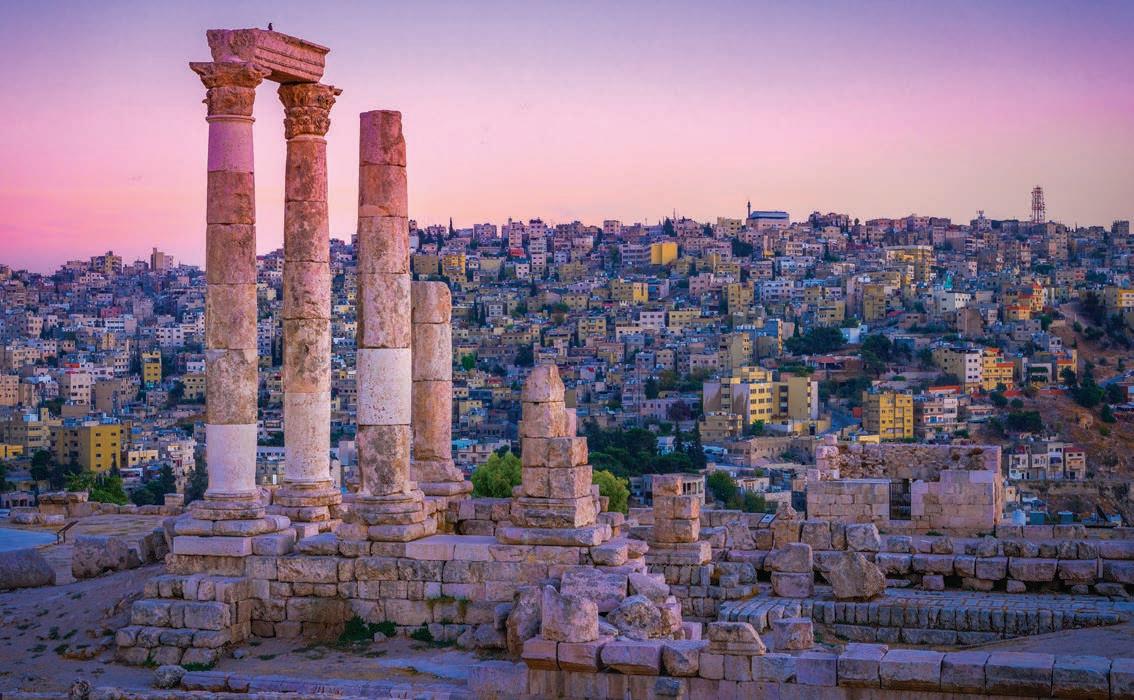
Stefan Amato/Pannier
Alamy; Casa Chablé;
Shutterstock;
28 December 2022/January 2023 GRAPEVINE
New cycling trail in Norfolk

National charity Cycling UK have launched an exciting new long-distance cycling loop around Norfolk. The trail, called the Rebellion Way, is 373 kilometres in length and centres on the city of Norwich; from there you pass through areas including Diss, Thetford, King’s Lynn and Sheringham. The route has been created using bridle paths, country roads, cycle ways and forest tracks. The whole journey is expected to take cyclists four to six days to complete, with the added option of only pedalling half the route and finding alternative public transport home from King’s Lynn. cyclinguk.org
Fine art in Antwerp

Following more than a decade of renovation, the Royal Museum of Fine Arts Antwerp, Belgium, has finally reopened its doors. Originally founded in 1810, this Neoclassical building hosts more than 8,400 paintings, sculptures and prints. With a focus on Flemish and Dutch artists, visitors can expect to be dazzled by the detailed eye of the Flemish Primitives, the Baroque style of the city’s own Peter Paul Rubens, and the 19th century works of Henri De Braekeleer.
NEW SLEEPS
Located to the south of UNESCO-listed biosphere Sian Ka’an, Casa Chablé (pictured top) offers the ultimate seclusion on a private islet in Mexico. This luxury boutique hotel, just 35km from Tulum, is surrounded by five hectares of tropical jungle and is fronted by a glorious white-sand beach. chablehotels.com

Set to make an impression on Paris’ hotel scene is the anticipated November opening of Hôtel Dame Des Art. Located on the stylish Left Bank, close to the Notre-Dame Cathedral, the interior look of this hotel has been led by internationally renowned local designer Raphael Navot. The room’s city views are also hard to beat. damedesarts.com
For a piece of Hollywood history, book a stay in Santa Monica’s The Georgian. First opened in 1933, this restored boutique property on Ocean Avenue expects to welcome guests again in January 2023. Previous Hollywood stars who have visited the hotel and its once-lauded restaurant include Charlie Chaplin and Marilyn Monroe. georgianhotel.com
Sitting on Bahrain’s little-explored south-western coastline is an idyllic new retreat, the Jumeirah Gulf of Bahrain Resort & Spa. The hotel has 196 rooms and suites, an exclusive 11-bedroom beach house and eight dining options, including a restaurant focused on local Bahraini produce. Expect the finest ocean views while being surrounded by luscious greenery. jumeirah.com
www.wanderlustmagazine.com 29
The Wanderlust Club has a great range of exclusive offers, competitions and events for our members – here are just a few. Already a member? Head to wanderlustmagazine. com/your-wanderlust to find out more.
VIRTUAL EVENT: Alice Morrison – Walking with Nomads (10 January)


We go live to the Atlas Mountains, Morocco, where adventurer and broadcaster Alice Morrison talks about her new book, Walking with Nomads, a story of trekking the Sahara, discovering lost cities and dinosaur footprints, and the joy of being out in the wilderness.
25% or 15% OFF! Purchases from the Stanfords website
Stanfords is the UK’s leading specialist retailer of maps, travel books and accessories, and is beloved by explorers and keen travellers alike. Club members can get 25% off the price of any books featured on our ‘Read This’ page (p33) and 15% off any other purchases from the Stanfords website.

15% OFF! Lorton & Horn travel wallets
We love the Lorton & Horn range of quality travel wallets, organisers and other travel goods, and you will too. Made from high-quality vegetable-tanned leather (there are also vegan versions) and available in a range of desirable colours, they are not only practical but super stylish too. Better yet, they can be monogrammed to make the perfect gift.

WIN! A Craghoppers orlena half-zip fleece
We love this snuggly new women’s fleece (see p62) from Craghoppers, which is perfect for winter city breaks, country walks or even chilly houses. We have two fleeces to give away. And note that members also gets 20% off Craghoppers gear.

WIN! A copy of Climb Your Mountain by Sir Ranulph Fiennes
In this inspirational new book from legendary explorer Sir Ranulph Fiennes, he not only shares extraordinary stories of his expeditions, but each themed chapter illustrates a lesson readers can take away with them. We have three copies to give away to Club members.
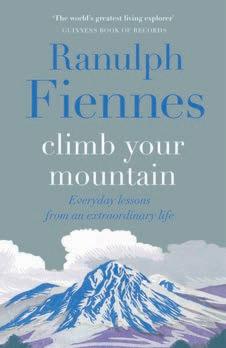
30 December 2022/January 2023



Longing for a quieter life?
Dangerous living, melting ice caps and crocs where they shouldn’t be – travel TV raises the stakes this issue. But you can always escape to Scotland…
Do you have to live on the edge to feel alive? Sue Perkins: Perfectly Legal (Netflix) certainly gives that theory a bit of welly during the self-deprecating presenter’s journey through Colombia, Mexico, Brazil and Bolivia. She meets a local comedian in each country, who steers Perkins toward activities – testing a bullet proof vest in Bogotá, standing in the explosive centre of Tultepec’s National Fair of Pyrotechnics – that are off limits back in the UK. Freed from BBC restrictions, Perkins gets royally hammered and veers off the PR-approved beaten track to show a side of South America that viewers don’t usually see.
After all that danger, the tourist boards will be breathing a sigh of relief at this month’s other new series, which show off destinations at their most epic, and characterful locals at their warmest.This is admittedly pretty easy when you’re campervanning around Scotland, as Martin Compston’s Scottish Fling (BBC iPlayer) reveals.The Line of Duty star’s cheerful, bantering six-part return to his epic homeland takes in the coastlines, the Highlands and the islands, making for arresting viewing. Similarly appealing is Griff Rhys Jones’ new six-part series, Griff’s Canadian Adventure (All4), which takes him east to west through the country, via the frozen north, to soak in that fabled scenery and culture, and the people who call it home.
Australia also gets the spotlight of attention in Netflix’s cliffhanger-heavy Wild CrocTerritory. Fronted by MattWright
– a modern-day heir to the late Steve Irwin’s mantle – who catches and relocates problem crocs.This ten-part show takes us to some of the NorthernTerritory’s wildest, muddiest and least-visited corners, including the Finniss River and Tiwi Island, all in the company of Wright’s young family and some of the NT’s grumpiest reptiles.
Also undergoing his own rugged relocation is Alex Bescoby, who takes a 67-year-old Land Rover Series 1 on a 19,000km, 23-country, setback-strewn drive from Singapore to London on The Last Overland (All4; four episodes). He’s hoping to recreate (in reverse) the original route taken by the same motor in 1955 during a landmark travel documentary (produced by a very young David Attenborough), navigating not only some of South-East Asia’s hairiest roads but also the often-momentous changes to the countries that have happened in the meantime.
And speaking of Attenborough, Frozen Planet II (BBC iPlayer) is still on iPlayer. Despite its astonishing photography, remarkable insight and fresh discoveries evoking a profound sense of wonder, the show (narrated by the great man) also never shies from the environmental disaster unfolding in the Earth’s polar regions. In some ways, rather like Sue Perkins, we’re all living much closer to the edge these days.

Highland times (top–bottom)
Martin Compston [left of middle] goes in search of what makes modern Scotland tick; the great David Attenborough has climate change in his sights as he looks at how wildlife deals with shrinking ice in Frozen Planet II

ARMCHAIR TRAVEL
32 December 2022/January 2023
Read this!
Distant Melodies: Music in Search of Home
 by Edward Dusinberre Faber & Faber; £19
by Edward Dusinberre Faber & Faber; £19
Combining travel writing with insights into the working lives of string-quartet musicians, Dusinberre illuminates the relationship between music and home by discovering ways in which the former tweaks our longing for a place of one’s own. And when travel is forbidden, he finds the ability of music to affirm home and transcend distance takes on extra significance.
brother. do. you. love. me.
by Mani Coe & Reuben Coe Littler Toller; £22 Reuben is living in a home, struggling to accept that he has Down’s syndrome, when he sends the titular text message to his brother, Mani, who lives in Spain. Mani returns to England and moves the pair into a farm cottage, rebuilding their relationship through walks in the area in what is a moving paean to brotherhood.
Everything the Light Touches
by Janice Pariat Harper Collins; £15
A wonderful example of fiction with a strong sense of place. This book journeys across continents as the centuries intertwine in a multi-layered saga that unfolds through the lives of four unique characters, taking us to Italy, India’s north-east and the forests of the lower Himalaya on journeys that change the lives of its protagonists forever.
Parsi: From Persia to Bombay – Recipes & Tales from the Ancient Culture

by Farokh Talati Bloomsbury Absolute; £26 Farokh Talati, head chef of London’s acclaimed Spitalfields eatery St John Bread and Wine, gathers recipes from his travels through India and time spent in the kitchen with family. Blending Persian and Indian cooking from west London all the way to Gujarat and beyond, his life is told through recipes, stories and
WANDERLUST: OFF THE PAGE
ASSOCIATION WITH
Readers get 10% off by using the code ‘Wandering’ on the Stanfords website: www.stanfords.co.uk. Wanderlust members can get 25% off – see p30

photographs in what becomes something of a love letter to the Parsi culture and people.
Antarctica: A History in 100 Objects

by Jean De Pomereu and Daniella McCahey Coway; £25
This book retraces the history of Antarctica through fascinating objects drawn from collections across the world. It has been published to coincide with the 250th anniversary of the first crossing into the Antarctic Circle by James Cook aboard the ship Resolution, on 17 January 1773. As such, it presents a gloriously visual history of the White Continent, from Terra Incognita to the expeditions of Shackleton and Scott, to its emergence as the frontline of climate change.
Atlas of Geographical Curiosities

by Vitali Vitaliev Jonglez; £20
This compendium of curious, interesting, unexpected and downright bizarre

geographical anomalies is filled with fun tidbits to reel off to friends. The world is full of little-known corners that have often been the result of diplomatic horse-trading or overly ambitious armies. Discover countries that do not really exist, the world’s only town that lies entirely underground, a hotel room whose bedroom is in France and whose bathroom is in Switzerland, and lots more.
36 Islands: In Search of the Hidden Wonders of the Lake District by Robert Twigger Orion; £20


Armed only with an inflatable canoe, Twigger – a man resolutely fascinated by uninhabited isles – journeys beyond the tourists and busy roads to explore Cumbria’s finest. In doing so, he visits both real and remembered islands, drawing inspiration from the Lakeland poets, Alfred Wainwright and others, to redraw his own map of the Lakes and visit a place very different to the one we know.
The winter series of Wanderlust’s incredibly popular podcast is out now. If you are intrigued by our feature on Saudi Arabia’s Diriyah and its newly opened UNESCO World Heritage site of At-Turaif in this issue, then tune in to hear Juliet Rix and Lyn Hughes give even more insight and impressions from their recent visit. Other episodes, either available or coming up in the series, include a special on how to plan a Louisiana road trip, tales from Alex Robinson’s atmospheric journey down Brazil’s Río Negro, and a visit to the castles of Bavaria on the trail of ‘The Fairytale King’, so there’s something for everybody. Available from the Wanderlust website and on all the usual podcast platforms.
Words : Tom Hawker/Lyn Hughes; Images: © BBC/Tern Television Productions/Jack Harrison; BBC Studios/Alex Board
From Antarctic relics to drifting the Lakes by blow-up canoe, find your literary travel inspiration – as picked by the experts at Stanfords book shop
IN
www.wanderlustmagazine.com 33 JOURNAL Travel From Home
5
Ugandan crafts with an eco-twist

1 BARK CLOTH
The Baganda people of southern Uganda produce bark fabric – which is on UNESCO’s Intangible Cultural Heritage list – by boiling the inner bark of a mutuba sapling and pounding it until it stretches like dough.After drying in the sunshine, it turns the colour of a lion’s mane and smells like cedar. It is typically worn like a toga at coronations, healing ceremonies and cultural gatherings.
2 GORILLA WOOD CARVINGS
Mountain gorillas are critically endangered creatures, and around half the world’s population – over 340 – are found in Uganda’s Bwindi Impenetrable Forest NP.The Rafiki Memorial Wildlife Conservation Initiative discourages indigenous communities from poaching these great apes by enabling them to earn an income from making and selling wooden gorilla masks and sculptures instead.
3 BASKETS
Ugandans often gift baskets to brides,who use them to store vegetables, keep food hot and deco-
rate their home. Sustainable and durable, these are usually made from the fibres of bukedo (banana leaf stalks), which are dried in the sun and wrapped in raffia straw dyed with hibiscus flowers, indigo and turmeric.The thread is then handwoven into coils.
4 KITENGE
The people of Uganda have practised the Indonesian method of batik printing – drizzling wax on to cotton, then dyeing it – since the Dutch first introduced the technique in the 1800s.The process produces colourful, bold patterns on fabric, known as kitenge,which is then turned into sarongs, headscarves, baby slings and long dresses.
5 KARAMOJONGHEADDRESSES




Nomadic Karamojong men, from the northeastern region of Karamoja, are known for wearing elaborate headdresses during dances and initiation ceremonies.These used to be earned by killing a predator or enemy, and they symbolise status and bravery.Made from clay,they are typically lined with human hair and decorated with ostrich feathers.
WHERE TO BUY…

Bark cloth
You can buy bark cloth in its natural caramel hue, or dyed the colour of creamy coffee, at Masaka’s open-air central market (note: the thicker the cloth, the better the quality). Connect with Bukomansimbi Organic Tree Farmers Association on Facebook to ask about workshops.

Gorilla carvings
Rafiki’s gallery (rafikiwildlife. org), at the entrance of Bwindi Impenetrable Forest NP, sells paintings and wooden sculptures of gorillas. Bwindi Local Woodcarvers Association also hosts mask-carving and painting workshops there that last up to four hours.

Baskets
In Kampala, buy baskets at the National Arts and Crafts Village or make your own at Uganda Crafts 2000 (ugandacrafts2000ltd.org). Its workshops last from four hours to three weeks – the price depends on the length and number of participants.

Kitenge
Shop for kitenge at the capital’s Kampala Fair on 50 Bukoto Street. To design your own, contact Yimba Fashions (yimbafashions.com), who employ and train vulnerable local youths and host tours to the fabric markets.
Karamojong headdresses
Theo Vos of Kara-Tunga Arts & Tours (kara-tunga.com) hosts three-hour workshops in clay-sculpting, headdressweaving and beekeeping in Karamoja on request. The meeting point is at Plot 8, Lomilo Road, Moroto.

Buy traditional crafts made with sustainable materials and you’ll return home from Uganda with a meaningful memento that is also helping to empower local communities
34 December 2022/January 2023 ARTS & CRAFTS Words: Sarah Riches images: Alamy; Jamie House Photo; Mothers in Motion; Shutterstock1 2 43 5



Flavours of the Maya
Words Bella Falk
Until its Spanish conquest in the 16th and 17th centuries, Guatemala was the land of the Maya, who built magnificent jungle cities and cultivated crops like corn (maize), beans and squashes. Today their towering temples lie in ruins, but around 6.5 million descendants still live in a country whose cuisine is a rich blend of Indigenous and Hispanic heritage.
Dubbed ‘The Land of Eternal Spring’ thanks to its temperate climate, Guatemala has no shortage of fresh produce, which is sold at buzzing weekly markets.The main crop is corn, which was sacred to the Maya (who believed humans were formed from it) and appears at almost every meal: from soft tortillas baked on a flat griddle to squishy tamales (corn dough wrapped in a flat maxan leaf and steamed). Other
local ingredients include beans, usually served mashed and fried, and mouth-watering mangos, which you can buy at roadside stalls sprinkled with chilli and lemon.
Guatemala’s varied landscapes have also played a role in the food you find today. In the chilly western highlands, warming recados (thick, spiced stews) are commonplace after a long day of hiking, whereas you will find that seafood and coconut milk feature far higher on menus along the Caribbean coast.
In cosmopolitan towns such as Guatemala City and Antigua, there is no shortage of elegant restaurants offering excellent meals at international prices.The cheapest way to explore Guatemala’s culinary diversity is at street-food stalls and at the local comedores (eateries), which serve delicious and filling set menus that are worth far more than what you pay.
Local favourites (top) The highland town of Chichicastenango is best known for its busy market, which is one of the largest in Latin America and a great place to pick up some fresh street food, including hand-made tortillas
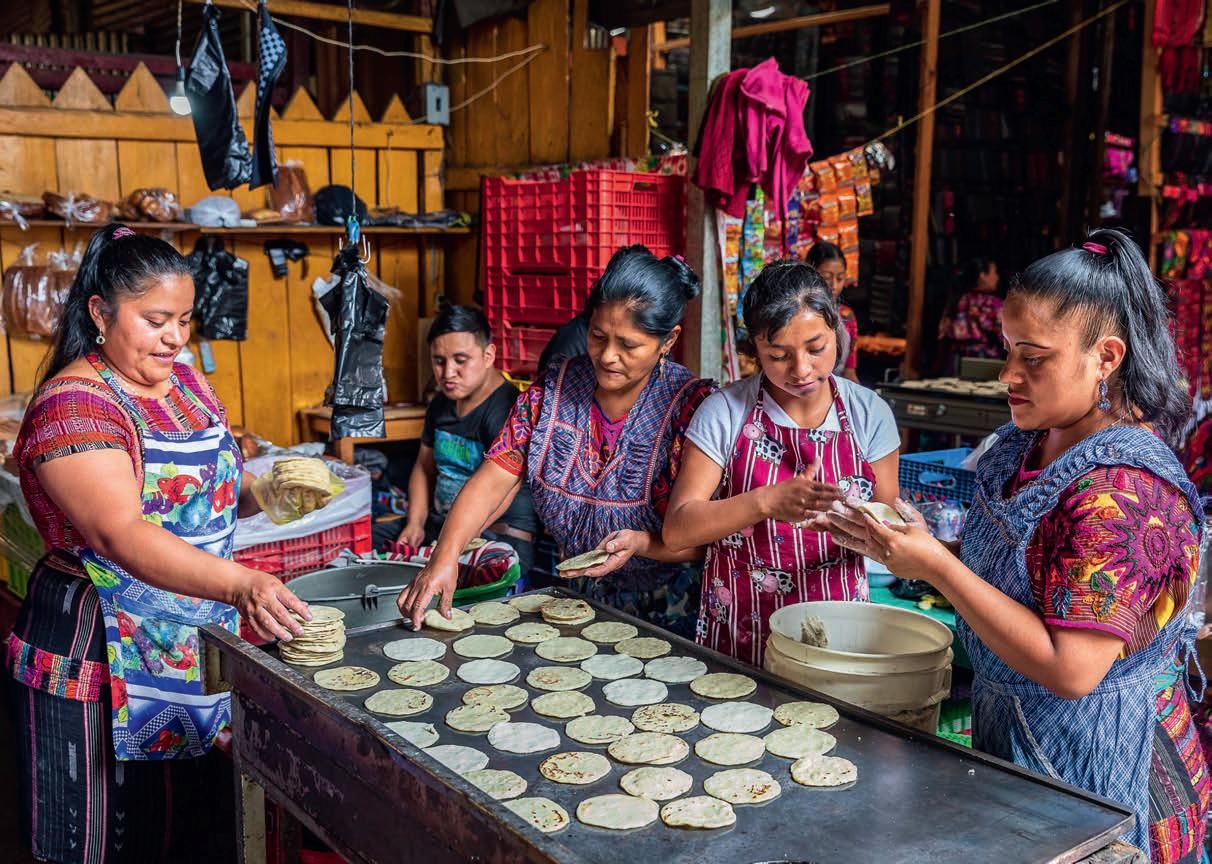
Guatemala’s mixed culinary heritage offers a glimpse into a history and style of cooking that was forever changed with the arrival of the conquistadors
36 December 2022/January 2023 WORLD FOOD
5 DISHES YOU SHOULD TRY (AND WHERE TO TRY THEM)
1Pepián



Often dubbed ‘Guatemala’s national dish’, this rich, velvety stew is a highland comfort food handed down through generations of Maya. Tomatoes, pan-toasted pumpkin and sesame seeds, dried chilli and cinnamon give the sauce its sweet, nutty flavour and smooth texture. It’s usually spooned over chicken, served alongside rice and tortillas or tamales. At Café Sabor Cruceño in Santa Cruz on Lake Atitlán (amigosdesantacruz. org), your order comes with lake and volcano views, plus the warm glow of knowing that all restaurant profits go to helping the local community.
2 Jocón

Another traditional Mayan meal is the vivid green jocón, a warming stew made with coriander, mint, green jalapeño chillies, ground sesame and husked tomatillos. Eaten with chicken, pork or beef, jocón is pepián’s darker, spicier sister dish, and no exploration of Guatemalan cuisine is complete


without tasting both. Try it at Flor Maya restaurant (+50 27 7631 303) in the highland city of Quetzaltenango, where the 2,330m elevation only adds to the experience.
3 Kak-ik
Blanketed with misty cloud forests, the central Alta Verapaz region is home to both Guatemala’s national bird (the quetzal) and the Q’eqchi Maya people. In their language, the suffix ‘ik’ means chilli, giving a clue to one of the key ingredients in this iconic dish. Kak-ik is a warming turkey soup made from a spiced red broth that includes cinnamon, cloves, tomatoes and chillies. The colour comes from ground achiote, a historic ingredient used by the Maya as a dye. The best place to try kak-ik is at El Peñascal (+50 27 951 2102) in regional capital Cobán.
4 Garnachas
Local markets are the beating heart of Guatemala’s towns and villages, and street food is the fuel that
drives them. Top of the street menu here are garnachas, tortillas goldenfried on a griddle and then piled with savoury toppings like ground beef, refried beans, shredded cabbage, cheese and mustard. They are available everywhere from street-food stands, especially on national holidays and at festivals; you can even order them as a starter in restaurants.
5 Rellenitos de plátano


Desserts and cakes aren’t as much of a national institution in Guatemala as in some countries, but these traditional sweet croquettes are made from cooked and mashed plantain, which is then moulded into oblong balls, filled with refried beans (sometimes mixed with chocolate or cinnamon), deep-fried and topped with sugar. They’re not as toothachingly sweet as Brits and Americans might be used to, but those served at El Adobe restaurant in Guatemala City (+50 22 221 0567) are among the best in the business.
DID YOU KNOW?
Guatemala is the birthplace of chocolate, which was discovered by the Maya. They consumed it as a bitter drink flavoured with chilli and spices, and even buried their royals with chocolate pots as offerings to the gods. Cacao pods were so valuable that the Maya traded them as currency. Today, chocolate shops in many Guatemalan cities offer excellent chocolate-making workshops.
WANDERLUST RECOMMENDS
Amalia’s Guatemalan Kitchen: Gourmet Cuisine with a Cultural Flair (£41; Bookhouse Fulfillment) was written by Amalia MorenoDamgaard, a classically trained Guatemalan-American chef, and has 170 Guatemalan recipes with Mayan and Spanish influences.


4 1 2 3 Bella Falk; Shutterstock
5
JOURNAL Guatemala www.wanderlustmagazine.com 37
Culture awaits in Crete
Beyond Crete’s well-known beaches awaits a unique civilisation worth exploring. Located at the crossroads of Europe, Asia Minor and Africa, for the past five millennia the island has hosted Minoans, Mycenaeans, Romans, Arabs, Byzantines, Venetians and Ottoman Turks. They left an array of fascinating cultural treasures in their wake that can still be seen today. Here are ten sites that you should seek out.
1 THE PALACE OF KNOSSOS
Tales of King Minos and the Minotaur come alive at Knossos. The greatest Minoan palace, five kilometres south of Crete’s capital, was destroyed around 1380 BC and never built over because it was considered cursed. It was discovered in 1878 by Cretan antiquarian Minos Kalokairinos and excavated in 1900 by British archaeologist Sir Arthur Evans. With over 1,500 rooms it truly resembles the labyrinth of myth. Highlights include the royal road and
Sail back
Spinalonga, a former leper colony,

‘theatre’, the world’s oldest throne, Europe’s oldest plumbing, and reflecting ‘lustral basins’ that brought light into the palace’s depths. Don’t miss the Tripartite shrine overlooking the central court, where ceremonies and perhaps even ‘bull leaping’ took place. Copies of the frescoes and the mysterious ‘horns of consecration’ adorn the site.
2 THE ANCIENT CITY OF APTERA
Located 200m above Megala Chorafia, east of Chania, Aptera was mentioned in
Alamy; Nikolaos Kontostavlakis; Papoulakis
38 December 2022/January 2023
Ten fascinating surprises well worth seeking out on Greece’s largest island
in time (this page; top)
can be reached by boat from Agios Nikolaos, Elounda and Plaka
the Minoan Linear B tablets discovered by Arthur Evans. It reached its peak in the 3rd century BC when it was one of the most important city states in Crete and famed for the skill of its archers. According to myth, its curious name (translating to ‘featherless’) comes from a singing contest between the Muses and the Sirens – the latter lost and in a fit of pique pulled out their white feathers, forming the islets that spread out in Souda Bay far below the ancient city. Nearly 4km of Aptera’s walls survive today and can be explored on foot. Alongside these you’ll also find two Roman-era cisterns that are the size of cathedrals, an arcaded building that may have been a parliament, and a theatre.
3 MEDIEVAL VILLAGE OF ETIA
Located amid silvery olive groves on the Ziros-Chandras plateau in between Sitia and the south-coast town of Makrigialos, the village of Etia was an important Venetian possession of the De Mezzo family. It had a population of 500 at its height, and the De Mezzos built themselves a magnificent fortified villa here in the 15th century, with their hospitable motto, ‘Intra vostra signoria senza rispetto’ (‘Enter without any inhibitions’), still in place today. The village was abandoned in the 1950s, but in recent years the big villa has been restored. Considered one of the best examples of its kind in southern Europe, it provides a beautiful setting for the prestigious Casa dei Mezzo annual chamber music festival in June.
4 SPINALONGA ISLAND
In the 16th century, Venetian engineers dug a channel through the Spinalonga peninsula to form an island from which to defend their fortress on land. This was taken by the Turks in 1715, but in 1903 Spinalonga took on a new name: the ‘Island of Tears’. By then, it was a home to Cretans afflicted with leprosy, making it one of the last leper colonies in Europe. It only closed in 1957, and both Werner Herzog’s film Last Words and Victoria Hislop’s novel The Island memorably evoke the unique if lonely community. Many of the houses have recently been restored, and the island, which is reached via a half-hour boat ride from Elounda, is currently a candidate for UNESCO World Heritage status.
Remains of the past (this page; clockwise from top left) The Palace of Knossos; Etia’s Venetian villa; the remains of the theatre at Aptera; an ancient wine press at Vathypetro; the Minoan Palace of Zakros; Sitia’s Kazarma Fortress
5 KAZARMA FORTRESS
Sitia, the largest town in eastern Crete, is built in an amphitheatre over the sea and has a charming traditional feel to it. Made famous for its sultanas and wine, it often gets overlooked by visitors; those who do come to visit relish its atmosphere of Greek-style dolce vita and its laid-back waterfront tavernas and beaches, where you might even meet a pet pelican. The Venetians were here too, and in the 13th century built a castle they called the Casa di Arma (‘weapon house’) on top of Sitia, which became ‘Kazarma’ over time. Although the Venetians abandoned the fort in 1651, its mighty walls remain intact and offer fabulous views over the town and sea far below.
6 MINOAN PALACE OF ZAKROS

Isolated in a remote but spectacular setting by a beach at the foot of a cliff in Crete’s far east, Zakros was the last great palace to be discovered on the island





and the only one fully excavated after the Second World War. It was destroyed around 1450 BC and was never rebuilt – hence the number of luxury goods found here. It may well have acted as a trading hub for merchants in the eastern Mediterranean and it has yielded a number of unique finds. One story goes that Archaeologist Nikolaos Platon found Minoan olives so well preserved in one of the sacred wells that he ate one and said it still tasted good! A wealthy town (one house had over 30 rooms!) has been partially excavated nearby.
7
THE ARCHAEOLOGICAL SITE OF VATHYPETRO
Above Knossos, in the lofty village of Archanes where the ancient Minoans are believed to have spent their summers, the villa of Vathypetro was built around 1580 BC. Its perfect setting would be shattered by an earthquake just 30 years later, only for it to be rebuilt. It resembles a mini Knossos, with a large central court and tripartite shrine. Because of the loom
PROMOTIONAL FEATURE www.wanderlustmagazine.com 39For more information, go to: incrediblecrete.gr/en
weights and potters’ wheels found here, archaeologists believe Vathypetro was a craft centre. It also has the oldest wine press ever found in Greece. Even today, the area is surrounded by vines, and every August the first fruits are offered by the growers to a nearby church, just as they have always done.
8 HERAKLION ARCHAEOLOGICAL MUSEUM
During Crete’s period of autonomy at the turn of the 20th century, a law made sure that all antiquities found on the island would remain there. This recently renovated museum houses one of Greece’s oldest archaeological collections, with finds from Neolithic to late Roman times. The sublime art of the Minoans is the highlight, including intricate gold jewellery and seals so fine they were made with a proto-magnifying glass. The stone and crystal vases and cups are unrivalled; the frescoes are full of joie de vivre and as mysterious as they


are delightful. Don’t miss the enigmatic ‘Phaistos Disc’, stamped with a spiral of indecipherable symbols and examples of the Linear A writing system, thought to be Europe’s oldest form of writing.

9 LATE MINOAN CEMETERY OF ARMENI
Armeni, 10km south of Rethymnon, was named after the Armenian soldiers that were granted land here by Byzantine emperor Nikephoros II Phokas, who conquered Crete from the Arabs in 961. Far older, however, are the Late Minoan chamber tombs spread out across a three-hectare cemetery. The most

Ancient treasures (clockwise from top left) The Heraklion Archaeological Museum offers a glimpse into Crete’s storied past; the museum’s Phaistos disc has an example of the oldest writing in Europe; you can also see the Malia Bee, which was found in a tomb in Crete; the cemetery at Armeni
monumental, no. 159, is reached via a 15.5m dromos (walkway), 25 steps and a two metre-high entrance. Along with Crete’s largest collection of ceramic larnaxes (ornate ceramic sarcophagi), Armeni’s graves yielded stone vases, cylinder seals from the Middle East and a helmet made out of boar tusks. Bring a torch to explore.
10 MUSEUM OF ANCIENT ELEUTHERNA
South of Rethymnon, on the north-west slopes of Mount Ida (Crete’s highest peak), stand the ruins of ancient Eleutherna. Founded around the 8th century BC, it survived into early Byzantine times when it was struck by an earthquake, leaving behind extensive ruins of its walls, a tower, a bridge, an aqueduct and Roman cisterns, all immersed in a lush setting. The city and its necropolis have yielded some amazing finds, now housed in a new museum. Here you’ll see gold jewellery, ceramics and a bronze shield found in the Tomb of the Warriors that dates back to 820 BC. Yet another example of the incredible treasures you’ll find in Crete.
40 December 2022/January 2023 PROMOTIONAL FEATURE For more information, go to: incrediblecrete.gr/en
Nikolaos
Kontostavlakis










Alamy; Shutterstock CATCH UP ON THE WANDERLUST: OFF THE PAGE PODCAST NOW Expedition up Brazil’s Río Negro • Hit the road in Louisiana • Discovering Diriyah • Bavarian road trip • Literary trails of the Deep South, USA • South Georgia • Paddling down the Mississippi • Exploring Northern France • Summer in Switzerland • New South Wales • Easter Island • Vietnam by Rail • Wellbeing in Austria • Rocky Mountain National Park • Alice Morrison’s incredible Moroccan adventure Wanderlustmagazine.com/podcast Listen to more incredible stories… THE PODCAST LISTEN HERE: OFF THE PAGE
Travel fit for all

“More hotels in London invite dogs to stay in their rooms than they do disabled people,” Richard Thompson, founder of Inclu Travel, explains. It rings true; I’ve seen the press releases and marketing campaigns to confirm it. And while it might be incongruous for an industry based on hospitality – showing kindness to others – to be so slow off the mark, that means some 14.6 million disabled people in the UK alone are currently being ignored.
Richard believes tourism needs a mindset shift. After break ing his neck in a skiing accident, he became tetraplegic; he can walk but cannot use his hands. It’s something that he has learnt to control and live with, and it doesn’t stop him travelling as passionately as he did before his accident. But he needs the travel industry to catch up with him.
“Most disabled people don’t iden tify as ‘disabled’, and so the default marketing about ramps and accessible hotel rooms doesn’t resonate. What disabled travellers need is inclusion and for businesses to listen to their needs and be willing to adapt,” he continues.
Victoria Kruse, director of sustainability & wellness at Amilla Maldives Resort and Residences, agrees. She says: “The magic always happens when you listen to the needs of
guests, whether they have additional needs or not. Our guest preference form is gold here.”

At Amilla, this means noticing that someone is struggling at the breakfast buffet and offering to help them with tongs or carrying a plate, setting aside a table at a distance for a guest who is immune compromised, or finding an inclusive activity in the kids’ club for a child with a learning disability.
Listening to the needs of others is a recurring theme in sustainable travel, and creating an inclusive travel experience is no different. One tour operator that knows this is InsideJapan, which has spent the last decade creating accessible versions of their trips. By working with paraplegic travel blogger Josh Grisdale, the company were able to better understand the needs of disabled travellers. This led to the creation of a Wheelchair Accessible Golden Route in Japan, a library of resources, and the assigning of an ‘Accessible Travel Guardian’ to each destination branch.
Canopy & Stars, specialists in glamping and nature-based stays, also did plenty of listening before setting up their ‘Accessibility Hub’, which launched in October 2022. Alongside working with disa bility consultant Sophie Morgan (see below) on an ongoing basis, the company provides compulsory disability awareness training to employees and have formed an internal Diversity, Equity, Inclusion, Belonging and Accessibility team.
The ‘Accessibility Hub’ provides guests with the informa tion needed to identify the best places to stay to meet their needs, such as Wonham Oak, a cabin surrounded by woodland and with an outdoor bathtub. It’s one of the portfolio’s more accessible options, but getting that kind of information hasn’t always been so easy for travellers. It sounds like a simple idea, but as Richard alludes to, inclusivity is about everyone feeling like they belong. Laying out the welcome mat is just the start.
REALITY CHECK: LET’S ALL DRIVE CHANGE
As Sophie Morgan says: “Travelling as a disabled person is not easy. The greatest barriers we face are in transport. Flying can be terrifying for many reasons, but if we (and our assistive technologies) are lucky enough to arrive somewhere in one piece, the world is opening up. There are more and more destinations making great efforts to be inclusive. Travellers and consultants, such as me, have a responsibility to promote the destinations that are doing so already, or we apply pressure to those who aren’t. The industry needs to be reminded that the appetite is there; we all want to travel, and it’s not hard to implement small changes that make a huge impact on guest wellbeing.”
With the International Day of People with Disabilities on 3 December, sustainable-travel writer Holly Tuppen finds out who is leading the way when it comes to making the world more inclusive for everyone
“Most disabled people don’t identify as ‘disabled’, so the default marketing about accessibility doesn’t resonate”
© 2021 Ryan McNamara/Full Fat TV; www.amilla.com; @soulseapixels 42 December 2022/January 2023 SUSTAINABLE TRAVEL
Sophie Morgan (pictured) is an award-winning TV presenter and disability advocate. She picks her favourite travel moments and tells us about who is getting it right.

“My most recent visit to the island of Amilla Fushi in the Maldives was unforgettable and one of the best trips of my life. The island is picture-perfect, and the people who work at the Amilla resort made my stay as comfortable and enjoyable as possible – I was even finally able to learn how to scuba dive with the help of their dive school. As a paraplegic, I never thought I’d find myself in the Maldives, as it’s not the most wheelchair-accessible destination, but the team there are changing that. It’s beyond exciting. Another wonderful experience I had was in California, where I took a road trip on an adapted threewheeled motorbike called a Ryker. It’s by the company Can-Am, for whom I’m a very proud ambassador. The ride from Los Angeles to San Diego was epic – there’s nothing like a bit of ‘wind therapy!’ This year I also filmed the second series of my show, Living Wild: How to Change Your Life. This took me all around the UK, visiting some of the hardest places to access, including small remote islands off Scotland and Ireland. Over three months, we covered hundreds of miles and met some extraordinary people. The series airs on Channel 4 in 2023.”
COMPANIES WHO ARE LEADING THE WAY
Amilla Maldives
Located in the UNESCO biosphere reserve of Baa Atoll, Amilla (amilla.com) was the first resort in the world to be verified by Inclucare, the UK-based experts in accessible and inclusive hospitality. Adaptive yoga classes, beach wheelchairs and calming spaces for those on the autism spectrum are just some of the services on offer.
Morocco Accessible Travel
With its epic mountains and deserts, Morocco is not the most accessible of destinations, but this dedicated tour operator (moroccoaccessibletravel. com) offers trips tailor-made to meet disabled travellers’ needs, covering everything from city tours and hot-air balloon rides to camel treks.
Rough Guide to Accessible Britain
Free to roam (top) Sophie sits atop her threewheeled Can-Am motorcycle, which has been specially adapted for her to ride; (left) she snorkels alongside a manta ray in the Maldives, where she also learnt to scuba dive
The ninth edition of the Rough Guide to Accessible Britain was launched in the summer of 2022. It includes details and reviews of over 200 UK destinations and places to stay, with entries written by reviewers who have a disability themselves.
Tropical North Queensland
After consulting local disabled organisations, Tropical North Queensland has added an ‘Accessibility Hub’ to its Cairns & Great Barrier Reef destination site (tropicalnorthqueensland. org.au) to assist travellers with mobility impairment in selecting activities and itineraries.

www.wanderlustmagazine.com 43 JOURNAL Disability Travel
Ade Adepitan
Has travel always been an interest?
Yeah, I’ve always had this wanderlust: a passion to travel, to see the world, to meet people. I guess it began at home, watching TV. I used to watch all the re-runs of Whicker’sWorld, and then later on, Michael Palin’s Around theWorld in 80 Days and Pole to Pole. I remember almost missing many a homework deadline because I would stay up watching those shows, and it just felt to me like I needed to be somewhere else.
I’d also look out of the window at planes flying past our house, imagining
where they were going to and feeling really jealous. I think it’s just a natural, inquisitive passion that I’ve always had.
Did you have family holidays?
No, I think that’s probably what drove me even more to want to travel. My family didn’t really have much money, so holidays weren’t a thing. One of the things that I’m quite sad about is that my dad passed away before I started making enough money to be able to take him travelling, because he had never been on a holiday.
Golden boy (top) Ade visits the statues of Buddha Point in Thimphu, Bhutan, one of the world’s only carbon negative countries, for the series Climate Change; (right) he stands in an abandoned hotel on Paradise Island in Mozambique, which he visited for 2018’s Africa with Ade Adepitan to explore the legacy of decades of war in the country

What would you say was your first real trip?
When I was eight or nine, we went to a place called Fairplay House with my school. It’s an adventure centre, and because I was a city boy going out to the country, seeing wide open spaces, trees and ravines; going out canoeing and being with nature; orienteering and staying in this big, stately house, it was just incredible. Even the coach drive there was eye-opening, as you suddenly went from city urban landscapes to these rural scenes.That was wonderful for me.
I’ve been to so many incredible places around the world, but I still remember that trip with my school.
As a traveller with disabilities, how did your mobility impact you when you first started seeing the world?
I was lucky with my school, because they really wanted me to experience what the other kids experienced.They
Seamas McCracken/BBC Archives
The paralympian-turned-TV globetrotter talks to Lyn Hughes about speaking up for himself, climate change and why the travel industry needs to listen more to disabled travellers
44 December 2022/January 2023 INTERVIEW
worked out that I was just this roughand-tumble little boy that was playing sports, climbing trees and doing all sorts of things that kids do. And so they set everything up so it was ready for me.
Some of the trails were set so they were a little bit shorter and easier for me to go on. And I’d also been learning to swim before we went out there, practising how to do an ‘Eskimo roll’ in a swimming pool, which is like rolling the canoe and then bailing and getting yourself out. I thought, yeah, I’m an adventurer – now I can handle anything.
I think, as with anything, a lot of it is a learning process and you play it by ear.You don’t fully know whether you’re going to be able to do it or whether there’s going to be access issues, but you go along and you improvise. Some things work, some things don’t.Then, with the things that don’t, you sort of think out of the box to make them work. And that’s the motto and the mindset that I’ve always had: find a way to make it work for me.
You’ve been around the world for your TV work, particularly for last year’s Climate Change series where you visited countries being affected by global warming. Do you ever run into problems when filming in tricky locations?

For that series we went to Bangladesh, where these newly formed islands are popping up in the Bay of Bengal.They are made up of thick mud, and as soon as one would crop up, a team of conservationists would go out there and plant mangrove trees, because they’re really super resilient. And so they asked me if I’d like to come along on one of these trips, to see them being planted.
We got on a speedboat, and as we arrived at the island, these guys all jumped off their boat, took one step and literally dropped about four feet into the mud – it rose up to their chests. I looked at my cameraman and at my director and thought: how the bloody hell am I going to get across that island? We decided to take a run up in the boat, going as fast as we could, and slide about 50 feet through the mud, as close to where the guys were planting the mangroves as possible.
Then, obviously, I couldn’t get out in my wheelchair, so we found a massive
piece of tarpaulin, laid it out on top of the mud and I lay down on it. I spread my weight out so that it wouldn’t sink. We then had someone grab each corner of the tarpaulin and drag me to where the bemused guys were planting the mangroves. Even then, the piece of tarpaulin was slowly sinking into the
mud as I interviewed them and planted some mangrove trees. Then they dragged me back onto the speedboat. You know: where there’s a will, there’s a way and you just improvise.
You’ve seen quite a few examples of climate change. Do you think it will alter the way we travel?
Yeah, we have to in all reality. I’ve been travelling non-stop for almost 20 years for various TV programmes, starting with a children’s show called Tiger Tiger, where I travelled the world telling the stories of endangered animals. And over the years, I’ve seen clear
⊲
“Some things work, some don’t. With the things that don’t, you think out of the box to make them work… That’s the mindset I’ve always had”
JOURNAL Ade Adepitan www.wanderlustmagazine.com 45
signs of climate change: countries getting hotter, droughts lasting longer, animals and humans coming into conflict because of these droughts and the lack of food.
And so it’s really important that we, first of all, understand this and acknowledge our part in it, and then we have to find a way to travel more sustainably because I don’t think there’s any way of stopping people travelling.We just have to find a way of doing it better.
Maybe taking fewer flights, finding alternative ways to travel, but also putting pressure on the travel industry, especially the aviation industry, to come up with new technology.
Let’s travel in a sustainable way. Let’s go out there and let’s acknowledge the indigenous people, the locals, and let’s make sure that they benefit from the travel industry. And then, when you travel, travel for a reason. Let’s make sure that’s its a special trip.
I’m no longer looking at travelling thousands of miles every month
because, right now, it would be irresponsible to do that until the industry changes – and the industry has to change because we need to travel as human beings.
That’s what has made us into who we are.You know, we travelled out of Africa and spread to all parts of the globe, and it’s made us this incredible race of people. But what we now need to understand is that we can’t just take the planet for granted anymore.
We’ve got to get to carbon neutral or carbon negative as a race. And if we don’t reach that stage, then we go above 1.5 degrees Celsius global warming. If we get to that point, none of us are going to be travelling all that much in the future because the weather will
Looking to the future (below) For 2022’s BBC series Our Changing Planet, Ade visited Nairobi’s Sheldrick Elephant Nursery in Kenya as part of a look at how rising temperatures affect rainfall in a country where wildlife and local people are dependent on that water

become so unpredictable that it would be too dangerous.
So, it’s in our interest to get this right. And if you are a traveller, it’s in your interest to be responsible and to vote the right way and to put pressure on companies and make sure we live more in tune with our planet.
You touched on the travel industry. What are they doing for people with disabilities?
I don’t think the travel industry has properly embraced catering to people with disabilities. I still think it’s an untapped, uncharted section of the industry. And the starting point for doing this is to talk to people with disabilities. Stop making these decisions without including us, and stop looking at us as one homogenous group.
We’re all different, so they need to go out there and speak to a cross section of the disabled population and ask us what we want, so they can do this better, because we’ve got money
Hannah Pollock/BBC
Studio;
Eric McFarland/BBC
Archives;
Olly Bootle/BBC
Archives
“It’s really important that we understand climate change and acknowledge our part in it”
46 December 2022/January 2023 INTERVIEW
to spend and they’d be foolish to keep neglecting us. I’m starting to see more disabled people setting up their own travel businesses, mainly because they are fed up of the treatment that they’re getting. But what it really needs is the big travel companies –Tui, Kuoni, British Airways, all of them – to start properly having a decent conversation and coming up with a game plan that makes travel inclusive for everybody.
What kind of things do you have to think about before travelling? It’s sort of a trial-and-error process because there hasn’t been a blueprint for me.There hasn’t been someone else who I could look at and say: “Oh, yeah, I can learn from you.” I’ve had to work it all out by myself.
My main thing is making sure I’ve got a wheelchair that I know is going to function. And it’s got to last me through some remote countries, where they might not have the tyres that I need; where there might be a part of the wheelchair that falls off. I always make sure that I’ve got the right spares.
Understanding what sort of terrain I’m going to encounter is important: do I need to take my chunky tyres, or do I keep my skinny tyres? I’ve got various adaptations that I stick onto the chair to allow it to go through jungles and across rocks.
The current chair that I use is an RGK FX that folds flat when you take the wheels off, which means it can be put in the overhead compartment
on the plane. The great thing is that when you arrive at your destination, your chair is there. There is nothing more frightening than when your chair is supposedly going in the hold and you arrive somewhere thousands of miles away from home and then it isn’t there. It’s happened to me twice.
And I tell you that the blood runs cold in your body when you hear that your chair is back in the UK.
I also need to know if the accommodation is going be accessible. And if it isn’t, I want to know that they can make adjustments. I once went on holiday to Mauritius and stayed in a really nice bouji place, but it had five steps that went from the room down to the sand. The staff told me that they’d sort it out, then I heard this hammering and bashing.They’d built this beautiful ramp for me all the way down to the beach.
That was really nice, and it just shows what people in the accommodations can do if you push them. But I’ve found that if you have a disability, you have to really speak up for yourself to get people to understand and to do what’s necessary.
Where haven’t you been yet?
Water worlds (top to bottom) In Bangladesh, for the BBC series Climate Change, Ade visited a house that was crumbling into a river owing to changes in the weather; Ade goes snorkelling in the Bazaruto Archipelago National Park in Mozambique in search of dugong


If I could pluck up the courage to see the Earth from space, it would be amazing. I think Argentina would also be incredible, and I‘d love to do more of the South Pacific, such as Samoa and Papua New Guinea.
The other thing is: before the end of my lifetime, I want to visit every single country in Africa. I think I’ve done 18 now, but there are 54 countries in total. It’s a massive continent, so I’ve still got a few more to get around.
“If you have a disability you have to really speak up to get people to do what is necessary”
JOURNAL Ade Adepitan www.wanderlustmagazine.com 47

48 December 2022/January 2023
THERE’S EVERY REASON TO VISIT THE RED SEA IN 2023

Here’s what you can expect as one of the first visitors to experience this undiscovered part of Saudi Arabia
Steeped in a curious history of ancient kingdoms and nomadic tribes, northwest Saudi Arabia is an extraordinary land of myriad topographies and experiences. Until now, few modern travellers have discovered this destination. But thanks to some ambitious plans by Red Sea Global – which includes the opening of 50 sustainably driven hotels by 2030 across a 28,000 square kilometre expanse of rugged landscape and over 90 untouched islands, and a brandnew international airport – the region is opening up. Even more exciting is that the first hotels will open next year, so why not be one of the first to explore this highly anticipated destination?
Here’s what to expect.
ISLAND AND MARINE LIFE
There are some 280 fish species
in THE RED SEA, with the Al Wajh Lagoon playing host to the world’s fourth-largest barrier reef system and celebrated for its 300-plus coral species. Diving experiences here are, naturally, some of the best in the world. Seek out parrotfish, dugongs, manta rays and hawksbill sea turtles on expert-led diving excursions, or embark on a heritage diving trip, exploring the treasures of an 18th-century shipwreck.
If you’re lucky, you may spot guitarfish, zebra sharks and whale sharks in these waters.

Of the 22 islands being developed, here, Shura – characterised by its dolphin-like shape and 3.3km-long bridge – will be known as the ‘hub island’. Others, such as the Ummahat Islands and Sheybarah, will provide secluded, sensitively designed retreats from which to immerse yourself in the spirit of Saudi Arabia through culturally led activities, from ancient storytelling to astronomy workshops.
Dive right in (clockwise from left) Six Senses Southern Dunes is just one of the many luxurious accommodation options available at THE RED SEA; there are more than 300 coral species in the Al Wajh Lagoon; spot marine life, including dolphins

PROMOTIONAL FEATURE www.wanderlustmagazine.com 49For more information, go to: theredsea.sa/en
The Red Sea Development Company
There will also be an opportunity to take eco-excursions on ‘crystal’ (see-through) kayaks, exploring a vast range of marine life and birdlife – from ospreys and red-billed tropicbirds to brown boobies and sooty falcons – with local trained guides and conservationists. They’ll also provide expert insight into the coral farming projects that are taking place and the restoration of the area’s mangroves.
ADVENTURES AND IN-LAND
It will be a wrench to drag your attention away from the azure Red Sea waters, but the captivating topography of desert dunes and volcanic landscapes will, undoubtedly, lure you inland. A huge chunk of the 2.3 million square kilometre desert – the largest contiguous sand desert on the planet – smothers the land here, setting the scene for all sorts of adventures and letting travellers get under the skin of Saudi Arabia’s past.
Go with the urge to explore. A stay at the Desert Rock resort will put you right in the heart of this adventurous landscape. Feel the soft desert beneath your soles with a conservation trek up the various trails of the vast Hejaz Mountain range or head out in an electric buggy to explore under your own steam. End your days by venturing
Star struck (this page; clockwise from top left) Bed down at night under big skies filled with stars in the desert; learn how efforts are being made to protect local species, including green turtles, on a visit to one of the local conservation centres; AlUla and its UNESCO-listed site lies in close proximity to THE RED SEA destination
out after dark to enjoy a fireside meal and to hear stories from the locals before gazing up at a night sky studded with glittering stars.
Elsewhere, the now-dormant Harrat Lunayyir volcanic field lies inland of Umluj. It’s a fascinating place to ponder as you explore its lunar-like landscape of cinder cones, peaks and crevices, making for a photographer’s dream.
CULTURE AND HERITAGE
As the crossroads of ancient incense routes, Saudi’s north-west region is steeped in history and there are myriad ways to discover its landmarks and local folklore while walking in the footsteps of ancient Arab merchants.


The town of Al Wajh, for example, is a former shipping port with a long past. Exploring its streets reveals a trove of intriguing finds, ranging from its old city walls to the 200-year-old Al-Badawi mosque. Fish with the locals or delve into the time-frozen Hejazi
fishing village and the eerily abandoned Old Quarter, known as Al Balad. If they could talk, its deserted streets and crumbling houses (adorned by beautiful Rawashin-style windows), would tell stories of its silk-trading past.
To delve even deeper, take a trip to AlUla, known for its caravan trading history and archaeological ruins that date back to ancient Arabian kingdoms. Experience stargazing besides its otherworldly rock formations at a Bedouin-style dinner, then take the 30km journey north to the famed Mada’in Saleh, a UNESCO World Heritage Site formerly known as Hegra. It’s the largest Nabataean site south of Petra, comprising four necropolises of 110 well-preserved tombs, facades and inscriptions. Across the AlUla Valley, close to the ancient city of Dadan, you can also explore the millennia-old petroglyphs of Jabal Ikmah, left by Dadanite and Lihyanite civilisations.
SUSTAINABILITY
With conservation and preservation at the very heart of THE RED SEA, planners have gone to great lengths to ensure this destination is not only sustainable and carbon sensitive, but also regenerative in nature, using smart technology to help them achieve their goals.
Of the 90 islands here, only 22 will be developed, with nine having been designated as special conservation zones, helping protect and nurture flora and fauna. And local conservation centres will provide travellers with various ways to educate themselves on the biodiversity and local heritage of the region, through hands-on workshops, activities and excursions. Developers have even taken the ambitious pledge to cap yearly visitor numbers to a million by 2030 and help increase the growth of flora (including mangroves,

50 December 2022/January 2023
seagrasses, native trees and plants) by 30% by 2040.


Accommodation here sees sustainability at the core of the many light-touch designs, with infrastructure that supports renewable energy, water conservation and re-use. Green initiatives, including banning single-use plastics and the adoption of a circular waste management system, means zero waste will go to the landfill. The destination is putting community and the local economy first, too, with the development of a ‘Coastal Village’ that already houses some Red Sea Global employees, with plans for it to become a community for the 14,000 people (along with their families) who will run the destination once it opens.
WHERE TO STAY
Nujuma, A Ritz Carlton Reserve Situated on the Ummahat Islands, a 20-minute boat ride offshore, this secluded outpost of the Ritz-Carlton brand comprises 82 luxurious overwater and beach villas designed to reflect the local heritage and blend seamlessly into the environment. The highlight is the on-site conservation centre, which is dedicated to protecting the native plant and animal species.
Six Senses Southern Dunes, THE RED SEA

An eye-opening journey past undulating dunes and narrow wadis lead to this inland boutique hotel, known for its desert flower inspired design, traditional tribal interiors and worldclass spa. A four-pod Artisan Village tells the story of the region’s Nabataean cultural heritage and activities here celebrate the legacy of the historic incense trade route.
St. Regis Red Sea Resort by Marriott is situated on a private island. During a stay here, you’ll make one of the 90 chic villas (some of them overwater bungalows) your home. Also on site are two signature restaurants, a swimming pool and many other luxury amenities such as a fitness centre and spa.
These are just the first hotels to open, with a total of 16 luxury and sustainable accommodation options now confirmed. THE RED SEA Edition by Marriott hotels and Ian Schrager, for example, will be offering one-, twoand three-bedroom suites across 240 guest rooms on Shura Island. Central Shura Island will play home to Miraval THE RED SEA, a Hyatt-owned wellness resort. Like its US-based sister hotels, it will be imbued in a nourishing, lifeenriching philosophy, offering cooking classes and hands-on workshops. The 40,000 square foot spa pays homage to local culture through its treatments and wellness programmes.



Over on Shura Island’s west coast, meanwhile, Rosewood Red Sea will comprise of 187 guest rooms and suites, three signature restaurants and two lounges and will offer a luxurious lifestyle feel. There’s certainly plenty to look forward to.

Luxury sleeps (this page; clockwise from top left) St. Regis Red Sea Resort is one of the first accommodation options available to guests during phase one of the opening; a Six Senses Southern Dunes, THE RED SEA gives a great insight into the cultural heritage here; Nujuma, A Ritz Carlton Reserve is home to an on-site conservation centre
MAKE IT HAPPEN
How to get there and around Set between the Saudi towns of Al Wajh and Umluj, THE RED SEA is easily accessible, thanks to the desert-landscape-inspired Red Sea International Airport (RSI). Dubbed the brand-new gateway to the region, the RSI is set to become an eco-minded transport hub of electric vehicles, seamless guest experiences and sustainable smart technology. Flights to THE RED SEA from Jeddah and Riyadh take an hour and a half, while driving from AlUla takes around three hours. International flights are approximately seven hours from Western Europe. Seaplanes, boats and cars powered by clean energy will transport you to your final Red Sea destination.
When to visit
With an average temperature of 32ºC, THE RED SEA is a year-round destination. It is hottest (usually above 30 degrees) between mid-April and November. The mountain and desert areas generally experience a cooler climate, with the mercury dipping to around 12 degrees and 18 degrees, respectively, in the cooler months. Temperatures across the islands, meanwhile, rarely dip below a balmy 24 to 27 degrees in the cooler season, meaning you can choose the time of year to suit your personal taste, based on the experiences and adventures you’d like to discover.
PROMOTIONAL FEATURE www.wanderlustmagazine.com 51For more information, go to: theredsea.sa/en
St. Regis Red Sea Resort
Shutterstock; The Red Sea Development Company
Reviewed by Tebogo Pin-Pin

WANDERSLEEPS Make the most of South Africa’s striking coastline, dramatic mountains and cultural life with these perfectly placed Cape Town stays Escape to the Cape
52 December 2022/January 2023
Accor; Belinda Amoedo; Dook
CAPE GRACE
From its location, on a private quay between the V&A Waterfront and the yacht basin, Cape Grace more than lives up to its name. Its setting certainly helps, with guests cheerfully removed from the busier shop ping areas of Cape Town’s wharf. Instead, mountain-facing rooms give visitors the feeling of being a world apart, while balconies with views of the working harbour offer something else: a sense that you’re on a real city waterfront and not some tourist replica. Artefacts, local paint ings, sculptures, rare fabrics and original antiques narrate the Cape’s colourful past throughout the hotel and offer a break from the identikit design of most luxury stays. But it’s the details that impress. The spa has African-inspired treatments that let you unwind in peace, and if you aren’t tempted by the culinary delights of the city, the respected Signal Restaurant is reason enough to lure you out of your room; plus there’s a whiskey bar, a fully equipped gym and a swimming pool. Rooms from £685 per night, including breakfast; capegrace.com

THE WINCHESTER BOUTIQUE HOTEL

The Winchester is certainly hard to miss. The look of this pink 1920s Cape Dutch-style confection is eye-catching enough, but then there’s the setting. Its location, on the edge of the busy Sea Point Promenade on Beach Road, means the swell of the Atlantic is an ever-present companion, while both Table Mountain and Signal Hill form a back drop to remember. Ocean views from the restaurant’s terrace continue a coastal vibe that also takes in a pool and Italian-style courtyard surrounded by palm trees and fountains. Rooms channel the 1920s design theme that runs throughout to add a distinguished feel to any stay. Rooms from £313 per night, including breakfast; newmarkhotels. com/accommodation/the-winchester-hotel

Sitting by the dock of the bay
The habourside setting of Cape Grace and many of Cape Town’s luxury hotels offers a window on the city’s still-working waterfront
JOURNAL Cape Town www.wanderlustmagazine.com 53
THE BAY HOTEL
Cape Town’s upmarket suburbs offer an altogether different take on city life, with Camps Bay being one of its more picturesque fringes. On one side lies the lapping waters of the Atlantic; to the other is the rocky grandeur of the Twelve Apostles. In between, The Bay Hotel puts both on full show. Each of its rooms gazes out over the sands running the coast, which are also the focal point of this rather chi-chi beach community. A spa, a large tennis and squash club, and ample fitness facilities evoke an outdoorsy spirit,while membership gets you access to a few more perks (beach club, etc). But why do anything at all when the shore is this close by? Rooms from £295 per night, including breakfast; thebayhotel.com


THE CAPITAL 15 ON ORANGE
Location is everything at this stylish urban escape. On its doorstep lies CapeTown’s Company’s Garden, which has roots that date back to the mid-1600s and the arrival of the first Dutch settlers, when the area was turned into a pit stop for ships to pick up fresh produce.These days, this part of town is etched with galleries and museums, making this a great base to explore the city.The hotel isn’t short of amenities, either, and a range of rooms and apartments come with designer furniture, plush carpets and every mod-con you can imagine, while the spa and a fully-equipped gym take care of the more relaxing side of things. And despite its inner-city location, you can still see where the rocky landscape of the Cape skirts the town.The restaurant, pool deck and some of the rooms offer fine views of Table Mountain and Signal Hill. Rooms from £122 per night,excluding breakfast; thecapital.co.za/15-on-orange
THE TWELVE APOSTLES HOTEL & SPA


The Atlantic Ocean is the star at a hotel which squeezes every last drop of magic from its coastal setting. Backed by the glowering presence of theTwelve Apostles range, this five-star stay revels in its close proximity to Camps Bay, while still being only a short hop from the beaches of Clifton,Table Mountain Cableway and the city centre, making it an easy jumping-off point for those who want to skip between CapeTown’s beachy fringes and the shops and museums of the city.There’s even a shuttle service that can ferry you to Camps Bay or theV&AWaterfront. Inside, a wide range of luxury boutique rooms await, many offering the ocean views that you come here for, while the surrounding trails can take you out into the wilds of Table Mountain National Park when you’re simply tired of watching the ocean drift by. Rooms from £474 per night, including breakfast; 12apostleshotel.com
Red Carnation Hotels; The Capital; The Royal Portfolio; Village N Life
WANDERSLEEPS
54 December 2022/January 2023
THE SILO HOTEL

The Silo District is both old and new at the same time. This huge grain complex has stood on Cape Town’s harbourside since 1924, when it first opened as the tallest building in sub-Saharan Africa. But it’s only over the last few years that this area has been transformed into one of the slicker additions to theV&AWaterfront.The Silo Hotel is a luxurious centrepiece, built in the grain-elevator area of the complex and occupying six floors above the Zeitz Museum of Contemporary Art Africa (MOCAA). Having the continent’s largest collection of contemporary African art a lift ride away is only part of its appeal.The hotel has a spa and 28 rooms, including a spectacular one-bedroom penthouse. Each also has its own private balcony and a unique collection of African art. It almost seems a shame to leave, but there’s so much to do in the area – museums, dining, shopping – that you won’t stay put for long. Rooms from £705 per night, including breakfast; theroyalportfolio.com

JOURNAL Cape Town
THE TABLE BAY
This hotel is a fitting symbol for the ‘new’ Cape Town. Back in the mid-1990s, when the V&A Waterfront was first being redeveloped into a centre for shopping and entertainment, this hotel was opened (by Nelson Mandela!) as part of a large extension to the Victoria Wharf Shopping Centre. It’s since witnessed the working harbour slowly evolve around it into the beating commercial heart of the city, yet it still retains an air of pure contentedness. It has also moved with the times. A spa, gym and poolside yoga tick every required box for a luxurious modern stay.There are a choice of dining options, but high tea in the lounge offers the kind of serene escape that revs you up for heading back out into the bustling harbour. It’s the perfect city location for restless travellers. Rooms from £300 per night, including breakfast; suninternational.com/table-bay
ONE&ONLY CAPE TOWN

In claiming to have Cape Town’s largest hotel rooms, it’s hard to deny that this stylish offering from One&Only isn’t thinking big. It even has its own private waterway where you can go on early-morning SUP trips on a canal that wraps a pair of faux islands. It’s a setting that holds more than the odd surprise. From the surrounding windows and balconies you can see Table Mountain looming large in the distance, yet step outside the hotel and you’re just a few minutes from the museums, restaurants and shops of the V&A Waterfront. Like everything in this part of town, you get the convenience of having the city on your doorstep, but also the chance to just escape from it all for a while, whether lounging by the outdoor infinity pool or hitting the sauna and muchlauded spa. It’s the best of both worlds. Rooms from £608 per night, including breakfast; oneandonlyresorts.com/cape-town
RADISSON BLU WATERFRONT

Set slightly apart from the rest of the city’s harbourside stays, which tend to cluster around the V&A Waterfront, the Radission Blu feels a little removed – but in a good way. On a clear day you can see right across the bay and over to Robben Island (where Nelson Mandela was imprisoned), or watch the ferries shuttling to and fro. In every way it is a thoroughly modern stay, and while that means it’s shorn of a few of the likeable eccentricities that you will find at some of the city’s older establishments, it’s nevertheless a slick affair.The sight of boats bobbing in St Helier’s harbour and the rippling currents of the Atlantic certainly never get old. The hotel’s restaurant is also just a few steps from the waterfront, offering a welcome spot come sunset, while the pool, spa and steam room are a peaceful escape from the hot streets of the city. Rooms from £309 per night, including breakfast; radissonhotels.com
Belmond; One&Only; The Table Bay; Radisson Blu Hotel Waterfront, Cape Town


WANDERSLEEPS
56 December 2022/January 2023
BELMOND MOUNT NELSON HOTEL

What is a stay in CapeTown without visiting one of its grande dames? This stately pink hotel hails defiantly from another era, and has been sat smuggled beneathTable Mountain since 1899. It has the air of an Agatha Christie novel waiting to happen; a timegone-by glamour reflected in a list of past guests that include the likes of early movie star Marlene Dietrich.There’s certainly a dash old Hollywood about its decor. Each of the accommodation wings has its own character and a private garden, while facilities are far from retro, with the addition of two pools, tennis and padel courts, a gym, a spa and even its own salon. Afternoon tea (with a plantbased option) in the lounge sets the tone for a taste of the old world that has been fastidiously updated for the new. Rooms from £547 per night, including breakfast; belmond.com

JOURNAL Cape Town
Longitude 1310, Australia
This Northern Territory glamping escape, deep in Australia’s Red Centre, treads lightly on its environment and is bringing the artistic talents of local Indigenous communities to the fore
 Reviewed by George Kipouros
Reviewed by George Kipouros
Leaving no trace is something to which all conscientious travellers aspire. At Longitude 131°, a glamping site on a secluded sand dune close to the border of Uluru-Kata Tjuta National Park, it’s practically in the manifesto.This property is made up of just 16 luxury ‘tents’, each with a direct view of Uluru (Ayers Rock) – Australia’s iconic rock formation lies just ten kilometres away. It takes its name from its geographic location, but inspiration for the site’s layout is drawn from safari-style African camps. Guest tents are designed to ‘float’ above the sandy desert floor. In fact, the entire property has been constructed so that it could easily be dismantled and relocated, with the current location returned to its pre-developed state as if untouched.
Aboriginal arts, as well as native flora and fauna themes, have been used to create a distinct sense of place, reflecting the cultures and landscapes of Australia’s ‘Red Centre’. A collaboration with multiple Indigenous art centres, including those of the Anangu PitjantjatjaraYankunytjatjara (APY) lands, mean many Aboriginal works of art are on display here. Included are dot paintings and wood carvings (or punu) from Maruku, Tjala and Ernabella art centres, as well asTjanpi DesertWeavers’ baskets and vibrant Ernabella ceramics.These complement artefacts, photographs and journals from notableWestern pioneers, including Edward John Eyre, John O’Hara Bourke andWilliam JohnWills.
There is plenty to see in the surrounding area. Guests can embark on group guided excursions (included in the nightly rate) to some of the most spectacular locations around Uluru and neighbouring Kata Tjuta (the Olgas). Options include a sunset walk at the base of Uluru and a sunrise expedition toWalpa Gorge, among the dome formations of KataTjuta.
Dune House forms the property’s communal dining and lounge space and features a bar decorated with some 500 individually hand-painted tiles from Indigenous arts community Ernabella. Full board is included as part of the day rate, and you’ll be glad of it come the evening.The signature outdoor dining experience,Table 131°, serves up a night sky of billions of stars and even glimpses of the MilkyWay.
Continuing the celestial theme, Spa Kinara (meaning ‘moon’) is the property’s spa and takes its design inspiration from the traditional Aboriginal outback shelter, or wiltja.Although fairly small – just two rooms – it offers an innovative menu of treatments using a posy of outback botanicals, including the cure-all irmangka-irmangka (scented emu bush).
For an intimate and luxurious way to experience one of Australia’s most iconic natural wonders, Longitude 131° is as memorable a stay as it gets. Rates from £1,190pp per night are inclusive of all dining, open bar, most group excursions and Ayers Rock Airport transfers. A minimum two-night stay applies; longitude131.com.au

 George Apostolidis
George Apostolidis
58 December 2022/January 2023 DREAM SLEEP










AUTHENTIC ITALY
HIDDEN REGION WITH SOUTHERN CHARM
Apulia (Puglia) is bootshaped Italy’s heel, kicking into the clear waters of the Adriatic. Steeped in history and strewn with olive groves, it attracts many to its sparkling coastline and lush interior. But there is a quieter, more authentic side to the region. Here’s how you can discover it for yourself with ITS ITALY, which specialises in regenerating old towns and villages.

GINOSA
Close to the heel’s arch, in Taranto province, medieval Ginosa rears up from a rocky, horseshoe-shaped ledge that dominates a green, ravine-riven landscape. Formerly named Genusium, it was established by the Greeks as an important centre between the coastal towns of Taranto and Metaponta, and
its Greek influence is still notable. It is also equidistant between Ginosa Marina, a charming, sunny beach town with miles of golden sand, and Matera, the spectacular, cinematographic cave-dwelling city made famous by the most recent Bond film, No Time

Bak in time (top–bottom) Ginosa’s time-frozen architecture offers a glimpse of the past; ITS ITALY is helping to regenerate some of the country’s long-forgotten buildings
to Die. You can even see the remains of rock-cut settlements in Ginosa, a legacy of past inhabitants who carved homes and churches out of the land’s natural stone. Other striking landmarks include the town’s stark Norman castle, the gabled facade and belltower of its 16th-century Chiesa Madre church, and the neoclassical clocktower that looms above the Piazza Orologio in the heart of the historical centre.
Among all these wonders are a series of regenerated industrial buildings, resurrected thanks to projects by ITS ITALY, which has developed ancient mills and factories into new homes for modern residents. These offer a wonderful opportunity to enjoy Ginosa’s slow-paced lifestyle, sampling local delicacies such as dormienti – a dessert that needs to rise slowly for 15 hours before being filled with jam or gelato – or exploring art left
60 December 2022/January 2023
A
behind by the Byzantines, such as the vividly coloured, hand-painted frescoes in the town’s rock-cut churches.
CAPRARICA DI LECCE
Situated towards the base of Apulia’s heel, in the Salento area, is the oft-overlooked village of Caprarica di Lecce. It’s understandable if you’ve never heard of it. The baroque, churchstudded city of Lecce, just fifteen minutes’ drive away, and the nearby port town of Brindisi, known for its handsome harbour and imposing Aragonese Castle, hog the limelight here. But Caprarica has its charms, too, and it is surrounded by rich farmland and olive groves. It also has a long history.

Traditionally, the village was a well-known producer of olive oil. Its once-prosperous economy also owed much to tobacco production, sheep farming and stone-crushing. As a result, many interesting old buildings remain standing, including mills and factories. In recent years, an excavation by the University of Salento also rediscovered an underground olive oil mill, which is now open to the public.

Many buildings that might once have lain abandoned are currently being renovated and transformed by ITS ITALY and its sister company, ITS Lending, a crowdfunding platform that allows people to invest their money into the restoration of buildings such as these. Those who choose to come here will find plenty that appeals; the town is full of examples of its rich past, such as Kalòs, a compelling open-air museum that is also known as the Archeodrome del Salento. It details 3,000 years of history across six eras, including the Bronze
Living history (top–bottom) Apulia is home to ancient houses carved into the rock; the Cathedral of Lecce dates back to the 12th century
Age, Roman and medieval periods. And while Caprarica may not contain as many baroque buildings as Lecce, one standout is the Palazzo Baronale, whose facade was designed in late Renaissance style and was constructed in Lecce itself.

DON’T JUST VISIT, BELONG
With immersive experiences increasingly high on the menu for travellers, the desire to not simply dip in and out of a destination, but to truly get to know an area is what makes these towns so fascinating. Apulia appeals thanks to the beauty of the Tyrrhenian and Adriatic seas, its painterly landscapes, sunny climate and enticing food culture. The region has its big hitters – Alberobello, Ostuni and Lecce among them – but there are many small villages which also harbour centuries of cultural heritage and charm. They, too, often need investment and repopulation, which is where ITS ITALY steps in.
This London-based property and sustainability company was founded
in 2020 with the aim of helping local people and communities by regenerating ancient properties into new homes. Focusing on abandoned buildings, such as mills and factories, which often boast alluring features such as large terraces and vaulted ceilings, they offer space, authenticity, and, crucially, the opportunity to embed oneself in the local surroundings.
All properties are chosen in close collaboration with the local municipalities and are at the heart of broader recovery plans for these villages. ITS ITALY’s vision extends beyond just restoring homes, however, and has the goal of enriching the local community further by supplying public spaces that can facilitate co-working, events, social gatherings and various services. Restoration techniques are carried out with full sensitivity to the property’s culture and history, and with an emphasis on sustainability, traditional materials and state-of-the-art home automation.
Essentially, ITS ITALY combines the needs of interested foreign buyers with the needs of the local communities, and how it works couldn’t be simpler. Potential buyers register with ITS ITALY’s platform and can then view and vet a wide range of affordable properties (often between €50k and €100k) knowing the guaranteed costs and time frames. ITS ITALY oversees everything, from hiring local contractors for the restoration works to all the notary, fiscal and technical practices carried out remotely through the online platform, in English and Italian.
The construction site is set up only after the property is matched with an investor who intends to use it as a permanent or temporary residence for a few months a year. This avoids creating further developments destined for abandonment or, worse, the transformation of places into tourist villages without any authenticity.
To invest in, or purchase, a property that will both further urban regeneration and result in a high social impact, join ITS ITALY (www.itsfor.it) and ITS LENDING (www.itslending.it) for a pioneering project. Members are contributing to a lot more than just a property or a local business; through ITS ITALY, they are also preserving thousands of years’ worth of heritage.
PROMOTIONAL FEATURE www.wanderlustmagazine.com 61For more information, go to: itsfor.it
Shutterstock; ITS Italy
OPPO


Find X5 Pro smartphone, £1,049










Want to travel light and leave the DSLR camera behind yet still take photos you’ll be proud of? OPPO’s latest smartphone was co-developed with Hasselblad and takes remarkably good images and videos, including in low light. It’s also rain and dust resistant. oppo.com


REMEMBERING WILDLIFE
Remembering Bears, £45
The seventh book in the acclaimed Remembering Wildlife series features incredible images by top wildlife photographers of the eight species of bear found worldwide. It’s a must for the animal lover in your life, as all profits go to supporting projects working to protect the bears. rememberingwildlife.com


MARLOE
Pacific Collection watch, £975

The Pacific collection has been inspired by the dawn of the Jet Age, with a style that reflects an ‘above the clouds’ vibe. We just think they’re beautiful. Swiss-made, there are four watch designs to choose from (including the Pacific 55; pictured) as well as a variety of straps. marloewatchcompany.com
WANDERLUST
Gift membership, £35


The best gift of all for the keen traveller! Not only do Club members get to indulge their wanderlust through the planet’s best travel magazine, but they get access to a digital archive of past issues, exclusive events, competitions and offers. Buy it as a gift and you’ll get a copy of our Incredible Travel Stories From Around The World bookazine. shop.wanderlust.co.uk


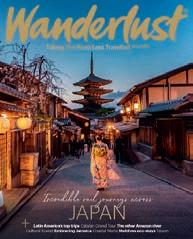
CRAGHOPPERS
Women’s orlena half-zip fleece, £75

This cuddly women’s fleece from Craghoppers has come just at the right time for cold winter days, whether at home or away. Made from part-recycled boucle fleece, polyester lining and zip tapes, it’s cosy and stylish, has practical zipped pockets and a lifetime guarantee. Available in three tempting colours. craghoppers.com

POCKETALK






Pocketalk Plus, £299

We were already fans of the Pocketalk, a portable, AI-powered instant voice-translator that can translate 82 languages at the touch of a button. Its new Plus device has a 40% larger display and a longer battery life (192 hours). It also comes with a complimentary two-year mobile data plan that can be used in 130 countries and regions. uk.pocketalk.com

6 travel gift ideas for Christmas

From phones that take pro-level pics to cuddly tops, here are six ideas for the travel addict in your life

62 December 2022/January 2023 TRAVEL GEAR

UNDISCOVERED ADVENTURES ON THE
EYRE PENINSULA
Where the Ocean meets the Outback in South Australia
The Eyre Peninsula is South Australia in microcosm –beloved for its succulent seafood, 1,930km of untouched coastline, and vast, wildlife-rich Outback. Best of all, you'll have this lesser-known Australian gem largely to yourself. Hop on a one-stop flight from the UK to state capital Adelaide, before driving or flying onto the Peninsula in as little as 45 minutes to start your adventure.
AUSTRALIA’S
SEAFOOD FRONTIER
With freshly shucked oysters, prawns, tuna and mussels on the menu, there’s no risk of going hungry in this seafood lover’s paradise. You’ll feel like you’ve earned your food here too, thanks
to myriad catch and cook-your-own experiences across Port Lincoln. Waders at the ready on a tour of Coffin Bay with Oyster HQ, where you can sample oysters straight from the ocean. If it’s a mix of wildlife encounters, wine and seafood you’re after, Australian Coastal Safaris are your go-to, from four-wheel

Dive right in (top to bottom) Swim with sea lions in the waters surrounding the Eyre Peninsula; feast on freshly shucked oysters

driving through sand-dunes and rugged terrain to birdwatching and wildlife experiences and wellness tours. Self-drive is a big deal Down Under, so what better than to search for seafood than under your own steam? The Seafood Frontier road trip takes you from Adelaide to the Eyre Peninsula's sparkling coastline.
MAKE A SPLASH
Clean waters abound on the Eyre Peninsula – that’s what makes it a thriving location for seafood and marine life. Come face to face with sea lions as they somersault and play in front of your eyes, swim with pods of wild dolphins, or for the ultimate adventure, go cage sharkdiving to see great whites heart-racingly close. Back on dry land, explore Greenly
64 December 2022/January 2023
Beach’s rock pools and the towering sand dunes en route to Gunyah Beach.
Heading out on the water is one of the region’s highlights, particularly from June to September, when you might spot migrating southern right whales. Divers and snorkellers, meanwhile, can seek seahorses and octopus year-round, or giant cuttlefish between May and July.
For coastal dwellers, the beaches here are a sight to behold, from the flamingohued sands of Lake MacDonnell to calm Perlubie, isolated Locks Well and crystalclear Memory Cove. And, for exploring beyond the silica, Talia boasts hidden, icy rock pools and a confection of granite and limestone grottos, the most iconic being the dramatic Woolshed Cave.
GO WILD
Eyre is as wild as it gets. The Peninsula boasts all that quintessential Aussie wildlife, from wombats to emus to kangaroos. Speaking of ‘roos, this is one of the only places in the country where you can seek out three different
species coexisting – namely red, western gray and the euro, or common “wallaroo”. Look out for the yellowfooted rock wallaby, an endangered species that can be found amid the rocky outcrops of the Gawler Ranges. Koalas can be spotted at eye level here, thanks to the comparatively short manna gum (eucalyptus) trees at Mikkira Station, where a colony of these iconic marsupials like to hang out.
The Peninsula is also home to over 270 bird species, including the rare broad-billed sandpiper, which eagleeyed travellers can spot in Nullarbor’s Streaky Bay – with a bit of patience of course. For maximum exposure to the region’s plentiful avifauna, the research station at the Eyre Bird Observatory is well worth a visit.
INTO THE OUTBACK
Arid crimson sands against impossibly blue skies – the Eyre Peninsula’s Outback lives in the 1.5-billion-year-old Gawler Ranges. Koalas, kangaroos and wombats are found in huge numbers, while over 1,000 species of flora and fauna flourish, despite seemingly harsh conditions. Sturt’s desert pea and crimson mallee pepper the landscapes, which – when not a vibrant red – turn to crisp, craggy white. We’re talking, of course, about the Lake Gairdner salt pans, which look more Antarctica than Australia.
And then there’s the lava-sculpted Organ Pipes, ancient rock prisms formed millennia ago, not to mention
Go wild (clockwise from top left) Woolshed Cave has been carved by the waves at Talia Beach; the famous Organ Pipes of the Gawler Ranges National Park were formed some 1,500 million years ago; see koalas at Mikkira Station near Port Lincoln

innumerable sites of Aboriginal significance, offering a glimpse into the national park’s cultural identity.
With a little help from Gawler Ranges
Wilderness Safaris, it’s possible to see all this – and more – on a four-wheel drive safari. Beneath unblemished night skies with unforgettable sunrises and sets, a stay at Geoff and Irene’s tented Kangaluna Camp will get you fully immersed in the Outback, so much so that you’ll forget what life in modern ‘civilisation’ is like… much to your joy.
WHERE TO STAY
Camel Beach House Teetering on the coast, this rustic hideaway sits amid 250 aces of Talia wilderness, offering barbecues, sundecks, and blissful night skies.
Eyre.Way Yambara Go off-the-grid at this remote oasis, which gazes across Port Lincoln’s Sleaford Bay and promises wildlife-spotting and whale-watching aplenty.
Tanonga Luxury Eco-Lodges This awardwinning eco retreat, nestled within 240 acres, boasts walking trails, wildlife and history just 20 minutes from Port Lincoln.
MAKE IT HAPPEN
Fly to Adelaide with Qatar Airways, named World’s Best Airline at the 2022 Skytrax Awards. Stretch out in comfort onboard one of the youngest fleets. While you dine, sleep or watch some of the 4,000-plus entertainment options, you’re sure to enjoy the inflight experience. qatarairways.com
A 12-night holiday in Australia, including flights, 3-days car hire and 4-star hotels in Adelaide, Barossa, Port Lincoln and Sydney, costs from £4,029 per person (based on two sharing). Includes 3-night 4WD tour with a local guide, most meals and wildlife experiences. Call Trailfinders on 020 7368 1354 | trailfinders.com



PROMOTIONAL FEATURE www.wanderlustmagazine.com 65For more information, go to: southaustralia.com
Alamy; Shutterstock
Back to the forest
Tourism has had a devastating impact on Thailand’s captive elephants, but a new project in a northern Karen village suggests it might also be their saviour
 Words & photographs Mark Stratton
Words & photographs Mark Stratton
DISPATCHES

JOURNAL Thailand
Amid tangled vines and stepping-stone crossings where the cool stream lapped my feet, I paused.The sound of snapping bamboo heralded the arrival of a herd of five Asian elephants.Their wrinkled hides were sticky with red riverbank mud and they browsed heartily, tugging up trunkfuls of greenery amid the cloyingly humid jungle.Two of these animals had a particularly sad story that I’d been following online. At just a year old, baby Par-Gae-Mae lost his mother after she ingested agricultural crops that had been sprayed with pesticide; the calf was found crying beside her body. He was now being cared for by a soulmate in grief, Mo-Go-Nar, who had lost her own baby to herpes (EEHV) and had adopted him.
We followed the herd upstream to a waterfall. The young elephant slipped on a rock and blew a squeaky trumpet of dismay.Yet these captive animals are generally finding peace in the Om Koi jungles of northern Thailand; they are free, for now, from the cruelty that the country’s elephant-tourism industry metes out upon them.
There are 59 elephants at the new Evolution Om Koi Project, a collaboration between the American non-profit Gentle Giants and the Karen hilltribe people, the owners of these animals.The aim is to find a more compassionate form of elephant tourism; one that delivers income to the community so that they can avoid sending these creatures to barba rous riding camps.
Any visitor to Thailand cannot fail to notice that elephants are an enduring and omnipresent national symbol, whether taking the form of jade statuettes in Buddhist temples, embellishing the labels of beer bottles, or as batik fabric patterns sold in tourist markets. When I arrived at Chiang Mai railway station, on my way to Om Koi, I even stepped outside onto a little plaza and was surrounded by four stone elephants.
Yet, for all their veneration, Asian elephants are declining across their range – not just in Thailand – and are subject to brutal abuse in captivity in the name of tourism, and sometimes religion. In the wild, the IUCN has upgraded their threat level to critically endangered, and the numbers make for some tough reading. At the end of the 19th century, 300,000 were estimated to inhabit Thailand’s jungles. Now an estimated 1,500 to 2,000 wild elephants remain, perpetually on the run from human-wildlife conflict as the national parks become increasingly isolated refuges.
Meanwhile, some 3,800 captive elephants are subjected to physical and mental abuse at riding camps, circuses and illegal logging operations.
Thai law forbids taking them from the wild, so captive females are forcibly put to bulls to provide babies that will become the next generation to be exploited. Those little ones will undergo the enforced compliance of phajaan: removal from their mothers and being beaten and stabbed by bullhooks until their wild spirits are crushed.
When COVID-19 struck, riding camps were shut down.This might seem a good thing, yet it also precipitated a welfare crisis as elephants began starving in the camps that went bust.These animals are invariably rented to the camps by their actual owners, many of them ethnic Karen living on the border with Myanmar. It was a situation that went largely unreported until one dramatic moment.
In May 2020, the rescue of 11 riding-camp elephants by Lek Chailert, a world-renowned elephant conservationist, saw their plight suddenly become news. Like a modern-day Hannibal, Chailert led these elephants on foot for three days, taking them back to the jungle of their Karen owners in the Mae Chaem region. In the wake of this, the non-profit Gentle Giants was formed to fundraise elephant upkeep during the pandemic.
“I became aware of the terrible situation that elephants and their mahouts were going through when Thailand’s tourism industry came to a halt,” said Diana Muñoz, one of the co-founders of Gentle Giants. During the peak of the COVID-19 pandemic, the organisation was supporting several hundred elephants across Thailand in order to keep them in food. But it was clear to Muñoz that once the pandemic ended and tourism restarted, the elephants would return to the same cycle of abuse. For the economically marginalised hill-tribe communities, renting them to camps and for logging remained a tempting source of income.
“Lek told us of 35 elephants in Om Koi that were going to be taken to logging because their Karen owners didn’t have any choice,” said Muñoz. So, to keep the community’s elephants in their native jungle, Gentle Giants began supporting the villagers financially. “This was an eye-opener for the people of Om Koi; they were able to see they could do things in a different way.”
Soon, the elephants they were supporting increased to 55 (and now 59 due to impregnation by the males who live wild around Om Koi). A more sustainable way of offering support was needed, so rather than just compensating the Karen to not send their animals into logging or riding camps (which is costing Gentle Giants US$35,000 [£28,950] per month), an idea was hatched to create a self-sustaining income whereby eco-volunteers would pay to stay in ⊲
NEED TO KNOW
A six-day adventure in Om Koi costs US$700 (£627) per person, including transportation from your hotel in Chiang Mai, all meals, guides, activities and homestay accommodation. Trips run with a minimum of four people and are currently booked through the non-profit Gentle Giants; visit thegentlegiants.org for more information.
Getting there
There are no direct flights from the UK to Chiang Mai, though daily direct services with Thai Airways (thaiairways.com) fly from London Heathrow. Flights start at around £567 one way and take around 11.5 hours. From Bangkok you can find numerous flight connections to Chiang Mai with local airlines, including Thai Air Asia (airasia.com) and Bangkok Airways (bangkokair.com); these typically take around an hour and cost from £44. A slower, more interesting way to get there is to take the 12-hour sleeper train from Bangkok’s Hua Lamphung Station (Krungthep Aphiwat Central Station is due to open and replace this soon); this leaves at 7.35pm and arrives in Chiang Mai at 8.40am the following day; one-way sleeper tickets start from around £12.
Visa information
Visas are not required for UK nationals for stays of up to 30 days. At the time of writing, visitors still needed to demonstrate proof of COVID-19 vaccination or a negative COVID-19 test taken within 72 hours of your flight.
“COVID-19 created a welfare crisis as elephants began starving in the riding camps that went bust”
68 December 2022/January 2023 DISPATCHES


JOURNAL Thailand www.wanderlustmagazine.com 69
Family business (top to bottom) More than half of Thailand’s estimated 5,000-plus elephants live in captivity, with many being forced to work at riding camps where they are chained, work for long hours and are routinely brutalised – the Evolution Om Koi Project has helped subsidise 59 elephants owned by Karen villagers in Om Koi through donations and eco-tourism so that these animals don’t have to be sent away and can start relearning their wild instincts, browsing in the forest and bathing as a family; baby William is a young star among the Om Koi elephants; (previous spread) local mahouts now lure their animals with bananas rather than threats
Om Koi, to be immersed in local culture and visit the elephants in their native habitat. Part of the agreement with the village was that the mahouts refrain from controlling their animals by using bullhooks or chaining them.To stop the elephants crop-raiding at night, chain-free shelters are being funded, with the first one now up and running after US$25,000 (£20,675) was raised to build it.
“The local community is eager to be involved, as they see a way to keep their sons and husbands at home (rather than travelling to the camps as mahouts),” said Muñoz. She hopes this can be a template for a new, more compassionate and cruelty-free elephant tourism across Thailand.Yet it needs a regular stream of visitors to make it work. In order see it in action for myself, I became one of the first eco-volunteers to visit the project.
Setting off from Chiang Mai with two Karen-speaking guides trained by Lek Chailert, it was a seven-hour drive to the village in Om Koi, climbing into the lushly tropical hills near Myanmar, some of Thailand’s wildest landscape.



An ochre-coloured soil track took us to a hillside village,Tung Ton Ngiaw, surrounded by rice-terraces and jungle. Locals here speak a Sino-Tibetan language and live in wooden, tin-rooved houses that are raised up on stilts. Many of the Karen women and elder men wear home-woven, red embroidered fabrics, which are also on sale – another revenue stream for the villagers.
The volunteer accommodation was basic – a mattress on the floor and cold-water showers – yet I felt instantly welcomed into the community and quickly discovered that while the villagers depend on earning money from their elephants, they do not like the riding camps, nor having to spend so long away.
One mahout, called Chuan, recalled taking his elephant to a riding camp near Chiang Mai: “I was there for three years. I was stuck. It was part of the contract that I had to sign,” he complained. “My elephant, Moh-Par-Na, gave rides all day, mainly to Chinese tourists. She was chained all night. I felt so bad for her, but how else can I feed my family?We have no choice. I am so happy to be back home, and the elephants deserve rest. Already they’re getting healthier, eating more and feeding from the jungle – and we no longer have to be so hard on them.”
He said that he was prepared to earn less money from ecotourism, rather than accept the higher prices that the camps will pay for renting his elephant, so long as it meant he could stay at home.
Each day, I undertook a community activity and at least one elephant trek. Besides a welcoming ceremony featuring the village’s shaman, where I was blessed for a long life, I also took part in rice

planting one morning. It was hard work spending my time immersed in squelchy mud under the watchful gaze of the locals. Perhaps they were wondering if my slow-paced amateurism might result in crop failure? On another morning I attended their elementary school to give an English lesson to a classroom of polite local children. I asked them to name the top ten things that Thailand is known for, and smiled when ‘weed’ came in at number three and a pop princess managed to usurp the king.
Otherwise, I enjoyed unrushed viewings of the elephants in their native habitat.The experience was completely magical. I would even argue that this is the best elephant watching anywhere in Asia because the animals are comfortable and rediscovering their wild instincts for browsing.They had also experienced captivity, so it meant that they were at peace with having humans around.
I could see how relaxed the mahouts were. Just watching over their animals, to make sure they remained in the jungle and not too close to the community’s crops, is a far easier life than dragging selfie-loving tourists around all day. I saw no bullhook use; instead, the mahouts enticed their elephants to a waterhole with a treat of bananas, which the animals eyed avariciously. It was adorable to watch the two little ones, Suk Dee and William, manically splashing around, hosing water like dainty fountains, while their mothers larruped mud all over themselves with a swish of their mighty trunks.
On another day a recent wild-born baby called Moe Sae got thoroughly overexcited by our presence and chased us around before slumping to the ground exhausted under Mother’s protective gaze.We were urged to avoid touching this infant as she needed to develop her wild instincts, although it was hard to avoid this bouldering little tyro. I reflected on how, if this initiative works, this fivemonth-old will never endure phajaan; she will exist in a semi-wild state, untrained and unchained.
But can it succeed? Once Chinese tourists (who account for the lion’s share of riding activities) start returning en masse with the easing of COVID-19 travel restrictions, will the inducements from the camps to the elephants’ owners prove an overwhelming financial temptation?
Diana Muñoz hopes not. “True sanctuary is for elephants not to have to entertain humans in any way,” she said. “We truly believe this can break the mould of elephant tourism if visitors are shown how incredibly beautiful it is to see these gentle giants express themselves and interact without fear in this magical, natural habitat.”
“A wild-born baby called Moe Sae got thoroughly overexcited by our presence and chased us around”
70 December 2022/January 2023 DISPATCHES
SIX ETHICAL ELEPHANT ADVENTURES
Elephant Nature Park
The inspirational Lek Chailert (herself a Karen woman) has spent years supporting elephants across Thailand. Her excellent sanctuary currently hosts 118 pachyderms, many of them elderly retirees from logging or tourism. It allows day visits as well as weeklong eco-volunteering stays. elephantnaturepark.org
Pattaya Elephant Sanctuary
This is a sweet little sanctuary with just three elephants. Half-day visits include a jungle walk with the animals and a chance to watch them bathe. pattayaelephantsanctuary.org
Mahouts Elephant Foundation
This is more than just a sanctuary. Set in 36,000 hectares of largely native forest, this foundation’s LIFE Project is using tourism to create economic opportunities for the Karen people and to help protect their resident elephants. The foundation also runs a volunteer scheme. mahouts.org
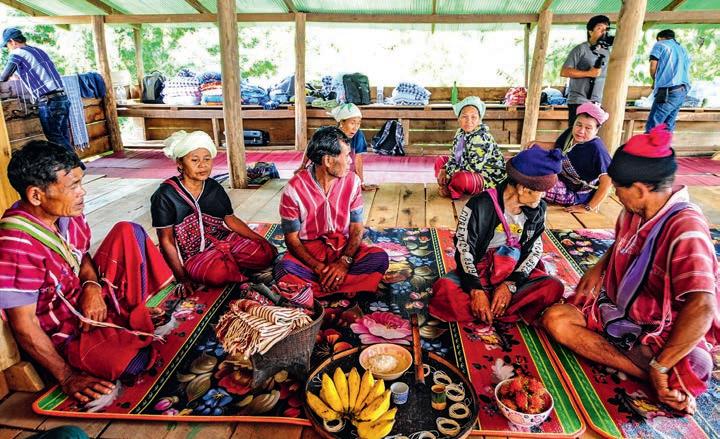
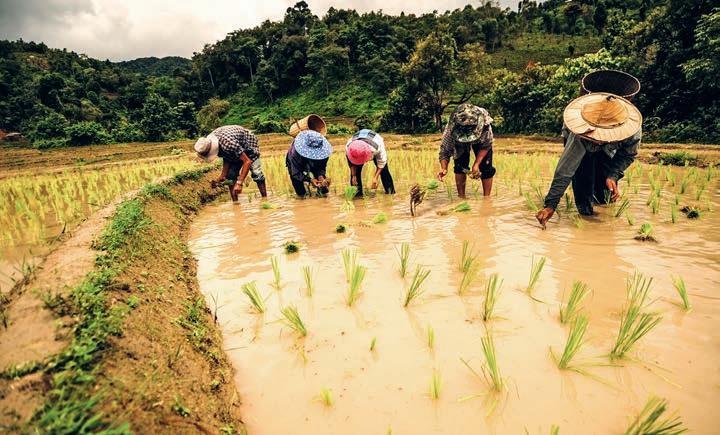
Samui Elephant Haven
Set on the popular tourist island of Koh Samui, this small sanctuary has 13 elephants that have been rescued from a lifetime of abuse. There are also two playful babies, Luna and Haven, which have become budding stars of the internet. samuielephanthaven.org
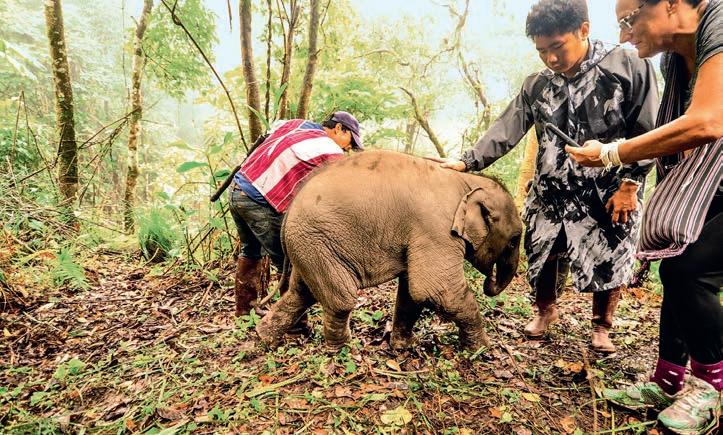
Wildlife Friends Foundation Thailand
This large facility hosts bears and tigers that have been rescued from zoos and circuses, plus over 20 elephants. You can volunteer here or come for a half-day visit (9am–noon). No touching of the elephants is allowed but guests may feed those who want to be fed with fruit.
wfft.org
Phuket Elephant Sanctuary
One of Thailand’s original ethical elephant sanctuaries lies on the tourist-heavy island of Phuket in the far south of the country. Eleven rescued elephants live a sedate life here; visitors on half-day trips can get a unique view of the herd from a 600m-long aerial canopy walkway. phuketelephantsanctuary.org
Community support (clockwise from far left, bottom) Stays in the Om Koi Karen village don’t just benefit elephants – volunteers spend time teaching children English in the elementary school; the village shaman blesses each visitor; traditional Karen clothing; the lives of the mahouts have been vastly improved by not having to go to the camps – instead they now monitor their elephants to make sure that they stay away from the crops of the village; volunteers will have the opportunity to spend a morning in the rice fields; the scheme lets visitors submerge themselves in the everyday life of a Karen village; baby Moe was so excited that he chased the volunteers around
JOURNAL Thailand www.wanderlustmagazine.com 71
REASONS TO VISIT A DIVERSE COUNTRY TAKE OFF TO QATAR


ith the arrival of this year’s FIFA World Cup, the spotlight is already shining brightly on Qatar. But away from the football stadiums, Qatar Airways’ 77 direct flights a week from the UK make it easy to unearth showpieces beyond the pitch. Cultural heritage, underwater encounters, thrilling adventures and wild sightings await every kind of visitor…
FOR THE CULTURE
Thanks to its thirst for world-class art and heritage treasures, Qatar easily backs up its billing as the ‘cultural hub of the Middle East’. Capital Doha lays claim to more leading museums and art galleries than you can count, with the Museum of Islamic Art sitting at the top of its cultural tree. Here, you can walk through 14 centuries in just a few hours, with three continents’ worth of textiles, paintings, ceramics and glassworks to pore over. Both the National Museum and the Msheireb Museums celebrate Qatar’s rich heritage, from the history of the Bedouin right up to how the discovery of oil transformed the nation. Truth be told, all of Doha is much like a museum and gallery rolled into one, where past and future is showcased in its eclectic architecture –only without the attention and crowds that neighbour Dubai endures.
WThere are glinting skyscrapers at Qatar’s core, but an ancient heritage is also alive amid the humming alleys of Souq Waqif and Katara Cultural Village.
The latter was designed to feel like an ancient fereej (neighbourhood) complete with twisting alleys, mosques, courtyards and an amphitheatre. The old and new is also visible away from the capital, with public art installations such as Richard Serra’s epic ‘East-West/West-East’ sharing the Qatari coastline with the crumbling ruins of Al Zubarah Fort – Qatar’s only UNESCO World Heritage site.
FOR THE NATURE
With much of Qatar carpeted in desert, you’d be forgiven for thinking that the country wasn’t well-stocked with wildlife. But you’d be wrong, and beyond the falconry shows that have existed here for centuries, it’s not hard to encounter animals of almost every kind – you just have to know where to look.
Wildlife appears here where you least expect it, with 4WD tours through the desert often stumbling upon the protected nature reserve of Khor Al Adaid. This oasis, also known as the ‘Inland Sea’, is a popular nesting spot for ospreys and terns, while you’ll also see Arabian oryx (Qatar’s national animal) and gazelles skipping the surrounding pristine dunes. Qatar’s fringes have a bounty of wildlife experiences, and watching hawskbill turtle hatchlings scurrying along Fuwairit
Desert designs (this page; bottom, left–right) The National Museum of Qatar was designed by architect Jean Nouvel and is inspired by the desert rose that is found in Qatar’s parched areas; visit the Brouq Nature Reserve to see the ‘East-West/ West-East’ art installation, which consists of four 14m tall steel plates
beach each June and July is one of the country’s most memorable sightings.
Elsewhere, the country’s vast mangrove systems are a delight to paddle, either in a kayak or on a stand-up paddleboard. These often afford glimpses of Qatar’s rich birdlife, from the flamingos and herons of Al Thakira to the plovers, terns and doves of Purple Island. Further off the coast, guided cruises into the Persian Gulf offer the chance to spy whale sharks and rare dugongs, with the country boasting one of the world’s largest concentrations of these incredible species.
FOR THE ADVENTURE
Beyond sleek, hyper-modern Doha, Qatar is a land bursting with adrenalinfuelled adventures. As a general rule of thumb, venture out of Doha in any direction and you’ll encounter endless ripples of golden whipped

72 December 2022/January 2023
Aflah P
Hussain; Qatar Airways
dunes. These flaxen-hued landscapes were once explored by the Bedouin people on the backs of camels; these days, sheering down dunes in a SUV has become the thrill-seeking way to explore the desert. It’s a whiteknuckle ride that your driver will relish, performing stomach-flipping moves and careening across the sand.
Adventure awaits (this page; clockwise from top right) The Doha Corniche is a 7km boulevard with restaurants, parks and cultural attractions that include the Museum of Islamic Art; Qatar’s mangrove systems provide a home to a wealth of bird species; enjoy a camel ride through the desert; kitesurfing is a popular water sport in Qatar
While the desert may attract the attention of most adventurers, the coast offers similar thrills. Qataris love water sports, and there are all manner of activities to suit those looking for every speed of adventure. Embark on a gentle paddle through the mangrove waterways of Al Thakira on a stand-up paddleboard or snorkel off the beaches of Bu Samra for sightings of dolphins, crabs and iridescent coral. Even Doha offers you a chance to get active offshore, from kayaking around the man-made Pearl island at dusk to sampling introductory dives or gliding down to discover coral-encrusted shipwrecks such as the Pericles

For the more intrepid-minded, adventures can be sought in even the most remote corners of Qatar, such as hiking among the unique rock formations of Ras Abrouq or scrambling 40m down into the Dahl Al Misfir cave.
MAKE IT HAPPEN
With regular direct flights from London (Gatwick and Heathrow), Manchester and Edinburgh to Doha, Qatar Airways makes it easy to reach Qatar’s abundant treasures in around seven hours. You couldn’t be in better hands, either, with Qatar Airways winning Airline of the Year at the 2022 World Airline Awards, an accolade it has scooped for the last three years in a row and seven times in the last 11 years – an impressive haul.

If you want to fly to Qatar in style, it also regularly wins plaudits for its luxurious business-class offering. A flight with Qatar Airways sets the tone for the incredible hospitality that awaits you on the ground in Qatar.


PROMOTIONAL FEATURE www.wanderlustmagazine.com 73For more information, go to: qatarairways.com
OUT SLOVENIA’S SUSTAINABLE SIDE
embracing the country’s Green Scheme of Slovenian Tourism as well as many other environmental projects. You’ll be instantly immersed in nature, whether strolling around the postcard-pretty lakes of Bled or Bohinj, breathing in the fresh, scented air of the country’s many bountiful forests, or soaring high into the upper reaches of the 2,864m Mount Triglav.

In a world where many of us crave sustainable, life-affirming escapes, Slovenia shines like a beacon between the Alps and the Adriatic. Capital Ljubljana is a former European Green Capital, and Slovenia was the world’s first country to be certified a ‘Green Destination’ at the Global Green Destinations Day in 2016. On top of that, the third most forested country in Europe is also awash with vaulting mountains, surging valleys and verdant plains. It’s lush beyond belief, and Slovenia takes its environmental responsibilities seriously. Here’s how to have your own green adventure.
IMMERSE YOURSELF IN NATURE
You don’t need to go far to dive into nature in Slovenia, a country where the preservation of the natural world has long been enshrined in the national psyche. It’s gloriously easy to get outside and enjoy the great outdoors in a responsible way, with many businesses
DID YOU KNOW?
At the 2020 Sustainable Top 100 Destination Awards, Slovenia won the ‘Best of Europe 2020’ award for its sustainable model of tourism.
What better way to plunge into nature than by kayaking your way across glacial lakes or out into the wetlands on the edge of Ljubljana. And for something wilder, there’s always whitewater rafting on the River Soča.
If you want to cover more distance, swap paddles for pedals on a road or mountain bike. Many professional cyclists train in Slovenia because of the steep ascents in the alpine mountains to the north – a challenge to any rider. Alternatively, just join locals pedalling around the country’s green towns and cities, which are well-geared for those after a gentle afternoon’s escape.
74 December 2022/January 2023
Going green is easy here… SEEK
And lastly, for a bird’s eye view, paragliding opens up the cinematic beauty of Slovenia, letting you see just how green it is from the air.
EAT FRESH
The current global push towards more sustainable, fresher local produce is nothing new in Slovenia, where produce from gardens, local markets and smallscale suppliers flourishes ahead of the
supermarket hegemony. Locavores can find delights everywhere, from gostilnas (inns) and budget-conscious restaurants, through to tourist farms and Michelinstarred gastronomic temples. Variety is the key to Slovenian gastronomy, with influences from surrounding countries infusing the nation’s 24 gastronomic regions and more than 400 traditional dishes and drinks.
In chef Ana Roš, Slovenia boasts one of the world’s finest talents, and her Hiša Franko restaurant in the Soča Valley is deserving of its two Michelin stars. Nor is she alone – the country now has over 50 restaurants recognised by Michelin.

A quintet of eateries have picked up a Michelin Green Star for their “culinary excellence with outstanding eco-friendly commitments”. The diversity of options to eat fresh and sustainably in Slovenia is striking: look out for the Slovenia Green Cuisine label which recognises eco-friendly restaurants. Or escape to the refined world of Michelin-starred dining. Atelje, Dam, Gostilna pri Lojzetu, Hiša Denk, Gostišče Grič were all awarded with one star this year. The newest members of the Michelin family are Hiša Linhart, COB, Milka, and Strelec.
Slovenia’s wines also excel, thanks to the country’s three main growing regions (Podravska, Primorska and Posavska). Some fifty grape varieties thrive there,
DID YOU KNOW?
Green delights (clockwise from far left) With 91% of its land covered by forest, Kočevsko is the most denselyforested region in Slovenia; Ptuj is the oldest town in Slovenia; eat fine food at Michelinawarded Hiša Denk
DID YOU KNOW?
Slovenia is the first country in the world to hold the official title of ‘Green Destination’.


and its wines rival the best of Burgundy and Bordeaux. There are even some fun surprises, such as the mighty Teran wine from the Slovenian Karst region and the low-alcohol Cviček from Lower Carniola.
SEEK OUT PRESERVED TOWNS
As well as protecting the natural world, Slovenia has preserved its past. There is a rich web of history, architecture and culture to discover, with a number of UNESCO World Heritage sites among a slew of days out. This is, after all, a country where evidence of settlement by early humankind dates back some 50,000 years.
Slovenia’s cities have more modern treasures on show. Woven across the streets of capital Ljubljana is a greatest hits of early-20th-century architecture, courtesy of the work of architect Jože Plečnik. Second largest city Maribor can also call on a swathe of impressive buildings wrapping its section of the River Drava, and it even has a 450-year-old grapevine – the world’s oldest. Kranj oozes drama as the town where national poet France Prešeren spent his final years; his romantic verse echoes across the cobbled streets. And Celje has a landmark castle and an old town that offers a thrilling glimpse into its past.
Down on the coast, the city of Koper keeps alive the Venetian age in its architecture, as does nearby Piran, whose sister campanile gazes over the Adriatic towards St Mark’s. Idrija has lace and mining traditions, Ptuj celebrates the remarkable Kurentovanje festival, and postcard-pretty Radovljica, Škofja Loka and Kamnik all bewitch with historic centres lovingly brought back to life.
Wherever you are in Slovenia, responsible travel couldn’t be easier.
More than 200 destinations, operators, agencies, parks and landmarks operate in Slovenia in accordance with the principles and criteria of the Green Scheme of Slovenian Tourism certification.

PROMOTIONAL FEATURE www.wanderlustmagazine.com 75For more information, go to: slovenia.info
Alamy; Shutterstock
Tales of the
sea
The remote islands of Australia’s Torres Strait lie in one of the most hazardous stretches of water in the world, but those who make it there will find stories and wildlife well worth the effort
 Words Lizzie Pook
Words Lizzie Pook


ake a look. Go on. What do you think that island is made of?” asked my guide Dirk Laifoo, handing me a pair of binoculars and gesturing northward. I took them and squinted at a jagged mass of dark brown bobbing on the open sea. My mouth fell open.
“It’s… metal,” I said slowly, then peered closer. “Are they baskets or something?” This small island, scorched by the sun and cast adrift in one of the most remote stretches of water in northern Australia, looked like something left behind from a Mad Max film.
“They’re the baskets that people used to hold pearl shells in,” Dirk nodded. “The workers at the pearl farm piled them up here for decades, and eventually they became an island of their own. Ecologically, it’s quite healthy now.”
I looked through the binoculars again and saw that bright corals clung to the darkest baskets at the bottom. Moving my eyes upwards, I spied tiny terns with fierce beaks perched atop the pile. It would not be the last occasion during my time in theTorres Strait Islands that my jaw was left hanging.
This clutch of some 274 tropical isles languishes between the northern tip of Australia’s CapeYork and Papua New Guinea, and just 17 of them are inhabited.Across these you’ll find distinct cultures, languages and histories, yet the area is little explored by tourists, who only tend to venture as far north as Queensland’s glitzy Great Barrier Reef or the lush Daintree rainforest.The Strait is a more rugged prospect. It is a place where seawater pumps through the veins of islanders and the practices of navigating by the stars, reading the tides or fishing for trochus shells and bêche-de-mer (sea cucumber) still thrive.
Many locals have links to the sea. Dirk’s great grandfather came over from China to set up in Queensland’s Palmer River Goldfields, but he ended up buying a small fleet of pearling luggers to try his hand at diving for the Strait’s coveted Pinctada maxima – the largest pearl oyster in the world.


In the late-19th and early-20th centuries, huge quantities of mother-of-pearl shell were exported from northern Australia. It was a lucrative but perilous industry. Men walked the seabeds in heavy copper helmets, facing off with crocodiles, sharks and sea snakes.When the shallows were picked clean, pearlers were forced to dive off the continental shelf, a legendary place known as the ‘Darnley Deep’. It is an area so cavernous that many succumbed to the bends just trying to resurface, or simply drowned.
At the cemetery onThursday Island (Waiben), the biggest hub on theTorres Strait, I came across a memorial dedicated to over 700 divers who died while fishing for pearls in the region.The archipelago is riddled with these hidden histories, little known to outsiders.As I explored, I began to find myself as captivated by these as the islands’ mangroves and wildlife.
CULTURE CAPITAL
The Strait’s main township sprawls across Thursday Island (TI), which is home to some 3,500 people. Many are government employees.The archipelago’s position – just a dinghy ride from Papua New Guinea – has long had strategic importance: firstly to the trade ships of the 1800s, and now for Australian defence and biosecurity. But it was clear from the moment I arrived that this was more than just an administrative hub. ⊲
Water worlds (clockwise from left) Children splash in the sea of low-lying Saibai, one of many islands in the Torres Strait at risk from rising sea levels; the European lust for pearls saw divers scour the seabed in copper diving helmets, a profession that was fraught with danger; you can explore the island’s history at the Torres Strait Heritage Museum; (previous spread) gaze out across the Strait from the ‘Tip’ on Cape York, the northernmost point of the Australian mainland
“T
Previous spread: Tourism and Events Queensland; this spread: Alamy; Lizzie Pook; Tourism and Events Queensland
TORRES STRAIT, AUSTRALIA www.wanderlustmagazine.com 79
From the wharf a sliver of beach on the mainland was still visible across the Strait. An old guy in a straw hat and chinos was taking pictures of seagulls while a small child hopped about in the shallows waving a snorkel next to a yellow sign that read: ‘Warning, Achtung, Crocodiles InhabitThis Area’. It was hot and humid.The slow putter of engines purred in the air and a man in a red tin boat leant over his hull to tug on a single fishing line draped in the water.The message was loud and clear: life here is slow; there is no need to rush.
Further into town, a few minutes’ walk from the wharf, the island remained green and tropical. Hairy coconuts speckled the middle of an empty road and red dragonflies, like flying poppies, motored through the air outside the small minimarket, their presence signalling the shift from the wet season to the dry.
The sun was beating down hard, yet the island’s 10km looping trail proved irresistible. I made it far enough around to spy witchy mangrove forests and black flying foxes roosting in the shadowy treetops overhead before the heat got too intense.The laid-back island atmos phere was clearly contagious and I turned back towards town. Besides, something else had caught my eye instead.
I made my way to Australia’s northernmost pub, the slightly batteredTorres Hotel.This is one of the most isolated places on the planet to have a pint, but the locals I spoke to had other ideas.
“It’s too built up,” they agreed, saying that people from the outlying islands considered a trip toTI to be “going into town”.
Busy or not, the islands are a rich meeting point for languages, cultures and opinions.This is where two First Nations communities – Aboriginal andTorres Strait Islander

– mingle and people sing loudly and proudly here about their heritage. As I strolled around I saw the names of ancestral villages written on pastel-painted front doors. Statues dedicated to ancestors were lovingly presented in front gardens and garlanded with flowers and gleaming pearl shells.
The fusion of cultures was most audible in the collision of Creole and English that drifted from busy street-side tables. Even the community notices, pinned here and there, revealed Japanese art galleries, Christian bookshops and community-centre events focused on healthcare forTorres Strait Islanders.Yet, for all the islands feel like their own world, they are far from cut off.
When I visited, Australia’s general election was in full swing and many locals wore T-shirts bearing political slogans or carted billboards onto rickety, sun-bleached ferries. It was also the 30th anniversary of the landmark ‘Mabo decision’, when a local Meriam man from Murray (Mer) island, Eddie Koiki Mabo, successfully fought at the High Court for Aboriginal and Torres Strait Islander land rights to be acknowledged. He is something of a hero in the Strait, and flags and posters everywhere recalled the moment with pride.
STAYING AFLOAT
One constituency that doesn’t care much for politics are the crocodiles that shelter in the island’s creeks, their armoured tails stretched idly across the sun-baked mud flats.The same goes for the deadly box and irukandji jellyfish that are known to hang still beneath the surface of the seas. As Dirk and I made our boat trip around the islands, I kept my eyes
“The fusion of cultures was most audible in the collision of Creole and English that drifted from busy street-side tables“
⊲
80 December 2022/January 2023
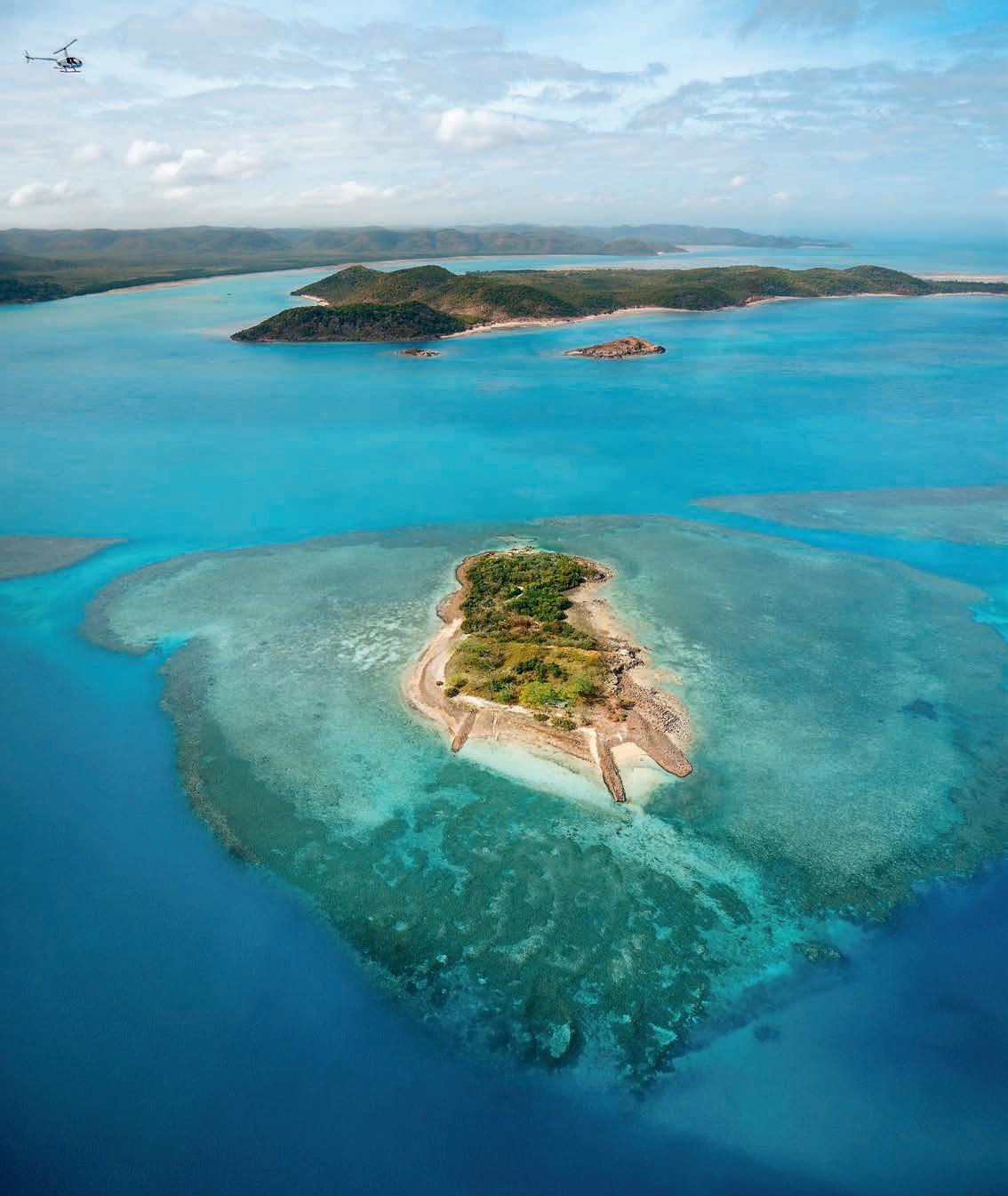
Alamy; Tourism and Events Queensland A
little perspective (left page) Thursday Island (known locally as Waiben) acquired its English name in 1848 when a British sea captain lazily christened a cluster of three islands Wednesday, Thursday and Friday; (right page) the 3.5 sq km Thursday Island is a busy hub for the archipelago and has a population of nearly 3,500, which is dense when measured against the neighbouring Prince of Wales Island (the largest land mass in the Strait, nearly 60 times bigger than Thursday), which has just 100 people. Both are surrounded by tiny islets, such as Ghibber Rock (pictured
),
and endless sandbars, making passage through the Strait historically treacherous
TORRES STRAIT, AUSTRALIA www.wanderlustmagazine.com 81
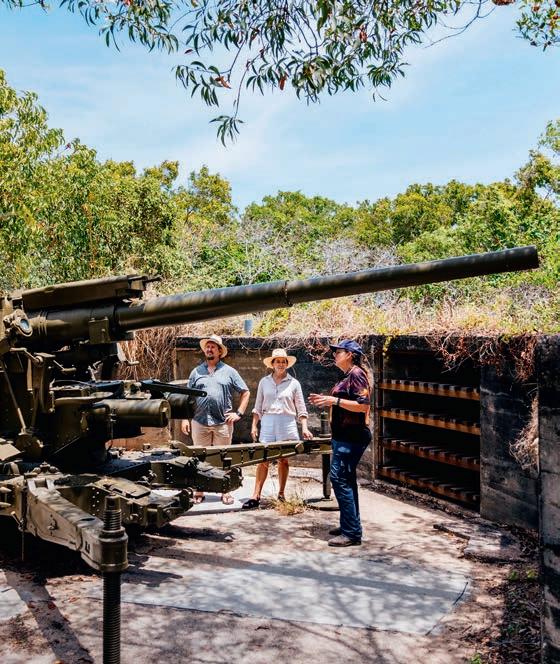
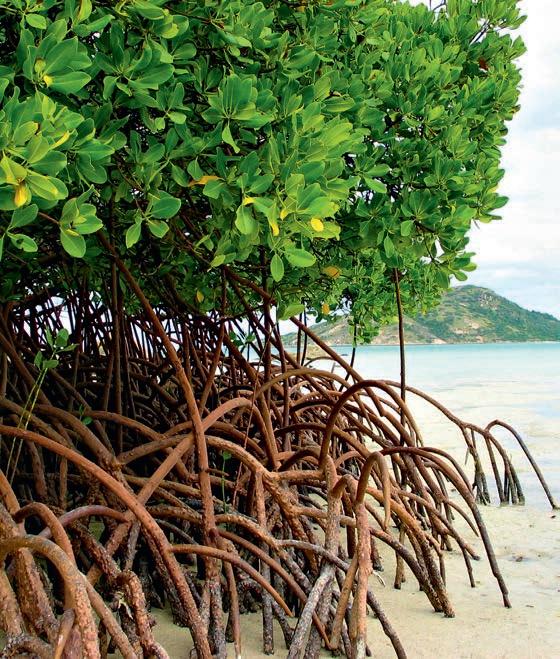
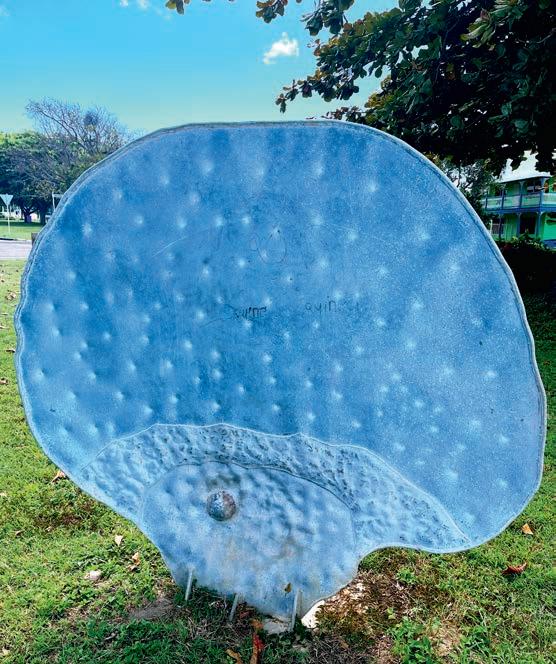
 Lizzie Pook; Shutterstock; Tourism and Events Queensland
Fruits of the sea (clockwise from top left) The Torres Strait islands are home to large areas of mangrove where you can spot wildlife ranging from gentle dugongs to lurking crocs; many islanders have links to the sea, with plenty who have ancestors that came over to work in the thriving pearling trade; the gun emplacement at Green Hill Fort Museum was built in the late 1800s as part of Australia’s defences against possible Russian invasion, and to protect its shipping lanes; tours of Horn Island reveal guns, underground rooms and slit trenches left over from the Second World War; a couple stroll down the floating jetty at Roko Island
Lizzie Pook; Shutterstock; Tourism and Events Queensland
Fruits of the sea (clockwise from top left) The Torres Strait islands are home to large areas of mangrove where you can spot wildlife ranging from gentle dugongs to lurking crocs; many islanders have links to the sea, with plenty who have ancestors that came over to work in the thriving pearling trade; the gun emplacement at Green Hill Fort Museum was built in the late 1800s as part of Australia’s defences against possible Russian invasion, and to protect its shipping lanes; tours of Horn Island reveal guns, underground rooms and slit trenches left over from the Second World War; a couple stroll down the floating jetty at Roko Island
82 December 2022/January 2023

TORRES STRAIT, AUSTRALIA www.wanderlustmagazine.com 83
From wilderness to war (clockwise from top) The view from Thursday Island gazes out across the Torres Strait, an area that first attracted European interest in 1864 –more than 70 years after the first British settlers arrived in Australia – because it was seen as a way of safeguarding a stretch of water that was becoming an increasingly busy trade route between the Indian and the Pacific oceans; crocodiles measuring up to five metres in length stalk the waters of Thursday Island; cuter denizens of the strait take the form of its many turtles; a visitor pores over the wreckage of a Second World War aircraft on Horn Island, a relic of a time when the Torres Strait was a base for the Allied forces. Horn, in particular, suffered greatly, enduring no less than eight Japanese air raids – in Australia, only the port city of Darwin saw more attacks
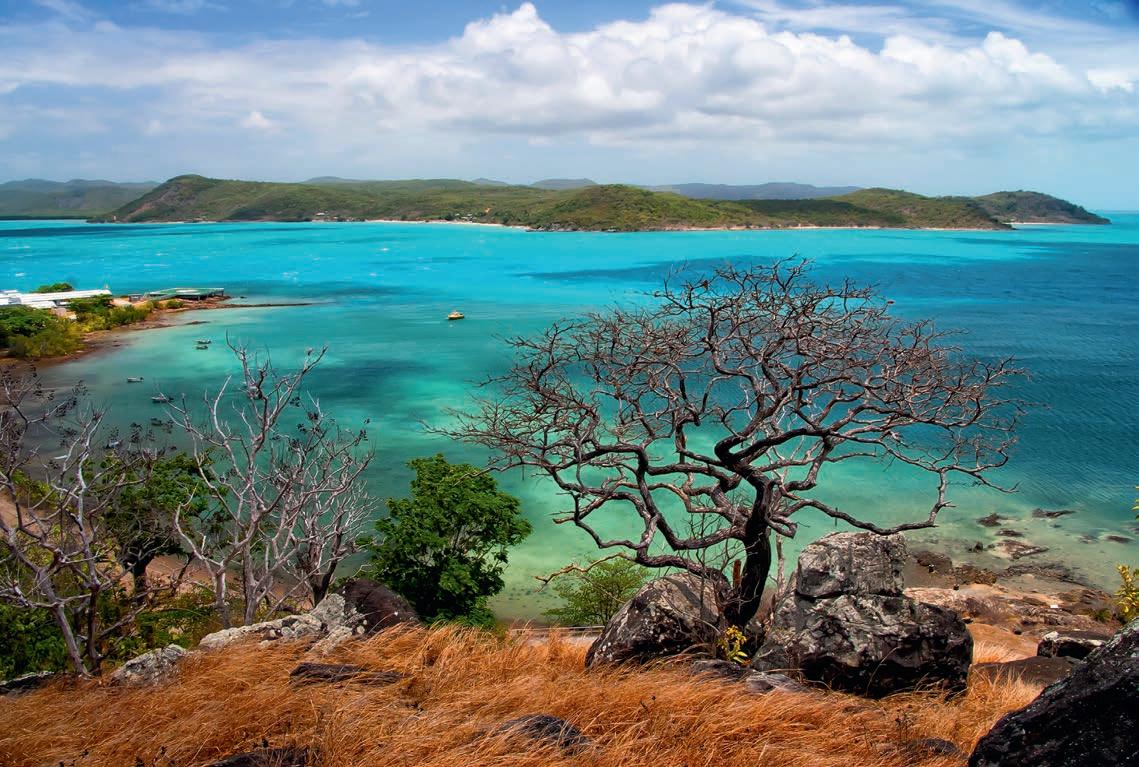
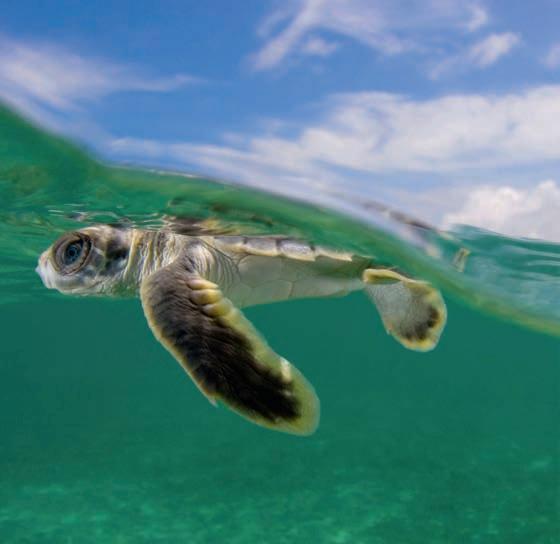
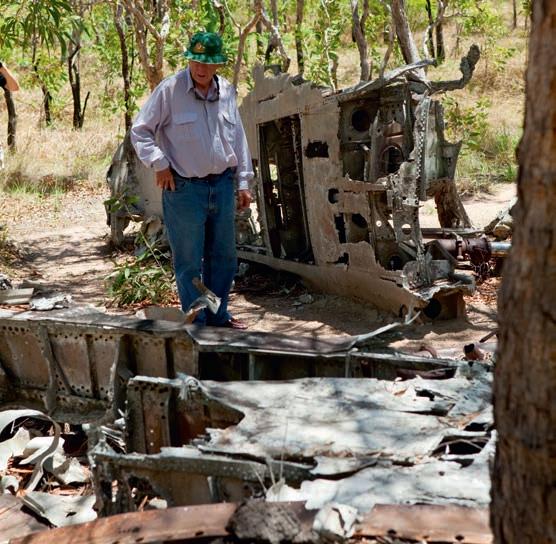
Alamy; Shutterstock
84 December 2022/January 2023
peeled warily for both. Along the way, turtles upped their periscope heads to observe us and huge jabiru storks moved on spindly legs through the shallows as showers of fish leapt from the water in silvery arches of tossed glitter.
Dirk told me how, long ago, his father had brought horses over from the Australian mainland, swimming them through shark-infested waters: first to Friday Island, then to the larger Prince of Wales Island (Muralag). I asked him how his father had kept them from getting eaten. He raised two fingers in tandem, like a pistol, and pointed them down to the water.
As we motored onwards, a boat sped quickly past.Two men in vests smiled and raised their hands in greeting.
“They’ve been hunting for dugong,” Dirk smiled, explaining that only Torres Strait Islander people are allowed to catch dugong and turtle here. I asked him how the meat tasted.

“It’s a bit like beef,” he pondered. “We slow-cook it and make it into steaks.The rind is a bit like pork, but you can’t make crackling out of it, thankfully, otherwise the poor animals would be extinct!”
As the sun began to dip, I started to notice the bones of old shipwrecks on some of the beaches.We pulled in closer to one that was tipped on its side. Its rusting beams protruded like the ribs of a huge whale skeleton.These had been intentionally sunk to provide nursing grounds for new coral and marine life.We peered into the water to see long pipefish nibbling the spoils and oysters clinging to the hulls like giant sequins.
But not every shipwreck here is intentional. For seafaring vessels, theTorres Strait remains one of the most dangerous stretches of water in the world. “Even I don’t know where all the sandbars are,” admitted Dirk. “I have to feel my way through. I’m always learning.”
Many of the islands here – Prince of Wales,Thursday, Badu, Mabuiag and Dauan – are remnants of the Great Dividing Range, a 3,500km-long string of mountains.The waters around them churn and froth with powerful, unpredictable currents and whirlpools. Some islands are even being slowly submerged as sea levels rise, with many communities banding together to build important sea walls to protect low-lying mangrove islands from disappearing entirely.
Occasionally, as we circumnavigated these, I’d spot a lighthouse jutting out from the dense forest.They were dotted all around the archipelago to help ships navigate the reefs, sandbars and spits. Locals traditionally crossed these waters in light outrigger canoes; now heavy commercial ships must be piloted through by expert sailors who know every obstacle that lurks beneath the surface.
“The engine of my boat cut out once, and within seconds I was pulled metres down the channel,” Dirk told me as our hull was nibbled at by the teeth of a whirlpool. He then offered up a piece of advice: “If you fall in or wreck, just let the current take you and slowly swim with it, if you can, towards land.”
This was the nightmare that passengers faced during one of Australia’s worst maritime tragedies, which occurred not far fromThursday Island’s shores. On a moonlit night on the last day of February 1890, the mail steamer RMS Quetta, bound for
London, struck an uncharted rock and sank within minutes. Of the 292 people on board, 134 lost their lives.A moving memorial to those who died is found in the Anglican church precinct in town. Another reminder that life here isn’t always so quiet.
THE SOUND OF BOMBS
Back in the 1940s, war came to the Strait. Even before that, conflict had been rife for generations in the form of tribal rivalries and European ambition.The imposing Green Hill Fort on Thursday Island is one relic of those days, built in 1893 to defend local shipping lanes from the Russians after the outbreak of the Crimean War. But it was during the Second WorldWar that combat arrived with the biggest bang.
Horn Island (Ngarupai), just a short ferry ride from TI, was home to Australia’s most sophisticated operational airbase during the war. By the end of 1942, there were 5,000 troops stationed on the island, many of them local Torres Strait Islanders.
“Horn is like a time capsule for the Second World War,” explained local guide Vanessa Seekee as she drove me around the island. “Everything’s still out there in the bush: trenches, gunner placements, planes, underground rooms, artillery sites, bullets and shells.”
Looking around today, it was bizarre to think that during this period theTorres Strait was the second most bombed area in Australia, after the port city of Darwin. I spent a whole morning with Seekee uncovering discarded fuel drums, signal stations and aircraft wreckage, following roads and tracks built by hard-toiling troops. It was a fitting end to a visit that had been filled with unexpected finds.
Before I left, I thought back to the conversations I’d had before travelling here. Many of those I’d spoken to knew little about the Torres Strait; much less how to get there, what it looked like or even how to point to it on a map. But I had found so much here.This is a place of rugged beauty, filled with Indigenous, colonial and maritime histories. Every shore and untouched tangle of forest and mangrove seemed to tell a story; to hear them, all I’d had to do was listen.
“By the end of 1942, there were 5,000 troops stationed on Horn Island, many of them local Torres Strait Islanders“
⊲ TORRES STRAIT, AUSTRALIA www.wanderlustmagazine.com 85

Vital statistics
Regional capital: Thursday Island

Regional population: 4,514
Languages: English. Various Indigenous languages, including Kala Lagaw Ya, which is the traditional language of the people of the Western and Central Torres Strait Islands; Meriam Mir, which is spoken in the Eastern Islands; and Torres Strait Creole.
Time: GMT+10
International dialling code: +61
Visas: UK nationals require an e-visa to visit Australia (usually a Subclass 651 eVisitor visa) for up to 90 days. This is easily obtained online for free at immi.homeaffairs.gov.au.
Money: Australian dollar (A$), currently A$1.81 to the UK£. Card payments are fairly widespread (even on the ferries) and ATMs can be found in most supermarkets and larger minimarkets.
When to go
Tropical North Queensland has warm weather year-round, with temperatures rarely dipping below 17ºC,
even in winter. The wet season begins around November and ends by May, during which temperatures hover around 30ºC. September–October: Known by Torres Strait Islanders as ‘the hot time’, this is when the wind eases and the seas become calm. Beautiful red skies linger longer at sunset. November–April: The gusts arrive from the south-west and blow throughout the afternoons between November and January. Storm season arrives proper in December and sees a build-up of toadstool clouds together with lightning in the far north-west. When it hits, it brings with it heavy rain and squalls with hot, humid weather.
May–September: This is the best time to travel in order to avoid the jellyfish and the rain. It’s generally pleasant, with some light winds and hot temperatures thrown in.
Health & safety
For up-to-date travel advice, consult the relevant page of the UK’s FCDO website (gov.uk/foreign-traveladvice/Australia). At the time of writing,
entry did not require proof of vaccination status or any COVID-19 pre-flight tests, but this can change quickly, so check ahead.
Getting there
Various airlines, including Qantas (qantas.com), British Airways (ba.com) and Emirates (emirates.com), fly from London Heathrow to Brisbane via Singapore, Dubai and Perth. Flights cost from around £1,229 return and take between 23 and 28 hours. Qantas operate connecting flights to Cairns, then onwards to Horn Island. A ferry service (tiferry.com. au) runs regularly between Horn Island and Thursday Island, with a combined bus and ferry transfer from the airport taking about 30 to 40 minutes and costing from £15.
Getting around
You can easily walk or cycle around Horn and Thursday islands, and there is little traffic. But as temperatures can soar, hiring a car can be a wise decision. TI Rent a Car
Map illustration: Scott Jessop www.wanderlustmagazine.com 87 TORRES STRAIT, AUSTRALIA FOOTNOTES
(rfselfservicestore.com) or TI Car Hire (ticarhire.com.au) are both reliable options.
Cost of travel
Costs in the Torres Strait are similar to those on the Australian mainland, which tend to be the same – if not slightly more expensive – than those in the UK. A budget room in a mid-range hotel will cost between £65 and £100 a night, including breakfast. Main meals in restaurants range from £12 to £24.

Accommodation
The Grand Hotel (grandhotel.com. au) on Thursday Island might lack fancy décor but it more than makes up for it with friendly service. The hotel is a short stroll from the Engineer’s Wharf and its 31 rooms come with tea- and coffee-making facilities and free wifi. Some rooms even have mountain views, but the best offer resplendent panoramas overlooking the ocean. There is also a decent cooked and continental buffet included in the room rate; doubles from around £65 per night.
Hilltop Hideaway (rosiewaredesigns.com/ accommodation) has beautiful 360-degree views overlooking Thursday Island harbour and the surrounding islands. This beachy, restful, pristinely finished hideaway is owned by local textiles artist Rosie Ware. There’s everything you need for a blissfully selfcontained stay, including a barbecue in the tropical-plant-filled garden and a kitchen; self-catering stays from £190 per night.
Prince of Wales Island Eco House (torresstraitecoadventures.com.au/ accommodation) is set right on the beach of Prince of Wales Island and is surrounded by jungle-style vegetation and the orchestral trill of birdsong. This modern, two storey eco-escape offers the best in get-awayfrom-it-all seclusion. Rooms are bright and airy, everything is solar powered, and
there’s a private water supply and expansive al fresco area for dining or simply watching the syrupy sunset paint the sky orange overhead; stays from £193 per night.
Food & drink
There are many dishes local to the Torres Strait that are representative of the heady mix of cultures found in the archipelago: black pudding, remoulade, seafood, and coconutbased curries. But most of the hotels and restaurants serve up decidedly Western fare, including pizzas, pies, pastas and salads. Fish is also plentiful, and you’ll find barramundi, salmon and reef fish on many menus. Thursday Island’s Ma:Kai café on Victoria Parade offers fresh juices and coffee in the morning, while Uncle Frankie’s Café (+61 7 4069 2288) is a local favourite.
Cultural considerations
Only a handful of islands in the Torres Strait actually accept visitors; you’ll need permission from an island Elder or a permit in order to visit any of the outlying islands. While there are no particular cultural restrictions or expectations on the inner islands (such as how to dress, etc), you may be expected to respect certain guidelines on others. There are sacred sites on many of the islands – including burial grounds, ceremony sites and protected rock art – which cannot be visited.
Further reading & information
Welcome to Country: A Travel Guide to Indigenous Australia (£22, Hardie Grant Explore) by Marcia Langton – a cultural introduction to the islands and beyond Australia.com – Australia’s tourism site Queensland.com – regional tourism board Tropicalnorthqueensland.org.au – North Queensland tourism site
HIGHLIGHTS
1 Torres Strait Eco Adventures
Owner Dirk Laifoo takes guests on bespoke adventures to Thursday Island (Waiben), Prince of Wales Island (Muralag), Horn Island (Ngarupai) and other areas. Trips can include swimming off some of Australia’s most secluded beaches and visits to remote lighthouses. torresstraitecoadventures.com.au
2 Kazu Pearl Farm
This working pearl farm (+61 74 069 1268) on Friday Island offers tours led by former pearl diver Kazuyoshi Takami. You will learn about oyster seeding, cultivation and be treated to a fresh sushi-style lunch where you can get a taste of pearl meat.
3 Peddells Thursday Island Tours
Led by Christine, these bus tours are a good first activity for getting your bearings on Thursday Island. Stops include the Green Hill Fort and a visit to its subterranean museum. peddellsferry.com.au/tours
4 Rosie Ware Designs
Rosie’s studio is a haven of calm, perched high on a hilltop and surrounded by riotous plants and flowers. Her screen prints, which use emblematic motifs from the Torres Strait, can be picked up at the on-site shop. rosiewaredesigns.com
5 In Their Steps
Vanessa Seekee and her husband, Liberty, run small group tours (+61 42 790 3333)
exploring Second World War sites on Horn Island, visiting slit trenches, gun emplacements and airstrips, all fleshed out with fascinating veterans’ stories.
WANDERLUST RECOMMENDS
The State Library of Queensland (https://vimeo.com/statelibraryqld) has amazing documentary footage of the islands from the early 20th century.
Alamy
88 December 2022/January 2023 TORRES STRAIT, AUSTRALIA FOOTNOTES









FOLLOW
OF FILM STARS
GREAT AMERICAN WEST
ith its big-sky landscapes, epic mountain ranges and off-the-beatentrack towns, the Great American West has long been a magnet for directors and movie stars. From Clint Eastwood roaming the prairies on the big screen to recent small-screen hits such as Yellowstone, the region has played a leading role in filmmaking history. Here are some places to visit...

IDAHO
The drama of Idaho’s topography, with its lava-sculpted landscapes and white-water rivers, often makes it feel like a movie set, and its rural roads and nostalgic small towns have provided a backdrop to countless films. Fans of western movies can go behind the scenes of original filming locations. The Sawtooth National Recreation Area in central Idaho, for instance, makes a perfect jumping-off point. It was here
Wthat Clint Eastwood’s 1985 classic Pale Rider was shot among the 1,120km of trails and 40 peaks, some soaring to over 3,000m. Stay overnight in a rustic cabin, then rise early to explore Camas Prairie Railroad. This disused track played a role in Will Smith’s Wild Wild West adventure flick and is now a rails-to-trails route best explored on two wheels. Don’t miss nearby Sun Valley, a showstopping location used in the movie Bus Stop
The real wild west (this page; top–bottom) Hiking the Kane Lane Trail into the Pioneer Mountains, near Sun Valley, offers some unbeatable views; the Gallatin River is a wild ride for rafters

MONTANA
Montana is enjoying its well-deserved moment in the spotlight, thanks in part to the modern-day TV show Yellowstone – one of the most popular US TV shows in recent history. The series is filmed on location at the Chief Joseph Ranch in Darby. Here, visitors can step into the cowboy boots of lead character John Dutton, played by Kevin Costner. This working cattle ranch and homestead now rents two of its pioneer cabins for overnight stays.
From the ranch, it’s around an hour’s drive through lush green landscapes to Missoula in western Montana. The city and its surroundings took centre stage in the book A River Runs Through It, which was adapted by Robert Redford into a hit film starring Brad Pitt that was nominated for three Oscars. Missoula is also a playground for outdoor enthusiasts, having become an epicentre for river surfing, an exhilarating way to experience the cascading waterways at this star turn of a setting.
90 December 2022/January 2023
IN THE FOOTSTEPS
IN Lights, camera, action! Relive legendary scenes from the silver screen on a cinematic journey through the states of Idaho, South Dakota, North Dakota, Montana and Wyoming THE
NORTH DAKOTA

Keep the cameras rolling by visiting the original filming locations used in Fargo, the 1996 noir thriller created by the Coen brothers and considered one of the greatest American movies of all time. Start in the retro downtown of the city of Fargo, where a visit to the Fargo-Moorhead Visitors Centers offers a glimpse of the comic thriller’s script alongside the original woodchipper used in the movie. Don’t miss the iconic Fargo Theatre, within an easy stroll of the city’s hip eateries and independent boutiques.
It’s well worth making the journey across state to the North Dakota Badlands, where rugged rock formations offer a blockbuster setting for fossil hunters. It’s no surprise that the 2017 thriller Valley of Bones, starring Autumn Reeser as a disgraced palaeontologist on the hunt for a ground-breaking dig, was set in this fossil-rich region – where bison now lazily graze the wildflower prairies.

SOUTH DAKOTA
Film buffs are in for a treat in this state that is justly known as the ‘Land of Infinite Variety’. The 1998 blockbuster Armageddon used Badlands National Park for its asteroid surface scenes, while Kevin Costner’s Dances with Wolves, a box-office smash that scooped up seven Oscars, was set almost exclusively in the wilds of South Dakota. And cruise the Badlands Loop State Scenic Byway to see the landscapes
from 2020 film Nomadland. Next, visit Mount Rushmore National Memorial, which took centre stage in the finale of Alfred Hitchcock’s 1959 thriller North by Northwest. On the back of the film’s climactic chase scene, where Cary Grant and Eva Marie Saint are chased down the monument, the area received a huge tourism boost. It has since featured in Superman II, Mars Attacks! and the 2013 film Nebraska. Stay on script with a visit to Historic Deadwood, a city which is brought to life by 2019 western film Deadwood: The Movie.
WYOMING
Saddle up for an adventure in ‘The Cowboy State’, a land of big history, big culture and some seriously huge
Set the scene (this page; clockwise from top left) Every year, downtown Fargo hosts hundreds of vendors and thousands of visitors during its Street Fair, with plenty of crafts and food on sale; experience a day in the life of a cowboy in Wyoming; Badlands National Park offers 244,000 acres of grass prairie, which provides a sanctuary for wildlife including bison and bighorn sheep
landscapes. With show-stealing scenery featuring the towering alpine peaks and pristine lakes of Grand Teton NP and Yellowstone NP, and peppered with old cowboy towns offering an authentic dose of the Old West, Wyoming has enticed some of Tinseltown’s greatest.


Director Steven Spielberg chose Devils Tower National Monument, one of the finest crack-climbing areas in North America, as the setting for his sci-fi epic Close Encounters of the Third Kind. Quentin Tarantino also fell for Wyoming and filmed several movies in the state, including shooting the hit revisionist western Django Unchained on location around Jackson Hole. Buckaroos in training should head to Jackson’s Million Dollar Cowboy Bar, a fabled watering hole with saddles for barstools and the twang of live country music filling the air. It’s the perfect finale.
MAKE IT HAPPEN






Trailfinders (trailfinders.com) have selfguided road-trip itineraries exploring the Great American West states. These include Yellowstone and Grand Teton National Parks and Big Sky Country Montana (Cowboy Country by motorhome; 14 nights), as well as the gem state of Idaho (Glaciers to Geysers; 15 nights), and the national parks of Badlands and Theodore Roosevelt as well as iconic Mount Rushmore (Mount Rushmore & Dakota Badlands; 7 nights). All itineraries include flights, accommodation & car hire/motorhome.



PROMOTIONAL FEATURE www.wanderlustmagazine.com 91For more information, go to: greatamericanwest.co.uk
Eric Lindberg; Travel South Dakota; HR-Montana Office of Tourism and Business Development; Visit Fargo



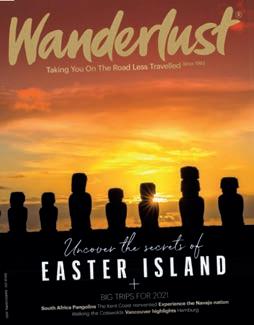












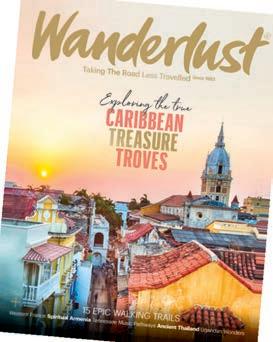















* UK Offer Only. See full terms and conditions on https://shop.wanderlust.co.uk FOR JUST £54.99 £35!* TRAVEL FURTHER Gift one year of travel inspiration, which includes… Six collectable double issues 1,200+ pages of travel ideas delivered to your door Full digital access Read the magazine online and on the go Members-only webpage Access all past editions since 2010 £50 Travel Voucher! Use with some of the best tour operators CHRISTMAS SPECIAL Gift a Wanderlust Club subscription and enjoy a FREE COPY of our brand new bookazine, Incredible Travel Stories From Around The World Give the gift of Wanderlust this Christmas… The lucky recipient will receive one year of travel inspiration (print, digital & more). Plus, you get to enjoy – or gift the recipient – a copy of Incredible Travel Stories From Around The World, delivered free to your door, which collects together some of the finest pieces of travel writing printed in Wanderlust over the last decade... Go to www.wanderlust.co.uk and on the shop enter coupon code XMAS2022 or call 01371 853641. Hurry – while stocks last! Shutterstock 92 December 2022/January 2023 � THE ISLANDS Finding



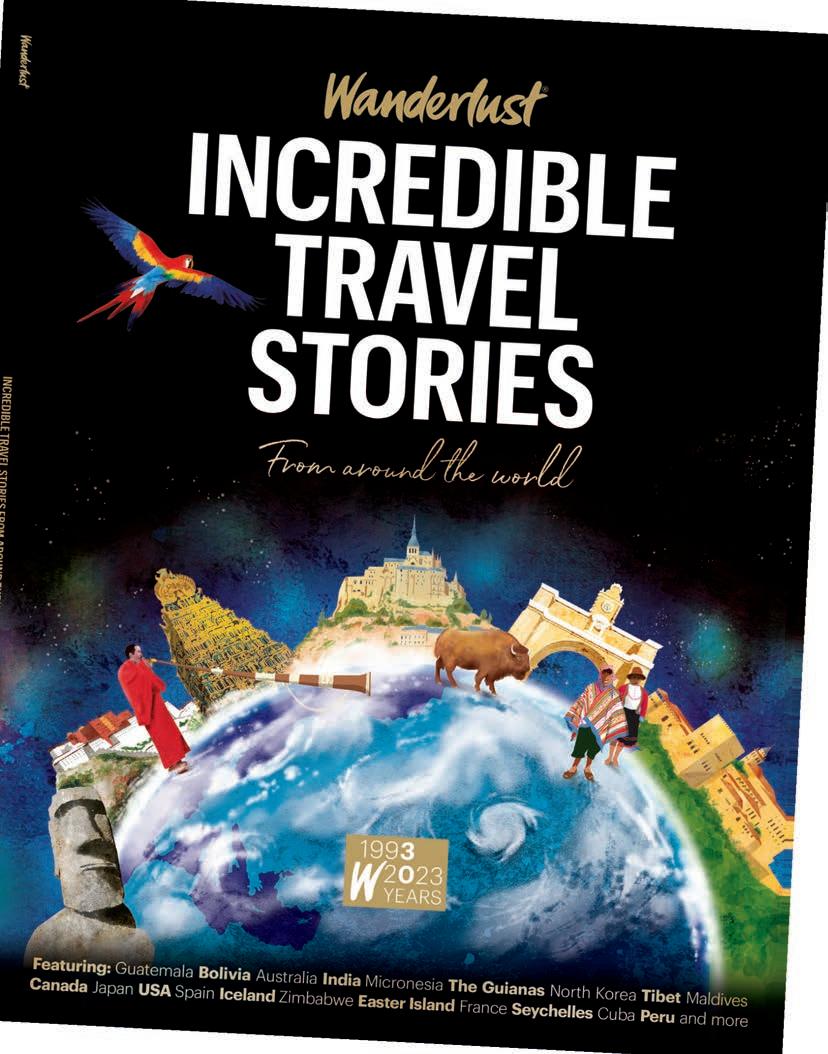








































Order online https://shop.wanderlust.co.uk Or call 01371 853641 and quote XMAS2022 www.wanderlustmagazine.com 93 stocksWhile last!Free copy with Christmas Club gift (worth £9.99)!
Heart of a Nation
One of the biggest projects transforming Saudi Arabia is the restoration of Diriyah, birthplace of the Kingdom. As it opens permanently to visitors for the first time, we discover a historic wonder that manages to also capture a new era
 Words Lyn Hughes & Juliet Rix
Words Lyn Hughes & Juliet Rix

Diriyah: The city of earth

A series of huge projects are changing the face of Saudi Arabia, but none is more symbolic than the restoration of its old capital, finds Lyn Hughes
“Many people don’t know Saudi food,” explained
Hadeel Al Mutawa, the female founder of Takya restaurant, as eight of us sat around a table in relaxed camaraderie sharing the first wave of dishes she had sent out. A salad of fig, mandarin and pomegranate arrived, followed by citrus-infused chickpeas with beetroot, and light dumplings stuffed with pumpkin. It was traditional food but made with a contemporary twist and taken to fine-dining levels. It’s no surprise thatTakya was one of the first restaurants offered a prestigious spot in a new high-profile development overlooking the UNESCOWorld Heritage site of At-Turaif. Hadeel had more than earned her place at its table.
Just as enjoyable as the mouthwatering cuisine was the wide-ranging conversation swirling around it. My Saudi companions were all connected in some way with At-Turaif and Diriyah – a project launched to restore what was the birthplace of the Kingdom of Saudi Arabia, capital of the First Saudi State and original home of the Al Saud family, opening it back up to the public. It was the reason for my visit. But what also struck me was how we were all men and women
dining together in Saudi Arabia, the conversation both rich and stimulating.
If you haven’t heard, there’s change afoot in Saudi. His Royal Highness the Crown Prince Mohammed Bin Salman Al Saud is on a mission to transform the kingdom’s economy with his Vision 2030 masterplan, fuelled partly by opening the country up to tourism.And with two-thirds of the population under the age of 35, the social transformations it has triggered are being embraced by a new generation, at least in the main centres.
Since 2019 there have been radical changes here. Men and women are no longer segregated in restaurants.There are targets to get more women into employment – and they can now drive. Cinemas have even opened and the arts are now being encouraged. It was my first visit to Saudi, and in truth, I wasn’t sure what to expect. But the tone was set upon arriving at Riyadh’s airport, where the immigration official was an efficient but friendly woman, who promptly told me to enjoy my stay.
Just as fascinating is how the country is reshaping itself physically. Several giga-projects are being planned as part of this transformation, and tourism is driving many of them. NEOM,
A sunny future (top) The buildings of At-Turaif are a mix of original and restored sections, but care is being taken across much of the Diriyah development to build in a way that doesn’t clash with the original city – even its luxury hotels will have mud-brick façades
Previous spread: DGDA; this spread: DGDA; Juliet Rix; Takya
96 December 2022/January 2023
a futuristic megacity, has been making headlines, as has a huge project on the Red Sea that includes a luxury tourism destination, AMAALA, which is due to open in 2027. But one of the first, and arguably most important, developments is Diriyah.
This project cuts to the heart of the nation and its Saudi identity. Once a nondescript town on the outskirts of Riyadh, Diriyah is home to the UNESCOWorld Heritage site of At-Turaif. It was inscribed in 2010,yet its mud-built palace, monuments and mosques had been little visited or appreciated, even by Saudis.


The plans for Diriyah’s redevelopment are far-reaching but also mindful of the area’s past.A large section will be pedestrianised; cars will be banished underground, with parking going three levels deep. All buildings, including the hotels that are opening, will be built in the Najdi style, with exteriors made of traditional mud bricks. Looking at the plans, it was apparent that much of it will be made on a very human scale, with shaded narrow streets echoing the Arabian cities of old.
The whole project will take years to complete, but the focus for now is on the historic At-Turaif district, which will be fully open to the public this December. It is a living archaeological site where discoveries are still being found, which made me
all the keener to visit. Guides have been recruited and trained, and over 60% of them are women. Key buildings have been carefully restored, and walkways, interpretation boards and museums have now been incorporated into the area.
Also opening is Bujairi Terrace, a collection of restaurants overlooking At-Turaif that will offer a range of top-level dining options from around the world, as well as esteemed local brands such as Hadeel Al Mutawa’sTakya.

The speed of change here is dizzying, and both the Diriyah project and the wider social reforms are no less momentous in person. I asked Muhannad Shono, an artist who had been living overseas before returning home, whether he had concerns about any future backlash against the social changes.

“The difference would be that now people have tasted a different way, it wouldn’t be easy to change that,” he told me.
As I sat amid the historic walls of At-Turaif at dusk, watching a ‘Sound & Light Show’ projected onto its mud bricks, I imagined Diriyah in its heyday.And then I thought of its resurgence today and of the wider and far-reaching developments going on all around it. I was glad that I’d had the chance to visit the country at this extraordinary point in time.
Food for the body and the mind (this page; clockwise from top left) Takya takes traditional Saudi Arabian dishes from regions across the kingdom and updates and modernises them for a fine-dining audience; a palm tree – one of many being replanted around Diriyah – casts a shadow against the historic mud-brick walls of the At-Turaif district; an old copy of the Qur’an that can be seen in the Diriyah Museum, one of five new cultural institutions opening in At-Turaif; before the recent reforms, it was more difficult to be an artist and there was little support – as a sign of the changing times, the Ministry of Culture is now subsidising studios in Diriyah’s new JAX Art District
⊲ DIRIYAH www.wanderlustmagazine.com 97
At-Turaif: An origin story
The first inklings of the modern Saudi state can be traced back to Diriyah’s At-Turaif district, where its secrets are still being revealed, writes Juliet Rix

The sun glowed a golden colour against the mud-brick walls as pigeons peeped from triangular vents (known as najdi luhuj) typical of the traditional architecture of Najd, the desert region that includes the Saudi capital Riyadh and the neighbouring area of Diriyah. It was in the latter that we now stood.This city holds a special place in Saudi history as the tribal home of the House of Al Saud, yet even most Saudis (let alone the rest of us) have never heard of Diriyah, much less visited – until now.
Just 15 minutes’ drive from the centre of Riyadh, a huge stone billboard proclaimed: ‘Welcome to Diriyah’. Beyond it spread a vast expanse of dusty, rocky desert dotted with life-sized Tonka-toy diggers and cranes, and brand-new buildings that had been made in a traditional style. Eventually,we reached the UNESCO World Heritage site of At-Turaif district, the excavated, restored and reconstructed 18th-century enclave of the House of Al Saud, tucked into a fertile elbow of Wadi Hanifah.
At-Turaif is now at the centre of the Diriyah ‘giga-project’, part of His Royal Highness Crown Prince Mohammed bin Salman Al Saud’s ambitiousVision 2030 programme to diversify the economy away from oil and towards tourism. Diriyah is intended, within eight years, to attract upwards of 27 million visitors annually, around a third of them foreign.
To put that in context, London received a record 21.7 million foreign tourists in 2019.
The focus on Diriyah began as a passion project of King Salman, who was instrumental in restoring At-Turaif and gaining it World Heritage status in 2010. The journey has been a process of “rediscovering Saudi’s cultural heritage,” explained Adam Wilkinson of the Diriyah Gate Development Authority (DGDA), and for the first time in its modern history it is opening up to foreign visitors.
The ancestors of today’s Saudi royal family first arrived in Diriyah in the 15th century. According to Saudi chroniclers,
Mani Al Muraydi (said to be the thirteenth great grandfather of the present king) was invited to this palm-stippled oasis by Ibn Dir (after whom Diriyah was named), then the ruler of a cluster of desert villages that were destined to become the modern metropolis of Riyadh. However, not much changed in the decades after Mani Al Muraydi’s arrival. Even by the start of the 18th century, Diriyah was far from the grand royal centre that it would become.
It wasn’t until the 1720s, following the emergence of a new imam of Diriyah, Muhammad bin Saud Al Muqrin (also known as Ibn Saud), that the conception of the Saudi state began. The birth of the nation of Saudi Arabia took a little longer, and was not without its labour pains, but it all began here in Diriyah, which rapidly expanded – as did the territory controlled by the House of Al Saud – to become the first Saudi capital.
As I stood in front of the tall, textured mud-brick walls of At-Turaif’s Salwa Palace, built by the second Al Saud ruler, I looked all around me. Across a modern bridge over a small green-fringed valley stood an immaculate mud façade striped with fresh white columns. It was a recently rebuilt mosque that dated back to the early days of the city, and it was now reopening to worshippers. History was everywhere.
Just behind it were several similar mud-brick buildings, also fronted with white columns.These were not religious structures but four restaurants masterminded by Michelin-starred chefs that were due to open by the beginning of December. They signalled the arrival of the advance guard of the Bujairi Terrace food and entertainment quarter, one of the first areas in the DGDA’s £42bn project that will be open to the public.
What visitors will encounter is a pedestrianised ‘city of earth’, all built in traditional Najdi style on the outside (inside there will be electricity and air conditioning). “It is the only Vision 2030 giga-project anchored in history,” said the DGDA’s Sami Mohamed Amin, “and all of it has been inspired by the At-Turaif World Heritage site.”
The At-Turaif site was also due to open in December, but I had bagged a preview. I entered the citadel and wound my way along a narrow passageway between the walls of the Salwa Palace and the fortifications (which protected the precious water and date palms of the wadi as much as the settlement).This was built not only for status and defence, but as a wonderfully welcome wind tunnel – a form of ancient air-conditioning.
“The palace was the first royal residence of the Saudi state,” explained our guide, his characteristic Saudi red-checked shimagh (headdress) bright against the sandy walls, “and between four and six thousand people lived around it in At-Turaif.”
We passed through the columned reception hall and into the majlis – a large council room similar to those still used today for official meetings. The Salwa Palace majlis is 18m long and three storeys high, with a balcony and a little
⊲ DGDA; Juliet Rix
98 December 2022/January 2023
Where it all started (clockwise from top right) For decades, the Salwa Palace – the former official citadel and royal residence – was the heart of the early Al Saud reign, surrounded by fortifications built to protect both its rulers and the date palms and settlement below; a young girl cherrypicks dates from those drying in the sun; triangular slit vents are a common feature in traditional buildings in Nadj; a guide wanders the At-Turaif district, a dense concentration of traditional mud-brick buildings that have been preserved and stabilised for visitors to explore; only a few of the elaborately carved doors that were once common here still survive

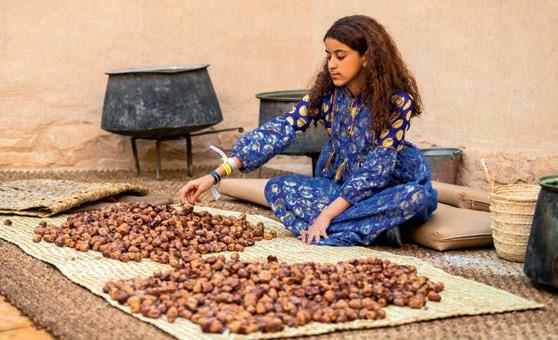
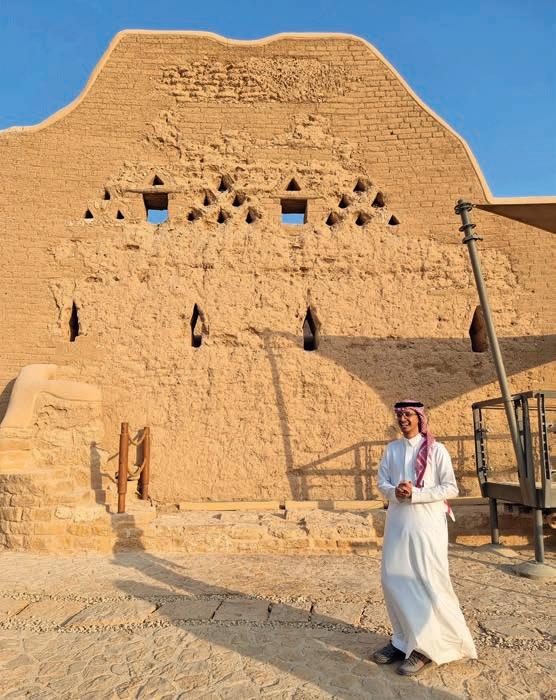

DIRIYAH www.wanderlustmagazine.com 99
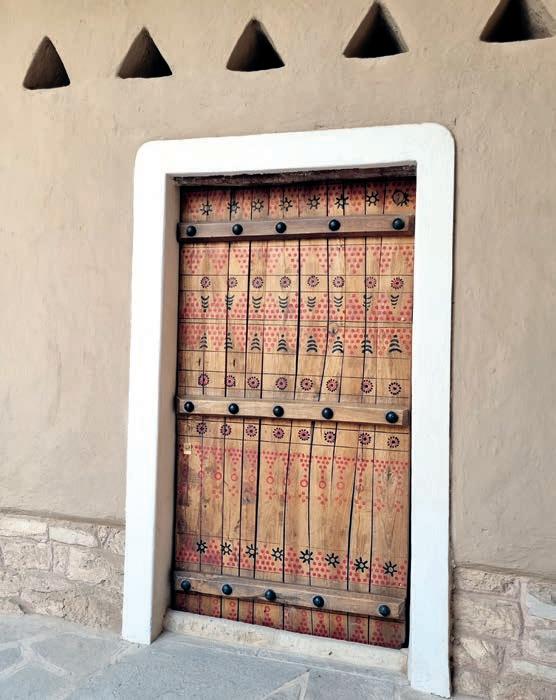

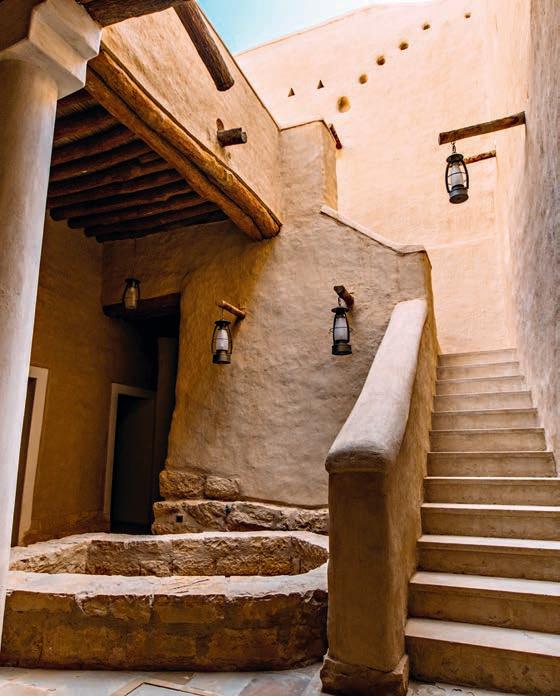 When the walls fell (clockwise from bottom left) The history of Salwa Palace is projected across its walls in an evening light show that depicts the story of the 1818 battle with the Ottomans that signalled the end of the First Saudi State – in its aftermath, Ibrahim Pasha rounded up prominent survivors of the Al Saud royal family and sent them into exile; wandering the mud-brick buildings reveals how surprisingly malleable this material is, able to be shaped into all kinds of features; the doors of the Najd region were dyed using acacia seeds and pomegranate; the citadel’s nooks and corners conjure visions of how it must have looked in its heyday
DGDA; Juliet Rix
When the walls fell (clockwise from bottom left) The history of Salwa Palace is projected across its walls in an evening light show that depicts the story of the 1818 battle with the Ottomans that signalled the end of the First Saudi State – in its aftermath, Ibrahim Pasha rounded up prominent survivors of the Al Saud royal family and sent them into exile; wandering the mud-brick buildings reveals how surprisingly malleable this material is, able to be shaped into all kinds of features; the doors of the Najd region were dyed using acacia seeds and pomegranate; the citadel’s nooks and corners conjure visions of how it must have looked in its heyday
DGDA; Juliet Rix
100 December 2022/January 2023
room off it that invited my curiosity. “This was the imam’s room for private chats with visitors,” explained our guide, “a powerful place!The decision to surrender in 1818 was probably taken in there.” But we will come to that bombshell later.
Our guide pointed out the sandstone foundations, mud brick walls – up to 1.2m thick – and high windows (“for privacy”).The door lintels were made of tamarisk wood and, as we would see later in a tumbledown house awaiting restoration, would have been attractively painted with geometric and nature-inspired designs, as would the doors. Seven decorated examples from this period (a rarity since most of the doors from this era have been lost) hang in the Museum of Architecture, which lies nearby.
At-Turaif is not just an historic site, but living archaeology. Government interest in digging up the past is relatively new in Saudi, and fresh material is being constantly uncovered. Excavation, research and restoration will continue in the background even as travellers descend. “There is little written evidence and a lot we don’t know,”Wilkinson reminded me. “Diriyah is still an archaeological work in progress.”
However, the use of the rooms in the Salwa Palace is quite well understood, including the school for the royal children and the private mosque. Here columns lay on the ground, but the mihrab wall, where the early Saudi rulers prayed, was still standing and facing Mecca (known locally as Makkah), Islam’s holiest site, which the Al Saud family seized in 1802 before losing it later to the Ottomans.
A high, solid semi-circular wall marked the palace treasury and the site of Saudi’s first coin production. It wasn’t exactly a mint, our guide admitted. Even in the early 19th century, Saudi had no resources of high value, I was told (oil was not discovered until the late 1930s); instead, foreign coins were franked with a Saudi stamp to create a local currency. A few ‘French Riyal’ coins can be seen in the modern Diriyah Museum, tucked between the mud-brick walls of Salwa Palace. Also there is a family tree beginning with Mani Al Muraydi in Diriyah in 1446 and spreading out to more than 7,000 contemporary Saudi royals.
There are three other modern museums hidden amid At-Turaif’s mud-brick alleys: these cover Saudi daily life, Arabian horses (see p106) and military history. In the latter you will find flintlock pistols and ceremonial swords, as well as Ottoman armour from an era-defining battle with the Saudis, who, our guide told us pointedly, “had no armour at the time”.
We learned more about this battle as the evening fell, watching the impressive ‘3D’ narrative light show that rolled across the red-gold sunset ‘screen’ of the palace walls.We saw the Saudi defenders of the citadel career across the battlements, swords high, holding out for six months before succumbing to the far greater firepower of the Ottomans.
This all happened in 1818, and it marked the end of the first Saudi state.The Al Saud imam was taken to Constantinople and beheaded, and Diriyah was destroyed and depopulated.That was not, of course, the end of the House of Al Saud. Just a few years later they rose again, this time based in
Riyadh where they began the Second Saudi State (1824–91), smaller than the first and excluding Mecca. Intra-family feuding then allowed another tribe to prevail and the Al Sauds retreated into the Empty Quarter, and then to Kuwait.
It took more than a decade before the 21-year-old Abdulaziz Ibn Saud – aged only eight at the time of exile – emerged to lead a daring, against-the-odds attack in 1902 to take back Riyadh’s massive mud-brick Masmak Fort, from where he proclaimed himself the ruler of Riyadh. More than 50 battles later, and with British backing, he established the territory that is today Saudi Arabia (including Mecca). I arrived at the Fort on the eve of Saudi National Day, which commemorates Abdulaziz’s declaration of the Kingdom of Saudi Arabia (with himself as absolute monarch) on 23 September 1932.
Men, women and children were gathered beneath the still-towering walls and circular turrets. Perched on rocks and railings, they watched a troop of traditional male sword dancers stamp, twirl and brandish their blades to the powerful beat of drums.The kids were decked out in green (an important colour in Islam and part of the Saudi flag).The women, with a few exceptions, wore full-length black abayas and black veils over the bottom half of their faces (I wore ‘modest’Western clothes, my head uncovered). As we have discovered in the pandemic, though, you can smile with your eyes, and several women stopped to say hello and welcome me.
Masmak Fort is clearly at the heart of the creation story of today’s Saudi Kingdom, but it all began a short drive away, back in Diriyah. Following the fall of At-Turaif in 1818, the area remained deserted for 150 years. Modern settlement began only in the 1970s, but no attention was paid to ‘the ruins’. By 1981, it was still described by the author Robert Lacey (in his book The Kingdom) as ‘a sandblown Pompeii’.
The development of Diriyah is aimed at tourism, but it is also about Saudi identity: telling a patriotic origin story for a young state with a young population – almost half of them under 25.This doesn’t detract from the experience; in fact, quite the reverse. Diriyah, old and new, undoubtedly offers an insight into the history and archaeology of pre-oil Arabia, but it also shows how this nation wishes to project itself today.Taken together, you have a fully sketched portrait of a country.

⊲ DIRIYAH www.wanderlustmagazine.com 101

A view to the future
The Diriyah project aims to seamlessly restore this historic area to its former glory, but it will take years to complete

DIRIYAH
Restoration: It’s all about the mud!
Desert-beige sludge oozed satisfyingly between my fingers as I kneaded the edges of a giant pile of mud, mixing in straw to bind it and adding a little water to keep it moist, before scooping up huge handfuls and squishing them into the wooden oblong in front of me.
Under instruction from the experts, I smoothed the top of the muddy surface with a block of wood, making sure there were no lumps or gaps.Then slowly, carefully, I lifted the wooden mould, leaving the mud brick sitting satisfyingly fully formed. “Put your palm print and initials on it,” I was told, so I signed my brick and left it in the hot Saudi sun to dry.

Mud bricks have been used for the construction of houses, palaces, forts, indeed every sort of building, for millennia – Jericho was built from mud as early as 9000 BC –and they are still used across the world today. In Saudi Arabia they remained the primary building material well after the discovery of oil began to change the face of the nation in
the second half of the 20th century. Even today in Riyadh, better known for its statement steel-and-glass skyscrapers, the capital’s Old Town is still a low-rise maze of mud-brick streets.Things haven’t changed that much.
This kind of construction is now seeing a fascinating resurgence in the first Saudi capital, Diriyah, where a huge government project is both restoring historic mud-brick buildings and aiming to create from scratch what promises to be the biggest mud city in the world.

This new quarter – including shopping streets, restaurants, cafés and multiple international five-star hotels – will have modern utilities inside, but even its Armani and Four Seasons hotels will have traditional exteriors.This new ‘city’ is expected to require a total of 180 million mud bricks! A special factory has been set up to produce them from local Diriyah desert mud, just as they would have been made 300 years ago, when At-Turaif was built, only on a much, much larger scale.

Getting our hands
dirty (clockwise from left) Juliet joins the team in making traditional bricks by mixing mud with straw. This is done for stability, then a dash of water is added to make it more pliable before packing the whole thing into a mould so it creates a nice, flat surface; a mix of old and new scatters the Diriyah area, with heritage mud-brick walls – now held up by wooden props – sat alongside new ‘traditional buildings’, such as those found in the Bujairi Terrace eating and entertainment area; an artist always signs their work, and Juliet (JR) is no different – visitors will also get the chance to make their own bricks; (previous spread) an aerial view of Diriyah
Restoring At-Turaif to its former glory requires delving back into history to revive the art of mud-brick making. Juliet Rix lends a hand
Previous spread: DGDA; this spread: DGDA; Juliet Rix
104 December 2022/January 2023
The people teaching me the secrets of making mud bricks all came from the Diriyah conservation team.They had constructed a more conventional, human-scale brickyard for the consolidation and restoration of a gaggle of buildings close to the UNESCO World Heritage site of At-Turaif, itself the subject of mud-brick restoration.This was also soon to be the site of ‘Brick Making’ experiences for the visiting public (yes, you too can make grown-up mud pies!).
Led by conservation architect Njoud Alanbari, I wandered between tumbledown mud-brick walls as she pointed out different elements: a sophisticated water system, a fireplace, roof-supporting columns, decorative frames around wall shelves – all of them made from mud bricks.The houses were in a bad way.These bricks are a marvellously sustainable material, but they are also subject to the same erosion as the desert from which they derived. Many of the mud bricks in these abandoned buildings were crumbling – or crumbled.
The fallen bricks that were irreparable were being recycled – ground into dust, mixed into mud and reformed into new bricks for these committed conservators to use in solidifying the various historic structures.The team here were simultaneously researching and restoring the buildings, as well as developing new methods of consolidation, hoping to be able
to remove the wooden props currently holding up many of the walls without damaging the existing structures.
Traditionally, beams, lintels and crack repairs were all fashioned from the tamarisk tree. Once plentiful in Wadi Hanifa (and now being planted again), its wood, if cut at the right time, is unusually resistant to termite attack. But now the conservators needed something even stronger and more durable to bind these buildings back together. I was shown an experimental pair of drying mud bricks for which the team guiding me around had particularly high hopes. They were “stitched together” with a thin rod of fibreglass.
The modern material will not be visible, but all restoration is textured so that anything added is (as required by UNESCO) always distinguishable from the original.There was a way to go, but Njoud was energetic and optimistic. She was also hoping to be able to not only restore these historic homes, but to eventually tell the stories of the people who lived in them as well. It would add a welcome human side to what is a remarkable building project.
I wondered if any of my mud bricks, once dry, might make it into one of these buildings. As I drove away across the desert, I enjoyed imagining my hand print helping to hold up a mud-brick wall in historic Diriyah.
A step back in time (top) This is a scene that could have taken place centuries ago, as the techniques for making mud-brick walls don’t differ all that much from when the city of Diriyah was first built, even if fibreglass rods have replaced the original tamarisk supports

⊲ www.wanderlustmagazine.com 105
Horse sense (top) The grey mare and her handler circle the arena outside Diriyah’s new Arabian Horse Museum, which delves into equine history across the region, from the use of horses in sport to the role they played in wartime
Arabian horses: Back in the saddle
The launch of a new museum in Diriyah shows how horse culture was integral to life in early Saudi Arabia and beyond, writes Lyn Hughes
The grey Arabian mare snorted as she trotted around the small arena within At-Turaif. With her huge intelligent eyes, high tail carriage and aristocratic air, she was a fine example of her breed. She stopped close to where I stood at the fence and willingly let me pat her warm muscular neck. It felt like I had been accepted.
Arabian horses are one of the most charismatic and influential breeds in the world, renowned for their beauty, intelligence, stamina and speed. Globally speaking, many modern horses have Arab blood in their veins, including English thoroughbred racehorses.They are one of the world’s oldest domesticated breeds, with their history going back at least five millennia, and maybe much longer. Sculptures of horses have been found in the Arabian peninsula that are over 9,000 years old.
Arabians horses were integral to the first Saudi state, when Diriyah was a centre for breeding the best of the best. Later, when King Abdulaziz Ibn Saud re-established Saudi rule in 1932, one of his interests was the preservation of thor

oughbred Arabian horses, an extension of the history of his ancestors. It is said that he owned around a thousand mares.
So, it was no surprise to me that one of the many museums to open within At-Turaif had been dedicated to horses.Among the exhibits was a life-size model of a beautiful Arabian mare called Turfa, gifted to Britain’s King GeorgeVI by King Abdulaziz in 1937 on the occasion of his coronation.There were plans for the young Princess Elizabeth to inherit her, but it was said the mare was too spirited, so she was used for breeding instead.
As well as the museum, it is intended that there will be displays of Arabian horses in or close to At-Turaif.The arena outside the museum was used when I visited, but it is rather small in size, so something more practical may be needed in the longer term.There is also talk of an equestrian centre and of the opportunity for visitors to ride through the wadi.
For now, though, on a balmy evening it was a pleasure to be nuzzled by a beautiful creature in a historic spot where generations of Arabian horses would once have passed.
Research courtesy of the DGDA; images: Juliet Rix
106 December 2022/January 2023
Art: Creating a scene

Little did I think when I arrived in Saudi Arabia that I would soon be sat on a magic carpet.The rug in question belonged to the artist Saeed Gamhawi, or at least it was a projection of one that belonged to his mother. It was now emblazoned across the sandpit upon which I sat, and as I ran my fingers through the grains of sand, the rug flowed with them.Whatever I did, the carpet was always there, his mother’s memory forming and re-forming around me. It was magical.
On arrival, JAX Art District in Diriyah looked like an industrial Empty Quarter – roadways devoid of people and populated only with desert-coloured warehouses and old garages. In fact, JAX was originally a company that was based here – that’s how it got its name. But like the desert itself, this apparently barren exterior hides corners of creation, in this case the studios of a handful of Saudi Arabia’s leading artists.
Art, for a long time, was a difficult subject here.The nation’s conservatism and limited support made it difficult to be an artist.“I grew up completely scorned,” said Muhannad Shono, who, along with Gamhawi, recently represented Saudi at the Venice Biennale and was now moving into a large government-subsidised JAX studio. “I drew all the time, but I was
told by my teachers to draw a line to cut the head off my characters – literally – because only God can create.”
He spent years abroad, mostly in Australia, and is still both astonished and emotional about his newfound ability to make art in his home country.Things have changed so much, he said: “It’s gone from underground shows to [the government asking] ‘what do you need?’.”
The development of JAX is part of the larger Diriyah project, and a variety of opportunities for travellers to visit are currently being developed. More artists are expected to move in – both Saudi and foreign.“Like the Medicis, we want to bring in artists and give them space to express themselves,” explained Sami Mohamed Amin of the Diriyah Gate Development Authority.
The Medicis were quite prescriptive, however, and I admit I wondered how much freedom these artists had. But the work I saw on the studio walls suggested they had a lot. Even Shono, whose art often addresses censorship, told me: “Of course it could all change again… but I haven’t found a red line yet.”
As I sat there, sieving multi-coloured sand through my fingers, I hoped that Saudi’s commitment to its artists and their art would prove as enduring as Gamhawi’s mother’s carpet.

Juliet Rix takes a magic-carpet ride through Saudi’s new official art district and discovers a country reconnecting with itself
Starting from scratch (this page; left to right) The JAX Art District offers something to Saudi Arabia’s artists that generations of young Saudis haven’t experienced before: creative freedom. Not only that, it means financial support for its artists in terms of having a space to both work in and show their creations – and one that travellers to the area may soon be able to see for themselves on curated visits; Juliet Rix takes a ride on a magic carpet, or least a projection of one onto a sandpit by the conceptual Saudi artist Saeed Gamhawi, whose work tends to largely focus on cultural heritage and finding connections to the past
⊲ DIRIYAH www.wanderlustmagazine.com 107
Community: Looking to the future
The morning was rapidly heating up as I sought shade under a tree. I was in a newly opened park adjoining At-Turaif, and its head gardener was motioning me towards some inviting wooden bowers. “Saudis like to be outside, to sit and picnic,” he told me. Despite the heat, a soundtrack of birdsong trilled through the trees but I was a little early to see the crowds. On summer nights the park will be softly lit as people go out to relax and socialise in the relative cool.
Tree planting is very visibly taking place around Riyadh, as part of a huge Green Saudi initiative aimed at restoring nature and fighting climate change.We toured the various trees, plants and grasses of the park as its head gardener explained how the priority was to focus on planting native species, not least because they are drought tolerant and need less irrigation.
All this was in Wadi Hanifah, the fertile valley that bounds Diriyah and runs through Riyadh. Its life-giving waters and rich soils were a major factor in both the former and the current capital being established where they were. In recent years there has been work done to restore the wadi to its former glory, and in Diriyah it is seen as key to its ambitious sustainability plan.
The valley also plays a number of roles. From a leisure and wellbeing point of view, the park was being created there with people in mind as well as the environment.The building of a cycle trail through the wadi is already underway and horse-riding treks of the valley are being planned for the future.
The other big factor is what grows there. Dates have a special place in Saudi culture, having played a vital part in the country’s economy and its people’s nutrition. It’s no coincidence that a date palm features on Saudi’s national emblem. Wadi Hanifah was an historically important home to date farms, which are now being preserved and replanted.
I caught up with a British expat working for the Diriyah Gate Development Authority, Julie Alexander, who is an expert on environmental sustainability. She explained how date palms are particularly effective in the absorption of carbon – more so than other species.A task force has been set up to investigate the wadi.
But it’s not just the landscape where Diriyah is seeking to make environmental gains. In the first phase of its redevelopment, its buildings – restaurants, hotels, shops, housing – are being built out of mud bricks in the traditional Najdi style. These techniques not only mean it blends with the old city’s architecture, but offer some added perks.The thick walls and strategic airflow naturally keep buildings at a comfortable temperature, without the need for air-conditioning. Internal courtyards and narrow streets also help with shade and cooling.
There are other instances of sustainability and cultural heritage crossing over. Small, local independent shops will have their place among the district’s big brands, as will artisans and their crafts. I got a taster at At-Turaif’s visitor centre, where a calligrapher was at work, while in another building I learned more about Saudi coffee and how it was traditionally served.
But my most memorable Saudi coffee experience was when I visited the home of Noura Um Faisal, a Diriyah resident with a passion for educating people on Saudi traditions. As a teacher, she entertains groups of children, who come to hear about the kingdom’s history and culture. I was led into a room just off her courtyard and discovered a treasure trove crammed with household goods, appliances and bric-à-brac from over the decades. Old sewing machines, cameras, telephones and costumes filled shelves and cabinets.

We went through to a large sitting room very much in the style of a traditional majlis (meeting room), with seating wrapped around the outside edges so that all the guests could see each other. Fragrant Saudi coffee was served in small cups alongside platters of dates, while sweet pastries, rich with pistachio and honey, were politely offered around.
Noura, now in her early sixties, talked about her childhood and how things had changed and developed since those days. I quizzed her on her wedding and she pointed out the make-up and scent which she had kept from that day. It was a fascinating hour or so, and I found it encouraging that the people behind Diriyah were keen to have her involved in At-Turaif.
One of the aspects of my visit that piqued my interest was the role that women are playing in the Diriyah project, from the multi-lingual female guides working in At-Turaif through to those in senior roles in construction, archaeology, community relations and more. It all fitted into a pattern of change, from sustainability to people like Noura, and it made me optimistic for the future of Diriyah on all levels. ⊲
The Diriyah project is transforming the area, but it’s also bringing locals, sustainability, tradition and visitors together in ways you might not expect, discovers Lyn Hughes
DGDA; Juliet
Rix 108 December 2022/January 2023
Stepping back in time (clockwise from top) Immersive theatrical performances that recall life in the early days of the First Saudi State are due to take place daily in At-Turaif, offering a glimpse of traditional living; one of the biggest changes that is happening to Diriyah is the mass planting of trees and creation of new parks and green spaces where locals and visitors can mingle and wander; Noura Um Faisal sits in her home ‘museum’, surrounded by dolls, radios, instruments and the clutter of everyday life over the past few decades in Saudi Arabia, offering up a tantalisingly domestic glimpse of the country over the years
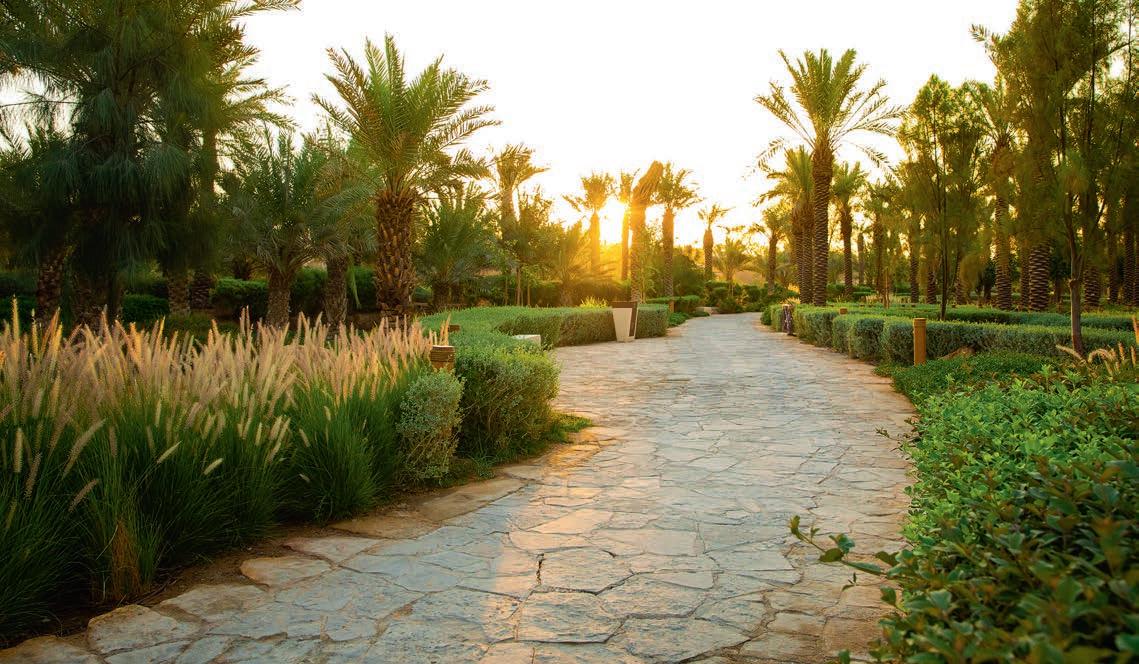

DIRIYAH www.wanderlustmagazine.com 109
A work in progress (this page; top to bottom)
Saudi Arabia: vital statistics
Capital: Riyadh Population: 34.8 million

Languages: Arabic. English is widely spoken Time: GMT+3
International dialling code: +966

Visas: UK nationals and those of other eligible countries can obtain a visa on arrival (SAR480/ £113) or apply online for an e-visa (SAR535/ £125; https://visa.visitsaudi.com) in advance. This entitles you to a stay of up to 90 days. Money: Saudi riyal (SAR), currently SAR4.25 to the UK£. Credit cards are widely accepted but some taxis and services are cash only.
When to go
At-Turaif opens to the public from December. Saudi Arabia (KSA) is extremely hot from May to mid-September, especially around the capital, but the rest of the year it tends to be bright, dry and warm. October–April: This is peak tourist season, as temperatures drop to a balmy average of 22ºC by December, even in the capital. Note that Ramadan will be observed between late
March and late April in 2023. Strict fasting takes place and shops won’t serve food before sunset; nor will you be allowed to eat in public by day. But when the restaurants reopen after dusk, they stay open until late as locals break their fasts in huge iftar banquets. Temperatures rise steadily during April.
May–August: In Riyadh, the temperature can reach well into the 40s (ºC) as summer kicks into gear, though Diriyah can be as much as eight degrees cooler due to its higher altitude and the cooling breezes from Wadi Hanifah. September: Saudi Arabia’s National Day is on 23 September.

Health & safety
At the time of writing, there was no requirement to provide a COVID-19 vaccination certificate or negative PCR or antigen tests to enter Saudi Arabia. Consult the FCDO (gov.uk) site prior to setting off in case of change. Before travelling, all visitors must fill out the online Registration Immunisation Information Form (https://arrival.muqeem.sa/#/vaccineregistration/home). You are also advised to have medical insurance that covers the costs of COVID-19 treatment in hospitals.
Getting there
Saudia (Saudia.com) has daily direct flights to Riyadh from London
The UNESCO World Heritage site of At-Turaif is set to reopen to the world in December, though the work to preserve it is ongoing; the Salwa Palace is the original home of the Al Saud family
110 December 2022/January 2023
Heathrow; it also operates flights via Jeddah from Manchester. British Airways (ba.com) similarly flies direct from Heathrow to Riyadh. Flights take 6.5 hours from London and cost from around £698 return.
Getting around
Diriyah is just to the west of Riyadh. Currently there is very little public transport; however, a metro system is due to open to passengers in Riyadh in 2023 and will run to Diriyah. In the interim, the easiest way to travel is by taxi. Although Uber has made it to Riyadh, it is not yet as reliable and popular as other taxi services. The first quarter of the renovated Diriyah to open will be completely pedestrianised.
Hours & tickets
At-Turaif and Bujairi Terrace will be open simultaneously. The hours are 10am to midnight from Sunday to Wednesday; 10am to 1am on Thursdays and Saturdays; and 2pm to midnight on Friday. No ticket is required weekdays before 4pm. A Diriyah Visitor Pass is required after 4pm on weekdays and all day during the weekend; this is bookable via the website (diriyah.sa) or via a downloadable app. Guided tours are bookable on-site and/or in advance only when purchasing a Diriyah Visitor Pass. Comfortable flat shoes are required.
Accommodation
Over the next couple of years 38 hotels will open in Diriyah, including such well known brands as Four Seasons, Raffles and Anantara Resorts Until then, the easiest option is to simply stay in Riyadh, which has a range of modern hotels to choose from.
Food & drink
Bujairi Terrace overlooks At-Turaif and has about 20 restaurants, including international brands such as

Hakkasan and home-grown Saudi eateries. Takya (takya.sa) serves regional Saudi cuisine with a modern twist and is highly recommended. Also, don’t miss out on Saudi coffee – it is very good quality and usually has a bit of added spice; plus it is served with a date rather than with sugar. Many restaurants offer delicious juices and mocktails
Local customs & traditions
Life in the city
this page; clockwise from this) Gazing out from one of the rooms in Salwa Palace; Takya restaurant prepares for customers; its take on sayadia (rice with pan-seared hammour) offers up a modern

a
The dress code for visitors is now much more relaxed than it was previously. Women no longer have to wear an abaya or cover their hair, but should still dress modestly, as should men, always keeping shoulders and knees covered. Male and female foreign visitors can now share a room in a hotel without proof of marriage and can eat together in restaurants. The only place you are likely to find segregation is at the security queue at the airport, where men and women go through separately. Respectful public decorum is advised, so avoid bad language and loud behaviour. KSA remains a dry country, so no alcohol can be taken in or consumed.
Further reading & information
Visitsaudi.com/en – Official tourist board site for Saudi Arabia; includes visa info. Diriyah.sa – Official site for Diriyah, which includes details on its plans for the future.

WANDERLUST RECOMMENDS
There are plenty of books on the history of Saudi Arabia, but Robert Lacey’s The Kingdom (Hutchinson, 1981), which charts its story up to 1979, and his follow-up, Inside the Kingdom (Arrow, 2010), offer a comprehensive look at how it came to be.
DGDA
(
spin on
classic dish www.wanderlustmagazine.com 111 DIRIYAH FOOTNOTES
5 pristine islands in the Philippines GET BACK TO NATURE
Pinnacle mountains carpeted in forests that trill with the sound of parrots; caves cut by clear-water rivers and coconut coves covered with peppery sands. The Philippines is quintessential Southeast Asia and it comes with a burgeoning commitment to conservation, minimal crowds and a warm welcome. Plus, there are more than 7,000 islands to visit, so you’re spoilt for choice. Here’s a pick of some of the best and what to expect…
1 PALAWAN
El Nido, on northern Palawan island, is a place of pristine limestone jungle mountains rising from a turquoise sea. Explore them for yourself by kayaking over coral gardens and into lagoons as still as can be. For a bird’s eye view of the ocean and its sprinkling of islets, hike to Taraw peak. Next, head south

to Puerto Princesa for rainforest hikes on Mount Sakalot where you can cool off with waterfall swims. Beneath the mountains here, you can even drift on an underground river through the stalactite-studded Natuturingan cave.
For the ultimate adventure, explore one of Southeast Asia’s most jaw-droppingly beautiful wilds on a
All that glitters (this page; clockwise from top) The clear, karststudded waters of El Nido look as though they were custommade for kayakers; divers in Cebu can expect to see jackfish, parrotfish, turtles and more; a performer at Cebu’s annual Sinulog festival

five-day trek up Mantalingajan mountain, which sits within a wilderness so large that it’s home to Indigenous communities and one of Asia’s greatest concentrations of rare and endemic plants and animals.
2 CEBU
Cebu mixes nature and culture seamlessly. The island’s annual Sinulog festival is as colourful as any Brazilian

112 December 2022/January 2023
Alamy; Shutterstock; Tourism Promotions Board Philippines
Mardi Gras, with pulsating parades and parties lining the streets. And it’s not the island’s only jewel. Cebu city’s gold-glittering baroque church, Minore del Santo Niño, is the oldest and most venerated in the Philippines.
Elsewhere, the Kan-irag Nature Park is a flagship conservation and reforestation project that abuts the Central Cebu Protected Landscape area, offering sanctuary to nearly 30 native and endemic bird species. In addition, a string of coastal marine sanctuaries offer protection to water birds and turtles.

Be sure to pay a visit to Malapascua islet, off Cebu’s northern cape, which has bone-white strands of beach and some of the finest scuba diving in Southeast Asia. Alongside wrecks, wall dives and reefs, it’s one of the best places in the world to see rare thresher sharks.
Natural beauty (this page; clockwise from top left) Bohol’s Chocolate Hills are named after the colour that its undulating landscape turns during the dry months; the Philippines’ clear waters are a sanctuary for turtles; the aerial view of lush Siargo island; Boracay boasts magnificent whitesand beaches
3 BORACAY
You could almost throw a ball from one side of tiny Boracay to the other, which is why the island’s enticing shell beaches and coconut-shaded coves are so vulnerable to overtourism. In 2018 the Philippines’ government closed the island for clean-up and conservation, a programme that would go on to inspire green initiatives across Asia. Some 400 hotels and restaurants were temporarily closed; hundreds of tonnes of plastic were removed from beaches and reefs; sewage treatment, recycling and solar-power generation were introduced at key hotels; and when the island re-opened, visitor numbers were heavily restricted. Thanks to these measures, turtles and whale sharks have returned to the sea around Boracay and the island is a place where, if you choose your resort well, you can now relax in the knowledge that you are travelling with a much lighter footprint.

4 BOHOL
Bohol is a beauty, with rolling chocolate-coloured hills and valleys as green as Ireland that are cut by winding rivers. Lush forests echo with birdsong and there are some fabulous shores and dive sites. Terns trill on Alona Beach’s sugar-white sands, manta rays congregate around Pamilacan islet and turtles and huge schools of barracuda bustle in the seas around Balicasag. From March to June you can also see Bryde’s and sperm whales offshore.
Inland, the island’s dense forests are home to tiny tarsiers – fluffy primates with eyes like bushbabies. It’s a wild wonder that is also very well protected. Bohol is one of the country’s eco-tourism pioneers, and it has a strict code of conduct for boat operators in particular, who require a ‘Seal of Excellence’ in best practice in order to operate trips offshore.
5 SIARGAO


With its tubing waves and beach breaks, Siargao has been a surferdude draw for decades. Since the pandemic, it’s grown to become one of the Philippines’ light-adventure capitals. You can kitesurf on the calm lagoon near General Luna town, kayak through extensive mangrove forests, wander through stalactite-filled caves and wakeboard, rock climb and plunge into pool-sized mini lagoons at Magpupungko on the easy-to-access east coast. There’s great snorkelling and diving, too, at sites such as Shark Point and the Cathedral – a vast undersea cave studded with coral.
Myriad beaches line Siargao’s main island and fringe coral cayes offshore. Many are backed by low-key beachside boutiques offering zen-calm stays, detox smoothies and yoga at sunrise. It’s perfect for some relaxing downtime after those activity-packed days in the pristine islands of the Philippines.
PROMOTIONAL FEATURE www.wanderlustmagazine.com 113For safe travel info and destination updates, visit: itsmorefuninthephilippines.com
Green and pleasant land
The Murcian philanthropist Ricardo Codorníu, who trans formed the area that is now Sierra Espuña Regional Park in the 19th century, was known as ‘The Apostle of Trees’
 Words Eddi Fiegel
Words Eddi Fiegel

Forget those images of fly-n-flop beaches, tourism in Spain is going distinctly – and brilliantly – green SPAIN Sustainable
Discover why Valencia could be the EU’s Green Capital in 2024


Valencia may be known for its paella and world-class architecture and design but the city is also at the forefront of some of Spain’s most innovative sustainable initiatives. Already shortlisted to become the EU’s Green Capital 2024, the city has a 150km network of cycle paths and 40 ciclocalles (cycle-priority streets), meaning you can get around town easily and sustainably.There’s also a citywide electric-car-share scheme, while in the hip El Cabanyal neighbourhood, on the La Malvarrosa beach, pilot projects range from smart lighting along the seafront (only used if a pedestrian is detected) to the use of lamp posts to recharge electric cars. Meanwhile, the city’s extensive amount of parkland – including theTuria Gardens (one of the largest urban parks in Spain) and the Viveros Gardens – help absorb carbon emissions. www.visitvalencia.com
Stay in an energy-efficient windmill in the Sierra Espuña Regional Park, Murcia

Wake up to the sounds of the pine-clad mountains at Hospedería Bajo El Cejo (pictured).This energy-efficient hotel has 12 rooms, split between a converted windmill and cottages originally built for local charcoal burners; they have beamed ceilings and overlook the distinctive limestone rockfaces of the Sierra Espuña Regional Park.The hotel’s owners, Rosa and Andrés, wanted to build somewhere that was sensitive to both the delicate ecosystem of the Sierra and to the planet in general; natural materials such as wood, ceramics and glass have been used wherever possible throughout the building.Winters are mild here, so you can enjoy breakfast on the terrace almost all year round – expect homemade fig and plum jams made from the owners’ fruit orchards. Dinners are also available on request, featuring dishes using local produce, accompanied by local wines. www.bajoelcejo.com
Cycle or walk the Olive Oil Greenway in Andalucía

The idea of cycling or walking along a disused railway may not be new, but on this historic 55km route between Jaén and the Guadajoz River you’ll pass through some of Andalucía’s most exceptional and leastvisited landscapes. Originally built in the late 19th century for the Tren de Aceite (‘OilTrain’), which carried olive oil from the prov inces of Jaén and neighbouring Córdoba to the port at Málaga, the line was closed in 1985 and lay derelict for years before being relaunched as a Vías Verdes, or ‘greenway’.You can now walk, cycle or mountain-bike your way past olive-grove-filled plains, ghost towns and abandoned quarries. Beyond the river, the Aceite path connects with the Vía Verde de la Subbética, which runs towards Puente Genil in Córdoba, creating a continuous 112km route. www.andalucia.org/en/routes-via-verde-del-aceite
Take a train from Madrid to Castile la Mancha and Extremadura – and beyond
As Agatha Christie once observed: ‘To travel by train is to see nature and human beings, towns and churches and rivers, in fact, to see life.’ Exploring Spain by train, not only do you indeed see life in all its glories, but you’ll do so without harming the planet.There are many options.
For instance, Expressions Holidays’ ‘Madrid and Heart of Spain by Rail’ trip takes you from the capital into the windmill-filled plains of Castile la Mancha – made famous by Don Quixote – and through to the lesser-visited historic towns and wild landscapes of Extremadura. Alternatively, if you’re not in a hurry, hop aboard Spain’s longest rail ride, the Torre de Oro (bookable through national operator RENFE). This train rolls from Barcelona, on the north Mediterranean, to Cádiz, on the south Atlantic coast, over a leisurely and scenic 12 hours. www.expressionsholidays.co.uk; www.renfe.com
Previous spread: Alamy; this spread: Alamy; Bajo El Cejo; Shutterstock
SUSTAINABLE SPAIN
116 December 2022/January 2023
Cycle speedway
As the 20th century progressed, trains became an increasingly infrequent sight on the Oil Train line, and when they did run it was at an average speed of just 30km/h
Cycle revived rails, Andalucía
Spain is an expert at turning abandoned train lines into fantastic cycleways, and the historic Vía Verde del Aceite is arguably one of the best
There are 2,900km ofVíasVerdes across Spain, a vast network of disused railways repurposed for walkers and cyclists. And many are ideal for travellers seeking to get away from the hordes and the over-trampled tourist sites and discover a different side to the country.

That’s exactly the case with the 55km-longVíaVerde del Aceite, which crosses a much less visited area of Andalucía. The route starts in the small but grand town of Jaén – capital of the eponymous province – and wiggles westwards through the glorious countryside of Spain’s largest olive-oil-producing region. For a shorter taster, head for the small town of Martos (about 45 minutes by bus or car from Jaén) and begin the route there.Within half an hour, you’ll be surrounded by what locals call a mar de olivas (sea of olives)
– mile after mile of gnarled olive trees, evenly spaced, some hundreds of years old. As the path winds round bend after bend, the view opens up to epic valleys. Rabbit holes dot the path like underground cave dwellings while the landscape transforms into a patchwork of yet more olive groves dotting the pale, parched-looking soil like a solitaire board.
Even though you may not see a soul for hours, there is occasional evidence of human life.The original train line was built between 1882 and 1893 and you’ll pass many remnants of its functioning days, including old stations and platforms, and a series of spectacular, if potentially vertigo-inducing, iron viaducts over vertiginous ravines.
The Aceite officially finishes at the Gudajoz River, but continue for 10km along the contiguous Vía Verde de la Subbética to finish your journey at the delightfully geranium-filled hilltop village of Luque. Here, the old railway station is now an olive oil information centre, complete with a café and a shop selling, of course, olive oil products.
Best for: Getting off the beaten track
Why
do it? To see some of Andalucía’s least-visited but loveliest villages as well as extraordinary landscapes filled with olive groves as far as the eye can see
Route:
Jaén; Martos; Luque
www.wanderlustmagazine.com 117 ⊲
Explore Andalucía by ebike at an eco-friendly, cycle-friendly guesthouse

Casa Olea (pictured) sits in a lush valley in the Sierras Subbéticas Natural Park, between Córdoba and Granada.This converted farmhouse, complete with solar panels, a biomass boiler and strong green credentials, is a magical rural haven. It also makes a great cycling base, with plenty of road and offroad routes nearby.There are e-bikes, hybrids and road bikes available to rent from the hotel; if you’ve brought your own, there’s secure bike storage as well as outdoor taps for cleaning. And there is a large swimming pool with exceptional views of the surrounding hills, olive groves and forests – perfect for cooling down after a hot day’s cycling. British owners Claire andTim can provide homecooked meals, heavy on locally sourced produce and wines, as well as their own extra-virgin olive oil, made at the local cooperative olive mill. www.casaolea.com
Visit the first winery in Spain to receive ZeroCO2 certification
When it comes to wine-producing regions in Spain, La Rioja may be the best known, but as many oenophiles are aware, other parts of the country produce superb wines too. Not least Catalonia’s Empordá region, which is home to some 400 wine growers. Many of them take a sustainable approach, including Eccocivi, whose bodega, in the shadow of the Gavarres mountains, a 30-minute drive from Girona, was the first in Spain to receive ZeroCO2 certification. Despite being a relatively new winery, only producing its first vintage in 2008, it has already gained international recognition with two of its wines: the white Can Noves Blanc 2018 and the red Can Noves Negre 2016 won silver and bronze medals respectively at the DecanterWorldWine Awards in 2020.Take a guided tour to taste the wines, paired with cheeses and charcuterie. www.eccocivi.com

Stay at a solar-powered farmhouse in Andalucía’s Subbética hills
If you’re planning to explore Andalucía’s greenways, or if you just want to escape to a lovely rural retreat, the eco-friendly apartments of Los Castillarejos, on the edge of the hilltop village of Luque, provide the perfect antidote to city life. In what was originally an old farmhouse, laying amid a large estate filled with olive, oak, almond and hazelnut trees, there are 14 simple but contemporary apartments. These sleep up to six people and all feature kitchenettes, furniture crafted from local wood and huge picture windows look ing out to the hills, mountains and olive groves of the Subbética. The heating and hot water are solar-powered, while the boiler is powered by mulched olive pips. If you’re feeling weary after a day’s activity, look no further than the large salt-water infinity pool. www.loscastillarejos.com/en
Go stargazing at an award-winning Aragónese retreat
Landlocked Aragón, in Spain’s north-east, is perhaps one of the country’s least well-known areas. Little surprise, then, that there’s a real sense of getting away from it all atTorre delVisco.This luxe boutique hotel with an award-winning farm-to-table restaurant sits in the Matarranya area of eastern Aragón.The building dates back to the 15th century, probably once belonging to the Spanish Knights Templar of the Order of Calatrava. It’s built on a hillside in the midst of a 200-acre estate that encompasses certified organic farmland, olive groves, rose gardens, forests and a lake. It has no TVs and is blissfully far from the built-up world. So much so that, thanks to the absence of light pollution and the local climate’s frequently clear weather, it is the first Relais & Châteaux hotel in Spain to be awarded UNESCO-backed Hotel Starlight certification. www.torredelvisco.com

 Marquez Juan Manuel
Marquez Juan Manuel
118 December 2022/January 2023 Alamy;
right to the heart of Central
Travelling by train offers a winning combination of eco-friendliness and enjoy ment. Especially a journey such as Expressions Holidays’ ‘Madrid and Heart of Spain by Rail’ trip, which explores lesser-visited regions and starts in the capital, considered one of the world’s most sustainable cities – Madrid has more than 3,800 green areas, and a tree-planting initiative is underway to create a vast ring of forest around the city.
Explore Madrid’s Retiro Park and more before boarding the train, which heads south across the parched-looking plains to arrive at the small city of Almagro, declared an official Historic-Artistic Site. Look out for its colonnaded Plaza
Mayor and the 17th-century Corral de Comedia open-air theatre, which is still in operation.
From Almagro, continue to the UNESCO-listed town of Merida, home to some of the best-preserved Roman ruins in Spain, including theTemple of Diana, a 60-arch, 800-metrelong bridge and the towering Los Milagros Aqueduct.

Next is the magnificent medieval town of Cáceres, with its well-preserved palaces, watchtowers, plazas and narrow, winding streets, dotted with storks’ nests. Don’t miss the renowned sweet pastries made at the Convent of San Pablo.
The final leg of the journey ends in the hilltop town of Toledo. Often described as the ‘City of Three Cultures’, you can still see remarkable remnants of Christian, Islamic and Jewish heritage here, from the Gothic cathedral and Cristo de la Luz Mosque to the narrow lanes of Toledo’s well-preserved Jewish Quarter.
SUSTAINABLE SPAIN
Best for: The UNESCO-listed sites of Merida, Cáceres and Toledo Why do it? You’ll see some of Spain’s most exceptional art and architecture in comfort and with lower CO2 emissions Route: Madrid; Almagro; Merida; Cáceres; Toledo; Madrid Ride
Spain Exploring by train means lower carbon emissions and enthralling views from the window, especially if you take an offbeat journey from the capital www.wanderlustmagazine.com 119 ⊲
Cool columns
The Roman Theatre of Merida was constructed in the years 16 to 15 BCE, when the city was known as Emerita Augusta
Explore Menorca’s coastal trails on a sustainable walking holiday


There’s more to Menorca than beautiful beaches, and a walking trip along the coastal Camí de Cavalls is an excellent way to explore the island. Pura Aventura’s ‘Menorca Coastal Trails Inn to Inn Walking Holiday’ takes in the most impressive stages of this historic footpath. It includes visits to Megalithic standing stones, wooded gorges, wetlands and lagoons, dramatic lighthouses and an artisan cheese farm in capital Mahón.You’ll also have time to enjoy the island’s lesser-visited but gorgeous northern coast.With luggage transfers, meals at small local restaurants, stays at non-chain hotels and a mix of self-guided walks and city tours with local guides included, you’ll be supporting the local economy. Pura Aventura also measures the carbon footprint of your return trip, before growing enough trees in Central America to absorb twice the carbon. www. pura-aventura.com
Explore the green schemes of Madrid, one of the world’s most sustainable cities
Spain’s cities have been quick to embrace sustainability, with many of them introducing new measures to reach green targets over the coming years. Madrid in particular has gained international attention, thanks in part to the fact that it is has a very high ratio of trees per person as well as huge number of green spaces. For instance, Monte de El Pardo Park, just a few miles north of the city centre, is home to one of the largest Mediterranean forests in Europe and covers an area about 50 times the size of NewYork’s Central Park. Since 2018 the city has introduced a designated pollution-reducing low-emissions area – Madrid Central – where certain roads are only open to pedestrians, cyclists or public transport. And the local BiciMAD ebike share scheme is extensive, with 2,500 electric bikes distributed across 208 stations. www.esmadrid. com/en/parks-gardens-madrid; www.bicimad.com

Find eco-hotels and sub-marine sustainability on Formentera

Formentera may be the smallest of Spain’s Balearic islands but not only does it have some of the most breathtaking beaches and countryside, it is more than holding its own when it comes to sustainability initiatives.The Save Posidonia Project aims to protect the 76 million square metres of underwater meadows filled with Posidonia oceanica, a marine plant that helps oxygenate and clean the ecosystem surrounding the island. Meanwhile, Etosoto is a small, beachside boutique eco-hotel and organic farm project on the edge of vineyards, wheat fields and olive groves to the east of the island. Here, you can start the day with a naturopath-designed organic breakfast before luxuriating in the natural landscape.The hotel also offers slow-food masterclasses, sessions in growing your own organic produce, naturopathy and fasting, yoga and walking activities. www.saveposidoniaproject.org; www.etosoto.com
Explore the Costa Brava from one of Spain’s pioneering ‘green’ hotels
With an enviable location on one of the Costa Brava’s loveliest beaches, less than an hour’s drive from Girona, you might never guess that Hostal Spa Empúries was the first hotel in Europe to gain the internationally recognised LEED (Leadership in Energy and Environmental Design) Gold certification. Sustainable materials, including chemical-free paints, have been used throughout both the renovated original building, which dates to the early 20th century, and the sleek, minimalist extensions, and much of the produce served at the renowned restaurant is sourced from the hotel’s own organic kitchen garden.With vast picture windows looking out to the beach, you could easily spend days just gazing at the view but there’s also a luxurious spa. If you’re feeling more active, you can pick up the Camino de Ronda coastal path just outside the hotel. www.hostalempuries.com
SUSTAINABLE SPAIN
120 December 2022/January 2023 Alamy; Shutterstock
in
of
As with so much in life, the oldest things are sometimes the best. Menorca’s Cami de Cavalls, or ‘Horses’Trail’, dates back to at least the 14th century, when it was used by mounted knights to patrol the shore, looking out for potential marauders and invaders. Centuries on, it is still one of the best ways to get a really good look at this UNESCO-listed Biosphere Reserve island.
The 185km trail is split into 20 sections. For a good taster, use the appealing capital of Mahón, in the south-east, as a starting point to do stages one and two, following the distinctive red-white trail markers anti-clockwise. Savour the salty
sea air, eyes feasting on the extraordinary coastal views, and before too long you’ll reach the fishing village of Es Grau and signs for the S’Albufera des Grau Natural Park, the largest wetland in the Balearics.This diverse area of marshes, dunes, islets and salt-water lagoons is home to turtles, Balearic lizards and over 100 different bird species, including various birds of prey. Wind your way though the park to the blackand-white-striped lighthouse of Cape Favaritx, the end of stage two, which looms large above the barren boulders and cliffs like a giant barber’s pole.
If you can, do the following sections too, continuing to the salt flats of Mongofre (encountered on stage three), the basilica at Cap des Port de Fornells(stage four), the dunes at Binimel là beach (stage five) and the rust-red sand of Cala Pregonda (stage six), one of Menorca’s loveliest beaches.

Best for: Spectacular coastal scenery and Menorcan culture Why do it? This historic trail encircles the entire island taking in its best beaches and most inaccessible coves as well as wetlands and historic towns Route: Mahón; S’Albufera des Grau Natural Park; Cala Pregonda Walk
the hoofprints
history, Menorca Trace the Cami de Cavalls trail right around the circumference of the Balearic isle for a very different take on Mediterranean Spain www.wanderlustmagazine.com 121 ⊲
UNESCO-listed land
The Menorca Biosphere Reserve is notable for the diversity of its ecosystems, which range from caves and wetlands to lagoons, dunes, islets and impressive stretches of coast, such as the rocks at Cala Pregonda

Wonder walls Constructed between the 9th and 14th centuries, Girona’s city walls remain largely intact and offer great views

SUSTAINABLE SPAIN
Slumber amid the canopy in a treehouse in Galicia
If you’ve ever dreamed of sleeping in a treehouse (and who hasn’t?), Cabañitas del Bosque could be that dream come true. These eco-friendly, pet-friendly architect-designed cabins teeter across three locations amid the greenery of Galicia, just half an hour’s drive west of Santiago de Compostela. Each one is super-stylish and made from recycled wood, to blend into their natural surroundings.There are huge picture windows for taking in the views of chestnuts and cork oaks, rivers and lush hillsides.Wake up to the sound of birdsong and order a country breakfast of homemade bread, honey, tomatoes, freshly squeezed orange juice and other goodies to be delivered to your door in a wicker basket. Dinners, heavy on locally sourced produce, can be provided on request. The cabins have little kitchens; some also have Jacuzzis on the terrace. www.cabanitasdelbosque.com
Prepare to be surprised by Benidorm’s eco-credentials

It might seem unlikely, but the Spanish high-rise resort that’s become a byword for the brashest kind of beach holiday is gaining a reputation for embracing sustainability.The first certified SmartTourist Destination in the world, Benidorm has employed an extensive range of green initiatives, from smart waste management systems and innovative glass recycling schemes to an extensive network of cycle paths and accessible beach points, where there is infrastructure to help wheelchair users access the sea. Benidorm is also a gateway to the Sierra Helada Natural Park, a refreshing marine and terrestrial park just beyond the town centre, encompassing pine woods, dive sites, caves, coves and 300mhigh cliffs. Explore by kayak or follow one of the walking trails for views to the Sierra Aitana mountains and the glittering Mediterranean below. visitbenidorm.es
Support a local olive oil co-operative in Andalucía’s Sierra Norte
The story of the Sierra Norte is written in its hills.This UNESCO-listed Global Geopark, 80km north of Seville, is a land of slate slopes, oak trees and olive groves, sheep-grazed pastures, pig-snuffled woods and sleepy whitewashed villages.The local produce here, including olive oil, meats and cheeses, is still made according to traditions dating back centuries. But while the Sierra Norte looks like it’s stuck in the past, increasingly both the older and younger generations are finding ways to modernise and promote their unique wares. For instance, since 2009 the local co-operative in the village of Cazalla de la Sierra has been producing not only traditional virgin olive oil but also ‘ecological’ virgin olive oil, made using the area’s distinctive yellowish, almond-flavoured olive by eco-friendly agricultural methods, and certified by the Andalusian Committee for Organic Agriculture. www.cazallaoliva.es
Live life in the slow lane at a luxury hacienda near Salamanca


Being ‘green’ doesn’t mean roughing it – as the Hacienda Zorita Wine Hotel & Organic Farm proves.This luxurious country hotel on the edge of the historic university town of Salamanca, in Castile and León, is set in a former convent on a vast estate that dates back to the 14th century – Christopher Columbus stayed here for a while in 1487. Now, the Hacienda has lavish gardens as well as an organic farm producing its own ewe’s cheese, Ibérico ham, olive oils, fruits and vegetables, all of which are served in the gourmet restaurant. The Hacienda also has its own vineyard – you can do tastings in the huge, ancient cellars – and a spa offering treatments using olive and wine-based products. Most of the rooms are in the old Casa Grande, all characterful and comfortable, with views over the Tormes River. www.haciendazorita.com/en
Previous spread: Alamy; this spread: Alamy

124 December 2022/January 2023
Eat and drink in sustainable style, Catalonia
With its medieval OldTown of labyrinthine lanes, a magnificent cathedral (with the widest Gothic knave in the world) and one of the best-preserved Jewish quarters in Europe, Girona is a handsome city.
Route: Girona; Monells; La Bisbal; Empúries
It’s even gained new cult status, having been used as a location in Game of Thrones. But it’s also a great start-point for a delicious journey into Catalonia.
Girona has long been a favourite with foodies and oenophiles. Its streets are home to exceptional restaurants – including the three-Michelin-starred El Celler de Can Roca – and wine bars serving top-notch local wines. To taste more of the latter, hire an electric car from Girona’s

main train station and head east into the lush countryside of Empordá, where vines were first planted by the Romans. Stop for a tour at Eccocivi, Spain’s first ZeroCO2 certified winery, before heading further southeast, past waving wheat and barley fields, to the medieval village of Monells, regularly cited as one of the loveliest villages in Catalonia. Amble through its ancient, ivy-covered stone houses and vaulted arcades and luxuriate over a long lunch or coffee in the grand town square.
Next, hop south to the pottery-making town of La Bisbal. Browse the shops on the main street for glazed ceramics, from plates and tiles to vases and planters – the perfect local-sourced gift. From there, head north-east to the coast at Empúries to admire the spectacular sea views from the Camino de Ronda coastal footpath, before heading back to Girona.
SUSTAINABLE SPAIN
Best for: Gothic architecture, medieval villages, slow food and organic wineries
Why do it? After the splendour of Girona, you’ll drive through green fields and vineyards as well as visiting amazingly well preserved medieval villages and organic wineries
The spectacular city of Girona and the ancient denomination of Empordá make a tasty area for a food and wine road trip by electric car www.wanderlustmagazine.com 125 ⊲
Biking beauty
The town of Monells is built inside an ancient castle, of which only the walls remain
Massive majesty
The Cathedral of Saint Mary of Girona has the widest Gothic nave in the world, with a width of 23 metres, and is also the second-widest of any church after St Peter’s Basilica in the Vatican

SUSTAINABLE SPAIN

Help reduce traffic by touring Murcia’s vineyards aboard the Wine Bus

Each year, large numbers of tourists head to Murcia’s Costa Cálida, attracted by its beaches and warm climate. But less well known are the region’s wine-making traditions, which date back to Phoenician times. With three different denominations of origin – Bullas, Jumilla andYecla – Murcia is home to swathes of vineyards. And, as part of the region’s commitment to sustainability, the region is also home to the Wine Bus service. Running on set Saturdays in spring, theWine Bus offers guided coach tours that visit each of the three DOPs; these include vineyard tours, wine tastings and food pairings, as well as a chance to enjoy the region’s scenic countryside, dotted with almond trees, olive groves, pretty villages and 15th-century castles.The idea is to minimise the number of cars on the road while promoting the area’s excellent wines.
www.murciaturistica.es
Explore the wild Basque Country from a wind-powered hotel

The remote, rural Urune Hotel, set on a hillside in the Urdaibai Biosphere Reserve, about half an hour’s drive east of Bilbao, is firmly committed to preserving the environment. Converted from an 18th-century farmhouse, but with a contemporary feel, the hotel features numerous eco and energy-efficient initiatives, including a wind turbine and photovoltaic panels for generating sustainable energy, taps with flow reducers, light detectors in communal areas, a wood-burning fireplace to heat the lounge, refillable pump dispensers for toiletries in the rooms and water supplied in jugs rather than plastic bottles. Only natural pesticides and chemical-free products are used for cleaning and gardening. It has also already won awards from the Basque Government for its excellent accessibility for people with disabilities. www.urunehotela.com
Walk the Costa Brava’s Camí de Ronda coastal footpath

Get intimately acquainted with Catalonia’s Costa Brava – or ‘Wild Coast’ – by walking along the Camí de Ronda.This coast-hugging path originally stretched over 200km from Portbou, near the French border, to Blanes, just north of Barcelona. It was used as a patrol route in the 19th and early 20th century by the Guardia Civil on the lookout for smugglers. Now it’s a wonderful route for hikers, tracing the region’s rugged shore via pine-cloaked cliffs, teal-toned horseshoe bays, furtive coves and whitewashed fishing villages that are replete with lovely little spots where you can savour grilled sardines on sea-view terraces.You can pick up the path at numerous places along the coast; a popular option is the 43km route from Sant Feliu de Guíxols to the pretty medieval village of Begur, via the outstanding lookout of Cap Gros.
www.camideronda.com
Stay in a cool or cosy 500-year old cave in Guadix, Andalucía

Supporting local, independent businesses is key to sustainable tourism. Which is fun and easy to do in Guadix. For centuries the locals of this small town, about 45 minutes’ drive north-east of Granada, have dug homes out of the rocks and clay in a bid to escape the intense Andalucían heat.Then, as now, this was an environmentally-friendly solution to the local climate – the cave houses stay cool in the blistering summer months yet are cosy during the Sierra Nevada’s often snowy winters, with extra warmth supplied by wood-burning fires.There are around 2,500 dwellings, some dating back 500-odd years, most of which are still permanently inhabited. More than 60 are now small hotels, with others being run as restaurants or holiday rentals. Booking in for a night or more is a great way to support the town. www.andalucia.com/guadix/ accommodation/cave-houses.htm
Previous spread: Alamy; this spread: Alamy
128 December 2022/January 2023
Take a walk on the wild side, Murcia
The
Best for: Wonderful mountain
Walking the Senda de Caracol route, you’ll pass woodlands and extraordinary rockfaces as well as some of the region’s highest mountain peaks.
Walking through the park is one of six ecotourism experiences recently launched in Sierra Espuña Route: Alhama de Murcia; Prado Mayor; Morrón de Alhama
ummer 2022 saw six new ecotourism experiences launched in Murcia’s Sierra Espuña Natural Park, covering such themes as ‘Adventure’, ‘Among Birds’, ‘On Wheels’, ‘Flavour Routes’, ‘Panoramic Moments’ and, simply, ‘Paths’.The last is arguably the best, because this is a great place for a walk.
There are 65km of trails weaving across the park. One of the top picks is the 15km-long loop of the Senda de Caracol, or the ‘Snail Trail’. It begins in the tranquil Leyva Valley basin, amid tall Aleppo pines and the park’s distinctive pale grey cliff-faces, before climbing a zigzagging path to the top of the plateau. Up here, some 1,500m
above sea level, the views across the plunging ravines of Gebas, the mighty rock walls and the surrounding reservoirs are breathtaking. For an even higher lookout, you can detour up a fork to the peak of the Morrón de Alhama, from where the views are even better.
The return continues through the rocky highlands, down through the scrub and back to the lush forests below – keep an eye out for the endemic Espuña squirrel. En route, you might also see some of the park’s idiosyncratic ‘snow pits’ – small, stone igloo-like constructions built in the 16th century to keep food and medicines cool in the frequently intense Murcian heat.

SUSTAINABLE SPAIN
scenery
and birdwatching
Why
do
it?
Sierra Espuña Natural Park
is Murcia’s
finest ecotourism destination
and
a dramatic
place for
exploring
on
Sfoot www.wanderlustmagazine.com 129
Sustainable sierra
By the end of the 19th century, the Sierra Espuña was in a bad ecological state, but in 1889 forest engineer Ricardo Codorníu began a huge reforestation programme, saving the landscape
Vital statistics
Capital: Madrid
Population: 47.35 million
Languages: Spanish; plus a number of regional dialects that are spoken across the country, with Catalan, Galician and Basque among the most prominent.
Time: GMT+1 (GMT Oct–Mar)
International dialling code: +34
Visas: Not required by British nationals for stays of up to 90 days.
Money: Euro (€), currently €1.15 to the UK£.
When to go
Spain is well known for its warm, sunny climate and beach life, meaning summer is invariably its busiest period, especially on the islands.
However, it can get decidedly cool in the mountainous areas even at this time, and come winter you’ll need snow tyres if you’re travelling in the Pyrenees.
November–February: Low season sees some of the islands shut down, as flights cease and many hotels close for the winter season. It’s trickier to visit them at this time, but the milder winter temperatures and zero crowds can make it rewarding to do so. In central Spain, temperatures have cooled to 13ºC or less. Many Spanish cities light up for the festive season, and jazz festivals are common in November. January brings Kings Day (6 Jan) and street parades, while carnivals take over Madrid, Cádiz, Santiago de Compostela and many Spanish cities in February. December to April also ushers in
ski season among the snow-bound resorts of the Pyrenees and Sierra Nevada.
March–May: The shoulder months see things warm up before the tourists arrive en masse.
The Semana Santa (Holy Week) – starting six days before Easter Sunday – is especially atmospheric, with numerous religious parades taking to the streets. Temperatures in the centre, south and on the islands edge up to the 20s (ºC), though in the mountains to the north you’ll still see plenty of snow; by May, that has largely disappeared and you’ll find the Pyrenees hillsides ripe with wildflowers, making it a great time for hiking.
June–August: Peak season sees the islands and coast fill with visitors and locals seeking to escape the hot streets of the cities. By June, the Camino de Santiago trail is

130 December 2022/January 2023
packed; and come July, temperatures can be pretty fierce in the interior (regularly topping 30ºC). Hotels and flights are at their most expensive in July and August. September–October: The autumn shoulder months are a wonderful time to visit, as the crowds thin dramatically. The warm temperatures continue throughout September, making it a great time to hit the trails and explore the parks of the region. In the vineyards of La Rioja and other areas, it is harvest season and a lively time to drop by.
Health & safety
At the time of writing, travellers were no longer required to show proof of vaccination for COVID-19 or a negative test. This can change, so check the FCDO (gov.uk) site before travel. In summer, the fierce heat requires regular hydration and the application of high-factor UV protection
Getting there
There are myriad flights to all areas of Spain from the UK, with London flying direct to around 18 cities, the majority of which range around the southern coast and the Balearic archipelago. Bear in mind that flights to some islands can often be seasonal, only operating during the peak summer season. A rather more environmentally friendly way of arriving is by train, with connections from Paris typically running via the Basque Country or through Barcelona.

Cost of travel
On the whole, the price of food and accommodation, particularly further inland, is cheaper than in the UK, and better value than in the resort areas of, say, the Costa del Sol – around 30% cheaper. Fuel is about the same price as in the UK.


Food & drink
Sustainable dining in Spain is everywhere. The country’s warm, sunny climate leads to a bounty of produce, which is made the most of in establishments ranging from the pintxos dining clubs of the Basque Country to tiny village eateries. The recent edition of the Spain & Portugal Michelin guide anointed six more Green Star restaurants in Spain alone. But you don’t have to pay big money to find field-to-fork dining; visits to organic olive-oil makers, local producers and wineries offer up a taste of the real Spain for little expense.
WANDERLUST RECOMMENDS
Cádiz’s three-Michelin-starred restaurant Aponiente (aponiente.com), located in a 19th-century tidal mill, received the Flor de Caña Sustainable Restaurant Award for 2022. Head chef Ángel León’s use of responsible and sustainable seafood has made this a bastion of green dining in Spain.
The land of slow pleasures (clockwise from this) The coastal trails of Menorca boast more than pretty beaches – you’ll also find Megalithic sites; Murcia’s 14m-high Christ of Monteagudo sits atop a medieval castle; drift the riverside houses of Girona’s Jewish quarter; the Roman ruins of UNESCO-listed Mérida make up one of Spain’s largest archaeological sites

Illustration: Scott Jessop; images: Alamy; AWL Images
www.wanderlustmagazine.com 131 SUSTAINABLE SPAIN FOOTNOTES
A GUIDE TO SCOTLAND’S UNESCO TRAIL
down and soak up more by discovering Scotland’s wonders
UNESCO sites are found the world over, but there is only one country with a national trail bringing all its treasures together. Scotland is a pioneer in many ways – not least in its attitude to responsible and sustainable travel – but this trail is unique. The route sweeps acoss the nation’s 13 UNESCO-listed wonders, including Biospheres, Geoparks, Creative Cities and World Heritage Sites. And while it would take about 40 days to do in one go, you’re encouraged to slow down and focus on one or two regions at a time, using public transport and your own feet to discover just what makes them shine.
WORLD HERITAGE SITES
WHAT ARE THEY? UNESCO has been designating and protecting sites of
global significance that occupy a special place in history since 1972. These ‘World Heritage Sites’ are recognised for what they tell us about our world, with the main criteria being that they offer ‘outstanding universal value’ to humanity.
HOW MANY ARE IN SCOTLAND?
Six: Edinburgh Old & New Towns; New Lanark; The Antonine Wall; The Forth Bridge; The Heart of Neolithic Orkney; St Kilda.
A SPOTLIGHT ON: The Antonine Wall.
This Roman frontier stretches for 60km, from Old Kilpatrick on the banks of the Firth of Clyde to near Bo’ness on the Firth of Forth. Work on the northern frontier of the Roman Empire began in 142 AD and the wall took about 12 years to complete.
You can still walk much of its route – the coast-to-coast John Muir Way crosses it several times – or catch a train to Croy to join The Antonine Way there, walking east
Strap up your boots (this page; top) Walking in the mountainous region of Beinn Eighe National Nature Reserve, part of the Wester Ross Biosphere, yields some spectacular wilderness views
to Rough Castle and Falkirk High station. The Forth Bike e-bike scheme lets you explore greater distances in the Falkirk area, taking in sights such as the Falkirk Wheel and The Kelpies as well as the wall. The Auld Kirk Museum in Kirkintilloch, Falkirk’s Callendar House, and replica distance slabs all feature en route.
BIOSPHERES
WHAT ARE THEY? UNESCO describes Biosphere Reserves as ‘learning places for sustainable development’. It aims to develop understanding of how man and the natural world interact, helping encourage sustainable solutions for enjoying the natural world responsibly.
HOW MANY ARE IN SCOTLAND?
Two: Wester Ross Biosphere; Galloway and Southern Ayrshire Biosphere.
A SPOTLIGHT ON: Wester Ross Biosphere. This is a remarkable
For

132 December 2022/January 2023
more information, go to: visitscotland.com/unesco-trail
Slow
landscape with one of Europe’s lowest population densities, boasting rugged mountains, thick forest, plunging sea lochs and sweeping coastlines. The Biosphere covers more than 5,000 sq km, encouraging local communities (where Gaelic culture still lives and breathes) and visitors alike to engage with nature.
Hiking is a great way to see the area, and Wester Ross Biosphere has guided walks. Equipped hikers can enjoy the Beinn Eighe Mountain Trail, which strides deep into the mountains. Other options include cycling and boat trips. Be sure to visit villages like Applecross, Ullapool and Gairloch to learn about a land rich in culture. Don’t miss the Gairloch Museum or nearby Achtercairn, an award-winning project creating sustainable living that is best sampled at the GALE Centre community hub and cafe. Green Tourism award-winner Attadale Gardens is also a joy to explore, and well worth your time.
GLOBAL GEOPARKS

WHAT ARE THEY? UNESCO Global Geoparks are sites of international geological significance that are managed ‘with a holistic concept of protection, education and sustainable development’. The aim is to combine conservation with sustainable development while focusing on local communities.
HOW MANY ARE IN SCOTLAND?
Two: Shetland Global Geopark; North West Highlands Global Geopark. A SPOTLIGHT ON: Shetland Geopark. This comprehensive Geopark spreads its green fingers across the Shetland Islands, an archipelago that has been three billion years in the making. Its myriad isles have been blessed with beaches and a culture influenced by Norse traditions. The Shetland Amenity Trust are behind the Geopark, acting as ‘catalysts for community enterprise, innovation and business’. Explore

Shetland’s geology – and how the landscape works with man, flora and fauna – by hiking at the Hermaness National Nature Reserve on Unst, Britain’s most northerly inhabited isle. Next, take a tour of Shetland’s Mainland with Island Vista, who examine the area’s rich geology through the eyes of locals. And don’t miss out on the historic site of Jarlshof, which offers insight into the region’s Neolithic and Norse settlements, before bedding down at Busta House Hotel, a gateway to the geologically spectacular Eshaness Peninsula.
CREATIVE CITIES
WHAT ARE THEY? The UNESCO Creative Cities Network was created with a desire to see hundreds of cities around the world work together to place creativity and culture at the heart of development and tourism.
HOW MANY ARE IN SCOTLAND?
Three: Dundee City of Design; Edinburgh City of Literature; Glasgow City of Music.
A SPOTLIGHT ON: Edinburgh City of Literature. It is fitting that Edinburgh was selected as the first ever UNESCO City of Literature, as this was the home of Sir Walter Scott and Robert Louis


Touching the past (this page; clockwise from top left) Jarlshof, in Shetland, was the site of both Neolithic and Norse settlements; the skyline of Edinburgh, as seen from Calton Hill, is enough to inspire any novelist; the Roman-themed Silvanus sculpture at Nethercroy brings to life the history of The Antonine Wall
Stevenson. The designation has brought renewed interest in the city’s storytelling roots. Literature House is being built as part of a literary quarter in Edinburgh’s Netherbow on the Royal Mile, and the Scottish Storytelling Centre is the first purpose-built modern centre sharing live storytelling. The National Library of Scotland is already one of the UK’s finest, and the Scottish Poetry Library is the world’s only purpose-built building dedicated solely to verse. Edinburgh’s Writers’ Museum is another must, though a Literary Pub Tour is perhaps the cosiest way to get under the skin of Edinburgh in autumn and winter.
BE A RESPONSIBLE TRAVELLER
• Leave no trace.
• Visit in autumn and winter rather than at peak times.
• Slow down and see more.
• Support local businesses.
• Take eco-friendly travel options.

• Give some love to the lesservisited sites.
• Help preserve the local culture and heritage.


PROMOTIONAL FEATURE www.wanderlustmagazine.com 133
Alamy; Shutterstock; Visit Scotland
ALTERNATIVE WINTER EXPERIENCES

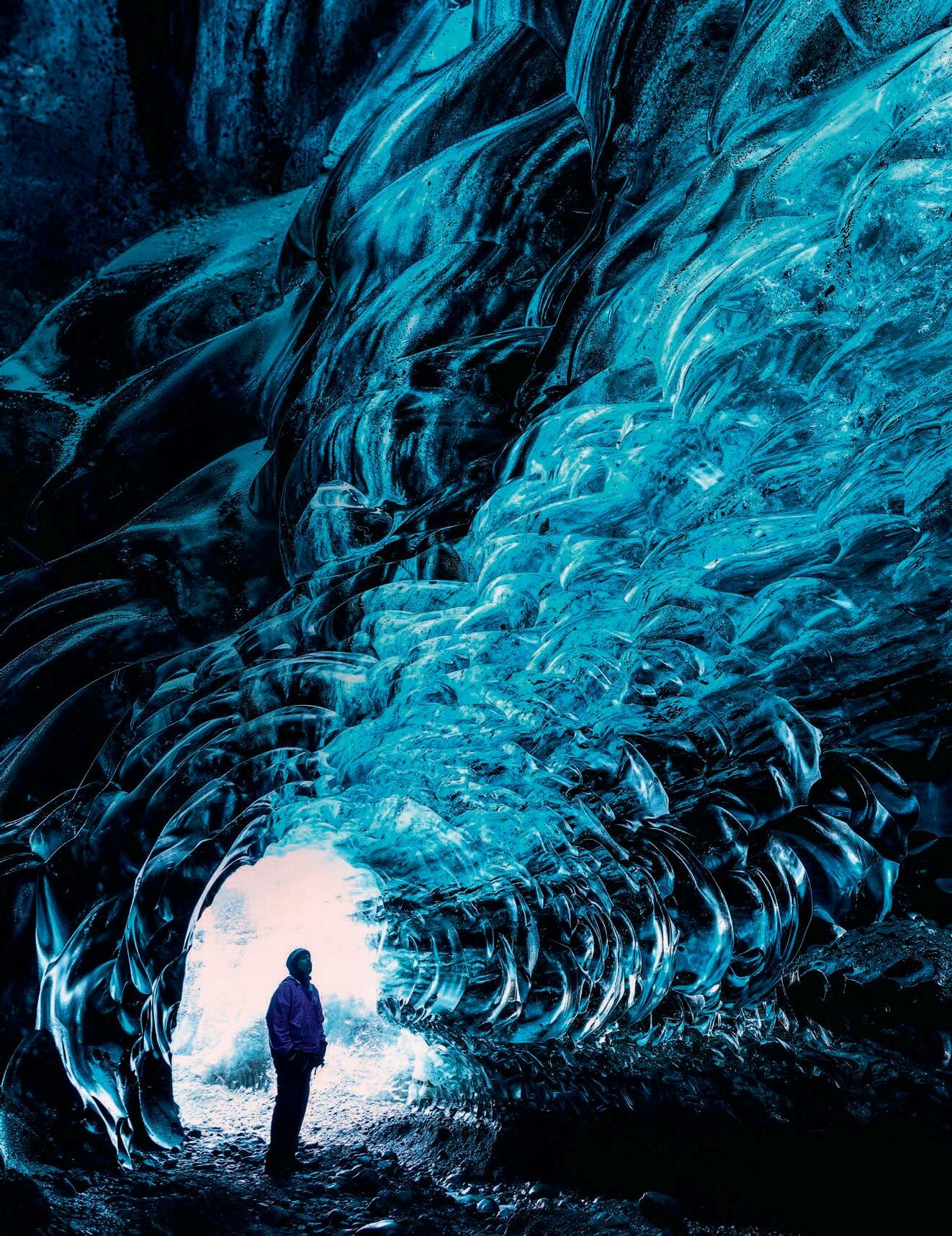
Don’t hibernate! It might be chilly, but there’s a whole world of adventures that are just perfect at this time of year, from hand-fishing for salmon and spotting polar bear cubs to sleeping under a tongue of ice
Words Gareth Clark
Grab some culture
a sake-soaked battle: the town’s young people (all aged 25) attack a hand-built wooden shrine defended by the town elders (all aged 42) – these ages are deemed unlucky in Japan. By the end of the night, the shrine has been burnt to cinders, the bad spirits dispelled and plenty more spirits have been drunk.
Watch sky lanterns in Taiwan
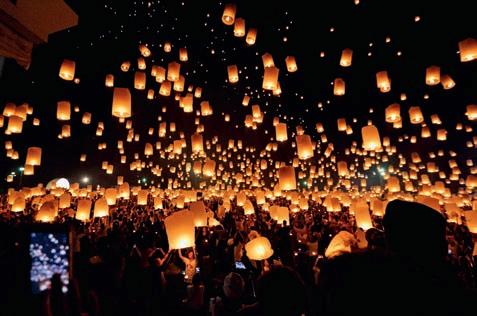
Dodge fireballs in Scotland

While Shetland plays host to the fiery Up Helly Aa festival every January, the little fishing town of Stonehaven, near Aberdeen, lights up just as spec tacularly for Hogmanay.The Fireball Ceremony sees locals swinging flaming wire cages parade the main street until the wee hours of 31 December. It likely emerged from superstition, as a way to burn away bad spirits so the fishermen would have good luck; today it’s a magnificent excuse for a party.
Join the fire wars of Japan

Locals start cutting wood for the Nozawa Onsen Fire Festival as early as October, though the 300-year-old event is actually held on 15 January.The highlight is

The 15th day of the first month in the lunar calendar (5 February 2023) sees the air aboveTaipei’s Pingxi district fill with flames. During the Lantern Festival, thousands of paper lanterns are released into the night sky, while revellers also
Fire and ice (clockwise from far left) Vatnajökull glacier covers eight percent of Iceland; it takes 100 villagers to build the shrine for the Nozawa festival; according to legend, sky lanterns were invented by a Chinese statesman in around 220 AD; Stonehaven’s ceremony begins as the old Town House bell chimes midnight

cruise the night markets and gorge on fried chicken (a local obsession!).
Meet the folk demons of Bulgaria
In Bulgaria the wearing of masks was once thought to provide protection from bad spirits and encourage a good harvest. Now, these old pagan beliefs and customs take on a more modern form in Pernik’s International Festival of Masquerade Games (late January). See locals roaming the streets wearing elaborate, monster-like costumes and performing the ritual kukeri dance, in order to chase evil away.
Float an ice river in Idaho, USA
No prizes for guessing what the Idaho town of Lava Hot Springs is famous for. Much of its Fire & Ice Winterfest (4–5 February 2023) focuses on the frozen aspect of these celebrations. You can drift down the Pontneuf River in an inner tube or join the locals sprinting the main street in their bathers to leap into the city fountain.Torchlit ski displays and plenty of time in the town’s thermal waters will warm you up later.
Alamy ⊲ ALTERNATIVE WINTER EXPERIENCES www.wanderlustmagazine.com 135
Wild winter sightings
Glimpse polar bear cubs in Canada

In late February the first newborn polar bear cubs start emerging from their burrows in Manitoba’s Wapusk NP, one of the world’s largest polar bear maternity denning areas. Join a safari from a lodge near Chesnaye to be one of only a handful of visitors to see the mothers urging on their newborns and tumbling about in the snow.You may also see the northern lights.
Spot one-horned rhino in Nepal

The best time to visit Chitwan NP is between November and January, when the weather is dry, days are still warm and the skies are clear. During this period, Jeep and walking safaris will likely yield incredible sightings of one-horned rhino, a creature that was almost wiped out here in the 1960s, but has made an incredible comeback. Though still battling for survival, the population is now up to about 700.
Track grey wolves in Poland
One of the key places for spotting grey wolves in Poland during the winter months is in the country’s east, in a pocket of the Carpathians known by locals as the ‘mountains of the wolf’. As well as wolf packs, the area is also home to lynx, bears and herds of bison. Photography tours brave the cold, using small, well-placed hides to try to capture the wolves on camera as they hunt in ever more cunning ways.
Wild winters (clockwise from left)
There are fewer than 4,000 one-horned rhino left in the wild; polar bear cubs are just 30cm long when first born; it’s not known where Kasanka’s fruit bats spend the rest of the year, though they are known to come from the Congo rainforest
See Africa’s largest migration in Zambia
Think African great migrations are all about the Mara and Serengeti? Actually, the world’s largest mammal migration takes place between late October and mid-December, as 10 million strawcoloured fruit bats arrive in Zambia’s Kasanka NP to feed on the bounty of fruits that appear with the first rains. Head out on safaris at dawn and dusk for the best chance to see the bats, which are so numerous they black-out the skies.

136 December 2022/January 2023
Spend a night in the cold
Cosy up for the night in a glacier in Iceland
For something seriously cool, fall asleep beneath Europe’s largest glacier. It’s possible to stay overnight in a 100mlong ice cave inside Vatnajökull.You’ll need to hike to get there, though usually no more than a few kilometres.Thick mattresses and Arctic-rated sleeping bags are provided (temperatures will be below 0ºC). But the best moment comes in the morning, when you wake up to an impossibly blue ice ceiling overhead.
Sleep in an ice palace in Canada

North America’s only ice hotel, Hôtel de Glace, is rebuilt just north of Québec City every winter (January–March). Around 30,000 tonnes of snow go into

its creation, and it’s unabashedly grand. There’s usually an ice bar, a grand hall, a chapel, about 40 rooms and an enormous slide – just in case you thought the idea of a hotel made of ice wasn’t quite fun enough.
Build your own igloo in Switzerland

There is no shortage of snowy fun to be had around Grindelwald, which sits below the Eiger’s north face, amid the Bernese Alps. Cross-country skiers and snowshoers flock here in winter. However, one of the village’s lesser-sung activities is igloo building (available December–April). Spend a half-day cutting snow blocks and building a dome before crawling inside to check out your creation.
Ice magic (clockwise from top right) Snow makes a good building material as the air pockets inside act as an insulator; Romania’s Hotel of Ice has an ice church and an ice bar; the rooms at Québec’s Hôtel de Glace are a cool -5°C
Bed down on Patagonian ice fields in Argentina
If ice hotels are too passé for you, then how about a night on the Southern Patagonian Ice Field, a frozen wilderness spanning around 13,000 sq km? Guided treks across the glaciers of Argentina’s Los Glaciares NP are available October to March; hikers must wear crampons, and are roped together in case the ice breaks. But arriving on Glacier Marconi to overnight in huts or wild camp on the ice field makes it worth the effort.
Snooze on a Transylvanian lake in Romania
Every year, the glacial waters of Lake Bâlea, high in the Făgăraș mountains of the Southern Carpathians, freeze solid enough to build Romania’s Hotel of Ice (December-April). It’s more rustic than many of the snowy retreats you find in other countries. But the surroundings are spectacular, as is the cablecar ride to get there. Activities include ice climbing trips, snowmobiling and 14km of ski slopes on your doorstep.
Alamy; Shutterstock ⊲ ALTERNATIVE WINTER EXPERIENCES www.wanderlustmagazine.com 137
Cold-weather soaks

Get steamy in Germany
Nature, culture and winter decadence meet in elegant Baden-Baden. This Black Forest town is full of grand, colonnaded townhouses, Art Nouveau villas and, of course, baths (baden means ‘to bathe’ after all).The huge Caracalla Spa complex has a contemporary feel while the Friedrichsbad Spa is a masterpiece of 19th-century Neo-Renaissance grandeur, sitting on the site of the original Roman baths – you can explore the ruins after you’ve taken a soak.
Steaming season (clockwise from left) The full bathing programme at Friedrichsbad has 17 stages, including a dip in the domed Kuppelbad; Latvians are keen on drinking herbal tea after their saunas; the waters of Lake Hévíz are alleged to be beneficial for those with rheumatic disorders
Sample pirts in Latvia
Pirts are traditional Latvian saunas, similar to those found in Scandinavia but smaller and usually accompanied by hot tea. It’s not uncommon to rent mobile pirts for use at the beach, so you can jump into the cold sea afterwards. There’s even a floating glass version in capital Riga: drink tea on the rooftop, sit in the hot tub, enjoy a long steam then take a dip in the Daugava River –in winter, a hole is cut in the ice.
Warm your bones in New Mexico, USA
Few spa settings can match that of Riverbend Hot Springs in New Mexico’s Truth or Consequences. The town, formerly known as Hot Springs, was renamed in 1950 for a radio phone-in competition (it stuck); Riverbend is its only resort sitting directly where the Rio Grande curves. Submerge in the thermal pools and enjoy views of snowcapped mountains appearing through the steam.
Swim in a thermal lake in Hungary

As the temperatures plummet in Budapest, residents flock to the city’s many beautiful bathhouses, jostling for their own bit of steamy space. But to escape the throng, head west to Hévíz instead. At 46,350 square metres, it’s the largest swimmable thermal lake in the world, so there’s always plenty of room to stretch out, and even on the coldest winter days it’s still a toasty 24ºC at the surface.

138 December 2022/January 2023
Shop for a festive treat

Wander wine cellars in Germany
At the dawn of the 20th century, the twin town of Traben-Trarbach, on the Moselle River, was the second-largest transit hub for wine in the world, behind only Bordeaux. Consequently, a huge network of cellars was built beneath the city centre. These now host a wine-themed night market between late November and January, when mulled concoctions and roasted almonds scent the tunnels.
Be enchanted in France

The northern city of Arras has two big claims to fame. First, a branch of the Louvre Museum sits just outside it; second, it hosts one of the country’s most enchanting Christmas markets. From late November to Christmas Eve, a winter wonderland crops up beneath the magnificent gabled buildings of the Grand’Place. Look for Hauts-deFrance specialties such as local sweets, honey and chicory conserves.
Go cave browsing in Belgium
A few Christmas cave markets can be found across Europe; the one in (and under) Valkenburg, in the Netherlands, is perhaps the best known. But a cuter option is the market held at the 2,000-year-old Caves of Wonck, 25km north of Liège.The caves, used as a bomb shelter during the Second World War, are now mostly used to grow mushrooms. For one weekend in December, however, they fill with artisanal stalls selling festive speculoos biscuits and locally made knick knacks.
Christmas-villes (clockwise from top) The Marché de Noël in Arras is the biggest in the Hautsde-France region; the Michigan town of Frankenmuth also hosts an annual Oktoberfest; Leiden has 28km of waterways and 88 bridges; Traben and Trarbach were two separate villages on opposite sides of the Moselle but are now an officially unified town
Buy Bavarian in Michigan, USA
Lots of cities have German-style markets, but the one in Frankenmuth – Michigan’s ‘Little Bavaria’– isn’t the usual festive cosplay. The residents of this US town still spoke German until the mid-20th century, and its Christ Kindl Markt (held late November and early December) is an authentic immersion in that unexpected heritage.
Hit the mountain market, Switzerland
The title of ‘highest Christmas market’ goes to Lucerne’s 2,132m Mount Pilatus event. A cogwheel railway or gondola ride to the summit sets expectations high (literally). At the top, a restaurant and hotel complex is the setting for a 40-stall market in late November, complete with a backdrop of Lake Lucerne’s turquoise waters and the snow-capped Emmental Alps.

Shop aboard, Netherlands
The 17th-century canals of Leiden form the perfect setting for one of Europe’s few floating Christmas markets. Usually around 100 fairylight-strewn chalets bob on the water in December, sell ing a festive mix of jewellery, toys and sugary oliebollen (Dutch-style doughnuts).There are also live performances held on a small floating stage and ice rink on a giant barge.

Alamy; Shutterstock ALTERNATIVE WINTER EXPERIENCES www.wanderlustmagazine.com 139
⊲
Tasting season
Catch your dinner in South Korea
Few winter events are quite as foodie focused as South Korea’s Hwacheon Sancheoneo Ice Festival (JanuaryFebruary). Ice-sculpting, skating and sledding all play second fiddle to fishing as thousands of locals perch by ice holes with baited lines or wade into freezing pools to try to catch the coveted sancheoneo (masu salmon) by hand. Many cook them up on the spot.

Dine high among Colorado’s peaks, USA
Alpino Vino – at 3,627m, America’s highest fine-dining restaurant – only opens its doors December to April. Perched up in Colorado’s Telluride Ski Resort, even reaching it is tricky.
The only way in by day is via a narrow ski trail; by night, a heated snowcoach takes over. However, it’s worth it to bag yourself a place by the fire and an Alpine-themed feast.
Food for thought (clockwise from left) Hwacheoncheon, only 1.5 hours from Seoul, is a popular winter outing; the Klein Matterhorn is 7km from its bigger, 4,478m-high namesake; there’s a definite European flavour to the food at Colorado’s Alpino Vino restaurant
Hit culinary heights in Switzerland
What better appetiser is there than gazing out over 14 glaciers from the summit of the Klein Matterhorn?

From Zermatt, a gondola ascends to the icy peak, where Europe’s highest restaurant awaits.You could opt to eat on the way up – fondues and breakfasts can sometimes be served in the cablecar, on request. But little beats devouring your spätzle at 3,883m.

Savour a full-moon dinner in Austria
Austria’s Hohe Tauern NP is a spectacular sweep of snowy peaks and frozen meadows. And it can be even more dramatic by moonlight. On select dates (5 February, 7 March 2023), a spot 1,590m up in the park’s Gastein Valley hosts a full-moon dinner party. A long table is laid out on the snow, benches are covered in blankets and furs, and delicious dishes are served under the stars.
Taste ice wine in Luxembourg
Winter’s sweetest gift is eiswein (ice wine), harvested when temperatures drop low enough for the grapes to freeze.This uber-sugary dessert wine is a specialty of Germany and Canada, but it is also found in the Moselle region of Luxembourg, where the river is lined with vineyards. One of the best places to sample a drop is in Caves St-Martin in Remich, where you can tour the cellars too.
140 December 2022/January 2023
Seasonal celebrations
Spend Christmas in Asheville, USA

Snowy mountains? Check. A candlelit country estate? Certainly. Breweries, vineyards and backcountry hiking and skiing? Of course.This isn’t France, but North Carolina’s mountain town of Asheville.The twisting drive up the Blue Ridge Parkway to get there is superb; the Art Deco streets strung with twinkling lights are magical.Visit the market and drop by the festively decorated Biltmore Estate, America’s largest home.
Brave Krampus in England

Winter parades of Krampus – a halfgoat creature said to punish naughty children – are common across Austria and Germany, where stories date back to pagan times. But they have crept into other cultures, too. NorthYorkshire’s Whitby Krampus Run (4 December) is a natural fit for a coastal town that has its share of Gothic vibes (Bram Stoker’s Dracula landed here). A tradition that began with a few friends now even has its own Krampus Ball (3 December).
Festive fun (clockwise from far left) The 250-room Biltmore Estate was built for George Vanderbilt in 1895; the Whitby Krampus Run only started in 2013; bears are considered a symbol of good luck in Romania; during Lohri, a bonfire is lit at sunset in the main village square and locals make offerings and prayers around it
Sling an egg in Spain
The Day of the Holy Innocents (28 December) remembers the biblical tale of King Herod ordering all the male children around Bethlehem to be killed. Over the years, however, this solemn occasion has flipped to a day of pranks and celebration in Spain, similar to April Fool’s Day. In the Alicante town of Ibi it has even become a full-on food fight, with flour and eggs the weapons of choice. No one is safe!
Bid goodbye to winter in India
The Punjabi festival of Lohri (13 January) marks the passing of the shortest day and the start of the winter harvest season. Locals light bonfires – symbolising the return of the sun – around which they sing, chant and throw offerings such as sweets, puffed rice and sesame seeds.The celebrations are most colourful in the north Indian states of Punjab, Haryana and Delhi.

See in New Year with new bears in Romania
Romania offers the chance to see out the year in the company of ‘bears’. On 30 December the Festival of Customs and Ancestors’ Customs in the northeastern town of Comănești sees locals dress in bear costumes, a relic of the days when Roma would visit with bears on leashes to chase away bad spirits. In the absence of real animals these days (dancing bears are now illegal in Europe), people play the part, dancing and being ceremonially killed and brought back to life to a deafening drum beat.

Alamy; Shutterstock ALTERNATIVE WINTER EXPERIENCES www.wanderlustmagazine.com 141
⊲
Icy adventures
Ski a volcano in Japan
Sapporo makes an excellent base for anyone wanting to ski Hokkaido’s volcanoes. MountYotei (1,898m), a 90km drive south-west of the city, is perhaps the star attraction.The hike up is pretty strenuous and requires a guide – many opt for heli-skiing visits instead – but once you get to the top it’s one of few places in the world where you can ski into the crater of a semi-active volcano. Unforgettable.


Snowshoe the hoodoos of Utah, USA
Bryce Canyon isn’t what you think of when you picture a winter landscape. The Utah national park’s Mars-like high-desert is usually pictured baking under a hot sun.Yet a crisp coating of
snow lends Bryce’s red-rock hoodoos (spires) an otherworldly look. While fewer facilities, roads and trails open in the park over the colder months, snowshoeing is popular here and atmospheric ranger-led full-moon hikes run year-round.
Trek glaciers in New Zealand Hiking any glacier puts you in a world where humans just aren’t meant to be. That’s what’s so thrilling. New Zealand has almost 3,000 of these icy tongues, with the west-coast glaciers of Fox and Franz Josef especially well set up for hiking and heli-hiking tours. However, to really get away from it all, head to Aoraki/Mount Cook National Park for close-ups with the Tasman Glacier – at 29km, the longest in the country.
Sail frozen lakes in Lithuania
In winter, Lithuania’s Curonian Lagoon transforms into a frozen sea of colourful sails. Ice-boating is taken seriously here – that is, the sport of tacking across the frosted surface on reclining windsurf-sled type vessels.The ice needs to be at least 10cm thick and the wind speed around 3-4 m/s. Once conditions (usually January to March) are cold enough, you’re good to go.
Explore the alternative Pyrenees in Andorra
Tiny Andorra isn’t everyone’s first idea of a winter escape, but this rocky slice of the Pyrenees (average elevation: 2,000m) is full of thrills.The ski resort of Grandvalira yields plenty of downhill pistes and snowshoe and dog-sled adventures, plus the chance to snowmobile through the Moretó forest. End active days with hearty dinners in traditional bordes (converted grain stores) and nights at a private ski-in dome suite, perched 2,300m up in the mountains.
 Snow business (clockwise from left) Mount Yotei means ‘sheep-hoof’ mountain; Grandvalira, in little Andorra, is the biggest ski resort in southern Europe; 12km-long Franz Josef Glacier plunges from the Southern Alps to less than 300m above sea level
Snow business (clockwise from left) Mount Yotei means ‘sheep-hoof’ mountain; Grandvalira, in little Andorra, is the biggest ski resort in southern Europe; 12km-long Franz Josef Glacier plunges from the Southern Alps to less than 300m above sea level
Alamy; Shutterstock 142 December 2022/January 2023
Alternative aurora
The northern lights are typically visible between October and the end of March, with the long, dark winter months best for sightings – particularly north of the Arctic Circle. But there are many unique ways to see this phenomenon…

Experience a wild aurora in Finland

Just craning you neck upwards is too easy; the wilderness hotels of Finnish Lapland make you work for a sighting. Try dog-sledding out into the boreal forests beneath the green glow of the lights, returning to spend the night in your own glass-bubble dome. Or maybe take a snowmobile safari around the frozen shores of Lake Inari to camp under some of the darkest skies in Europe as the aurora ripples overhead.
Spy the aurora in the UK
You don’t need to be above the 66th parallel for a clear sighting of the lights.You can even see them in Britain, though it pays to head to Scotland and, even better, specifically
to the Shetland isle of Unst, the northernmost inhabited part of the UK. Best of all, if you time your visit for January, you could also catch the Viking-inspired Up Helly Aa festival in Lerwick on Mainland.
Sail beneath the lights in Norway
There are small-boat cruises around northern Norway’s fjords (carrying 100 or so people) and then there are seriously small ones, like sailing from Tromsø in a four-cabin catamaran. Do this in winter for a more intimate take on the icy Arctic. Spot orca and humpbacks by day and aurora by night – onboard guides will offer photography advice. You might learn a few sailing tricks along the way too.
Light fantastic (clockwise from top) In the right season the aurora can be seen at any time, once skies are dark, but the optimum hours tend to be between 9pm and 1am; the indigenous tribes of Montana have used the night skies for millennia to help chart and gauge their seasonal movements
Glimpse glaciers and lights in Montana, USA
It might be below the Arctic Circle, but the state of Montana has one of the lowest population densities in the US –just seven people per square mile – so light pollution barely registers there.This makes it a good spot for aurora hunters and stargazers. Glacier NP, a certified Dark Sky spot, is particularly popular: you might even get to see the aurora reflected in the waters of Lake McDonald, a truly out-of-this-world sight.
ALTERNATIVE WINTER EXPERIENCES www.wanderlustmagazine.com 143
⊲
Frozen journeys

Try tour skating in the Netherlands
The Netherlands’ Elfstedentocht is the biggest ice-skating tour in the world, an almost 200km circuit on frozen canals, rivers and lakes via the 11 historic cities of Friesland. However, it requires very thick ice in order to go ahead; the first event was in 1909 but it’s only been held 15 times (the last was in 1997). Even if it’s not on, it’s still fun to wander the canals of Leeuwarden (the start of the race) – and you can always practise your moves in the city’s Elfstedenhal ice rink instead.
Drive the ice roads of Canada

It’s only around January that the ice roads of Canada’s NorthwestTerritories are typically suitable for vehicles (the ice must be 40cm thick).These frozen highways link a number of Canada’s far-flung, remote and largely Indige nous communities. Some routes have been paved in recent years, but the ice road to the Inuvialuit community of Aklavik, where 600 residents live on the Mackenzie Delta, still offers the only way in or out for visitors and locals in winter – and an incredible journey.
Taking the long road (clockwise from top) The Elfstedentocht is in danger of becoming extinct due to climate change – it has only occurred three times in the past 50 years; there are no huts along the Catamount Trail, but it has been completed in as few as 20 days by skiers towing sleds and camping kit; Canada’s ice roads are usually drivable from January to April
Ski Vermont’s Nordic monster, USA

Vermont’s CatamountTrail (480km) is the longest Nordic skiing route in North America, stretching from the state’s border with Massachusetts right up to Canada. Chances are slight that you would do it all in one go – in 40 years, just 105 people have. But the trail is divided into 31 segments, which can be done in single-day tours – a good way to get a taster and find your feet in the New England snow.
Travel across the Arctic Circle, Norway & Sweden
There’s nothing like crossing a global landmark to add extra spice to a journey.The Nordland is the longest rail route in Norway (729km), and hops into the Arctic Circle as it trundles from Trondheim to Bodø. Or take the Arctic CircleTrain, which runs between Stockholm (Sweden) and Narvik (Norway) in the far-north, with a change in Kiruna – a town that had to be moved to stop it collapsing into a mine.Take the sleeper from the Swedish capital for the thrill of waking up in a frozen world.
Visit the other Antarctic
While western Antarctica is busy with cruise ships from Novem ber to March, the east is only really accessible in January and February. Cruises to this side run from New Zealand and Australia, and must deal with the icy Ross Sea; they are also a minimum of a month long, making this the far less common route to reach the White Continent. Along the way lie penguin-crowded islands, huge ice cliffs and historic reminders of the explorers of the Heroic Age.
144 December 2022/January 2023
Cultural encounters
Explore Alaska’s Indigenous cities, USA

Remote Alaskan communities such as the Iñupiat of Utqiagvik (formerly Barrow), the northernmost town in the US, are all but impossible to reach in winter. But the Native Heritage Center in Anchorage offers cultural information and experiences to help broaden your knowledge of Alaska’s indigenous culture.Visit Ketchikan to explore the town with Indigenous artists and see the world’s largest collection of totem poles. Then head to Sitka National Historical Park, which is an important site for the Tlingit community.
Join Sámi herders in Norway and Finland

The Sámi reindeer herders of Lapland still migrate alongside their animals each year, moving them between summer and winter pastures.Winter encounters with the Sámi in northern Norway and Finland typically include sledding out to where the animals live, sleeping in traditional lavvu (tents), dining on foods like smoked reindeer meat and berries, and listening to traditional stories. It’s fascinating to learn how this way of life survives in the modern world.
Discover Inuit history in Greenland
It is easy to encounter Greenland’s Indigenous peoples. Almost 90% of the island’s population is Inuit. Even in more cosmopolitan Nuuk (see p182), the capital, native guides can help you discover local culture amid the Danish developments. In icy Ilulissat go on a dog-sledding trip for a taste of traditional life, then visit SermermiutValley to see the remains of Inuit settlements dating back 4,000 years.Visit from late January, when the days are lengthening, to maximise your time.

Meet the First Nations people of the far north, Canada
Winter’s tales (clockwise from left) Ketchikan is home to over 80 totem poles; Greenlanders have been using dog sleds for more than 4,000 years, and they are still a key part of their culture; Sami traditions are under threat from climate change and urbanisation
Canada’s northernmost region, Nunavik, is about the size of France yet home to just 14 towns. Kuujjuaq, on Ungava Bay, is the largest, with a population of just 2,400 people. The best way to explore this vastness is with an Inuit guide.Tours will likely include visits to parks where vast herds of caribou roam, dog-sled trips, chances to meet local artists, chats with elders about life on the Arctic fringes and the traditions that still survive here, and (with luck) sightings of the northern lights.
Alamy; AWL Images ⊲ ALTERNATIVE WINTER EXPERIENCES www.wanderlustmagazine.com 145
Seasonal city breaks
Get that festive feeling in Croatia
There are few sights more fairytale than Croatia’s Plitviče Lakes covered in snow. Following the walkway through the park is like entering a watery Narnia, where the cascades, frozen in mid-air, are fringed by icy forest.To visit, base yourself in nearby Zadar.The coastal city hosts a sparkling Christmas market (late November to January), where stalls selling peppery paprenjaci biscuits pop up on the streets and squares. However, strolling the Upper Town without the usual summer crowds might be the best Christmas gift of all.

Escape to the medieval north of France
The Normandy city of Rouen, on the banks of the Seine, strikes a Gothic pose – the writer Victor Hugo called it the city of ‘a hundred spires’. In winter it becomes extra atmospheric, with the narrow lanes of the medieval quarter aglow with festive lights, stalls selling mulled wine and cider, and a Christ mas market on the square in front of the immense cathedral. It’s also a stop on cruises along the Seine from Paris, a magical way to view the frosty Normandy countryside.
Embrace cultured New Mexico, USA
Santa Fe, New Mexico’s mini state capital, charms at any time; come winter, as the surrounding Sangre de Cristo Mountains whiten and the nearby
national forest fills with Nordic skiers, it truly shines.The city itself never gets too cold, and has plenty of spas to warm you up anyway (seek out the ryokan-styleTen Thousand Waves). Beer lovers should visit in January forWinterBrew,while the sacred Las Posadas candlelit procession around Santa Fe plaza (8 December) shows the city in a different light.
Go city hopping in Estonia

Tallinn’s chocolate-box vibe is only amplified by a light dusting of snow. Its Christmas market is a particular delight, fanning out across the cobbles of its old centre, beneath the Gothic arches of the town hall. But don’t stop there. Combine the capital with a visit to Tartu, Estonia’s second-city, whose 18th-century buildings escaped Soviet scrutiny to offer an elegant alternative to Tallinn’s medieval grit. Best of all, Tartu is close to Lake Peipus where, in winter, you can drive on ice roads, go ice fishing and ice skating, and visit a tiny island reserve.
The real Narnia (clockwise from top) The 16 lakes at Plitviče National Park are interconnected by a series of waterfalls; if you’re chilly in Tallinn, seek out a dram of Vana Tallinn, a spice-infused liqueur invented here in the 1960s, which is delicious drunk hot or poured into coffee
Escape to Mallorca, Spain
The reputation of Mallorca as a summer beach retreat does it a disservice.There’s more to the island than that, not least capital Palma,which is a handsome hub of 13th-century streets,Gothic churches, Arab baths, fine galleries and elegant squares. In winter, with much of the island shut down, it takes on a different air entirely. Also, with temperatures still on the mild side, the low season opens up Mallorca’s potential as a magnificent walking destination too.
Discover the Roman seaside in Italy
There can be something glorious about a seaside town in winter.Take Gaeta, located on a dramatic prom ontory between Rome and Naples on the Ulysses Riviera. Dubbed the ‘City of a Hundred Churches’, it was once a summer playground for well-to-do Ancient Romans; the remains of their villas can still be seen scattering its fringes and they lose little of their impact in the winter months, when the crowds are scarce and the town’s cobbled streets take on an appropriately pious feel.
See Florida’s wild cites, USA
The shallow waterways around Crystal River, north ofTampa, are extra special from November to April. Balmy yearround, they’re a perfect winter refuge for large numbers of manatees. It’s also the only place in Florida where you’re allowed to swim with these gentle giants. Alternatively, head for the beaches, lively food scene and Art Deco neighbourhoods of Miami.This city is a fine base for exploring the Everglades at a time when milder temperatures see fewer mosquitoes and crowds, but a huge influx of migratory birds.
Get cultured in Switzerland
In winter many travellers make for the Alpine lakes and mountains of Switzerland’s beautiful Bernese Oberland. But the northern city of Basel offers a more cultured side to the country at this time of year.You’ll find Christmas markets and plenty of architectural gems, from the OldTown’s Blue andWhite Houses to uber-modern showpieces. By February, carnival season has taken hold, with parades, guggenmusik (masked marching bands) and an air of joyous chaos filling the streets.
Alamy
146 December 2022/January 2023 ALTERNATIVE WINTER ADVENTURES



















UNCOVERING NAMIBIA’S LESSER-KNOWN SOUTH

5 HIDDEN HIGHLIGHTS
Namibia’s northern wonders often hog the limelight, but the country’s lesserknown southern reaches have plenty of natural drama. This is where the Namib meets the Kalahari; where the widescreen landscapes feel even larger thanks to the lack of crowds; and where superlatives rule supreme. Namibia’s south is home to both Africa’s biggest canyon and the world’s tallest sand dunes. Some of this dramatic scenery even spills over the border into South Africa, but southern Namibia has plenty in the way of cultural experiences, wildlife encounters and mesmerising vistas that will make your jaw hang as wide as the landscapes themselves. Here are five of its secret gems that are well worth exploring.
Sandy sights (top–bottom) Sossusvlei’s sand dunes are best seen at sunrise from a hot air balloon; Kolmanskop was once a thriving mining community but is now being reclaimed by the desert
1. SOSSUSVLEI
The cloud-baiting dunes of Sossusvlei reach nearly 400m high and are perhaps the Namib Desert at its most dramatic. These dunes have had plenty of time to grow – around 55 million years – and to truly appreciate their colossal nature you need to clamber up one. The aptly named Big Daddy is the tallest, and the hour it takes to summit rewards you with panoramas of rippling sand. Seeing it at different times of the day even changes the way it looks: golden and toffeecoloured in the afternoon; dusty-rose and purple come dusk. One of the best times to spy this phenomenon is at first light in a hot air balloon, when you can watch the sunrise cast an apricot glow over this ancient landscape. It feels eerily desolate but isn’t completely empty, as a guided nature walk will prove. Here you can see everything from ostriches and brown
2. LÜDERITZ AND THE KOLMANSKOP GHOST TOWN
Pinned between the Namib Desert and the Atlantic Ocean, the isolation that the formerly German colonial town of Lüderitz enjoys means its Art Nouveau architecture has been left alone by the 21st century. Its village-like atmosphere and historic buildings are a joy to wander, while Easter sees the town transformed for its annual Crayfish Festival. This vibrant celebration is a display of the area’s rich marine life – something you can explore further with a visit to see the African penguin colony on nearby Halifax

148 December 2022/January 2023
hyenas to the tiny tracks of toktokkie beetles.
Island or on boat tours to spy Heaviside’s dolphins. Make your way along the sands of the Namib and you might spot wild horses roaming the desert before stumbling upon Kolmanskop. This ghost town was built on the area’s diamondmining fortunes but was completely abandoned by the 1950s. To see this once-thriving village, which had its own theatre and bowling alley, now totally engulfed by sand is starkly surreal.

3. TSAU//KHAEB (SPERRGEBIET)
NATIONAL PARK
For over 100 years, since the first gemstone was unearthed here, the area of Tsau//Khaeb (Sperrgebiet) National Park was a hive of diamond-mining activity. It was also off-limits to visitors – sperrgebiet means ‘prohibited area’ in German – but that’s slowly changing. Tourism concessions are now granting long-awaited access to this pristine wilderness’ swirling rock formations and meteor craters.
There are plenty of highlights to see. The Bogenfels Rock Arch rises 55m above the salty waves, while the rusting Barge 77 shipwreck is all that is left of the mobile diamond processing plant created by Texan oilman Sammy Collins. He thought that if there are diamonds on shore, they must be off-shore, too. But his mission failed, and the ship capsized in the early 1960s after a storm.

Tsau Khaeb isn’t all about barren desertscapes; it’s also one of the world’s top biodiverse hotspots, and around a quarter of Namibia’s species of flora are found here. Wildlife is particularly bountiful in Baker’s Bay, home to Namibia’s southernmost fur seal colony, brown hyenas and African penguins.

4. ORANJEMUND

On the face of it, Oranjemund is just another one of Namibia’s successful diamond-mining towns, cast way out in the deep south. It was founded in the 1930s to harvest the diamond deposits found in the Orange River, but for nearly 80 years this town was closed off to outsiders and managed by Namdeb, half of which is owned by the Namibian government and the other half by private company De Beers. It became something of an enigma until 2017, when its secrets were spilled and its doors opened to the world. What lies within has been worth the wait.
Escape the crowds (clockwise from top left) Watch jackals in the wild; Namibia’s Fish River Canyon is second in size only to the USA’s Grand Canyon; Oranjemund only reopened to visitors in 2017; The Bogenfels Rock Arch is 55 metres high
Vibrant street murals now splash across Oranjemund, championing Namibian artists and the quaint Jasper House Museum, which not only charts the evolution of this old mining town but explores the natural history of its surrounding national park. Oranjemund comes alive every month with a night market showcasing food and crafts fashioned by its locals. It also has its wild side. You can spy oryx nibbling on the town’s bushes and flower-filled gardens, while the mouth of the nearby Orange River is a wetland teeming with some 10,000 birds, including Damara terns, African hoopoes, spoonbills and more.
5. FISH RIVER CANYON
Namibia’s south still has one more surprise up its sleeve: Fish River Canyon. This gargantuan landscape is the world’s second-largest canyon and often feels like it might be more at home on Mars. At 160km long, 27km wide and up to 550m deep, you can get a sense of its rugged expanse just by peering over its edge, but this is a phenomenon that deserves the whole hog. For that, embark on a five-day hike where you descend into the canyon’s belly and trek the riverbed to its conclusion (there’s no other way out). It’s the ultimate finale for any adventure through southern Namibia.

PROMOTIONAL FEATURE www.wanderlustmagazine.com 149For more information, go to: visitnamibia.com.na
Ronel van der Merwe; Shutterstock

































NEW FOR 2023 The shortlisted images from this prestigious photography competition will be on display at both shows in a stunning gallery. The winners will be announced at the London show on February 3rd. CAPTIVATING SPEAKER LINE-UP LOVE PHOTOGRAPHY? Learn more from the professionals in the Travel Photography Masterclasses.
A history written in stone
The USA and Canada’s Great Lakes region is bigger and older than most countries. Now a newly launched cruise is squeezing its billions of years of geological history into just eight days
 Words Mark Jones
Words Mark Jones

The Great Lakes. Even its name conjures something vast and brooding.Yet my first encounter with a region that spans the US-Canada border showed it to be far from what I’d imagined. Its waters slid between a rich caramel and a deep turquoise colour, while chalky-white rocks dusted the shoreline.The landscape, like the sun, felt almost subtropical – it couldn’t have been any more perfect. In spite of this, I was about to leave it all behind as I squeezed inside a metal hatch that clanked shut above me, blocking out the surface world.
Inside the submarine, my Welsh helmsman, Aled, was in charge.The control panel lit up in front of him in a way that I had always imagined one might: like a cross between a supercomputer and some kind of electronic whack-a-mole. With a few flicks he equalised the pressure and we descended gently to the bottom of Lake Huron – one of the shallower lakes in the region but still deeper than 200 metres in places.
Beneath the water’s surface, the tropical overtones faded. There are shipwrecks to be found in this area, but not here; and as I peered out of the window during my ten-minute ‘voyage’, I saw little other than the swill of sediment and a few minnows. Yet it set the tone for a trip where I would find myself exploring the Lakes region in ways few others had.
I had signed up to be among the first people aboardViking’s newest cruise ship as it embarked on its inaugural tour of the Great Lakes. Here lie some of the largest bodies of fresh water on the planet; places where the cognitive difference between ‘lake’ and ‘sea’ disappears as quickly as the shoreline. And while taking a ship built to withstand Antarctic seas might seem like overkill, this was far more than just a quick jaunt.Taken together, the combined shorelines of lakes Michigan, Huron, Superior, Erie and Ontario stretch for over 15,000km.Their shared water basin is larger in size than the UK. So, when we were bussed from our downtown Milwaukee hotel to the quayside and I first glimpsed the Octantis, rising from Lake Michigan like a modernist boutique hotel with a Polar Class 6 hull, I could only smile.
Over the following week we made our way out of Lake Michigan and into Huron, exploring where Georgian Bay lies smuggled behind the largest freshwater island in the world.The final couple of days took us into Superior, the big daddy of the five lakes. By car – how most people travel the area – this journey would have taken weeks, but we crossed huge expanses in days, the Octantis’ slim design able to navigate canals and locks with ease. And as I learned more about the Great Lakes’ glacial beginnings, its wildlife and its colonial history, I started to realise why a cruise was the only way to experience them properly.
THINKING BIG
We were the sole vessel of our size in the area.There are no cargo ships or tankers on the Great Lakes. Aside from ourselves, we glimpsed only the occasional fishing boat or pleasure craft when the ship hugged close to the wooded shores and lakeside villages.We were a big fish in an even bigger pond, but we did have an evolutionary trick or two.
In the corner of our hangar was a filtration system designed to measure and report on the intrusion of microplastics into the lakes, and above it was a laboratory to process the information. Weather balloons were launched for the National Oceanic and Atmospheric Administration; wildlife and bird migration patterns were being studied. Cruise life and science seemed to go hand in hand – and that went for the passengers as well.
One night, I observed a man’s 60th birthday party in the ship’s Italian restaurant.The eight people around the table were doing their best to reverse the ageing process through wine and laughter. After dinner, I bumped into the birthday boy again, still cradling a glass of red; only this time he was sitting quietly with his friends in Aula, the ship’s on-board events space, as geochemist Dr Brandi Revels opened a presentation entitled, ‘Isotopes and What They Teach Us’. This wasn’t just a leisure cruise; we had come to learn.
Our journey began in Milwaukee, as the Octantis made its way up Lake Michigan to the US island of Mackinac (pronounced ‘Mack-in-awe’), where the waters of Lakes Huron and Michigan met like two giant wings stretching from America’s far north-east into Ontario, Canada. It was there that I got my first glimpse up close of lakeside life.
Mackinac crams a lot into its shores.The busy downtown was lined with shops selling T-shirts and fudge, while horse-drawn carriages took daytrippers up to the two main attractions: the British-built fort and the late-19th-century Grand Hotel, which looks like a cross between a Riviera palace and the White House.
This tiny spit of an island now bustles with tourists, but in the early 1800s it was fiercely fought over by British and American forces. Its position, as a gateway between lakes Superior and Huron, made it more than just another stop on the area’s once-busy fur trade routes, and it remained in British control more than 50 years after US independence was declared.The site of its most famous battlefield (when the British forces repelled US troops in 1814) might now be Michigan’s oldest golf course, but a visit to the well-preserved fort offers a tangible glimpse of this past. What you can’t do here is drive. Cars (except for emergency vehicles) are not allowed on Mackinac, but you can cycle. If you have the leg power, you can pedal the entire 13km perimeter of the island and still have time for a beer and a fish taco on the lakeside terrace atThe Pink Pony before the ship departs. From the landing stage we pedalled up the west coast, skimming past Arch Rock, a limestone formation that spans the forest 45 metres above the shore road. Hidden away from most visitors’ eyes was also a little wetlands trail that showed what an unusual island this was. Mackinac is an ecological transitional zone, meaning you can see plants you might encounter in, say, California, such as striped coralroot orchid, alongside northern species like the eccentrically named bastard toadflax.
ROCK OF AGES
It was mid-August, well after nesting and breeding season, yet above the tree canopy we still spied the odd red-tailed hawk from the ship.There were sizable colonies of double-
Previous spread: Alamy; this spread: Alamy, Viking
“In the corner of our hangar was a filtration system designed to measure and report on the intrusion of microplastics into the lakes“
⊲ 154 December 2022/January 2023
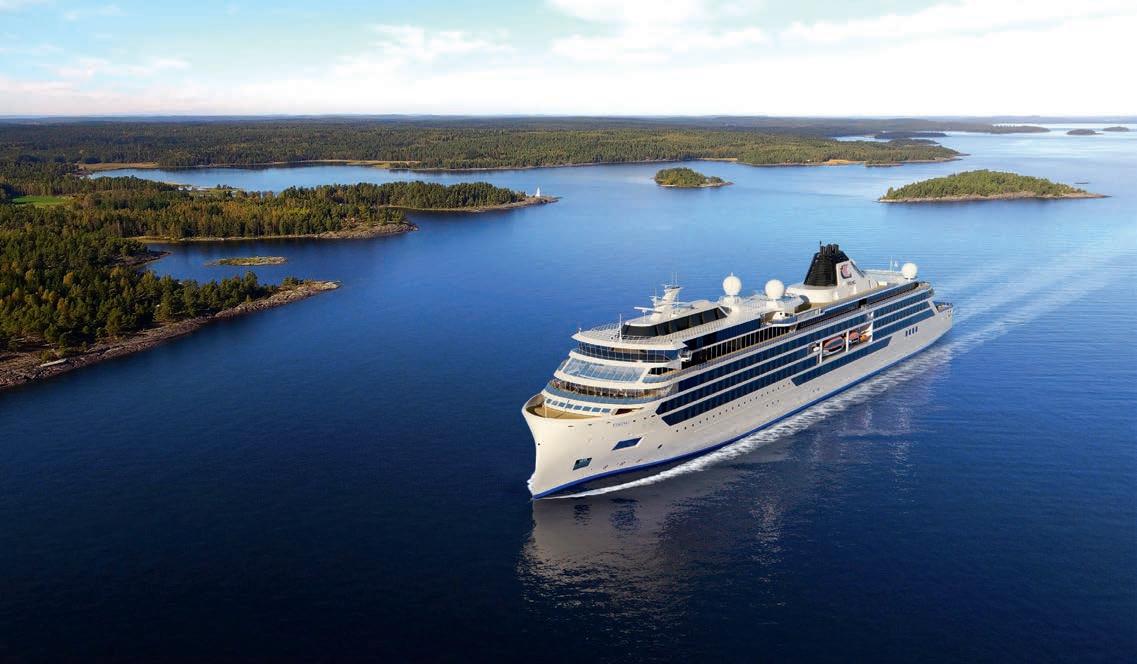
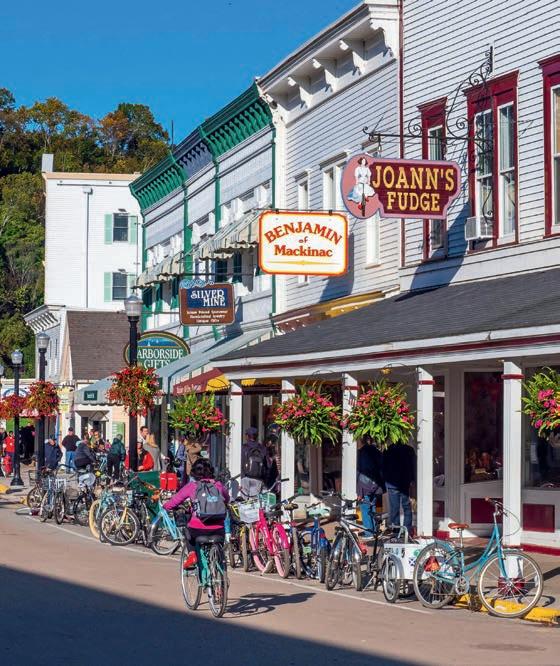

THE GREAT LAKES www.wanderlustmagazine.com 155
A cruise with a difference (clockwise from bottom) The expedition cruise ship Octantis has six decks, 189 staterooms and was launched in early 2022, having spent late winter in the Antarctic before taking the journey north to meet us; the Bruce Peninsula is where the rugged Niagara escarpment (of waterfall fame) divides the enormous Georgian Bay from the main body of Lake Huron; Mackinac Island’s Main Street is lined with bicycles because cars have been mostly banned there since the turn of the 20th century, after their noisy engines were deemed to spook the island’s horses; (previous spread) sunset over the Precambrian rock of Georgian Bay
crested cormorants too, though the latter, I was told, have a difficult relationship with locals. They were nearly wiped out here by the use of DDT insecticides on farms, then recovered in such large numbers as to threaten other bird species and fish stocks in the lakes. Their population is only now recovering from the most recent cull.
After the ship anchored at Georgian Bay, we took a Zodiac dinghy to where a strange yellow shape lay visible just above the waterline. This was John, the submarine that I later boarded.Viking had spent several million pounds on four wellequipped and very yellow submersibles. (The three others in the fleet are, inevitably, called Paul, George and Ringo.) They offered an opportunity for both marine biologists and passen gers to go poking around the waters, which can drop to over 400m in the deepest parts of Lake Superior. They were not, as far as I knew, commissioned to hunt for the Snow Wasset, a fearsome and legendary sea serpent which is said to inhabit these waters and can swallow ships whole.
Our next stop was Frazer Bay, on the Canadian shoreline of Lake Huron. It was here that a tanned, moustachioed man helped me into a Zodiac, arranged us all on the rubber seats, then gunned the engine, thrusting the boat out into the bay.
Our guide for the day was Dr Richard Bates, professor of applied geophysics at the University of St Andrews, whose main preoccupation was with the lakes’ geological history and climate. We cruised close to the near-vertical walls of rock, which rose no more than a few metres above the water’s edge. They were marked with horizontal fractures and topped with small pine trees, some of them burrowing at crazy angles as close to the water as they could get. Pines are the great invading armies of these landscapes, finding a niche wherever they can and then preventing other trees from growing.
As the boat chugged along, Dr Bates explained that we were looking at the Canadian Shield, an expanse of bedrock that covers much of Canada as well as Greenland and a chunk of the USA. It was “old,” he said. But if you have ever spoken to a geologist at any length, you will know that you need to readjust your sense of what that word means. The granite of the Canadian shield is Precambrian, the earliest (and longest) period in Earth’s history, beginning around 4.6 billion years ago. The rock we observed that morning, with its seams of feldspar glinting in the sun, was a comparative youngster at just 1.5 billion years old.
The journey these rocks had been on – dwelling deep underground, beneath seas and parts of continents that then formed, broke away and travelled from pole to pole – is scarcely imaginable. But the story of the Great Lakes themselves is no less dramatic.
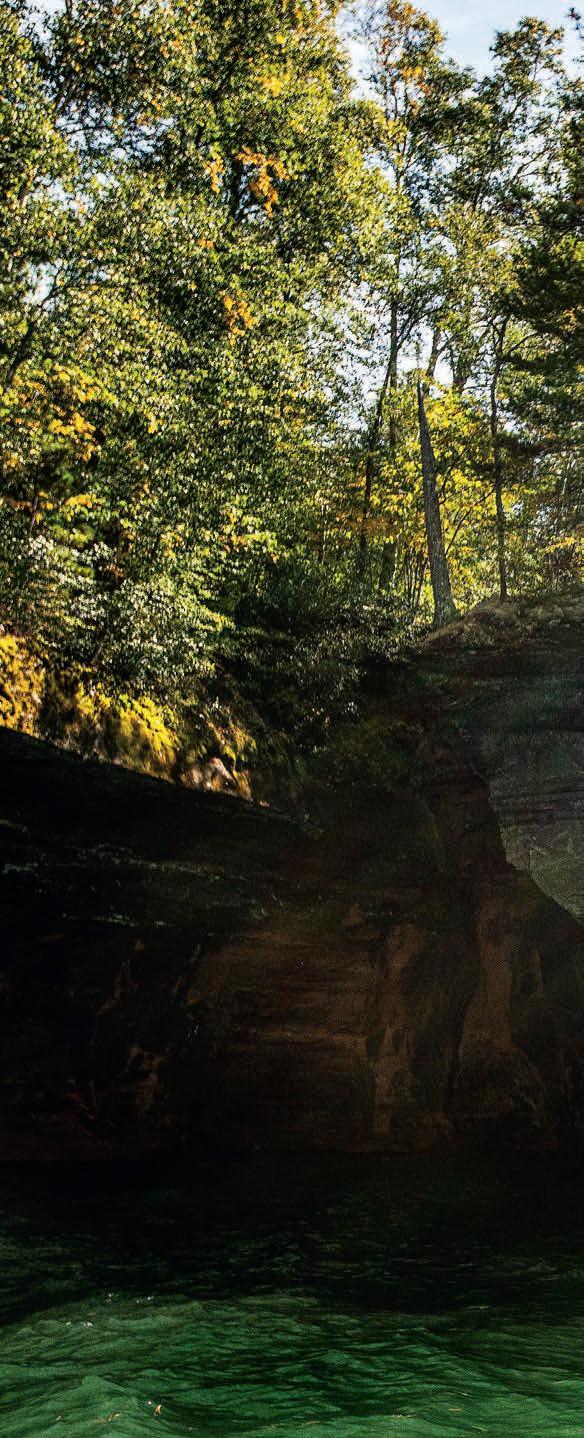
In geologist’s terms they were created yesterday. The lakes were formed towards the end of the last Ice Age and what more exacting scientists call the Pleistocene glaciation, an era that ended a mere 11,700 years ago. Back then, instead of coasting along on these deep blue waters, we would have been buried under the huge slabs of ice that had slid down from the Gulf of St Lawrence, scouring deep gouges in the land where they met the least resistance.
As the glaciers retreated, the lakes filled and became some of the largest reservoirs of fresh water on the planet. The hard rock, which stood firm against the incredible energy of the ice flow, survived in the 35,000 islands we saw dotted ⊲ Viking
Paddle power (right) Kayaking is a popular way to explore the Great Lakes, where the chance to paddle weather-sculpted coast, such as that found among the Apostle Islands of Lake Superior, reveals hidden caves and coves you can only encounter from the water
156 December 2022/January 2023

THE GREAT LAKES www.wanderlustmagazine.com 157
Bigger is better (clockwise from far right page) Lake Superior is so vast that it is said to contain ten percent of the world’s fresh surface water; kayaking past Flowerpot Island in Georgian Bay, which is often dubbed ‘the sixth lake’ because of its size (over 15,000 sq km); beavers play a vital role in the eco-system of the Great Lakes; Tobermory’s Big Tub lighthouse, which sits on Lake Huron, was constructed in 1885 for a cost of just $675; the double-crested cormorant is a common sight on the islands; take a horse-driven carriage to Mackinac’s stylish Grand Hotel for tea; Thunder Bay’s Eagle Canyon is home to Canada’s longest suspension bridge


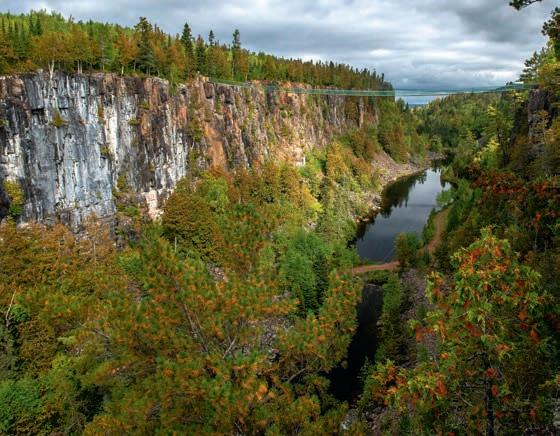


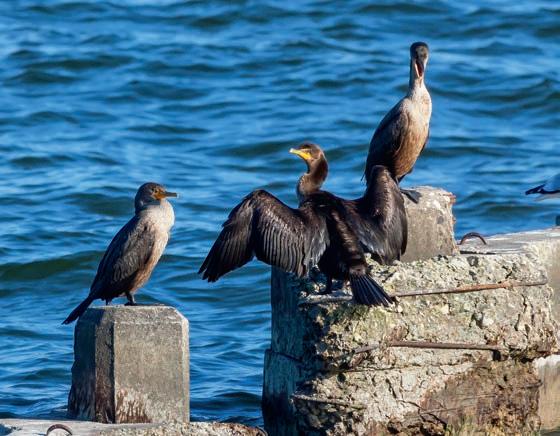
Alamy;
AWL Images; Viking
158 December 2022/January 2023 THE GREAT LAKES

throughout the region. These became home to black bears, white tailed deer, beavers, and now cruise passengers.
BURIED SECRETS
We moored back at the quay, removed our life jackets and baseball caps and mopped our brows. You tend to think of Canada as a land of snow, but in a list of the world’s cities by latitude, Toronto is paired with Central Italy at 43.7 degrees north. The sun was positively Florentine.
However, as our journey neared its end, the Great Lakes finally became the dark, brooding expanse I’d imagined. After days of clear blue skies, we awoke to some proper northern meteorology: dense fog, clumps of firs, hints of islands loom ing beyond our prow. Superior it was, but eerie it seemed.
We anchored at Silver Islet and the mist dissipated a little. A rainbow of light encircled the fleet of kayaks that were towed out to meet us, and as I paddled my way to the shore, it felt like a gateway to the north proper. Thus far, the pine woods and cliffs along the coast had not risen higher than 20m or so; now we were looking up at 50m bluffs and towering firs.
Silver Islet is a wonderful place, yet its air of remoteness is deceptive. In 1868, a rich vein of silver was discovered here. Victorian-era engineers descended on the area and swiftly increased the island to many times its natural size using crushed rock. They then built a town and a general store and extracted over $3 million-worth of precious metals.
Today, the houses of those who grew rich from its silver are much coveted as holiday homes, and the trails the miners utilised every day are now gentle paths through mature wood land. I followed one, taking a sign marked ‘Sea Lion’ and expecting to see a resident pinniped, except sea lions don’t live in lakes – the clue is in the name. Sure enough, I arrived at a large sedimentary rock formation eroded by the waves into a sea-lion-ish shape. To me, it looked like a dachshund poking its nose into the water, but I guess that sounds less impressive.
They’ve left well alone at Silver Islet. That includes the general store. Emerging from it with a T-shirt and a jar of maple syrup, I felt like I’d just visited granny’s for tea – in around 1930. It just rammed home to me something that had been on the edge of my thoughts the last few days of the trip. Most people take cruises for the stops that they make; with the Great Lakes it was more the environment – the water, the shoreline, the skies – that was the star. You live within its confines 24 hours a day, and after a week you start to notice things that you just wouldn’t have if you had been travelling in any other way.
I began to appreciate even the changes in weather. In these climes you can forget what night looks like during summer. In the evenings, I stood on the deck drinking in luminescent layers of icy blues, peaches and tangerines as slate-coloured cirrus clouds traced a kind of Chinese calligraphy in the skies. One night, a shower came in at around 6.30pm. There was a rainbow, but no one was looking at that. Instead, we all stopped what we were doing and gazed as the rain fell like diamond hail.
“Well, that was pretty magical,” said Professor Bates as the shower passed. Not an especially scientific word, but an accurate one all the same.
Living on the edge (right) Few settings match the natural drama of Thunder Bay’s Sleeping Giant Provincial Park, at the tip of which you’ll find the remote former mining community of Silver Islet
On the last evening, we faced the shock of seeing houses and roads and factories as we approached Thunder Bay. I felt like I had stepped out of a summer dream and back to a land of clocks, leaving behind a place that felt timeless. ⊲ Viking
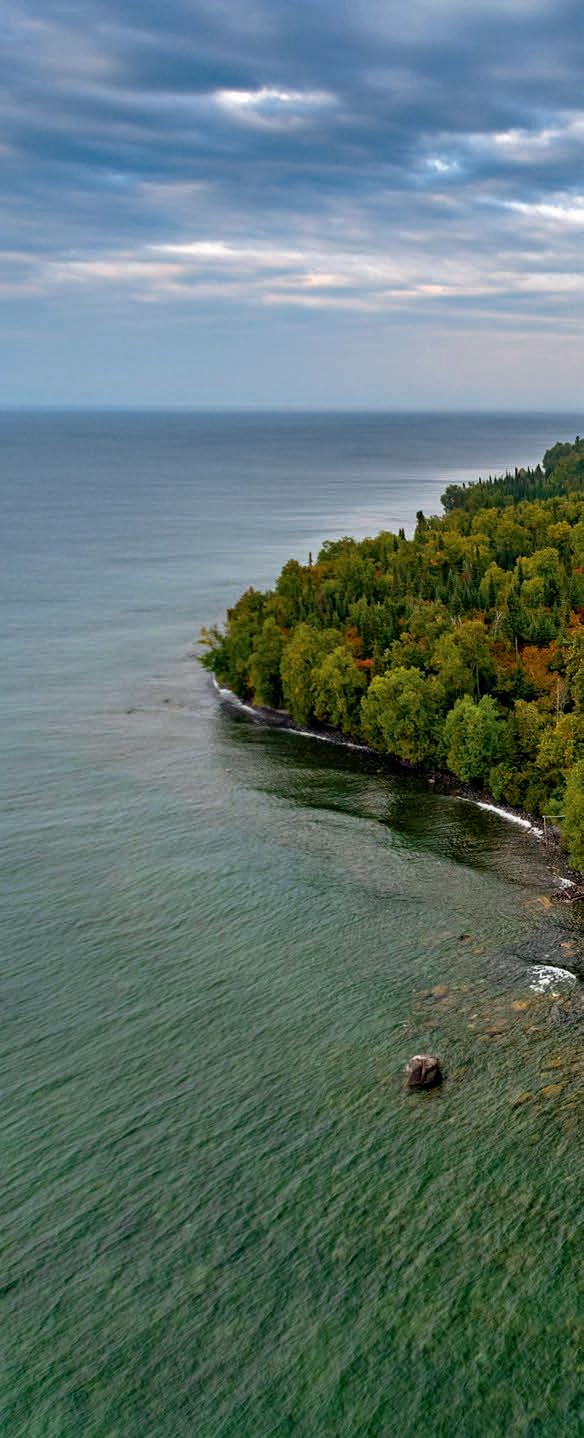
160 December 2022/January 2023
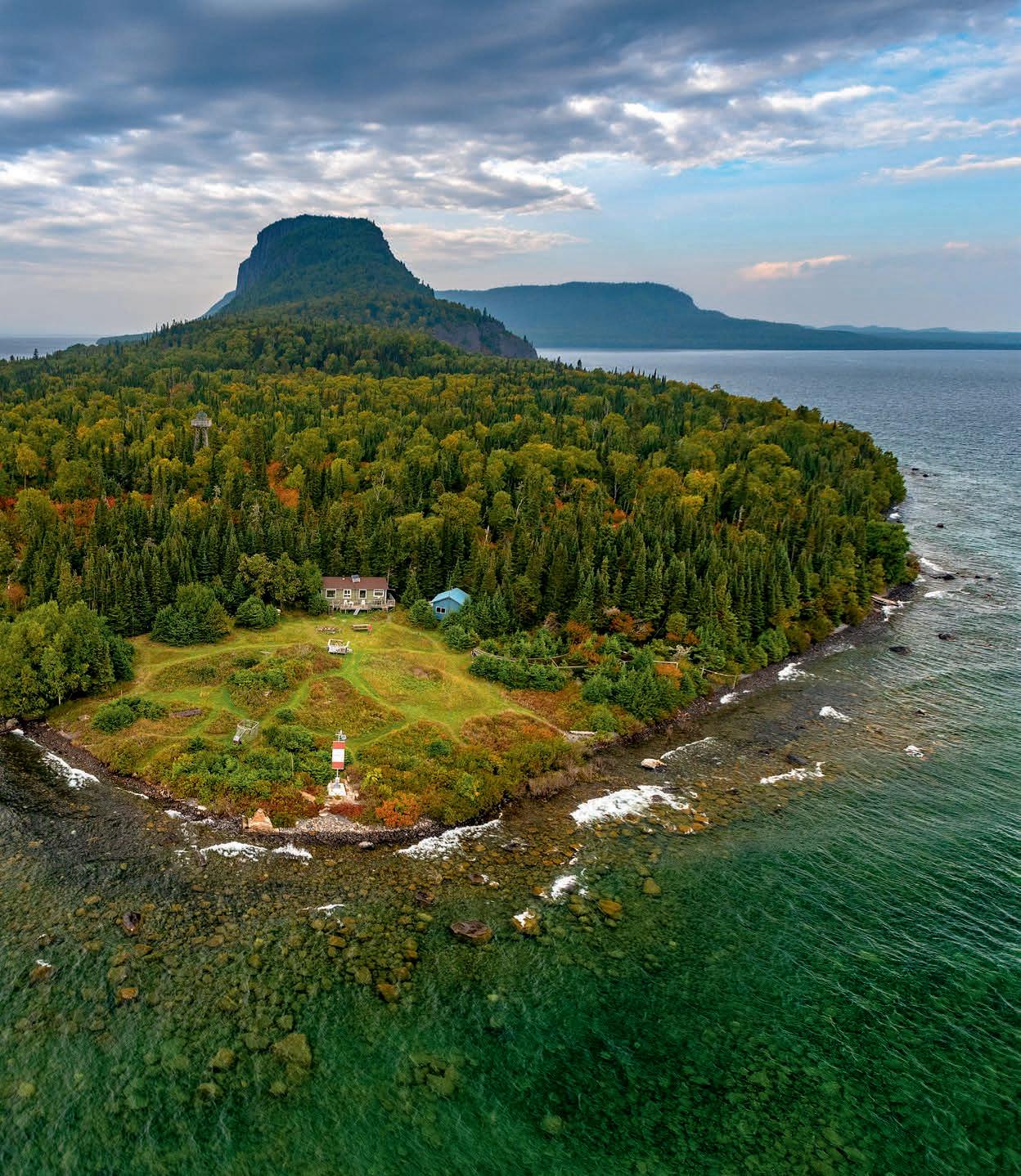
THE GREAT LAKES www.wanderlustmagazine.com 161
THE TRIP
The Viking expedition ship Octantis was launched in 2022 to (in the words of Viking’s CEO) ‘reinvent the cruise’. The Great Lakes Explorer is a seven-night, eight-day voyage, beginning in Milwaukee (where you spend the first night) and ending in Thunder Bay. Excursions and activities include kayaking, wildlife-spotting, a mini-submarine dive and the chance to take part in and learn about the ship’s scientific research programme. Book your trip with Viking (viking.com). Prices start at £5,495 per person for sailings in May 2023. This includes return flights from selected UK airports; in-destination transfers; eight days on board Octantis in a Nordic Balcony stateroom; all on-board meals in restaurants, plus wine, beer and soft drinks with lunch and dinner; wifi; gratuities; access to The Nordic Spa and fitness centre; evening entertainment and enrichment talks; and excursions on kayaks, Zodiacs, Special Operation Boats and on the submarine.
Vital statistics
Language(s): English
Time: Toronto GMT-5 (Mar–Oct GMT-4); Milwaukee GMT-6 (Mar–Oct GMT-5)
International dialling code: +1
Route: The voyage travels in both American and Canadian waters, beginning in the US city of Milwaukee (population: 592,649) in Wisconsin and finishing at the Canadian town of Thunder Bay (population: 110,172) in Ontario – or the reverse, depending on which direction you travel.
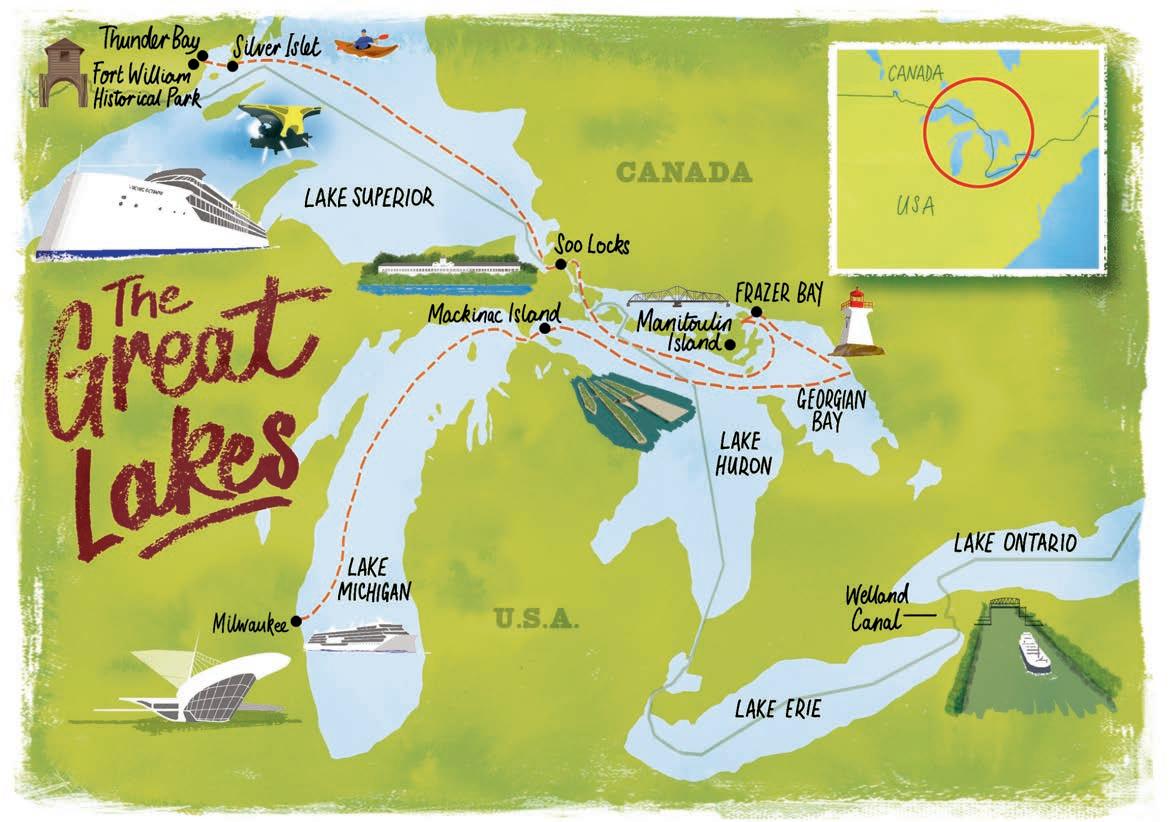
Visas: Not required for UK nationals. However, to enter the USA you will need a valid Electronic System for Travel Authorisation (ESTA; https://esta.cbp.dhs. gov), which costs US$14 (£12.50) and lasts for two years. Entering or transiting through Canada also requires a valid Electronic Travel Authorisation (eTA; canada.ca), which costs CA$7 (£4.60). Both are quick and easy to apply for online.
Money: US dollars (US$), currently $US1.11 to the UK£; Canadian dollars, currently CA$1.52 to the UK£. All extras not included in activities
and comestibles listed in the trip details are charged to your on-board account and are settled at the end of the voyage. Credit cards are widely accepted on land.
When to go
Cruises on the Great Lakes run between May and October. Bear in mind that these are lakes, therefore are calm for most of the summer, although swells and oscillating waves, known as ‘seiches’, can make for a rough ride at times.
May–June & September–October: Spring and autumn are mild, though the nighttime temperature can fall to around 8ºC.
July–August: Temperatures can rise to the mid-to-high 20s (ºC) in summer. Expect cooler days and nights in the northerly Lake Superior, and be prepared for the occasional squall or foggy day.
Health & safety
At the time of writing, you’ll be required to show proof of your COVID vaccination and take a pre-departure
162 December 2022/January 2023
fit-to-fly test. Reduced mobility is not an issue on board, as there are lifts between the floors. You’ll also get to practice boarding the submarines and Zodiac launches, though the sub (pictured top) isn’t recommended if getting in and out of steep, tight spaces causes you difficulties or stress.
Otherwise, the most demanding physical activities are hiking and kayaking, for which only a moderate level of fitness is required. All cabins are stocked with life jackets and you’ll be fitted for waterproofs upon boarding. Daily briefings, the ship’s own newsletter and the cruise app will keep you fully informed. The ship also has an on-board medical centre and all necessary tablets if choppy water causes you to feel unwell.
Getting there
The author flew with Westjet (westjet.com) from Edinburgh to Milwaukee via Chicago, and returned from Thunder Bay to Edinburgh via Toronto. Avoid Chicago’s O’Hare airport if you can; baggage collection there can be chaotic and stressful. As flights are included in the cruise ticket price; Viking can advise on the best options for you to take.
Getting around
In Milwaukee, coach transfers to the quayside from your hotel are included in the cost of booking, as is a regular shuttle bus to downtown. If you have a later flight departing from Thunder Bay, Viking can arrange a tour of the area, including a stop at the Fort William Historical Park (a recreated fur trading station). On Mackinac Island, it’s a good idea to take advantage of its horse carriages or arrange for cycle hire.
Cost of travel
Everything is complimentary on board, including tips. However, you can arrange for a spirits package (£17.39 per guest per night) if you wish to upgrade your drinks. There’s a surcharge for some
excursions (lunch at the Grand Hotel and a carriage ride on Mackinac Island is £99 per person, for example), but most are included.
Accommodation
There are nine categories of stateroom on the Octantis. Most are variations on the Nordic Balcony Suites, priced according to their position on the ship. The name is a bit misleading: there is no balcony as such, but a huge panoramic, electrically operated window. To get an actual balcony, you need to upgrade to the Explorer or Owner suites. All rooms have a seating area, free mini bar, free laundry, lots of wardrobe space and high-end binoculars.
Food & drink
All-day dining on board is offered at the World Café. As its name suggests, there are lots of different cuisines, including a sushi bar and Nordic cuisine. More formal meals are on offer at Manfredi’s (Italian) and The Restaurant (contemporary/ classic). The Explorer’s Lounge is the main bar, although The Hide is the place to seek out for a late-night whiskey.
Packing & shopping
It’s a pretty casual ship, though you may enjoy dressing formally for the restaurants and the captain’s private dining room, if you’re invited. Trainers should be fine for the hikes. Mackinac has shops designed for the daytripper market. The General Store at Silver Inlet is particularly characterful.
Further reading & information
The Living Great Lakes by Jerry Dennis (St Martin’s Griffin, 2003) – Outdoors writer and Michigan native Dennis relates two voyages, interspersing them with thoughtful analysis of the region’s history, ecology and battles with pollution and invasive species. Note: The Octantis library is excellent and majors on works of exploration and science.
HIGHLIGHTS
1 Milwaukee (USA)
You’ll spend a night in this characterful Wisconsin city that is known for its beer. Head to the Historic Third Ward for markets, restaurants and brews.
2 Mackinac Island (USA)
Nestled between two lakes (Michigan and Huron), Mackinac was fought over by the British, French and Americans before becoming a busy holiday and hunting spot in the 19th century.
3 Killarney (Georgian Bay, Canada)
Visit the Killarney Mountain Lodge for lunch, then either join the organised hike or walk the nearby Lighthouse Trail alone.
4
Frazer Bay (Canada)
The private Okeechobee Lodge opens its grounds to Octantis passengers. Hop in a Zodiac boat for perhaps the most memorable (and informative) up-close view of the lakes.
5 Soo Locks (USA)
It might come as a shock to see civilisation after days of just water, trees, sky and little else. Once you’re through this engineering marvel, you will enter the vast Lake Superior.

6
Silver Islet (Canada)
This hilly, wooded bay made its fortune when silver was first found here. Now it is lined with holiday homes and nature trails.

7Thunder Bay (Canada)
This Ontario city (pictured left) was created by merging two townships in 1970, and is where you start or finish. Its main sight is Fort William Historical Park.
WANDERLUST RECOMMENDS
There’s a good selection of music in the bars and restaurants on the ship. Seek out anything by Yasmine Hamdan, Clem Leek and (our own choice) Agnes Obel.
Map illustration: Scott Jessop; images: Viking
www.wanderlustmagazine.com 163 THE GREAT LAKES FOOTNOTES
HIT THE ROAD IN
NOVA SCOTIA
Three essential pit stops on an epic Atlantic Canada self-drive adventure
From the breezy coastal roads of the South Shore to the winding highways of Cape Breton, the Atlantic province of Nova Scotia is tailor-made for a road trip. Rocky shorelines, lonesome beaches, tiny islands, remote lighthouses – its seaside scenery will stay with you long after you leave for home.

1CONNECT WITH NATURE AT KEJIMKUJIK NATIONAL PARK AND NATIONAL HISTORIC SITE
If it’s wilderness you’re after, then the old-growth forests, pristine rivers and glinting lakes of Kejimkujik definitely fit the bill. Established in 1967 and covering 381 sq km of south-west Nova Scotia, it’s one of the province’s largest protected areas (a separate section, Kejimkujik National Park Seaside, also encompasses 22 sq km of wild coast).
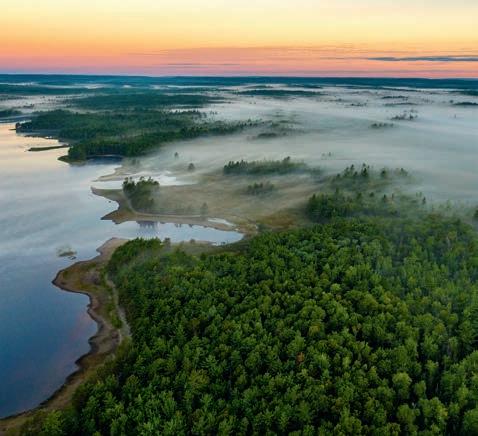
With numerous trails and lakeside campgrounds, it’s a superb place to get back to nature and enjoy the great outdoors. Canoeing, kayaking, hiking and biking are all popular pastimes here, and as Nova Scotia’s only Dark Sky Preserve, Kejimkujik is one of the top areas in Canada for stargazing.

It’s also a great place to learn about indigenous culture. The Mi’kmaw people have lived here for thousands of years, and guided walks and kayaking trips give an insight into their ancient culture. Of particular note are Kejimkujik’s sacred petroglyphs (or rock carvings). There are more than 500 to discover, with some carved more than 1,000 years ago.
While most visitors decide to camp, there’s no need to rough it. You could hire a rustic timber cabin for a backwoods experience, rent a pre-pitched oTENTik tent on the shores
Embrace nature (this page; clockwise from top left) The iconic lighthouse at Peggy’s Cove; stargaze from the comfort of your own Oasis Pod at Jeremy’s Bay campground; Kejimkujik National Park and National Historic Site contains 46 lakes and ponds, and more than 30 streams and rivers
2 ESCAPE TO THE SEASIDE
For classic Nova Scotian vistas, take a tour along the southern shores of the province, also known locally as the Lighthouse Route. The most iconic spot is Peggy’s Cove, the tiny seaside fishing village about 43km south-west of Halifax, whose lighthouse (first lit in 1915) is among the most photographed in Canada. But it’s far from the only one: there are more than 160 lighthouses along the South Shore, protecting ships from foundering on the region’s hidden reefs and treacherous rocks.
Just along the coast lies Lunenburg, the South Shore’s quintessential fishing town, whose clapboard houses, churches, boatsheds and timber buildings are so picture-perfect that they almost look like a film set. As one of the best-preserved colonial settlements in Nova Scotia, Lunenburg
164 December 2022/January 2023
of Kejimkujik Lake, or head for Jeremy’s Bay campground to book an Oasis Pod – five treehouses shaped like water drops complete with hammocks and their own stargazing platforms.
Tourism Nova Scotia / Photographer: Acorn Art & Photography; Tourism Nova Scotia / Photographer: Dean Casavechia; Tourism Nova Scotia / Photographer: Scott Munn; Tourism Nova Scotia
has been inscribed on UNESCO’s World Heritage List since 1995. It’s also home to the Fisheries Museum of the Atlantic, which explores the region’s salty maritime heritage – although the town is best known to Canadians as the home harbour for the Bluenose II, the iconic racing schooner that still features on Nova Scotian licence plates and the Canadian 10-cent piece.
You’ll pass plenty of pretty towns as you drive the coastal road, including Chester, Mahone Bay, Liverpool and Shelburne, the latter of which has a long heritage of fishing and shipbuilding.

Old-town charms (this page; clockwise from top) Shelburne offers the best of all worlds – a rich culture, natural beauty and space for adventures in the great outdoors; Lunenburg is one of just two urban communities in North America that have been recognised by UNESCO; you can explore Avondale Sky Winery on a number of tours
Several bike trails wind their way along the coast; the 119km Rum Runners’ Trail between Halifax and Lunenburg is particularly worth riding. Don’t forget to also factor in some beach time. Thankfully, the South Shore has some of Nova Scotia’s finest stretches of sand, ranging from popular spots such as Queensland, Crescent Beach and White Point to lesser-known ones like Beach Meadows, Mill Cove and Hirtle’s Beach.
3 DISCOVER NOVA SCOTIA’S WINE COUNTRY & ANNAPOLIS VALLEY

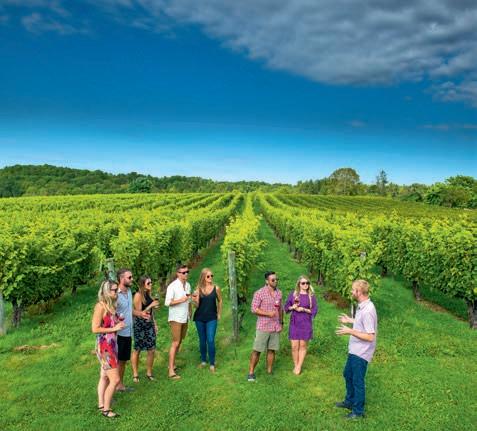

It might be more than 6,000km from France as the crow flies, but the Annapolis Valley has a surprisingly similar climate and geography to the Champagne region. So it’s no surprise to find that this area produces some
of Canada’s best sparkling wines. In fact, wine has been produced in Nova Scotia longer than anywhere else in Canada. The first vines were planted here in the early days of settlement, back in the 1600s. There are now more than 20 vineyards scattering the province, most of which are in or around the Annapolis Valley.


Renowned wineries include Domaine de Grand Pré, Benjamin Bridge and the Blomidon Estate as well as boutique vineyards such as Bent Ridge and Avondale Sky. The most prestigious vintages are those of Tidal Bay, Nova Scotia’s only wine appellation, whose crisp whites are known for their blend of acidity, fruitiness and salinity (experts say you can almost taste the Atlantic breeze).
It’s also worth taking the time to discover the region’s lesser-known wine regions. Gaspereau Valley, the Malagash Peninsula, Bear River, Marble Mountain and the Avon Valley all have unique microclimates, soils and flavour profiles. For wine-tasting minus the driving, the Magic Winery Bus (based in Wolfville) is a good way of getting around and offers organised vineyard tours with no need to name a designated driver. Santé!
PROMOTIONAL FEATURE www.wanderlustmagazine.com 165For more information, go to: novascotia.com















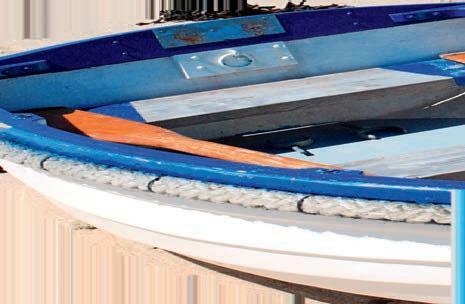
discover Alamy Double bill: Poznań & Toruń 168 Hidden USA: Capital Region 170 Indigenous: Lithuania 174 World heritage: Villa de Leyva 176 British break: Isles of Scilly 178 Off grid: Nuuk, Greenland 182 Short break: North Rhine-Westphalia 186 Top guide: Craig Wickham 194 Glimpse life on the Arctic fringes in Greenland, find out why there’s more to the USA’s Capital Region than politics, dig into Colombia’s ancient history, and more… Time and tide… Boats are everywhere on the Isles of Scilly, where schedules revolve around the tides. Gig races are also a yearly highlight of island life in the summer; see p178
AT A GLANCE Poznań & Toruń
Poznań
Population: 529,410
Average max July temperature: 25.2°C Famous for: Founding of the Polish state; colourful main market square; active, student-fuelled club scene
Toruń
Population: 198,613 Average max July temperature: 25.1°C Famous for: Birthplace of Nicolaus Copernicus; gingerbread pastries; well-preserved, red-brick Gothic architecture
Need to know
The drive between the two cities takes roughly two hours, depending on traffic, but several daily trains also connect them. Secondclass seats cost from £9; tickets can be bought in advance from the Pol Rail website (polrail.com). Faster Inter-City (IC) trains, marked in red on timetables, make the journey in under two hours. Toruń has two rail stations, but Toruń Miasto is closer to the Old Town.
How to get there
Airlines Wizzair (wizzair.com) and Ryanair (ryanair.com) fly direct to Poznań-Ławica Airport from London Luton and Liverpool respectively. Both flights take from around two hours; prices start at £25 one way. Toruń’s nearest airport is 50km away in Bydgoszcz. Ryanair flies direct to Toruń from London Stansted and Birmingham, with prices also starting at £25 each way.
History
Poznań traces its roots to the 8th century, before the founding of the Polish state.The country’s first ruler, Mieszko I, was reputedly baptised here and remains buried, alongside several other former Polish leaders, at Poznań Cathedral. Over the centuries, the city prospered from its location along key trade routes. During the SecondWorld War, much of Poznań, including its stately main market square, was destroyed; the square was painstakingly rebuilt in the decades afterwards.
Around town
Any exploration of Poznań starts at the 13th-century main square (Stary Rynek); this is dominated by the Renaissance Old Town Hall. Note the colourful row of merchants’ houses (‘Budnicy’ Houses) on the square’s eastern side. North-east of the centre, Cathedral Island (OstrówTumski) is home to several religious sights as well as the city’s impressive 10th-century cathedral. Don’t miss a visit to the ancient crypts where Mieszko I and his son, Bolesław the Brave, are buried.
Surrounding nature
Poznań is a sprawling metropolis, and you don’t need to leave the city limits to enjoy a day in nature. Lake Malta, about 20 minutes’ walk east of the main market square, is a giant man-made lake with abundant hiking and cycling trails, a water park and a narrow-gauge railway. Further afield, the unspoilt Wielkopolski National Park (wielkopolskipn.pl), about 15km south of Poznań, encompasses three tranquil lakes and offers 85km of marked, colour-coded hiking trails.
Food & drink
Poznań is famous for its sweet pastries stuffed with poppyseeds and vanilla cream, known as ‘St Martin’s croissants’.These are traditionally eaten on St Martin’s Day (11 Nov) but are enjoyed across the year.The Poznań Croissant Museum (rogalowemuzeum.pl) holds live cooking shows where visitors make their own versions. Enjoy classic Polish dining at Ratuszova Restaurant (ratuszova.pl) on the main square, where you can taste such specialties as cabbage rolls stuffed with buckwheat.
Where to stay
The City Solei boutique hotel (citysolei.pl) offers a large dose of quirky, eye-popping modern design, bright rooms and a particularly handy central location, located just a few minutes’ walk from the main market square.The décor in each of its 22 rooms is inspired by a different city from around the world. Doubles from £55pn.
Toruń began life in 1231 as a military outpost of the Catholic crusading order known as the Teutonic Knights. The rocky remains of their former castle are still standing. Famed Renaissance mathematician and astronomer Nicolaus Copernicus was born here in 1473.The city grew wealthy as a member of the Hanseatic League, and it was later spared damage during the Second World War, so its UNESCO-listed centre retains the look and feel of a well-to-do medieval town.
Start at the ruins of the Teutonic Castle and take in the Gothic splendour of the surviv ing medieval town gates. Stroll the high street, Szeroka, and admire the exteriors of the houses – a harmonious blend of Gothic, Renaissance, Baroque and Art Nouveau. The magnificent 14th-century Old Town Hall is one of Poland’s largest Gothic red-brick structures. Copernicus’s purported birthplace and house, nearby, is home to a museum devoted to the man’s life and times.
Cross theVistula River on a bridge leading south of the centre for dramatic views of the castle ruins and Old Town Hall from the opposite bank. For something more strenuous, cycling trails fan out in all directions. The tourist information office hands out maps of popular routes, including a blue-marked trail that runs north to the Barbarka forest.Torvelo (torvelo.pl) is a handy and reasonably priced bike-share option, with bike-hire stands all around town.
Gingerbread (piernik) biscuits, often cut up into fanciful hearts and stars, have been baked here since at least the 14th century.Toruń even has two museums dedicated to the craft.The Live Gingerbread Museum (Żywe Muzeum Piernika; muzeumpiernika.pl) invites visitors to prepare their own dough and even ice the final concoctions.The 4 Pory Roku restaurant (hotel1231.pl), located near the former castle, features seasonal dishes with ingredients supplied by local farmers.
The four-star boutique Hotel 1231 (hotel1231. pl) occupies two tastefully renovated buildings, an infirmary and an old mill that all stand resiliently amid the ruins of the Teutonic Knights’ former castle, within what was once the outer bailey.The location is deceptively close to the OldTown, just a ten-minute walk away. Doubles from £60pn.
Poland’s pair of medieval cities offer uncommon charm and elegance in strikingly different ways, discovers Mark Baker
168 December 2022/January 2023 DOUBLE BILL PoznańToruń Alamy; Shutterstock
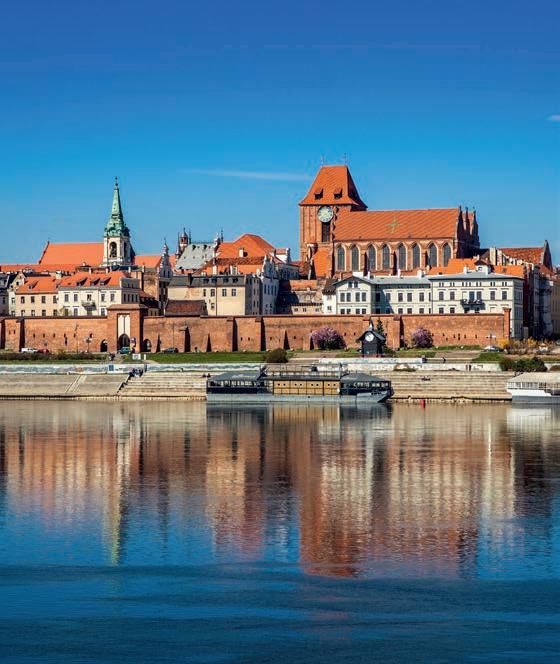

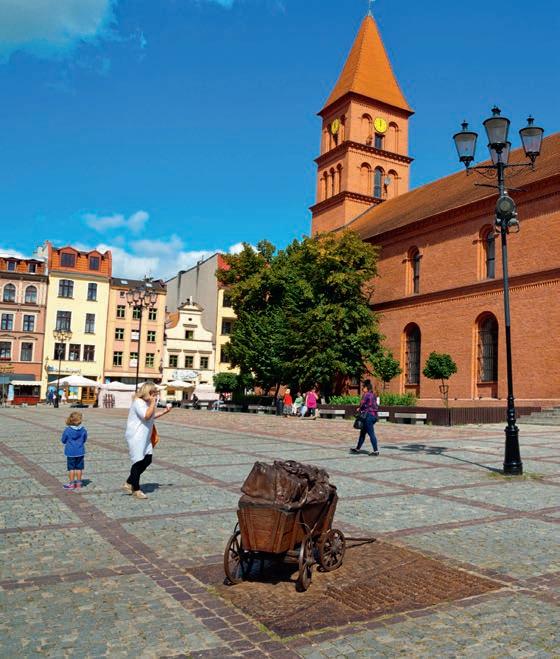
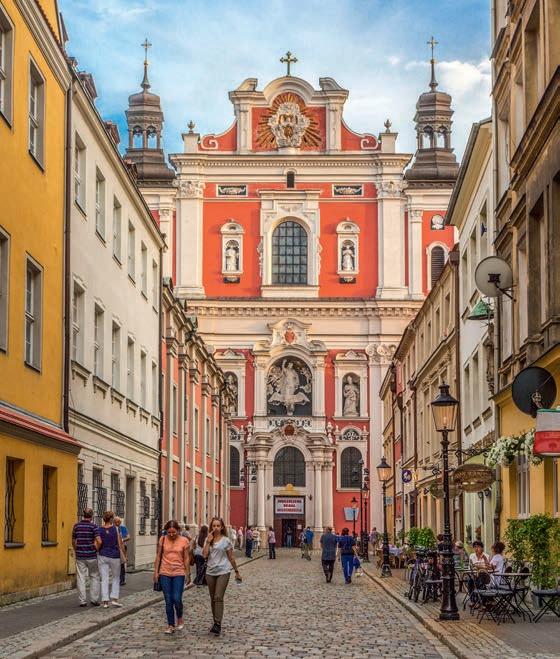
DISCOVER Poland www.wanderlustmagazine.com 169
Still standing strong (clockwise from top left) Poznań’s Old Town Hall has been badly damaged by fires, hurricanes and bombing over the centuries, only to be faithfully restored to its previous glory – at 12 noon every day, locals gather to see two mechanical billy goats emerge from its clocktower and signal the hour by butting heads twelve times; the old town of Toruń, as seen from the banks of the Vistula River; Toruń’s historical centre has survived miraculously given so many other cities in Poland suffered heavily during the Second World War; Poznań’s Baroque Basilica of Our Lady of Perpetual Help and St Mary Magdalene (or Poznań Fara) dates back to 1705
US Capital Region
The Capital Region isn’t all politics and West Wing chatter. Washington, DC and the states beyond are filled with rejuvenated corners, vineyards and US history seen from every perspective
 Words Peter Moore
Words Peter Moore
HIDDEN USA
To outsiders, the Capital Region is often a confusing concept. ‘Is Washington, DC a state?’ is just about the most commonly asked question. (Answer: no, it’s a district – cue puzzlement).Then there’s what lies beyond America’s political centre.There is more to this region than theWestWing, something that is swiftly apparent as you explore DC and the packed states around it – particularly Maryland andVirginia.
Through DC runs the mighty Potomac River, with breathtaking mountains to the west, glistening bays and beaches to the east, and close to 300 years of history rammed in between.What’s more startling is that much of this lies within just an hour’s drive of the iconicWashington Monument.
In the far north of Virginia you’ll find Loudoun County.This is DC’s wine country: a rolling landscape of hills braided with vineyards and dotted with wineries and breweries. County seat Leesburg buzzes with hipster bars and restaurants in its downtown, while nearby Purcellville gives off more of a family-friendly, Norman Rockwell vibe.
Elsewhere in Virginia you can sample the leafy colonial charms of Alexandria and visit historic Mount Vernon, a site with a complicated history but one that also honours the most famous founding father of them all, GeorgeWashington.

a vibrant waterfront, a rich sporting heritage and blue crabs that are to die for.
Lastly, there’s DC itself, which is in a constant state of renewal.You’ll want to tick off iconic sights such as the Lincoln Memorial and theWhite House, of course, but take time to explore buzzy new neighbourhoods like the NavalYard, theWharf and the many galleries and museums, both in the National Mall and beyond.Whatever you choose to do in this extraordinary region, you’ll have a capital time.
HIGHLIGHTS
THE NATIONAL MALL
Never has there been a more misleading name.The National Mall is no shopping centre, but ‘America’s FrontYard’: 400 hectares of urban green space stretching from the Capitol building to the Potomac.
NEED TO KNOW
Geography: Capital Region consists of Washington, DC and the states of Virginia, Maryland and Delaware.
Getting there: Washington Dulles International Airport (IAD) welcomes daily non-stop flights from London Heathrow with British Airways (ba.com), American (americanairlines.co.uk) and Virgin Atlantic (virginatlantic. com). Flights cost from £492 one way and take eight hours. If you fly in from elsewhere in the US, you’ll likely land at Ronald Reagan Washington National Airport (DCA), which is more conveniently located – only four metro stops from the rail links of Union Station.
To the north-west, you’ll find Chesapeake Bay and the big city vibes of Baltimore in Maryland, which, despite its tough reputation (fuelled by TV series The Wire), is also exceedingly sophisticated in parts. This is a port city with world class galleries, ⊲
In some ways it’s a kind of collective memory bank. It’s here that you’ll find the iconic Lincoln Memorial, the towering Washington Memorial and the austere Vietnam Veterans Memorial. There are also 11 Smithsonian museums, displaying everything from the tattered garrison flag that inspired ‘The Star Spangled Banner’ to one of the first Apple Macintosh computers.The National Air and Space Museum just re-opened its west wing, while the National Museum of African American History and Culture and the National Museum of the American Indian fill in many of the blanks missing from older institutions, recognising, at last, the contributions these cultures have made. Entry to all DC Smithsonian museums is free (si.edu).
Getting around: Public transport is a viable way of getting about in the Capital Region, especially with a SmarTrip® Card. This can be used on the Metrorail, Metrobus, DC Circulator and bus networks in Virginia and Maryland. In Baltimore, water taxis are an affordable way to reach waterfront locations such as Federal Hill and Fell’s Point. A single adult ticket costs $12 (£11); a $20 (£18.25) pass gives you unlimited rides for a day. In Alexandria, a free trolley bus shuttles King Street, linking the train station and waterfront. Uber and Lyft are the local ridesharing apps of choice.
Deals: Alexandria’s Key to the City pass ($20/£18; visitalexandria.com) offers discounts on various sites and activities, including free entry to Carlyle House Historic Park and Stabler-Leadbeater Apothecary Museum, plus a 40% discount on Hornblower Water Taxi cruises and entry to Mount Vernon.
Alamy
Beyond politics (left) When you think of Washington, DC, you picture the Lincoln Memorial, Washington Monument and US Capitol building, yet there is a world of countryside escapes, wineries and history on its doorstep that are also worth exploring; (top) George Washington’s plantation, Mount Vernon, is not just where the graves of George and his wife, Martha, are buried – now a memorial to the slaves who worked and died there addresses its often difficult past
DISCOVER Capital Region www.wanderlustmagazine.com 171
BALTIMORE
It says much about Baltimore (baltimore.org) that the city made world-famous as the focus of the gritty TV series The Wire also boasts the world’s largest public collection of Henri Matisse paintings.This is proudly on display at the Baltimore Museum of Art, just down the road from Johns Hopkins University.
Inner Harbor provides the city’s focal point, home to the National Aquarium, a Hard Rock Café and the esoteric American Visionary Art Museum, just across the way. Fell’s Point is a vibrant area of bars, cafés and shops; it also accommodates The Sound Garden (thesoundgarden.co.uk), the birth place of Record Store Day, when all the vinyl shops around the world celebrate their resilient niche.

The retro CamdenYards is home to the world-fa mous Orioles baseball team and, just around the corner, you’ll also find the birthplace of one of America’s biggest sporting stars, Babe Ruth – a museum marks the spot.There’s the new Sagamore Spirit distillery (sagamorespirit.com) to see, which pumps out award-winning rye whiskey. Then finish with a plate of local soft-shell crab, which is to die for – especially when combined with an ice-cold ‘Natty Boh’ (National Bohemian), the iconic local lager.
LOUDOUN COUNTY
Loudoun County (visitloudoun.org) is where stressed-out politicos go to unwind. Barely an hour north-west of downtown DC, its low hills are dotted with historic towns, secluded hamlets and count less wineries, craft breweries and field-to-fork farms. There is even a stretch of the Appalachian Trail, known as ‘The Roller Coaster’ for the many small ridges and hollows that walkers power through.

On the cultural side, there’s an outdoor art trail in Leesburg, the annual LoCo Musicians Festival at the 868 Estate Vineyards (locomusiciansfestival. com) and the Middleburg Film Festival (middle
burgfilm.org), where Oscar-hopefuls tout their wares. But the reason city folk flock to LoCo for the weekend is more to do with what grows there.

For foodies, the bounty of what George Washing ton dubbed ‘The Breadbasket of the Revolution’ is not to be sniffed at – or rather it is. Follow the Loudoun Wine Trail, then, if you’re still standing, kick on to the LoCo Virginia Ale Trail (visitloudoun. org). Finish with a farm-to-table feast at Patowmack Farm (patowmackfarm.com), or simply head to downtown historic Leesburg and sample all of the above in its many hipster bars and restaurants.

ALEXANDRIA
George Washington laid out the original street plans for Alexandria in 1749. Close to 300 years later, this charming colonial city (visitalexandria. com) is still best explored by foot: leafy King Street is recognised as one of the ‘Great Streets of America’; Captain’s Row, on Prince Street, offers a serene pocket of cobblestones and colourful Federal-style houses; and historic Carlyle House and Market Square exude a stately grace.
The city is also steeped in African American history, which is best explained on the Black history walking tour that starts at the sobering Freedom House Museum (manumissiontours.com). After wards, drop in on Intertribal Creatives (indianyouth. org) on N Lee Street, which celebrates Indigenous art and culture, to see another side to the city.
There’s no shortage of eateries to fuel your endeavours. Start with breakfast at Bob & Edith’s (bobandedithsdiner.com), an old-school diner near the station. Lunch at Augie’s Mussel House and Beer Garden (eataugies.com), halfway along King Street. And finish at BARCA (barcaalx.com), right on the Potomac, where you can enjoy tapas and gaze over to where the sun sets over the Capitol building barely a half-dozen kilometres upriver.
Capital ideas (clockwise from top right) Alexandria’s bustling King Street spans more than a kilometre of shops and centuries-old architecture in the Old Town; the USS Constellation, anchored in the Inner Harbor of Baltimore, was the last sail-only warship designed and built in the USA; the best-preserved portions of the historic Patowmack Canal are only visible within Great Falls Park; the hillside views from Bluemont Vineyard in northern Virginia
172 December 2022/January 2023
THINGS TO DO
Explore Virginia’s Great Falls Park
Just 24km from DC and home to the most dramatic falls on the Potomac River, the 323-hectare Great Falls Park in Virginia serves up a multitude of walking trails, rapids (classes 5–6) and what’s left of the Patowmack Canal, built under George Washington and one of the earliest examples of a lock system in the US. Indigenous American petroglyphs are etched into the cliffs above the tumultuous falls and the picnic areas are perfect for an All-American grill-up. And that flash of red? It’s probably a cardinal, Virginia’s striking state bird.
Drink like they do in Loudoun County
Nate and Sarah Walsh are the ‘It Couple’ of the Loudoun County viticulture scene, farming 21 hectares of wine grapes across six distinct sites to produce world-class vintages. Their Walsh Family wine (walshfamilywine.com) is best experienced in their sun-drenched tasting room in the foothills of the Blue Ridge Mountains, and ideally soundtracked by a vinyl record chosen from their vast and eclectic selection. Make sure you try ‘What Will The Women Drink?’, a cheeky riposte to a visitor who thought their wines might be a little too complex for the ladies. It’s delicious.
Make a pilgrimage to Mount Vernon
To understand modern America, visit George Washington’s Mount Vernon Estate (mountvernon. org). Just 25km south of the capital, the former plantation is both a shrine to the iconic founding father and a paean to American exceptionalism. Watch a 4D spectacular at the Revolutionary War Theater, gaze upon Washington’s dentures (made from animal and human teeth), marvel at Martha’s bold interior-decorating choices in the restored mansion, and then consider the other side of life here with a visit to the slave cemetery, where a memorial to the plantation’s indentured workers is finally granting them the recognition they deserve.
See DC’s rejuvenated shipyards

Known as Navy Yard, DC’s former shipyard district once made gunboats and submarines; now it is a hive of craft breweries, hipster cafés and boutique hotels, all given a dusting of industrial chic. The Bull Pen, a fan zone for the Washington National baseball team, remains a fun, if sweaty, nod to the area’s blue-collar past. Next, head to the river for manicured green spaces and the new Anacostia Riverwalk Trail. This leads to the Wharf (wharfdc. com), a new entertainment precinct that sits cheek-by-jowl with the city’s fish market, which has been running since the days of the Civil War.
 Alamy
Alamy
DISCOVER Capital Region www.wanderlustmagazine.com 173
Karaim, Lithuania

The Karaim arrived in medieval Lithuania as warriors tasked with guarding Trakai; six centuries later, you can still find their influence throughout the city, writes Simon Broughton
You may not have been aware of it, but this was the ‘Year of the Karaim’ in Lithuania. At the official declaration, Lithuanian prime minister Ingrida Šimonyte described the Karaim people as a “unique treasure”, though official figures show there are only 196 living in the country today.Yet, despite being one of the smallest minorities in Europe, Karaim culture is still a big part of Trakai, the former Lithuanian capital (about 30km southwest of Vilnius), where they were once the city’s champions.
In 1397,Vytautas, ruler of what was then the Grand Duchy of Lithuania, invited several hundred Karaim families from Crimea to Trakai to serve as its defenders and warriors. Back then, they were famed for their swordsmanship, and the Karaim were duly given the land betweenTrakai’s two castles as reward. It is still called Karaim street to this day, and strolling here reveals wooden houses painted in yellow, green and ochre.
Vytautas’ castle, built on an island in Lake Galvė, remains the most dramatic sight in town even now; however,Trakai eventually lost its need for an army. Once the Karaim were no longer required to be warriors, they became market gardeners and traders instead, and were famed for growing cucumbers – and where would Lithuania be without its gherkins?
While many minorities suffer marginalisation or persecution, the Karaim have fared better. “The community has always had a very good name,“ said Karina Firkavičiūtė, who
has a house on Karaim street. “We are happy to see the highest representatives of our country come and celebrate our anniversary and congratulate us, so that our good relationship can carry on.”
Also on Karaim Street is the kenesa, the Karaim place of worship. It is a compact, square building with coloured windows and a pointed roof. It’s clearly neither a church nor a mosque, but it’s also not a synagogue. Despite the Karaim following an OldTestament religion that draws on the Hebrew Bible, they are not Jewish.They even managed to convince the Nazis of this, so survived the tragic devastation of Lithuania’s large Jewish community during the Second World War.
While there are less than 200 Karaim in Lithuania, there are a similar number in Poland and a wider diaspora around the world – in Crimea and Ukraine,Turkey, Europe and beyond. Yet their estimated global population is 3,000 at most and the Turkic Karaim language is on UNESCO’s endangered list –by the early 2000s, there were fewer than 50 fluent speakers.
Many Karaim came back toTrakai this year to celebrate 625 years in Lithuania with a concert by the lakeside. It even saw Polish musician Karolina Cicha, a specialist in minority music, arrive to perform with local Karaim singers. It was a welcome serenade for a people inseparable from the history of Trakai.
Sounds from the street (this page; top to bottom) The Karaim are a close-knit community and have managed to maintain a presence on colourful Karaim Street in Trakai for over 600 years; Karolina Cicha (pictured middle) performs on the shore of Lake Galvė as part of the ‘Year of the Karaim’
 Alamy; Simon Broughton
Alamy; Simon Broughton
174 December 2022/January 2023 INDIGENOUS CULTURE
Six ways to experience Karaim culture
1 The island castle
Rising like an apparition from Lake Galvė, Trakai Castle looks like something out of a fairy tale, with its orange brick walls and pointed tiled towers. It was this that the Karaim were originally invited here to defend. Today it is reached via two wooden bridges and contains the Trakai History Museum, which has a collection of weapons, pottery, glass and furniture. At the top of the castle is a room with displays about the Karaim and the Tatars, who were also invited to settle here by Vytautas. You can rent boats on the lake and take trips that encircle the island.
2 Karaim Street
Known as Karaimų in Lithuanian, this is the small main street of the town, stretching from the centre towards the Island Castle. Most of the current wooden houses date from the 19th century, presumably replacing older examples. Some of them have very attractive gardens, as once the
Karaim switched from being warriors to market gardeners and traders, they planted vegetable plots running down towards the lake. These have now mostly disappeared under cafés and restaurants, but many of the residents in the street are still Karaim.
3 Kenesa
The kenesa (prayer house) is also on Karaim Street. This largely wooden building dates from the late 19th century and replaced one that burnt down in 1824. It remained in use during both Nazi and Soviet occupation, while the more modern kenesa in Vilnius, built in the early 20th century, was turned into an archive, then apartments, only to be reconsecrated after Lithuanian independence in 1993. The Trakai kenesa is a petite square structure with stained-glass windows and a pointed roof. It has an upper-floor balcony for women. Services are held on Saturday, but visitors are not encouraged. There are, however,
online guides to the two kenesas (karaim.eu/en/kenesas-virtual-tour).
4 Old Karaim Cemetery
With its overgrown gravestones and Hebrew lettering, the Karaim cemetery in Trakai is very atmospheric and looks rather like the old Jewish cemeteries of Poland and Lithuania. It is located off Zalioji Street on the mainland and is divided into two parts: the older northern section, which was in use from the 14th century until 1710, and the later southern one, which goes all the way up to 1932. Inscriptions in the latter start to appear in Russian and Polish rather than Karaim.
5 Karaim Ethnographic Museum
This museum was set up in 1967 on Karaim Street, just up from the kenesa, but unfortunately it’s been closed since July 2021 for restoration. There’s no scheduled date yet for reopening, but it has Lithuania’s richest collection of weapons, handicrafts, clothing, household objects, documents and photographs charting Karaim history.
6 Karaim food
Karaim specialities are widespread in Lithuania. There are many places in Trakai to taste them, but only two are run by Karaim families: Kybynlar (kybynlar.lt/en) and Kiubete (kiubete.lt/en), which are both named after famous Karaim dishes. The moon-shaped kybyn pasties are filled with meat, cheese or vegetables, while the larger circular kiubete pies are said to be shaped like either the sun or a shield. Help them down with a shot of krupnik, a strong, sweet liqueur spiced with cloves and muscat nuts.

A call to arms (this page; top to bottom) Trakai Castle was built by Grand Duke Vytautas after he deemed it vital to beef up the defences of the peninsula – which also included inviting the Karaim to be its defenders; kybyn are typically filled with beef or lamb

DISCOVER Lithuania www.wanderlustmagazine.com 175
Villa de Leyva
Less than a three-hour drive from Colombia’s capi tal, Bogotá, lies one of the country’s most quaint and engaging historic towns. Although still not well known to international audiences, Villa de Santa María de Leyva, as the town is formally known, was declared a Colombian national monument as early as 1954. This resulted in a large part of its historical centre, much of it dating back to the town’s founding by Spain in 1572, surviving in pristine condition. Even the newly built parts reflect this Spanish colonial legacy, with the local architec ture adhering mostly to two-storey townhouses lined with wooden balconies and wrapping square internal courtyards.
Plaza Mayor is the town’s focal point and, at over 14,000 sqm, one of the largest public squares in South Amer ica. This pedestrianised area has an 18th-century fountain at its centre, with the 17th-century Parish Church of Our Lady of the Rosary found on the northern side. A constant beehive of activity follows the many restaurants, bars and shops that flank its edges, but its crown jewel is the ornately decorated Town Hall, which is open to the public – its courtyard is also a fine example of 17th-century Spanish colonial architecture.
Villa de Leyva played a pivotal role during Colombia’s struggle for independence, and many of its historic houses are associated with heroic national figures, including the Casa

Colombia’s Villa de Leyva is a mass of Spanish colonial styles and revolutionary zeal, but its history dates back to long before Homo sapiens set foot here, finds George Kipouros
176 December 2022/January 2023 WORLD HERITAGE
Museo Antonio Nariño and the Casa Museo Capitán Antonio Ricaurte. Both capture a glimpse of life within Colombian high society during the late-18th and early-19th centuries.The town also features a large number of museums for its size.We recom mend the Museo del Carmen and its collection of religious art; the Museo Luis Alberto Acuña, cele brating the Colombian artist’s legacy; and the famed museum of palaeontol ogy, which lies a little further out.
Indeed, the area around Villa de Leyva has a rich palaeontological herit age, with fossils found in such abun dance that they decorate many town buildings and pavements. In addition to the Museo Paleon tológico, those interested in a glimpse of the region’s Mesozoic era should visit the Museo El Fósil. Founded in 1977, it houses the most complete pliosaur fossil ever found, plus examples of well-preserved Cretaceous-period fauna and flora.

NEED TO KNOW
Location: Villa de Leyva lies 165km from Bogotá – a drive that can take up to three hours (or more during the weekend exodus of Bogatanos). The nearest international airport is Bogotá’s El Dorado. Regular buses and minibuses connect it to different points in the capital. It is better that you plan to stay overnight at Villa de Leyva; day trips from Bogotá make for a very long day and you’ll miss the magical night skies the town is famous for. If you can, visit during one of the many festivals.



Getting around: The town’s cobblestone streets are walkable and mostly pedestrianised. Taxis are available and are reasonably priced to take you to out-of-town locations like Monquirá archaeological park and the palaeontological and fossil museums. Accommodation: There are more than a hundred hotels, guest houses and hostels in town, but the majority cater for Colombian guests, with English still not widely spoken. Friendly hotel owners can often arrange behind-the-scenes city tours. We recommend a stay at the Hotel Casa Terra (hotelcasaterra.com), which has doubles from £80 per night. Further information: The colombia.travel/en/villa-de-leyva site includes a list of festivals and events.
Just a fifteen-minute drive out of town is one of Colom bia’s most ancient sites. Monquirá archaeological park, also known as ‘El Infiernito’, has 30 phallic megaliths that have been carbon-dated to 200 BC; these sit alongside 100 smaller columns that scatter the site. While its true purpose remains frustratingly enigmatic, the two most pertinent theories suggest that it was either a cult site celebrating fertility or an astronomical observatory. A visit to Monquirá archaeological park can be combined with a side trip to the nearby Convento del Santo Ecce Homo, an important 17th-century Domini can-order monastery. Its architecture displays one of the finest examples of Mudéjar art in what was formerly ‘New Granada’. The monastery’s gardens also, surprisingly, feature one of the phallic megaliths transported from nearby Monquirá, combin ing the many layers of history found in Villa de Leyva.
A timeless town (clockwise from far left) The huge Plaza Mayor forms the his torical heart of Villa de Leyva; the town is riddled with cobbled shopping streets worth exploring; this is one example among many of Villa de Leyva’s rich prehistoric heritage – a visit to the fossil museum is a good way to understand the finds that you come across; a phallic stone, transported from Monquirá, stands in the garden of the Convento del Santo Ecce Homo
“Some 30 phallic megaliths scatter the site of Monquirá archaeological park”
DISCOVER Colombia www.wanderlustmagazine.com 177
George Kipouros
Isles of Scilly
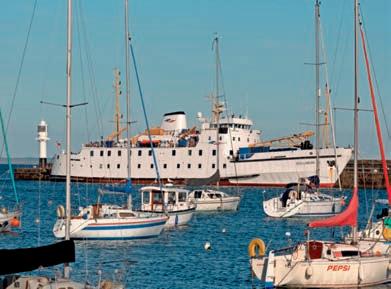
Some drove through the night, others took the sleeper train to Penzance, but we all arrived in good time for the morning boat to the Isles of Scilly.The long build-up is more than a necessity; it eases visitors into island life, where things move slower. Even while boarding the old-fashioned Scillonian ferry, it was clear we had slid into a timeworn dance: luggage was hoisted by crane, passengers strolled aboard on foot. All was as it should be.
Pulling out of Penzance, I saw a pod of porpoises skipping the waves. It was a good omen, and we soon slid past the Cornish coast and into open water. My destination lay 45km south-west, where five inhabited islands (and many more uninhabited ones) offered a glimpse of a gentler life – though they were far from the same. Each had its own character: St Mary’s was the lively hub;Tresco had fine beaches and subtropical gardens; St Martin’s was dreamlike; St Agnes had an Enid Blyton-esque feel (and lashings of ice cream); and Bryher was rugged and wild.
As I travelled the islands, I couldn’t help but be struck by the ever-changing landscapes. One



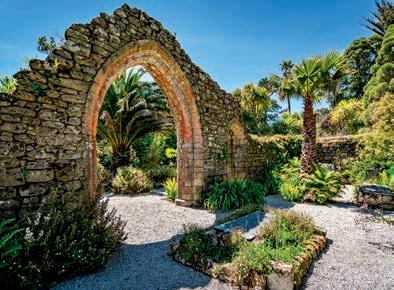
minute I was climbing through heathland gorse and heather, the next I was dipping into coastal forests or passing wetlands. I could spend a morning beachcombing and swimming in secluded bays and an afternoon exploring hilltop fortifications and burial chambers, all at my own leisurely pace.
For many, wildlife is the main lure here. Boat safaris in search of dolphins, porpoises and seals dominate itineraries. Birders have a good chance of seeing puffins, Manx shearwaters, guillemots, razorbills, shags and fulmars at various times of the year. Even the flora entrances.The showy agapanthus, with its large purple and white flowers that are synonymous with the islands, often caught my eye.
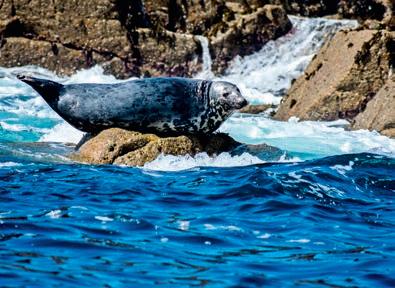
Between exploring coastal paths, prehistoric monuments and ancient shoreline churches, I tried to slow down. I strolled dozing settlements, pottered in shops and lost all sense of time searching for cowrie shells.The summer high season meant boats were more frequent and I could maximise my stay here – and catch the gig-boat racing season – but there’s just so much to fit in.That’s the trouble with slowing down – you eventually run out of time.
Ask a local
“‘Aggy! Aggy! Aggy! Oi! Oi! Oi!’ is all you can hear from the St Agnes spectator boats, fuelled with competitive Scillonian spirit. Follow the weekly gig races (ladies on Wednesdays, men on Friday nights); it’s the high point of the Scillonian summer for visitors and locals alike. The varied race courses over the season take you on an exploration of not just Scilly’s natural beauty, but also its rich culture and history. Centuries ago, the gigs raced to vessels needing guidance and to assist shipwrecks; today these very same boats are symbols of Scillonian identity.”
Sam Hicks, Troytown Farm, St Agnes

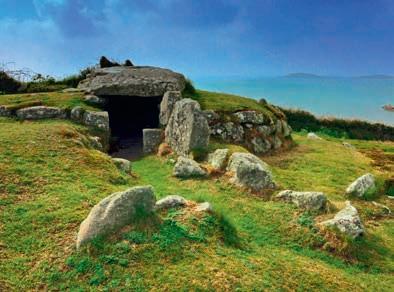
BRITISH BREAK MINI GUIDE
Timing is everything on this British archipelago, where life slows to the beat of the tides and you lose yourself among coastal paths, pale sands and castles, discovers Helen Moat
49.9233° N,
6.2966°
W
AWL Images; Dreamstime; Sam Hicks; Shutterstock ⊲ 178 December 2022/January 2023
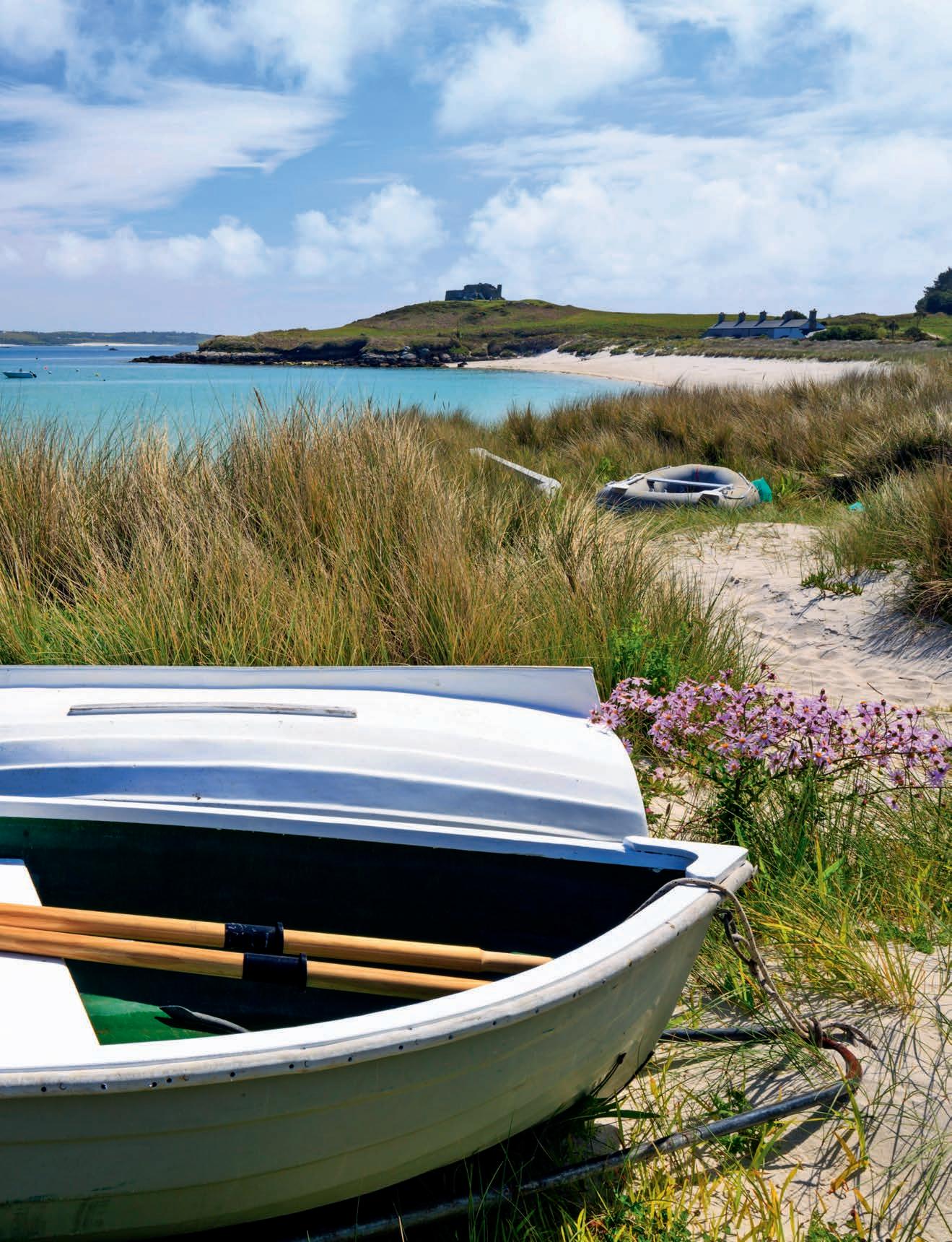 The sands of time (clockwise from this) Strolling the shores of Tresco reveals glimpses of lone beaches and a slower life; Atlantic grey seals thrive on the islands; the ruined archway of Tresco Abbey is surrounded by beautiful subtropical gardens; the Scillonian casts off; Bant’s Carn burial chamber dates back to the Bronze Age
The sands of time (clockwise from this) Strolling the shores of Tresco reveals glimpses of lone beaches and a slower life; Atlantic grey seals thrive on the islands; the ruined archway of Tresco Abbey is surrounded by beautiful subtropical gardens; the Scillonian casts off; Bant’s Carn burial chamber dates back to the Bronze Age
DISCOVER England
DAY ONE
Your break begins the moment you step onto the Friday-morning Scillonian ferry. Grab brunch onboard, scour the ocean for sea life and take in the first views of the islands and their striking granite rock formations. After checking into St Mary’s hilltop Star Castle Hotel (see below), stroll Hugh Town, exploring its galleries, gift shops and beaches. In the early afternoon, depart on a smaller boat for sleepy St Martin’s island and head to the bohemian Little Arthur Farm (littlearthur.co.uk) for afternoon tea and a bird’s-eye view of the bay. Climb to the stone cottages of Higher Town before crossing the island to Lower Town via near-empty lanes that drop away to Caribbean-blue waters and rocky ‘ledge’ islets. Bear in mind that timings depend on the tides, so plan accordingly. Back on St Mary’s, enjoy fresh seafood at the Mermaid Inn (mermaidscilly.co.uk) in the harbour, then spend the evening watching the racing of the gigs (six-oared rowing boats; pictured top). These events run twice-weekly throughout the summer, and the best views are found aboard the St Mary’s spectator boat that follows the gigs, so you can noisily cheer on your team as they go.
DAY TWO
Get the first boat of the morning to Tresco, the upmarket island. If you land at New Grimsby Quay, walk the coastal path to Cromwell’s Castle (pictured top), built in 1651 after the defeat of the Scillonian Royalists. Climb to the top of the defence (free entry) and enjoy views of the anchorage that sits on the narrows between Tresco and Bryher. A short climb leads you to the ruins of King Charles’ Castle, an artillery fortress built during the reign of Edward VI – the name ‘Charles’ refers to the Royalists who occupied it before their defeat. Cross the heathland to Old Grimsby and the Ruin Beach Café (tresco. co.uk/eating/ruin-cafe). Next, climb to the Old Blockhouse, another Edward VI fortification that was built to keep the French at arm’s length. Amble the beaches of Pentle Bay searching for shells – periwinkles, whelks and, if you’re lucky, much-prized cowries – then cross the wetlands to Tresco Abbey to meander its 19th-century subtropical gardens, strolling hidden pathways and ruins and grabbing lunch in the tearoom. Take the mid-afternoon boat back to St Mary’s (check the departure point) in time for your evening sail on the Scillonian back to Penzance.


Getting there: Take the Night Riviera Sleeper train (£25.50–£135 one way; prices depend on sleeper class; gwr.com) from London Paddington to Penzance, then hop on the Scillonian ferry to St Mary’s (£65.95 one way) for the ultimate in ‘slow travel’. If you’re short on time, you can also fly. One-way flights with Skybus (islesofscillytravel.co.uk) to St Mary’s go from Land’s End (£105), Newquay (£147) and Exeter (£203), taking 20, 30 and 60 minutes respectively. Stayat: Star Castle Hotel (star-castle.co.uk; pictured right) on St Mary’s is a 16th-century fort that was turned into a four-star stay. It gets its name from the eight-pointed star configuration of its walls, and visitors can choose from 38 castle rooms, guardrooms, garden rooms and suites with views over the sea, gardens or veranda. The defensive castle may appear austere from the outside, but inside it’s soft and welcoming. Grounds include subtropical gardens and a pool, plus there’s also complimentary golf. Doubles from £418 (all inclusive).
4 TOP THINGS TO DO
SHOP in the independent stores of Hugh Town on St Mary’s. Slip into Silver Street Gallery for local art, peruse the beach-chic IoS-branded clothing of 49 Degrees and search for island mementos in Stone Shop and Tideline. When you’re all shopped out, grab a takeaway coffee and head for one of Hugh Town’s three nearby beaches.
EAT between the tumbledown walls of the Ruin Beach Café gardens and soak in views of Raven’s Porth beach and the anchorage of Old Grimsby Harbour. From its wood-burning oven arrive plates of wood-fired pizzas and the smoky flavours of succulent meat, fish and vegetable platters.

RAMBLE the coastal paths of Tresco. Highlights on the west side include views over Appletree Bay and Bryher from the castle defences. Gentler rambles on the east side take in coastal woodlands, ponds and wetlands around Tresco Abbey. For a leisurely bimble, walk the alabaster beaches of Pentle Bay, combining your stroll with a spot of beachcombing.
DRINK at Karma (karmagroup.com) on St Martin’s, a holistic spa hotel in Lower Town. This series of adjoining cottages has been built to blend in with the island’s low-key architecture. Sip wine from the sandy shoreline garden as you wait for your return boat to St Mary’s (tides allowing).
BRITISH BREAK MINI GUIDE
Alamy;
Shutterstock;
Star Castle
180 December 2022/January 2023































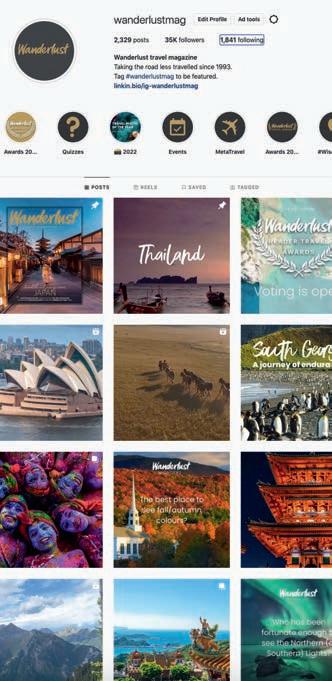








For daily inspiration, follow Wanderlust on social media @wanderlustmag @wanderlustmag @wanderlustmagWanderlust Travel MagazineAlamy; Shutterstock
Nuuk, Greenland
Greenland’s coastal capital is a small city with big plans. Head north (and north again) to a fast-growing town where the weather sets the pace, but the people set the mood…
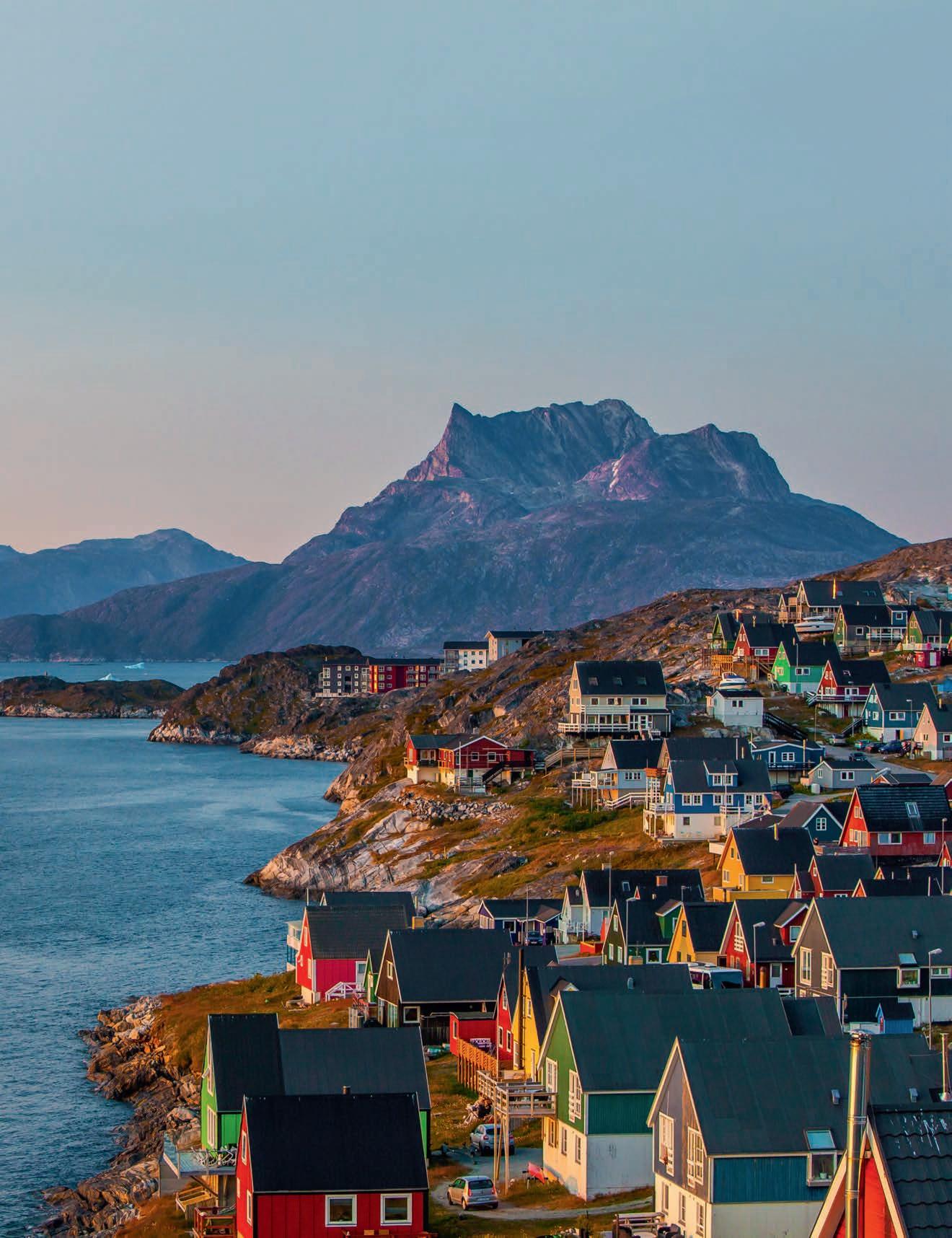 Words Sean Connolly
Words Sean Connolly
OFF GRID MINI GUIDE
Winter bathers strip down and fling themselves into Nuuk’s icy fjord every Sunday morn ing, sandwiched between statues of a bronze Hans Egede (the Dano-Norwegian Lutheran missionary who founded the city) and a granite effigy to the Mother of the Sea.These duelling monuments represent the two very different world views that met on this seashore 300 years ago and have largely defined Greenlandic life ever since.
Hans Egede, looking down from atop a hill in his starched clerical ruff, would likely rather see these brave swimmers (the water is rarely above 5°C) in the red weatherboard cathedral just up the road. He arrived in Greenland in 1721 to restore contact with a lost colony of early Norse settlers, but finding none here, he stayed on to convert the Inuit locals to Lutheranism.
The Mother of the Sea, (or Sassuma Arnaa in Kalaallisut, Greenland’s indigenous tongue) by contrast sits directly in the surf, her flowing hair and bare breasts lapped by the tides and surrounded by a carved menagerie that includes a walrus, a seal, an eel, a polar bear and a nude shaman studiously combing her hair.
She represents an old local tale, in which the sea mother holds back the animals because of the people’s careless attitudes on the land. The shaman combs her hair to make amends, then returns to land with a warning: hunt sustainably and safeguard the environment or she will keep the earth’s bounty for herself, protecting it in her underwater home and letting the humans starve.
This tug-of-war between local tradition and imported lifestyles continues to this day in Greenland. It is perhaps best exemplified by the island’s political status as an autonomous country within the Kingdom of Denmark – Danish, but decisively at a distance. And though the Danes don’t much care about saving souls these days, their influence on the island remains a hot topic – old Hans Egede got a bucket of red paint on his head in 2020 and the word ‘decolonise’ scrawled at his feet.
And so, Nuuk is very much a city between two worlds: Indigenous (90% of Greenland’s population is Inuit) but Nordic; traditional but modern; remote but cosmopolitan; independent but attached. Walking around the city, this dichotomy can sometimes feel a little too on the nose as you look up to see reindeer antlers mounted to glassand-steel apartments that
International dialling code: +299
Currency: The Danish krone (DKK), currently DKK8.37 to the UK£. Contactless payment is everywhere here (except on the bus!). Alternatively, there are ATMs in the city centre. Getting there: All flights to Greenland start in Copenhagen or Reykjavik; most arrive via Kangerlussuaq as Nuuk airport is (until it’s expanded in 2024) too small. The terminal is 6km from the centre – buses don’t correspond to flights, so a taxi is £17.50 (nuuktaxi.gl).
Getting around: Thanks to its tortured topography, greater Nuuk can be tricky to navigate, but the centre and Old Nuuk are easily walkable. There are three bus routes (£2.50/ride; bus.gl).

Festivals: The summer solstice is also Greenland’s National Day, when boats leave Nuuk’s Colonial Harbour for a competitive seal hunt – and return for the skinning! Expect music, speeches and traditional dress. Otherwise, check out Nuuk Snow Fest (Mar; snow.gl) and Nuuk Nordic Biennial (May; nuuknordisk. gl), or the music festivals of Qooqqut (Aug; katuaq.gl), and Akisuanerit (Sep/Oct; atlanticmusicshop.gl).
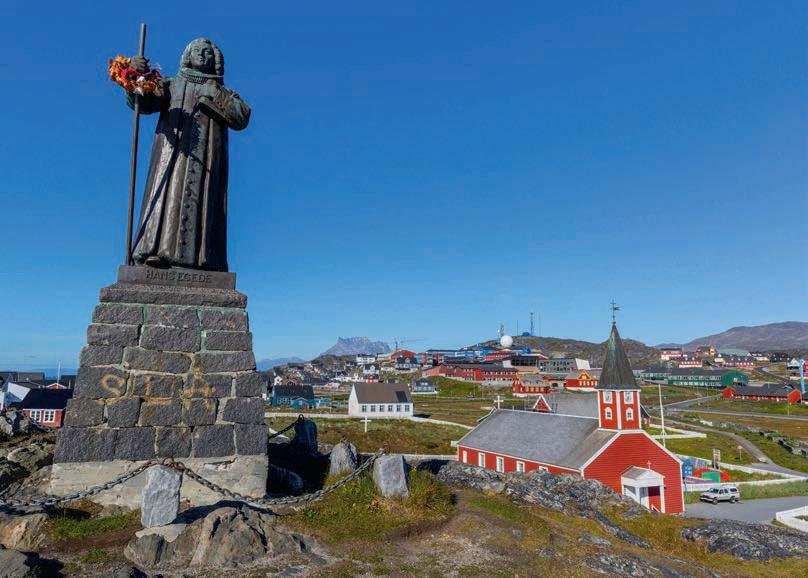
NEED TO KNOW 64.1743° N, 51.7373° W ⊲Alamy; Dreamstime; Shutterstock
The problem with founding fathers (clockwise from top) The statue of the Lutheran missionary Hans Egede, who founded Nuuk in 1721, is a difficult reminder of the country’s links to its colonial past (and present); despite being the capital of Greenland, Nuuk’s largely Indigenous population is still less than 20,000; this is a city that lives and breathes the sea
DISCOVER Greenland www.wanderlustmagazine.com 183
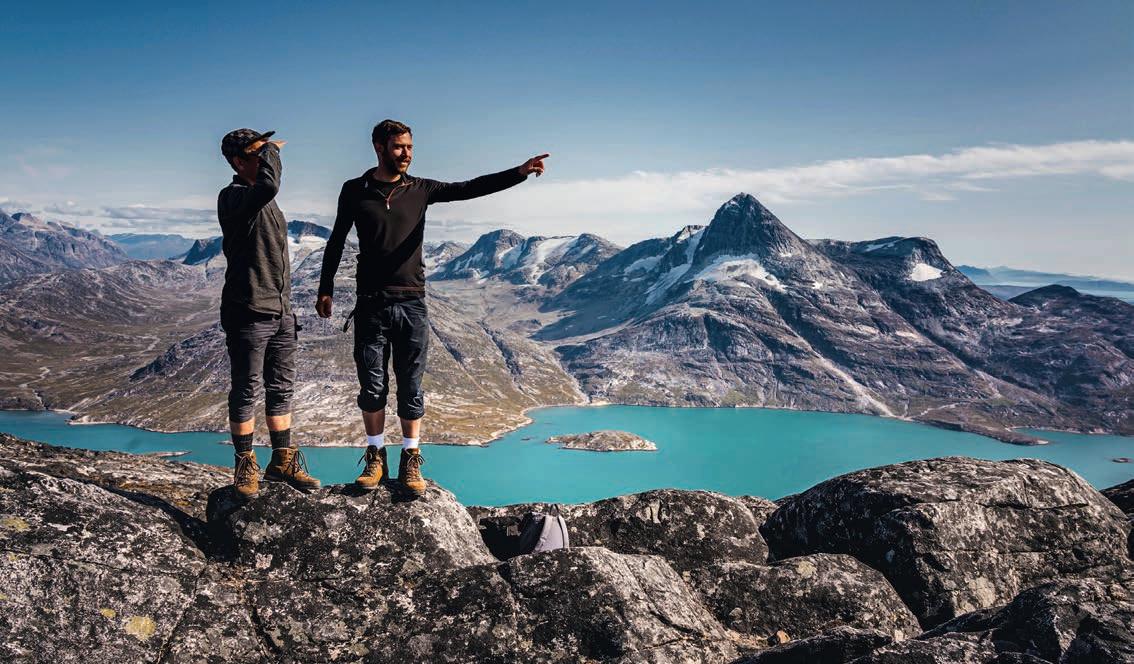

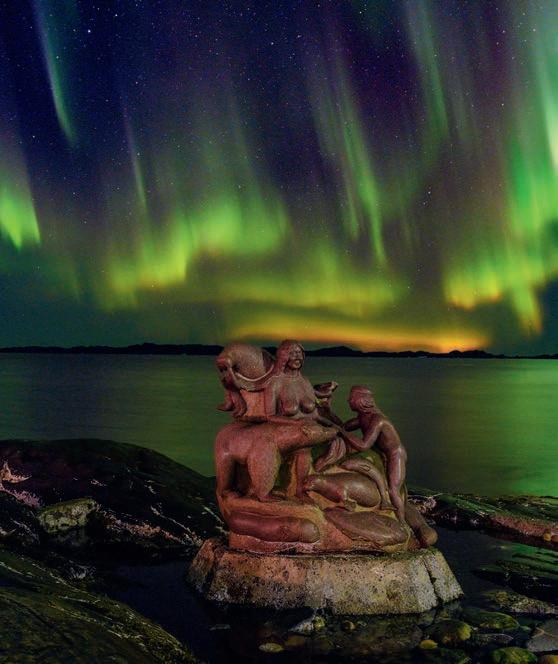
Alamy; Shutterstock
Lighting the way (clockwise from top left) The northern lights ripple in green waves above Nuuk’s statue of the Mother of the Sea – although the city lies just below the Arctic Circle, its remoteness and low light pollution still make it an excellent place to see the aurora; a pair of antlers – a common sight on buildings across the capital – hangs from one of the city’s colourful weatherboard houses; Inuit murals decorate Nuuk’s housing estates; the mountains on the outskirts of the city can be tricky to navigate due to a dearth of signage and trail markers, but they yield some incredible views over the surrounding fjords and wilderness, so don’t be put off exploring
184 December 2022/January 2023
would look more at home in Copenhagen. Any good editor would rewrite such a blatant metaphor, but here it is, in the flesh – and bone!
That’s just life today in this unlikely pastiche of a city.The world’s northernmost capital is also one of the smallest, counting fewer than 20,000 residents – slightly less than the population of Orkney, or just larger than the Pacific island nation of Palau.
Back on the shore, the swimmers frantically dressed themselves and chattered their way uphill for a coffee, giddy with adrenaline from their brief communion with the frigid sea. Like most of their Nordic neighbours, locals here take their coffee black, but cans of condensed milk behind the counter hint at the preferences of theThais and Filipinos staffing the cafés. In fact, South-East Asians have something of a monopoly on Nuuk’s takeaway scene, making it surely one of the only places in the world where you can order a reindeer red curry.
In keeping with this surprisingly varied cultural mosaic, Nuuk’s architecture also seems to border on the schizophrenic: Old Nuuk, home to the excellent national museum and Colonial Harbour, feels like a fishing village, cut through by streams lush with tussock grass and wild Angelica, while neighbouring Myggedalen is all postcard-perfect coastal homesteads painted in vivid, distinctly un-Nordic colours. But walk just a few minutes inland and you enter a land of long, slightly Soviet numbered blocks daubed in cultural murals that have now become icons of the city. Go further still and you find geodesic radar domes, angular, New Nordic apartment towers (again with those antlers!), and finally Nuuk’s prison at the edge of
Stay here...
Small & characterful Inuk Hostels
A cluster of cabins in the Qernertunnguit neighbourhood. It’s a bit removed from the centre but the views over Sermitsiaq Mountain and the fjord are unbeatable. Each cabin has a shared kitchen, or just sip hot soup at their café. Book a session in the sauna if you get cold. Twin rooms from £94pn; inukhostels.gl
town – winner of a modern architecture award in 2017. And while you can easily get lost in the city’s culture and architecture, the ever-present nature on all sides of the capital is perhaps Nuuk’s most defining characteristic. Perched on a rocky cape (‘nuuk’ means ‘cape’ in Kalaallisut) at the end of one of the world’s largest fjord systems, the city is wedged between the mountains and the water – a tangled clump of spaghetti-noodle streets and abrupt dead-ends splayed along the jagged shoreline. Rocky outcrops puncture the low, treeless heath, and there’s nowhere in the city where the wilderness – the seemingly endless expanses of wild, punishing, spectacular nature that Greenland is so known for – is out of view. And locals wouldn’t have it any other way: on sunny weekends you can hear a pin drop in the city centre as everyone is out hiking, hunting and fishing. Even well-behaved prison inmates can go out to hunt, so long as they’re accompanied by a guard.
This is how Nuuk has quietly become the Nordics’ quirkiest capital – an unlikely smorgasbord of Scandi-cool charm transplanted to a land of extraordinary landscapes, unforgiving nature and a proud Indigenous culture that still informs the rhythms of daily life. It’s also become something of a boomtown, attracting immigrants from Maniitsoq to Manila, and host to several-dozen massive construction cranes at any given time. And while the world at large hasn’t quite woken up to Nuuk yet, one only needs to look ever so slightly southwards to neighbouring Iceland and the Faroes to see the wave coming – it may be cold, but everyone’s diving in.

4 TOP THINGS TO DO
Set sail
Nuuk is a city of few roads but has 880+ private boats to call on. Nuuk Water Taxi (watertaxi.gl) operates from the Colonial Harbour and can take you whale watching, fishing or into the icefjord.
Hike & forage
Paradisdalen (Paradise Valley) – just behind the prison – is an easy day hike and a popular foraging spot for crowberries, bog labrador tea and wild thyme. Take care on the slopes of Ukkusissaq (Store Malene) – trail markers can be inconsistent and the weather unpredictable.
Eat local
Greenlandic food might seem unapproachable, with dishes ranging from blubber to smoked narwhal, but it’s worth a try – the ‘Greenlandic tapas’ at Cafétuaq (katuaq.gl) is just the ticket.
Art & artisans
Nuuk is dotted with galleries, but don’t miss the workshops at Ajagaq (Nuukullak 18), where artisans craft in bone, stone and antler and carve protective totems, known as tupilaks, from wood.
Mid-range Hotel Aurora
Hidden down a potholed lane of boat-builders and Asian grocery stores known as Entreprenørdalen (‘Entrepreneur Valley’), a colourful exterior gives way to tidy, clean Scandinavianstyle rooms. The delicious Kaffivik café-bar (kaffivik. gl) is also just across the street. B&B doubles from £155pn; greenland-escape. com/aurora
Best address in town Hotel Hans Egede
The go-to address for business travellers in Nuuk, this conferencing stalwart is as central as can be, overlooking the city’s main drag (Aqqusinersuaq).
Rooms are comfy and modern, and the top-floor bar is surprisingly good value. Or you can try your luck at the (pricier) attached steakhouse. Doubles from £207pn; hhe.gl
WANDERLUST RECOMMENDS
Music: Everyone here can sing along to Greenland’s first ever rock band, Sumé. They became countercultural icons in the 1970s and the subjects of a popular documentary in 2014 – https://youtu.be/7Ia1Sl1S3Qs Spotify: This ‘Kalaallisut’ playlist features a variety of buzzy tracks from newer local acts like Andachan, FINNi, and Pukuut – https://open.spotify.com/ playlist/0c8Kt2PhaQPuxVePXqhHng Info: The tourism board sites of Greenland (visitgreenland.com) and Nuuk (visitnuuk.com) are comprehensive and have everything that you need to know.
DISCOVER Greenland www.wanderlustmagazine.com 185
North Rhine-Westphalia
Germany’s industrious west once powered the country’s 20th-century post-war rebirth, until the decline of coal saw it shift gears. Now its cities are turning industrial decay into art
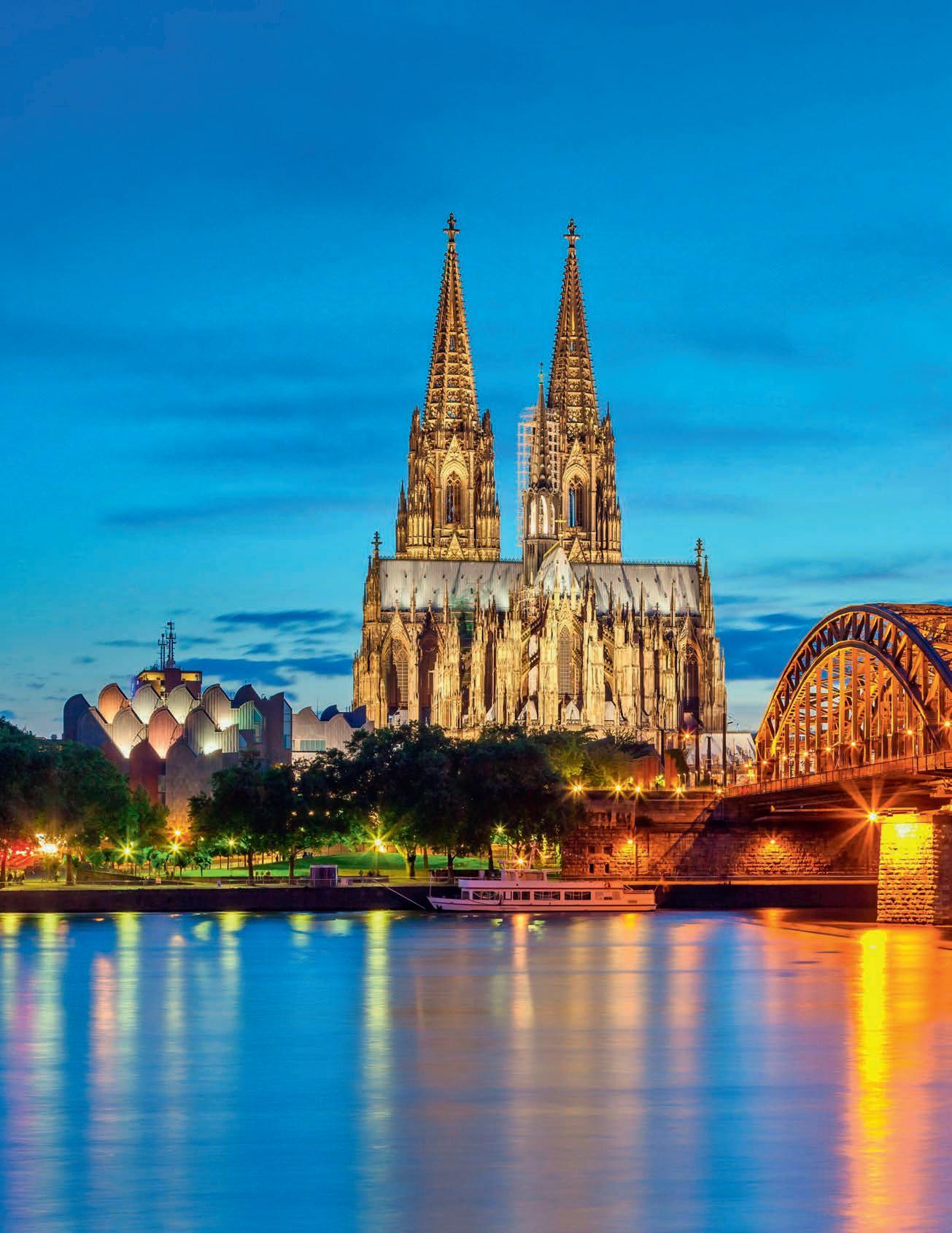
SHORT BREAK MINI GUIDE
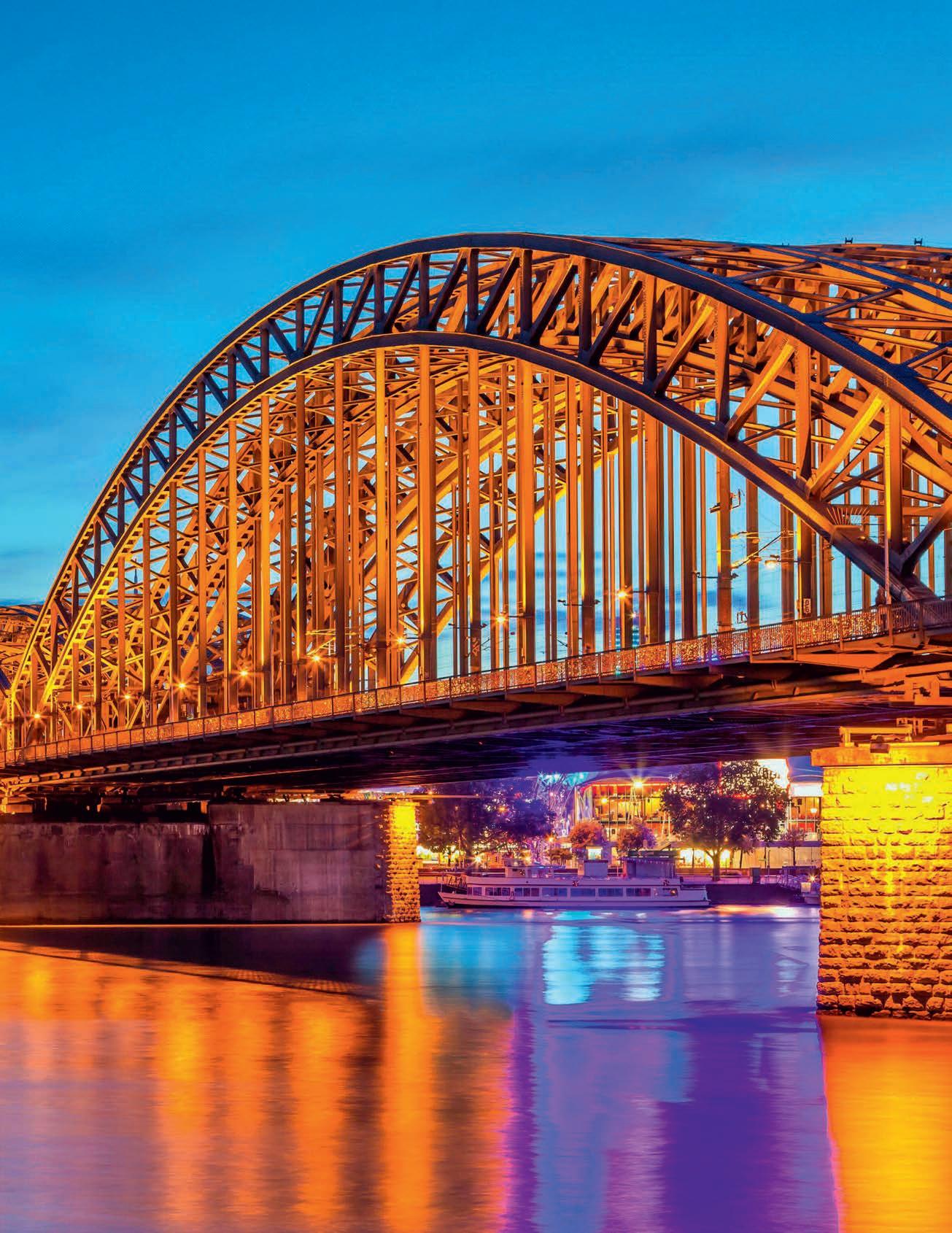
DISCOVER Germany
As destinations go, North Rhine-West phalia is a rather unconventional one. This is not the Black Forest or Bavaria, with their castles, cobblestones and half-timbered villages. Instead, its heart land is a densely populated and scenically under whelming region of factory chimneys, blast furnaces and slag heaps, known as the Ruhrgebiet. This is a region whose combination of bountiful coal seams and a generous waterway (the river Rhine) created the perfect conditions for Germany’s wirtschafts wunder, the economic miracle that followed the Second World War, as steel works, chemical plants and car factories sprouted up across the region. So why does it feature in a travel magazine? The answer lies in a world-leading regeneration.
Over the last couple of decades, all the coal mines have closed, as have some of the heavy industries, but instead of leaving their sites to dereliction, creative thinking has set about repurposing what were once the afterthoughts of industry. This has included the conversion of a coal mine (Essen’s Zeche Zollverein) into what is now a UNESCO World Heritage site, and a blast furnace (Duisburg’s Landscape Park) into a mecca for film directors and scuba divers. The industrial city of Essen was even declared European Capital of Culture back in 2010, and visitor numbers have increased ever since. To a new generation of traveller, these converted mines and mills are as interesting as any castle or church.
The key entry points to the region are still Cologne and Düsseldorf. The former offers an

intersection with more traditional tourism, thanks to its famous cathedral as well as river cruises down the vineyard-lined Rhine. Düsseldorf is better known as the Ruhr’s writing desk, filled with company headquarters; a place where work ers relax and industrialists can spend their salaries.
All that cash pays for some eye-catching architec ture from names like Daniel Libeskind and Frank Gehry, and it patronises a succession of big public galleries. It is what makes Düsseldorf (according to many listicles on the subject) the second most liveable city in Germany, after Munich.
Venture out from Düsseldorf to the likes of Essen and Duisburg and you enter the sort of industrial landscapes that have long since disappeared from the UK’s shores. There have, of course, been seri ous consequences to the environment, particularly subsidence from the mineworkings. If it wasn’t for dikes and pumps, much of the Ruhr would be a giant lake. But the many industrial scars are relieved by sculptural installations on slag heaps, such as Duisburg’s ‘Tiger and Turtle’, or art galler ies in gasometers, such as at Oberhausen.
Art in the region has always been cutting edge, so much so that it is not always recognised as art. Back in the 1980s, Düsseldorf artist Joseph Beuys placed five kilograms of butter in an exhibition in the art academy and called it ‘Fat Corner’. Even tually a gallery cleaner mistakenly cleared it away. Ever since then, there has been a popular German saying: Ist das Kunst oder kann das weg? (Is it art, or can I throw it away?)
Ask a local
Lighting up the region Duisburg Nord, a former steelworks, was turned into a public park in the early 1990s and looks magnificent at night; (previous spread) the Dom cathedral adds a Gothic air to Cologne
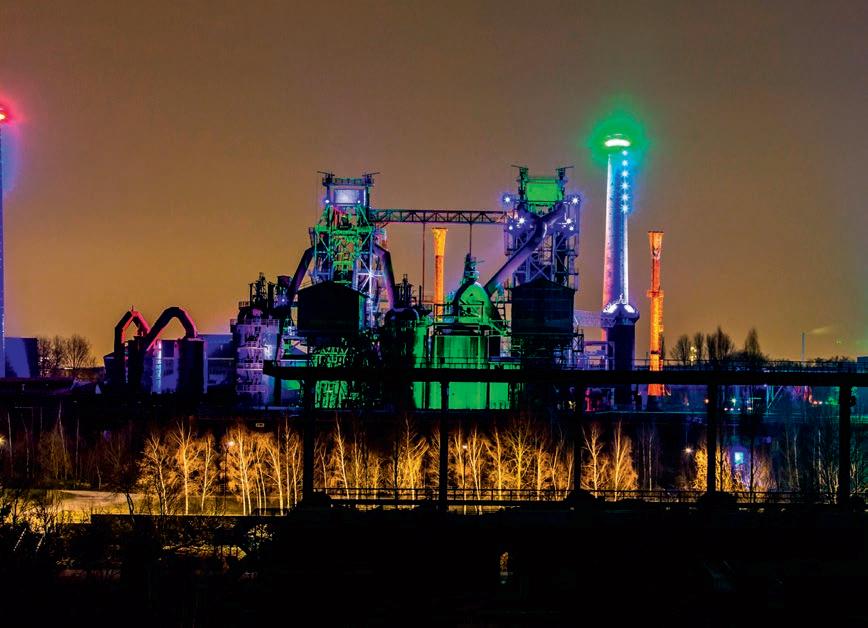
The Altbier we have in Düsseldorf is much darker than most German beers. The colour comes from the roasting of the malt, which also gives it its more chocolatey or coffee-like flavour. It is unpasteurised, so best drunk fresh at traditional taverns like Füchschen or Schlüssel in Düsseldorf’s old town, where they brew on site. You are served by specialist waiters, usually middle-aged men (Köbes) wearing blue aprons who will continue to bring more, recording your tally with marks on your beer mat until you cover your glass. Beware of asking them for anything else, as it makes their lives more complicated. There’s a reason why one of the most traditional taverns is called Uerige, which means ‘grumpy old guy’.
Karen-Svenja Busse, marketing manager

51.4332° N, 7.6616° E
188 December 2022/January 2023 SHORT BREAK MINI GUIDE
NORTH RHINE-WESTPHALIA IN FIVE DAYS
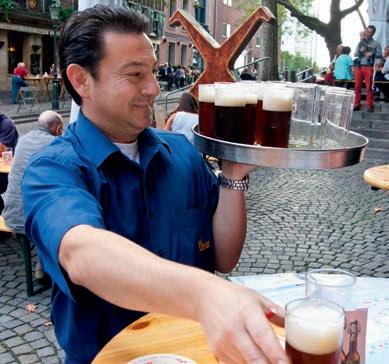
Day One: Classical Cologne
Start with Cologne’s iconic Dom, reputedly Germany’s most visited cathedral. Stand amid the street artists to admire its ornamental exterior, then walk to the river. The route is filled with installations telling the story of 2,000 years of city history. You’ll finish on a riverside strip of the Altstadt (Old Town) that’s lined with eateries. It’s the place to be when the sun goes down.
Day Two: Urban Düsseldorf
It’s a short train ride to the commercial capital of the Ruhr. Walking its mostly pedestrianised centre shows what a model city this is. Seek out Daniel Libeskind’s curvaceous Kö-Bogen
building, which sprouts with greenery, and the nearby Kö-Bogen II, a shopping centre disguised under beech hedges. Have dinner in Japantown, along Immermanstrasse, where the popular noodle bars attract lengthy queues.
Day Three: Artistic Düsseldorf
It’s a culture day! Düsseldorf’s academy has set many a modern artist – Richter, Beuys – on their way, and their work has ended up in a clutch of the city’s well-funded art museums, including the K20, K21 and NRW-Forum. Afterwards, stroll across into the adjacent Altstadt (Old Town) for less spiritual refreshment on Bolkerstrasse, Düsseldorf’s famous street of bars.
Day Four: Industrial Duisburg
Strike out into the Ruhr’s hinterland. At Duisburg station hop on tram 903 out to the Landscape Park, a converted blast furnace beloved by film directors, then swing south on the 903 to the Tiger & Turtle, a walkable rollercoaster of a sculpture sat on a former slag heap.
Day Five: Coal-fuelled Essen
Take a train to Essen, then hop on tram 107 to reach Zeche Zollverein, a UNESCO-listed former coal mine. If you’ve got time, take the tram 107 to cross back through town to explore Margarthenhöhe, a garden city created by the Krupps, a family of wealthy industrialists. ⊲


Previous spread: Alamy; this spread: Alamy; Dreamstime
Industrial revolution (clockwise from this) The illuminated gangway to the Ruhr Museum at Zeche Zollverein turns its industrial setting into a light show; Duisburg’s Inner Harbour fell out of use with the decline of the flour mills but was revived in the 1990s, with many of its old warehouses turned into museums; Altbier is a Düsseldorf delicacy
DISCOVER Germany www.wanderlustmagazine.com 189
KNOW
International direct dialling: +49
Currency: Euro (€), currently €1.14 to the UK £1
Getting there: Düsseldorf International Airport is served by Eurowings (eurowings.com) flights from London Heathrow, Birmingham, Manchester and Edinburgh, costing from around £100 one way. British Airways (ba.com) also flies to Düsseldorf from Heathrow and London City. Cologne/Bonn airport is served by Eurowings flights from London Heathrow and Edinburgh, and Ryanair (ryanair.com) from Manchester and London Stansted; flights cost from around £26 one way. Both routes take 1.5 hours. Cologne is also the gateway city for trains from Brussels (2 hours), where you can connect with the Eurostar.
Public transport: The clogged roads mean this is a destination well suited to trains and trams, which are frequent and efficient.
Invest in a 24hr, 48hr or 72hr Ruhr WelcomeCard (from €39.90/£34.50; vrr.de) which removes the hassle of buying a ticket for every journey.
Further information: Germany.travel
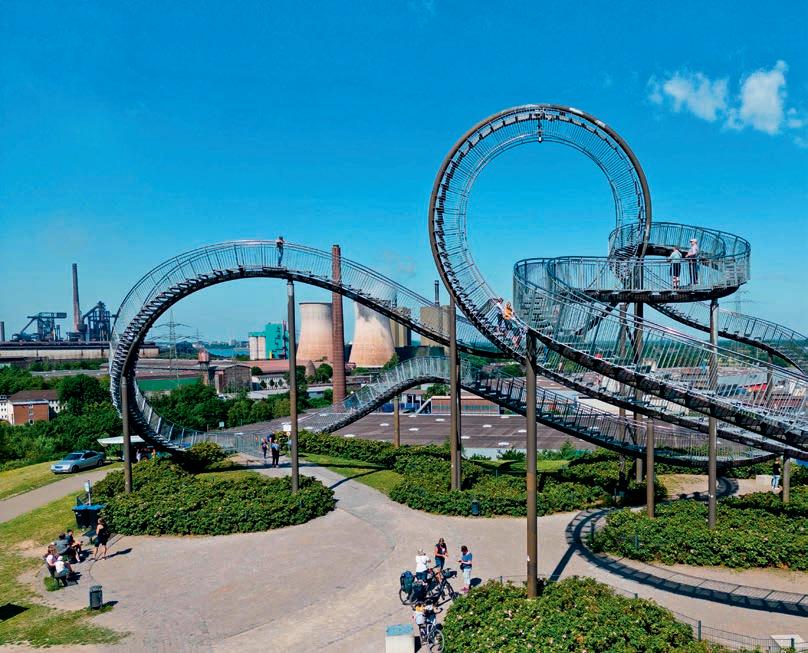
Don’t miss...
Outdoors
Düsseldorf’s Rhine promenade

The city sits right on the Rhine, with fully laden barges lumbering laboriously around its giant bend. Sheep graze on the floodplain on the far bank, while the near bank is lined with a long promenade that is hugely popular among locals when the weather is kind. There are bars here, but the most dramatic view is from the top of the 240m-high Rheinturm (rheinturm.de) looking down on the river and the parliament building.
Rent a bike, Essen
Zeche Zollverein has a bike rental station.
Staff will point you to a route that heads out along a former freight railway and through a landscape much affected by subsidence from the labyrinth of mine workings below ground.
Turn back at the Emscher river – formerly much polluted, but now coming back from the brink.
Rent a bike, Duisburg
As with Zeche Zollverein, the Duisburg Landscape Park has bike rental and a cyclepath to the waterside. This one ends up in the Duisburg Inner Harbour, whose warehouses have been converted into restaurants and bars according to plans laid out by the British architect Sir Norman Foster.
Indoors The Dom, Cologne
There’s a majesty and a mystery to Cologne’s much-loved cathedral. The majesty is in the loftiness of the interior (the tallest twin-spired church in the world tops a mighty 157 metres) and the generous welcome that it extends. The mystery is how it managed to escape the complete obliteration of the city by Allied bombers in the Second World War.
Zeche Zollverein, Essen
This former coal mine is the place to dig deep into the Ruhr’s industrial heritage (zollverein. de) and admire the artistry of its brickwork. There are two sections: the mine and the coalwashing plant, which contain key museums, and the coking plant, which has a seasonal ice rink and swimming pool among the girders.
Uerige, Dusseldorf
One of the most traditional of the brewery bars (uerige.de) of Düsseldorf serves up plenty of beer and food in a warren of wood-panelled rooms decorated with cartoons of celebrated clients. Its menu features local black pudding (always a treat), and waiters come around with trays of fresh frikaddelle – meat patties – to keep you thirsty.
NEED TO
Alamy
Shades of grey (clockwise from this) From Duisburg’s Tiger & Turtle installation you can gaze out across steelworks and a surprising amount of forest; the Altstadt of Düsseldorf is a lively spot at night; the Rheinauhafen after sunset; the former mining site of Zeche Zollverein is one of many industrial sites given a new lease of life across the region as an historical attraction; a glimpse of the Rhine from the banks of Düsseldorf
190 December 2022/January 2023
Stay here...
Cologne
Art’otel
This new-build hotel is filled with paintings –as its name suggests – but its main appeal is its location, which overlooks the regenerated Rheinauhafen, while also being within walking distance of the restaurant-rich riverside Altstadt. artotelcologne.com
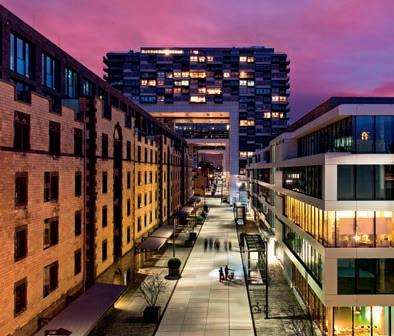
Düsseldorf
Breidenbacher Hof
A traditional luxury property nestled right by the city’s famous Kö shopping street. Interiors of hardwood, marble and chrome make a plush setting for its wealthy clientele, typically celebs and high-rollers from the Middle East. It’s a glitzy crowd. breidenbacherhof.com
Meandall Hotel
This hip and innovative hotel sits in the heart of Düsseldorf’s Japantown, midway between
the city centre and the railway station. It’s particularly good value, with great breakfasts up on the 11th floor, plus there’s free bikes for guests if you prefer to explore the city on two wheels. meandallhotels.com
Essen Friends Hotel
An industrial-chic new-build set within the coal mining complex of Zeche Zollverein. It is popular with corporate groups, but can be a bit isolated from other destinations if you don’t have your own transport. hotelfriends.de

Mintrops Stadt Hotel
The handsome art nouveau exterior catches the eye, as does its location on a peaceful market square in Margarethenhöhe, a leafy garden suburb in the south of Essen. The interiors aren’t as exciting as the outside but it’s a great setting. mintrops-stadthotel.de
4 TOP THINGS TO DO
Watch the film RUHR 360º in the Portal of Industrial Heritage in Zeche Zollverein (€8/£7; zollverein. de). A mix of music and great imagery recreates the whole dance of industry that has been the lifeblood of the Ruhr. Then climb the steps to its rooftop for a full panoramic view of the city.
Walk the Rheinauhafen, a regeneration of a former commercial port on a finger of land right by Cologne’s city centre. Some of the old warehouses have been colonised by the likes of the Chocolate Museum, but the eye-catching sights are still the cantilevered new office buildings, now home to cutting-edge tenants such as Microsoft.
Taste Kölsch beer in Cologne, then try a glass of Altbier in Düsseldorf. The former is pale in colour, delicate in flavour and served in a 200ml glass called a stange. Altbier is more like a British ale and is brewed in just a few key locations in the heart of Düsseldorf’s Altstadt.
Climb Duisburg’s Tiger & Turtle, one of a handful of giant artworks placed atop mining spoil heaps. This metal walkway looks like a rollercoaster and is thus named because it swoops like a tiger, but you should only walk it at the speed of a turtle. It is very popular with visitors at sunset, when you can scan the industrial landscape in the fading light Evening walking tours cost €10 (£8.65; duisburg.de).
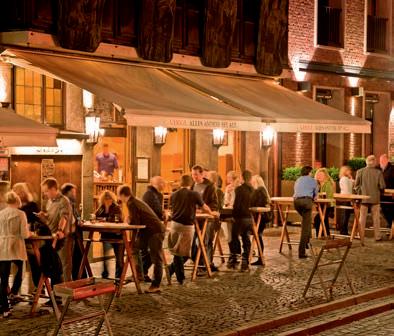
DISCOVER Germany www.wanderlustmagazine.com 191
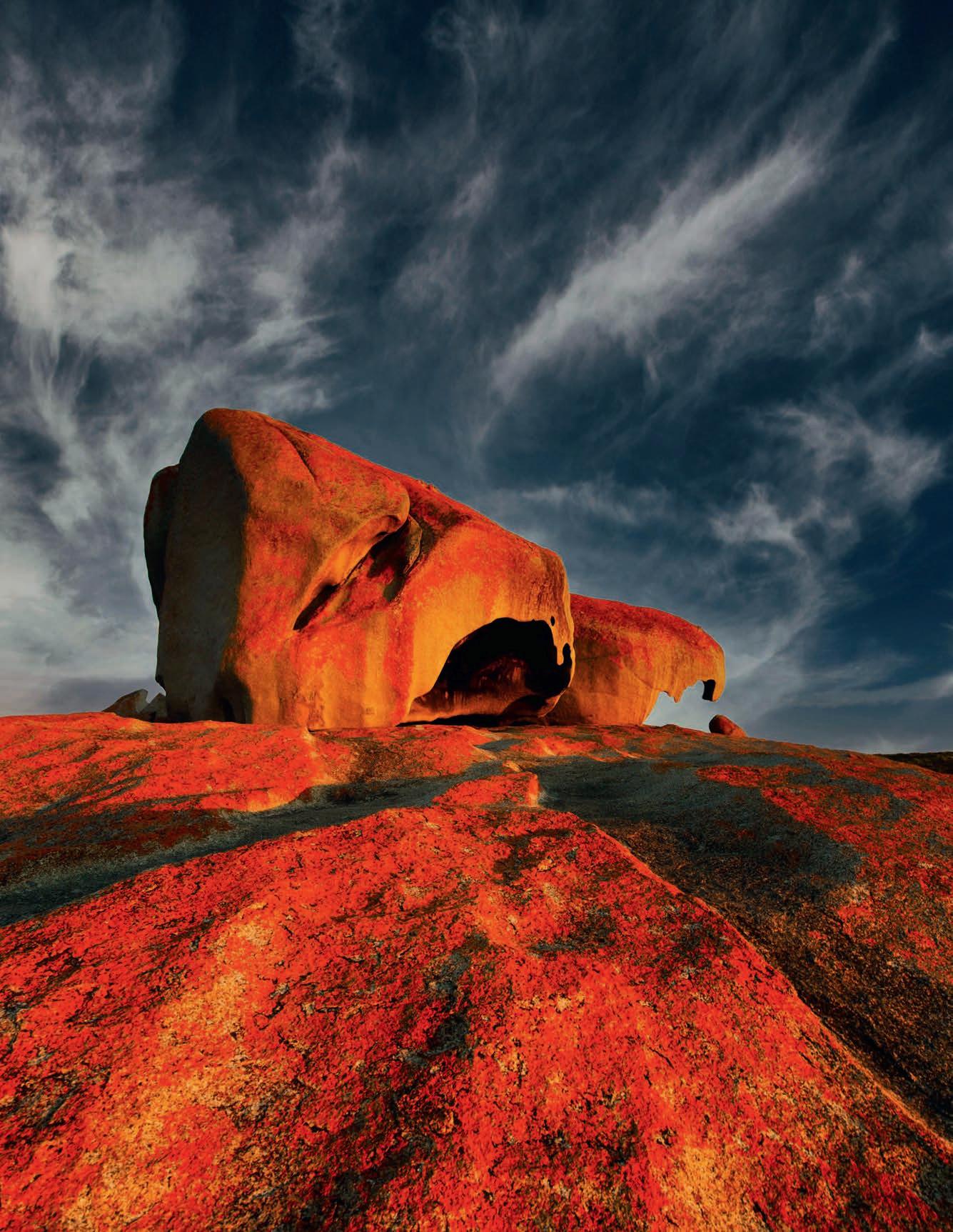
Discover our readers’ most desirable destinations & the Wanderlust editors’ Hot List 2023 THE WINNERS ISSUE On sale 2 February NEXT ISSUE Alamy + Aboriginal Northern Territory Australia’s Kangaroo Island regenerated Journey to the Arctic by rail Explore the USA’s Pacific Northwest
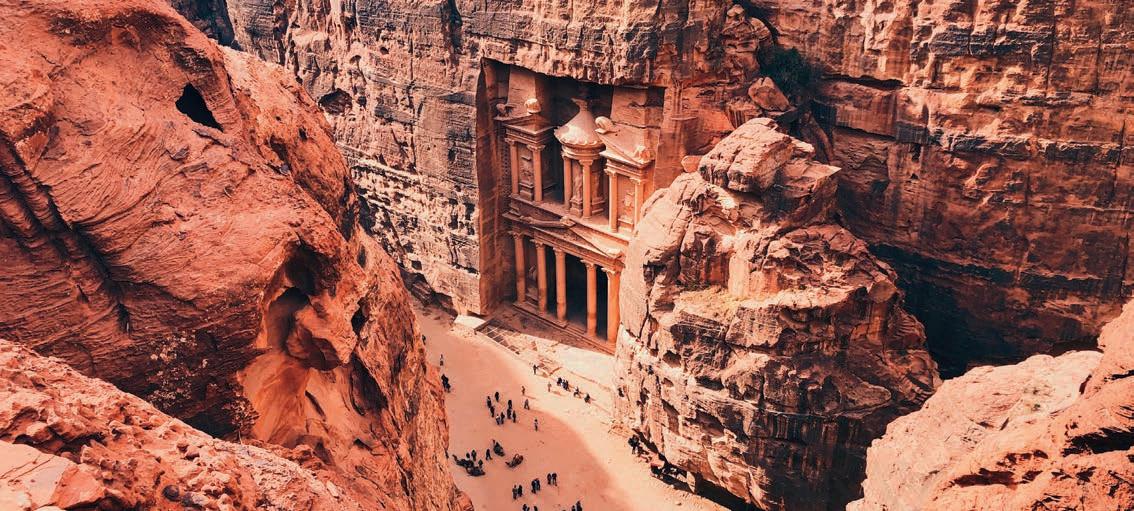





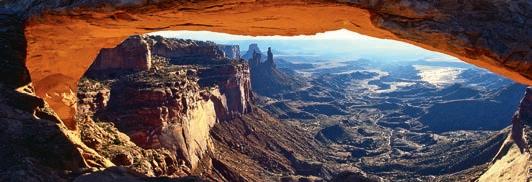

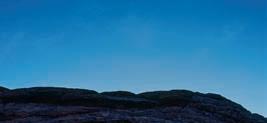











Craig Wickham
Craig Wickham won ‘Top Specialist Guide’ at the Wanderlust World Guide Awards 2021. Here he shares tips and tales on his home patch, Australia’s Kangaroo Island


What’s so unique about Kangaroo Island?
It delivers a microcosm of Australia: sheep and cattle farms, red dirt roads, deserted beaches, rugged coastline, eucalyptus trees to the horizon, friendly locals, delicious food and wine, and of course, marsupial-rich wildlife encounters. It is big enough to get lost in, but small enough to find yourself again.
What would you say are the five must-dos there?
1. Spend time hanging out with the Kangaroo Island kangaroos in the wild.
2. Dine like royalty and eat some King George whiting fish.
3.Try some of the excellent local wines. I suggest False Cape’s Pinot Grigio or Islander Estate Vineyards’ Old Rowley Shiraz Grenache.
4.Visit the Australian sea lions at Seal Bay Conservation Park.
5. Explore the expansive wilderness of Flinders Chase National Park and immerse yourself in the extraordinarily positive post-bushfire recovery.
Any top tips?
Do your homework first.The island is bigger than most people think, and too many do not dedicate enough time to do the place justice.The expense of getting to the island is the same whether you visit for one day or five, so consider a longer stay. A local guide will offer you a peek under the hood, to see how the place really works.Try to also connect with local specialists, such as artists, winemakers, ecologists and farmers.
How easy is it to spot a koala?
Koalas are so easy to see if you are in the right place and know how and where to look.Typically, they are two-thirds of
Island of surprises (top) Kangaroo Island’s Remarkable Rocks, a few kilometres east of Cape du Couedic, is made up of huge boulders carved by the weather over 500 million years; (left) Craig Wickham was a former ranger with the South Australian National Parks and Wildlife Service
the way up a tree and lying in a fork of branches, asleep. Looking for a round, fuzzy, basketball-sized lump in a tree will get you heading in the right direction.
Duck Lagoon is a good spot, as is the Western KI Caravan Park or Hanson BayWildlife Sanctuary.The easiest way is to link up with a local wildlife guide and ask them to help you find koalas and lots of other wild creatures.
What’s your favourite critter?
I think the short-beaked echidna is at the top of the list. It is an ancient species that has so many contradic tions: it has sharp spines but soft fur; it lays eggs but drinks milk; it has a cold body temperature and is found across many habitat-types, but it pops up at the most unlikely times.Their front legs face forwards and their back ones face backwards, allowing them to burrow straight down like a drill! I could go on, but what’s not to love in all of that?
What’s the funniest question you’ve been asked?
I was once asked whether it was true that a flying fox was used to haul supplies up the cliffs for the lighthouse keep ers at Cape du Couedic. At first I was impressed by his research and pictured the cable car arrangement (referred to as a “flying fox”), but then he said: “So, did they put little backpacks on them, then?” I fell about laughing and my poor guest was very confused. I continued to chuckle at the image of a flying fox labouring up and over the sheer cliffs with a carton of beer in a backpack! I did explain things to him, eventually.
CraigWickham, Exceptional Kangaroo Island; exceptionalkangarooisland.com
Alamy
194 December 2022/January 2023 TOP TOUR GUIDE
















































































































 Churchill, Canada
Photographer: Dave Sandford
Churchill, Canada
Photographer: Dave Sandford





 John Sharvill
John Sharvill






















































































































 by Edward Dusinberre Faber & Faber; £19
by Edward Dusinberre Faber & Faber; £19














































































 Reviewed by George Kipouros
Reviewed by George Kipouros

 George Apostolidis
George Apostolidis












































 Words & photographs Mark Stratton
Words & photographs Mark Stratton






















 Words Lizzie Pook
Words Lizzie Pook









 Lizzie Pook; Shutterstock; Tourism and Events Queensland
Fruits of the sea (clockwise from top left) The Torres Strait islands are home to large areas of mangrove where you can spot wildlife ranging from gentle dugongs to lurking crocs; many islanders have links to the sea, with plenty who have ancestors that came over to work in the thriving pearling trade; the gun emplacement at Green Hill Fort Museum was built in the late 1800s as part of Australia’s defences against possible Russian invasion, and to protect its shipping lanes; tours of Horn Island reveal guns, underground rooms and slit trenches left over from the Second World War; a couple stroll down the floating jetty at Roko Island
Lizzie Pook; Shutterstock; Tourism and Events Queensland
Fruits of the sea (clockwise from top left) The Torres Strait islands are home to large areas of mangrove where you can spot wildlife ranging from gentle dugongs to lurking crocs; many islanders have links to the sea, with plenty who have ancestors that came over to work in the thriving pearling trade; the gun emplacement at Green Hill Fort Museum was built in the late 1800s as part of Australia’s defences against possible Russian invasion, and to protect its shipping lanes; tours of Horn Island reveal guns, underground rooms and slit trenches left over from the Second World War; a couple stroll down the floating jetty at Roko Island





















































































 Words Lyn Hughes & Juliet Rix
Words Lyn Hughes & Juliet Rix













 When the walls fell (clockwise from bottom left) The history of Salwa Palace is projected across its walls in an evening light show that depicts the story of the 1818 battle with the Ottomans that signalled the end of the First Saudi State – in its aftermath, Ibrahim Pasha rounded up prominent survivors of the Al Saud royal family and sent them into exile; wandering the mud-brick buildings reveals how surprisingly malleable this material is, able to be shaped into all kinds of features; the doors of the Najd region were dyed using acacia seeds and pomegranate; the citadel’s nooks and corners conjure visions of how it must have looked in its heyday
DGDA; Juliet Rix
When the walls fell (clockwise from bottom left) The history of Salwa Palace is projected across its walls in an evening light show that depicts the story of the 1818 battle with the Ottomans that signalled the end of the First Saudi State – in its aftermath, Ibrahim Pasha rounded up prominent survivors of the Al Saud royal family and sent them into exile; wandering the mud-brick buildings reveals how surprisingly malleable this material is, able to be shaped into all kinds of features; the doors of the Najd region were dyed using acacia seeds and pomegranate; the citadel’s nooks and corners conjure visions of how it must have looked in its heyday
DGDA; Juliet Rix


























 Words Eddi Fiegel
Words Eddi Fiegel









 Marquez Juan Manuel
Marquez Juan Manuel


























































 Snow business (clockwise from left) Mount Yotei means ‘sheep-hoof’ mountain; Grandvalira, in little Andorra, is the biggest ski resort in southern Europe; 12km-long Franz Josef Glacier plunges from the Southern Alps to less than 300m above sea level
Snow business (clockwise from left) Mount Yotei means ‘sheep-hoof’ mountain; Grandvalira, in little Andorra, is the biggest ski resort in southern Europe; 12km-long Franz Josef Glacier plunges from the Southern Alps to less than 300m above sea level

































































 Words Mark Jones
Words Mark Jones













































 Words Peter Moore
Words Peter Moore






 Alamy
Alamy

 Alamy; Simon Broughton
Alamy; Simon Broughton















 The sands of time (clockwise from this) Strolling the shores of Tresco reveals glimpses of lone beaches and a slower life; Atlantic grey seals thrive on the islands; the ruined archway of Tresco Abbey is surrounded by beautiful subtropical gardens; the Scillonian casts off; Bant’s Carn burial chamber dates back to the Bronze Age
The sands of time (clockwise from this) Strolling the shores of Tresco reveals glimpses of lone beaches and a slower life; Atlantic grey seals thrive on the islands; the ruined archway of Tresco Abbey is surrounded by beautiful subtropical gardens; the Scillonian casts off; Bant’s Carn burial chamber dates back to the Bronze Age


























 Words Sean Connolly
Words Sean Connolly













































































